Members’ Finds, 2021 Jan - June
Following the success and popularity of our experimental Members' Finds Autumn 2020 project, we have now set up this new page for 2021 to which members are again invited to contribute. We are starting afresh with a new species list, so please email Penny photos of anything you find - even of species previously on last autumn's list. Try to illustrate all aspects of the fruit body, also remember not to reduce the photo size and to include the date, site, substrate, habitat plus any other useful features such a size, smell, etc. All extra clues are vital when identifying solely from photos. Ideally, try to collect at least one specimen and retain in a pot until you've heard back from Penny in case it might be needed for further investigation - records of rarities are of no use without voucher material as we discovered to our cost in several instances during our autumn project.
As Covid 19 Tier 4 restrictions (January 2021) require only essential travel in our area, we will all now be limited to our local patches. Therefore as Penny and Derek both live outside the county they will not now be able to contribute until the restrictions are eased. So it will be up to members to take on the challenge and keep the records coming in!
HAPPY HUNTING!
•  Only entries marked with this symbol have been microscopically examined. There is no guarantee on identifications made of entries lacking this symbol though all photos are checked and selected by Penny to the best of her ability. Basic accompanying notes are also Penny's.
Only entries marked with this symbol have been microscopically examined. There is no guarantee on identifications made of entries lacking this symbol though all photos are checked and selected by Penny to the best of her ability. Basic accompanying notes are also Penny's.
•  Entries marked with this symbol have been confirmed or identified using DNA sequencing.
Entries marked with this symbol have been confirmed or identified using DNA sequencing.
If and when numbers demand, we will include here a list of Latin / English names to facilitate the location of a particular species.
Click on thumbnail to see full size
For the complete and regularly updated list of entries click Latin or English
For the LATIN MASTERLIST of Members' Finds since its inception click Masterlist.pdf Masterlist.xls
Contributors / Photographers: Catterson, John and Lesley; Cullington, Penny; Dodsworth, Joanna; Douglas, Greg; Ewan, Jackie; Ferguson, Gill; Fletcher, Neil; Goby, Paul; Knight, Tony; Launder, Jesper; Marshall, Tony; Robinson, Kerry; Ness, Russell; Townsend, Phil; Webb, Barry; Williams, Claire.
Click on thumbnail to see full size.
Click here to see stunning images of Slime Moulds by Barry Webb
Entries with a green background indicate rare sightings 37 |
Entries with a yellow background indicate species new to Britain
|
June 30th 2021
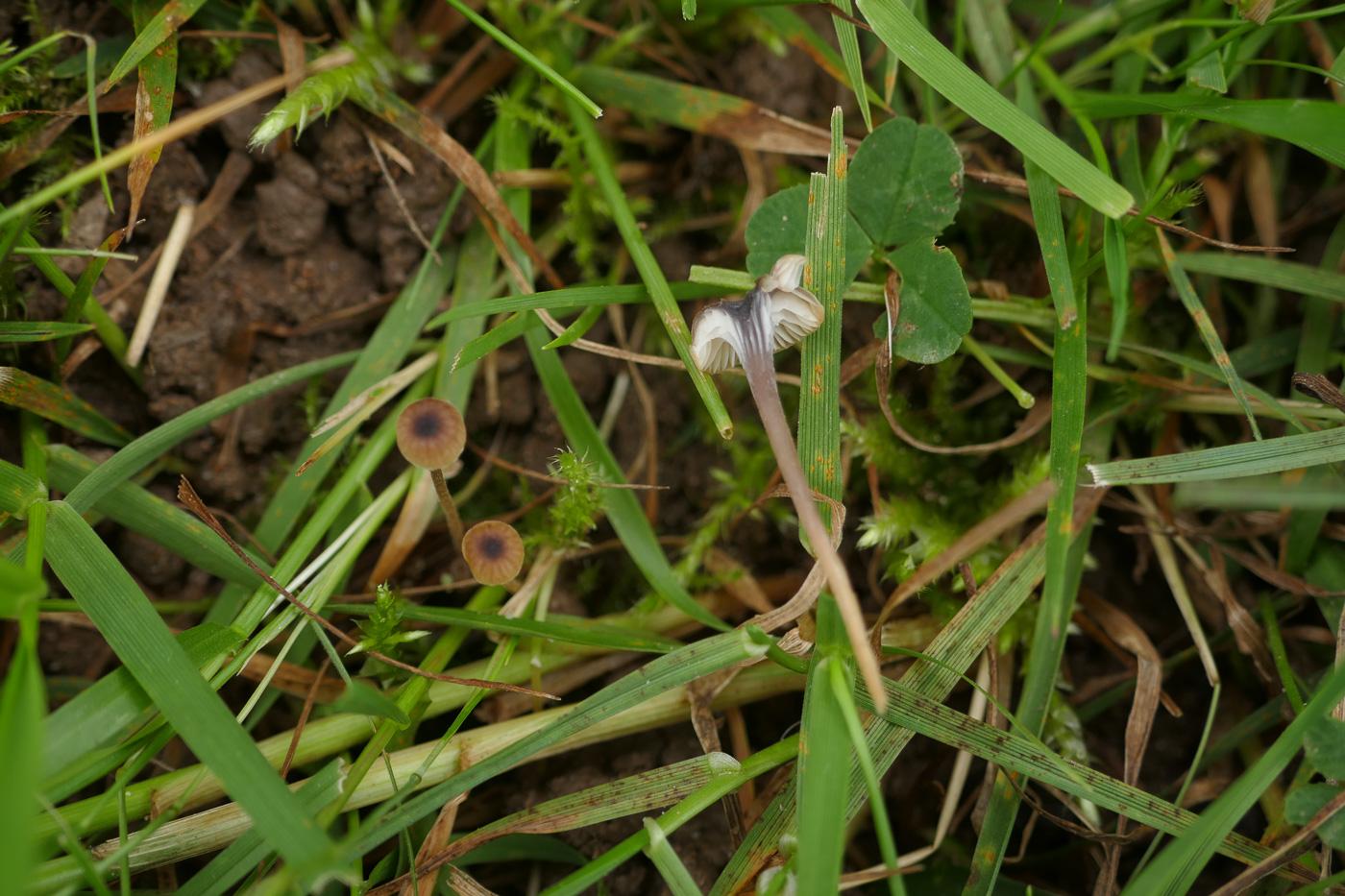 |
June 30th Rickenella swartzii (Collared Mosscap)
In short mossy grass at Stampwell Farm Jackie Ewan found this tiny mushroom, it being much the less common of the two species of Mosscap. At first glance this could be a small Mycena (Bonnet) but it lacks the microscopic features of that genus and is notable for its strongly decurrent (sloping) gills and the dark purple dot in the sunken cap centre, clearly visible in the photo. The much more common and orange R. fibula is the same size and shape and both species are found in moss. See R. fibula for comparison in Finds 21 July to Dec dated July 9th.
|
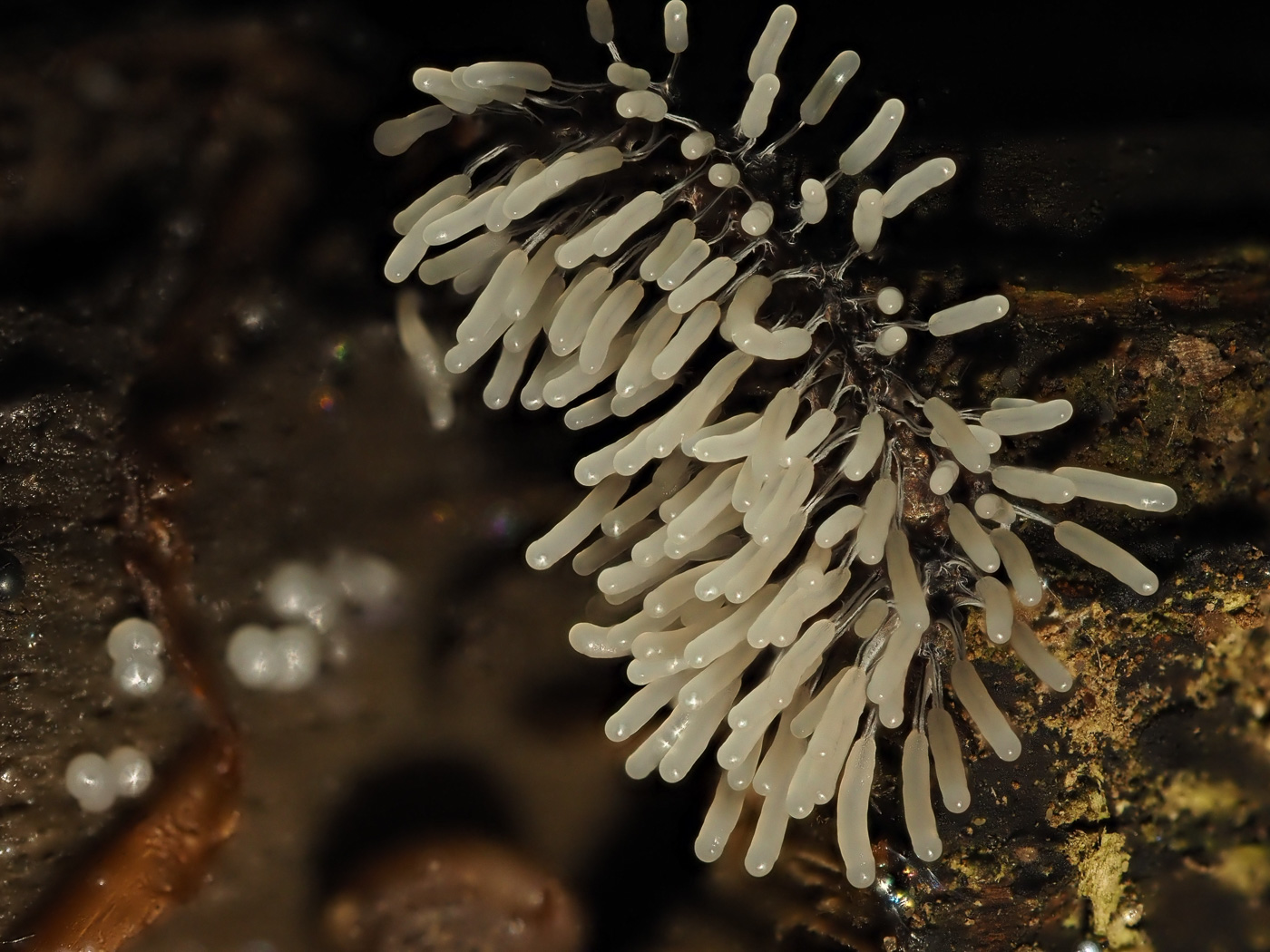
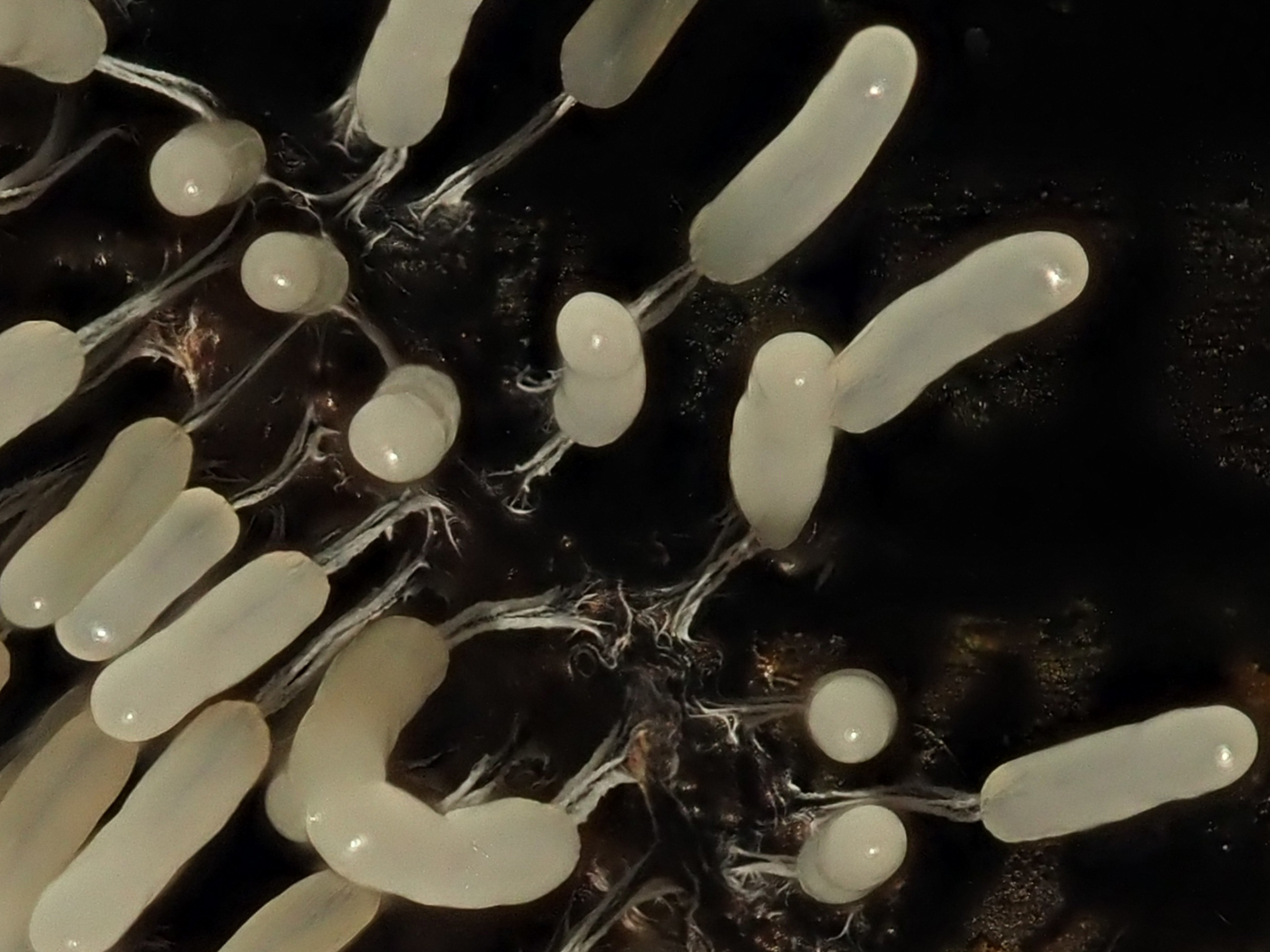 |
June 30th Stemonitopsis typhina (a Slime Mould with no common name)
On rotting wood in Downley Woods Claire Williams found this collection of tiny pale shiny tubes on short stalks and, realising it was a slime mould, she posted it onto the Slime Mould Facebook page where it was named for her. Her photo shows it still immature and white like its plasmodium and with a distinctive layer of pale slime covering the black stem (often described as like old fashioned silk stockings with a seam running down them (photo 2) - unique to the species). Later the tubes turn pink then brown and dry off becoming powdery and very similar to the related genus Stemonitis. See further images online and also in Barry Webb's page in Members' Finds.
|
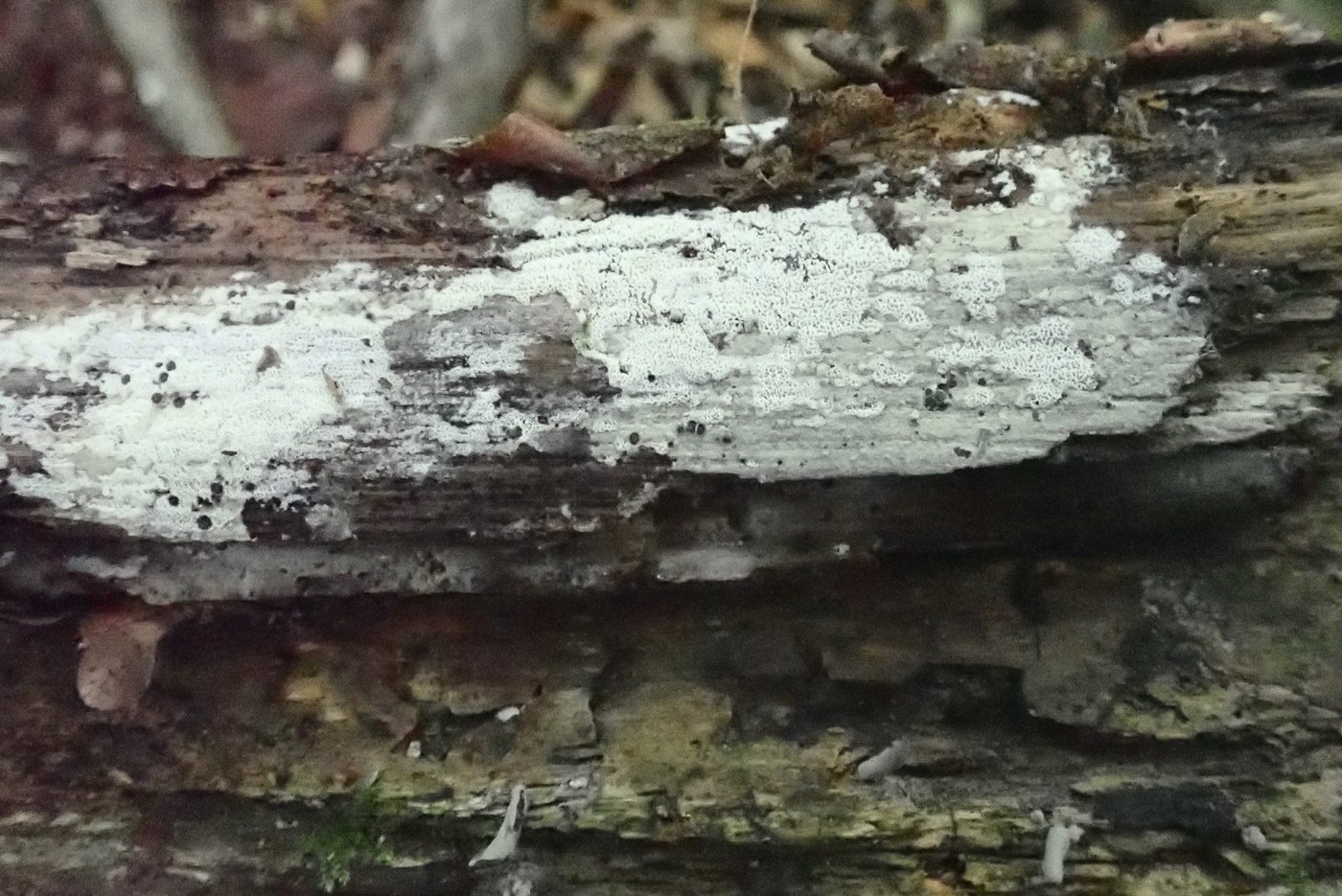
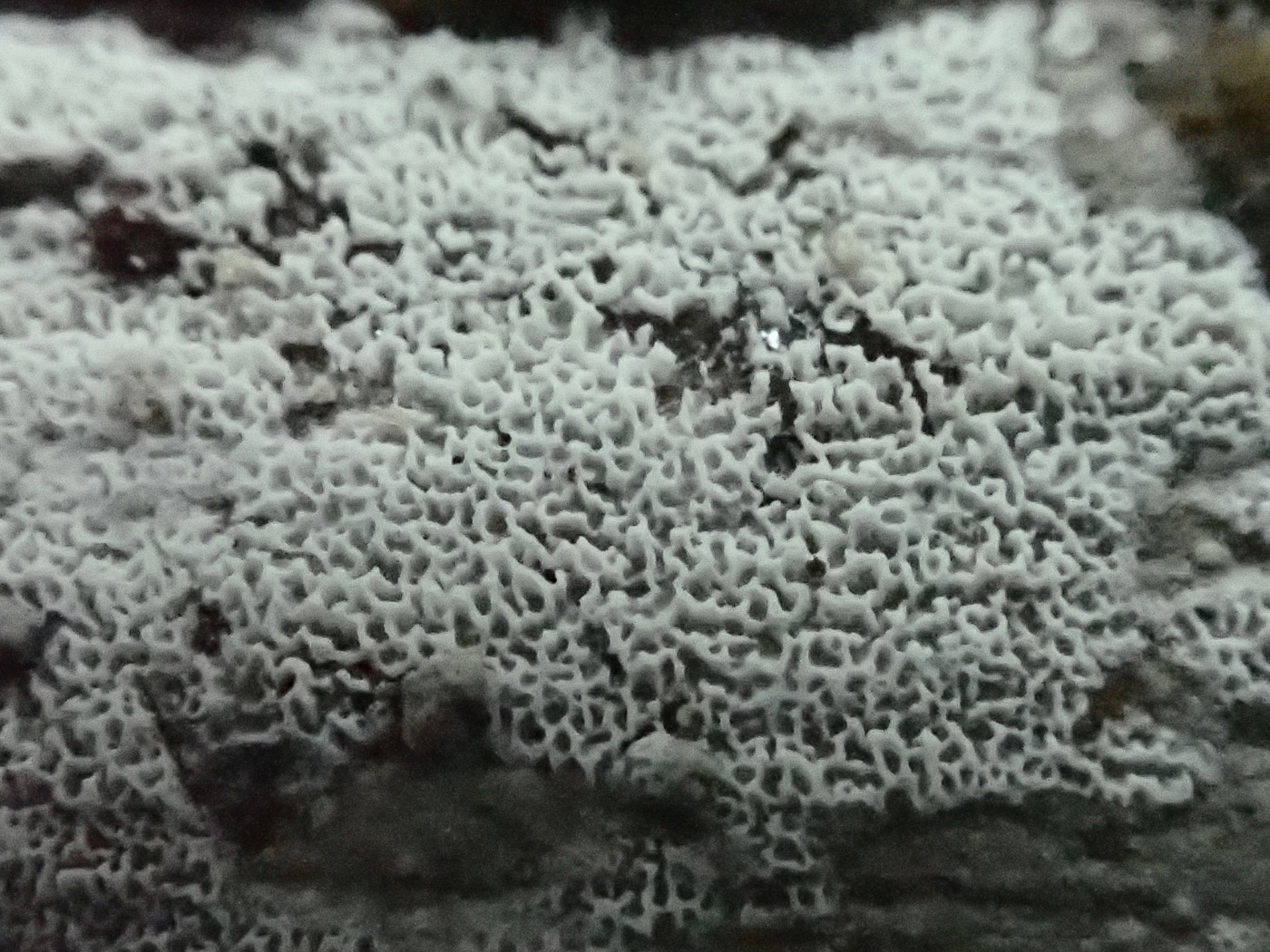 |
June 30th Ceriporia reticulata (a corticioid with no common name)
On a damp rotting Ash stick in Turville Heath Penny noticed this white patch which with a handlens looked distinctively poroid and also fresh enough to make a determination on the cards - corticioids not being her strong suit. It obligingly dropped a good sporeprint and the spore shape together with other microscopic features, also its very thin soft texture and general appearance, led to the name. Described as common and occurring on the wood of many deciduous trees, we have just four previous records from three sites in the county.
|
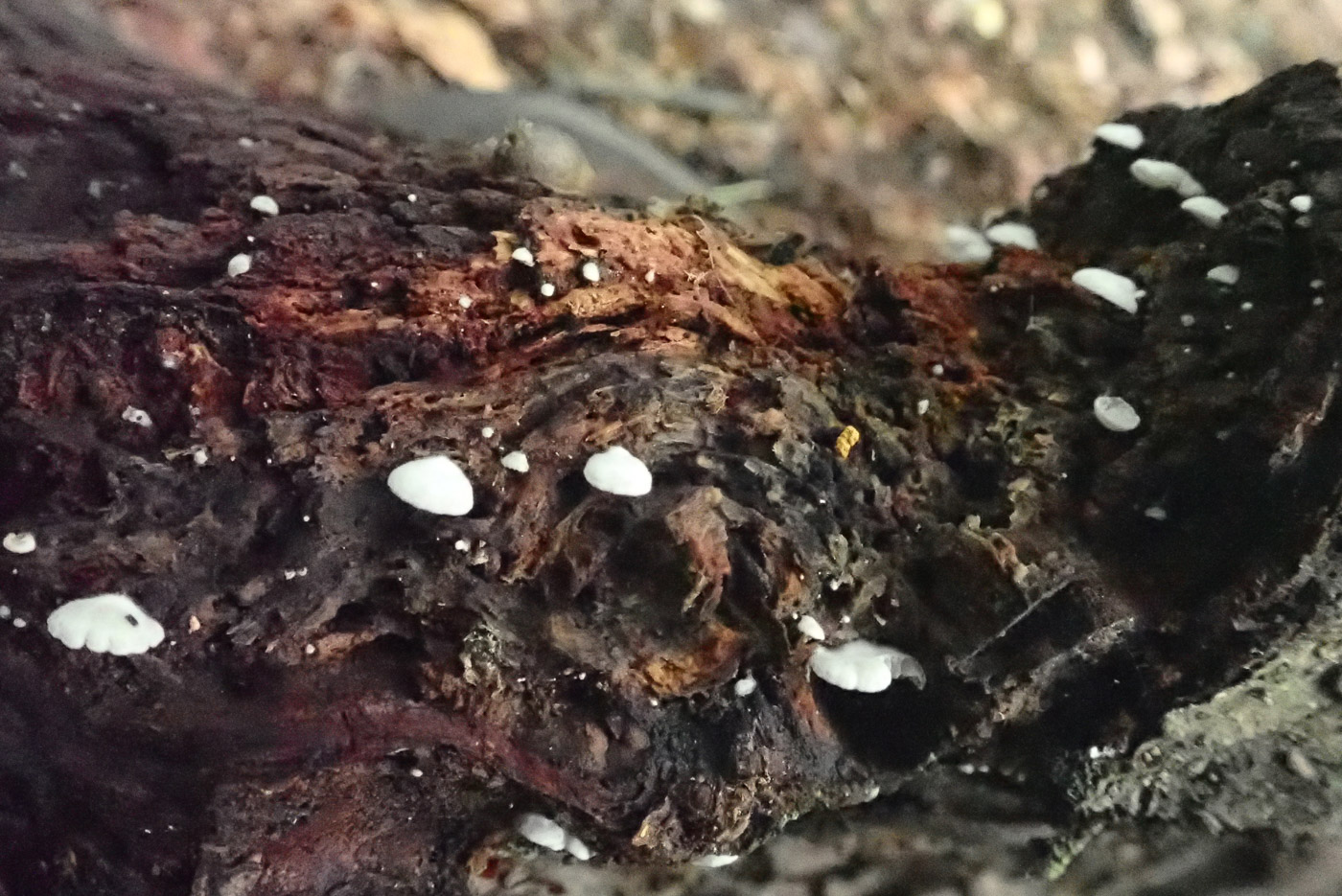
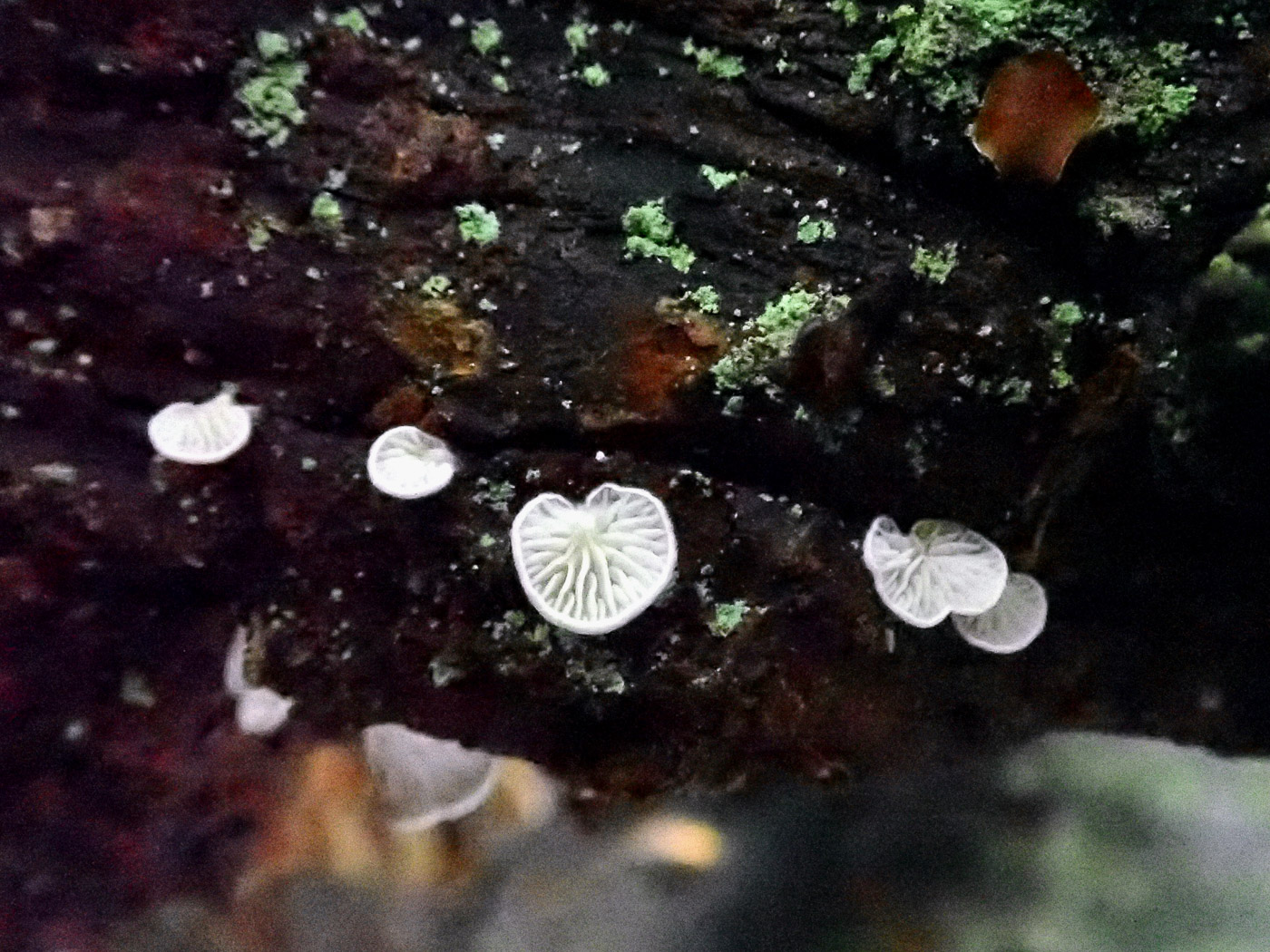 |
June 30th Clitopilus hobsonii (Miller's Oysterling) 
On a rotting deciduous log at Turville Heath Penny noticed some tiny white caps which, however, were stalkless and similar to seashells in shape therefore probably a species of Crepidotus or maybe their lookalike Clitopilus hobsonii. A sporeprint at home revealed pink rather than brown spores pointing to the Clitopilus, and sure enough the spores were ridged and fitted exactly for size and shape to confirm the less frequent C. hobsonii - not rare but something Penny seldom finds. In the same genus as the common grassland species the Miller (C. prunulus) this species never gets much bigger than 2 cm across and is only found on deciduous wood.
|
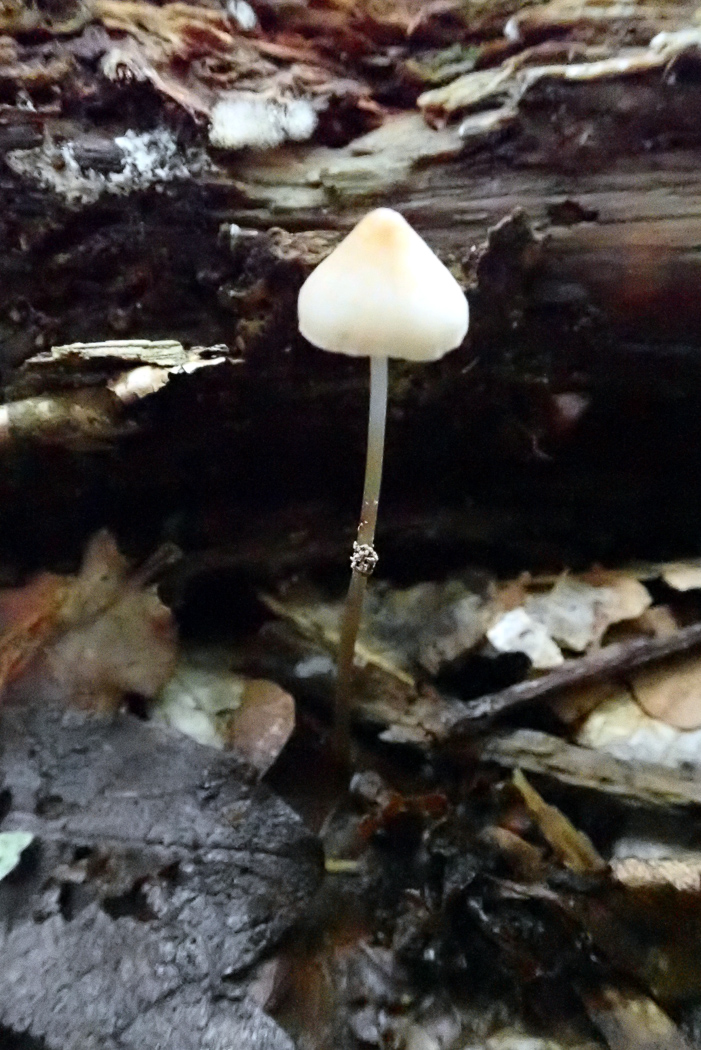
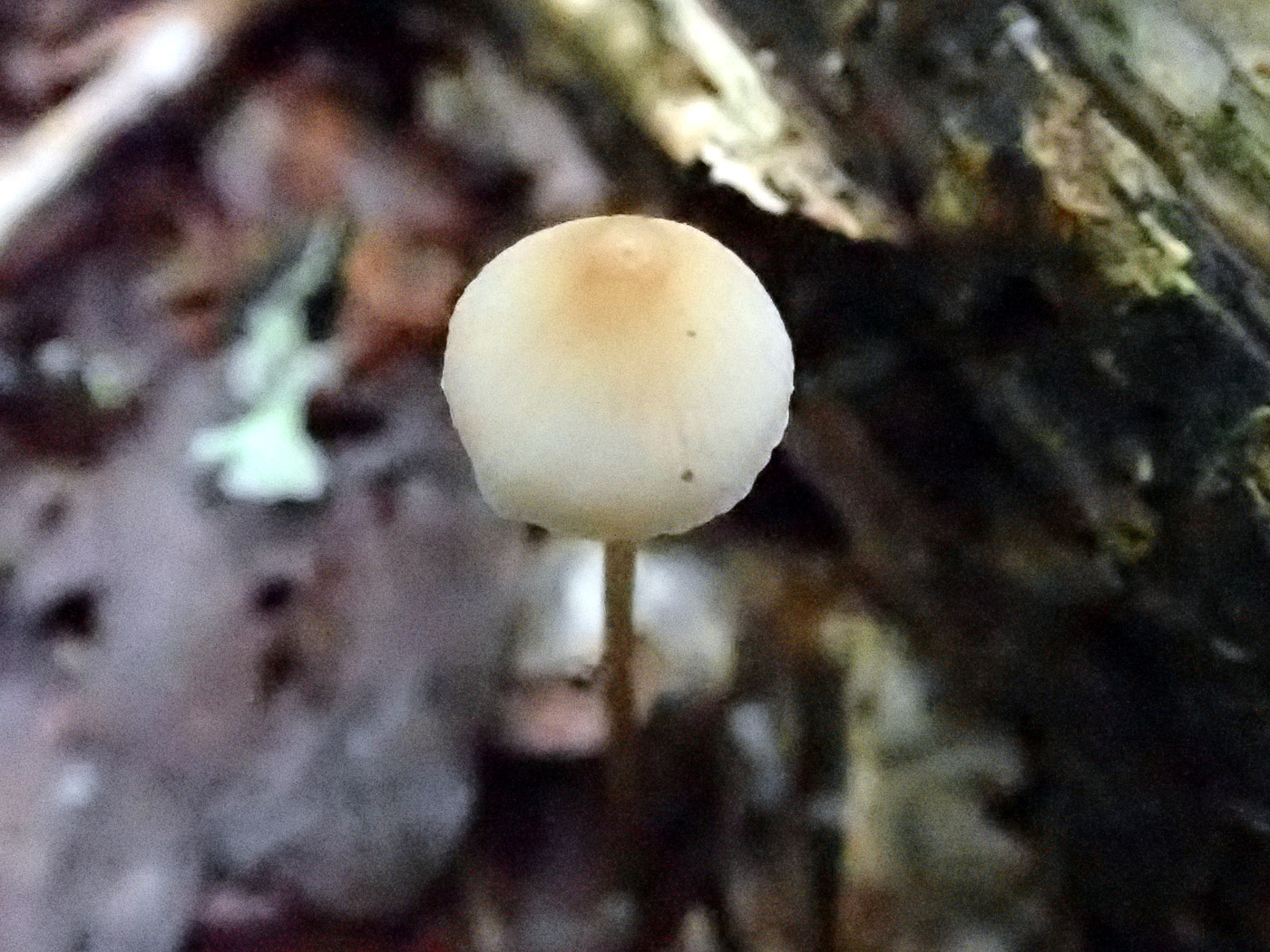 |
June 30th Mycena vitilis (Snapping Bonnet) 
At Turville Heath Penny was pleased to find just one specimen of a late summer to autumn Bonnet which was fruiting in woody deciduous litter. Despite being perhaps the most common Bonnet found in litter rather than on wood, it is one that needs a scope to confirm as there are so many other similar species which lack any really distinctive field characters. Its common name refers to its somewhat tough stem which is supposed to break with a slight 'snap' but this is not at all foolproof as others do so too! (The stem here has a small piece debris half way down and is not a ring as it might appear.)
|

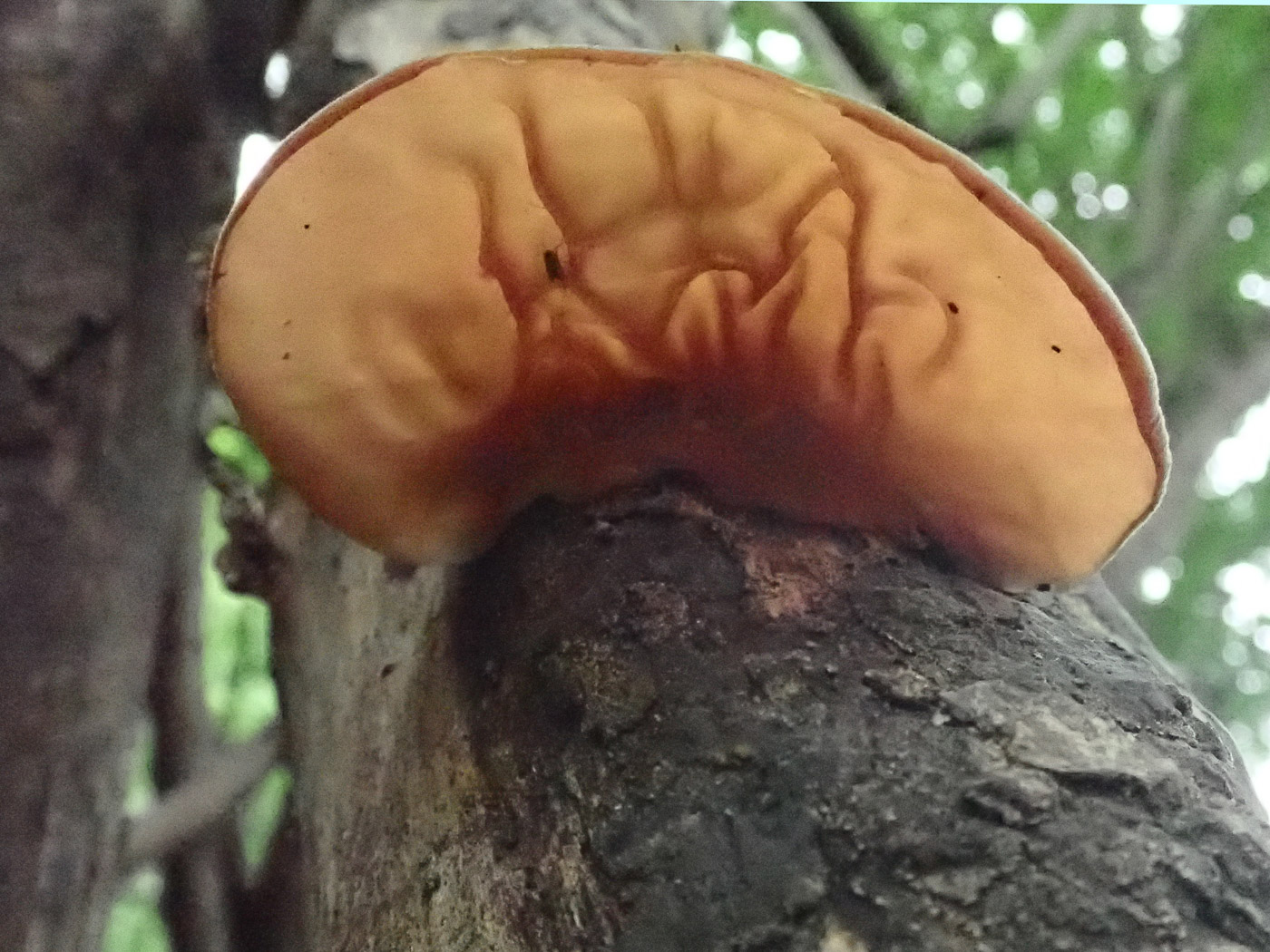 |
June 30th Auricularia auricula-judae (Wood Ear)
At Turville Heath Penny couldn't resist this very realistic example of a common jelly fungus found often on both living and fallen Elder as it was here. Photo 2 was taken from underneath showing the typical veined surface and thin almost transparent flesh. See also an unusual and beautiful white form of the species, dated Feb 5th.
|
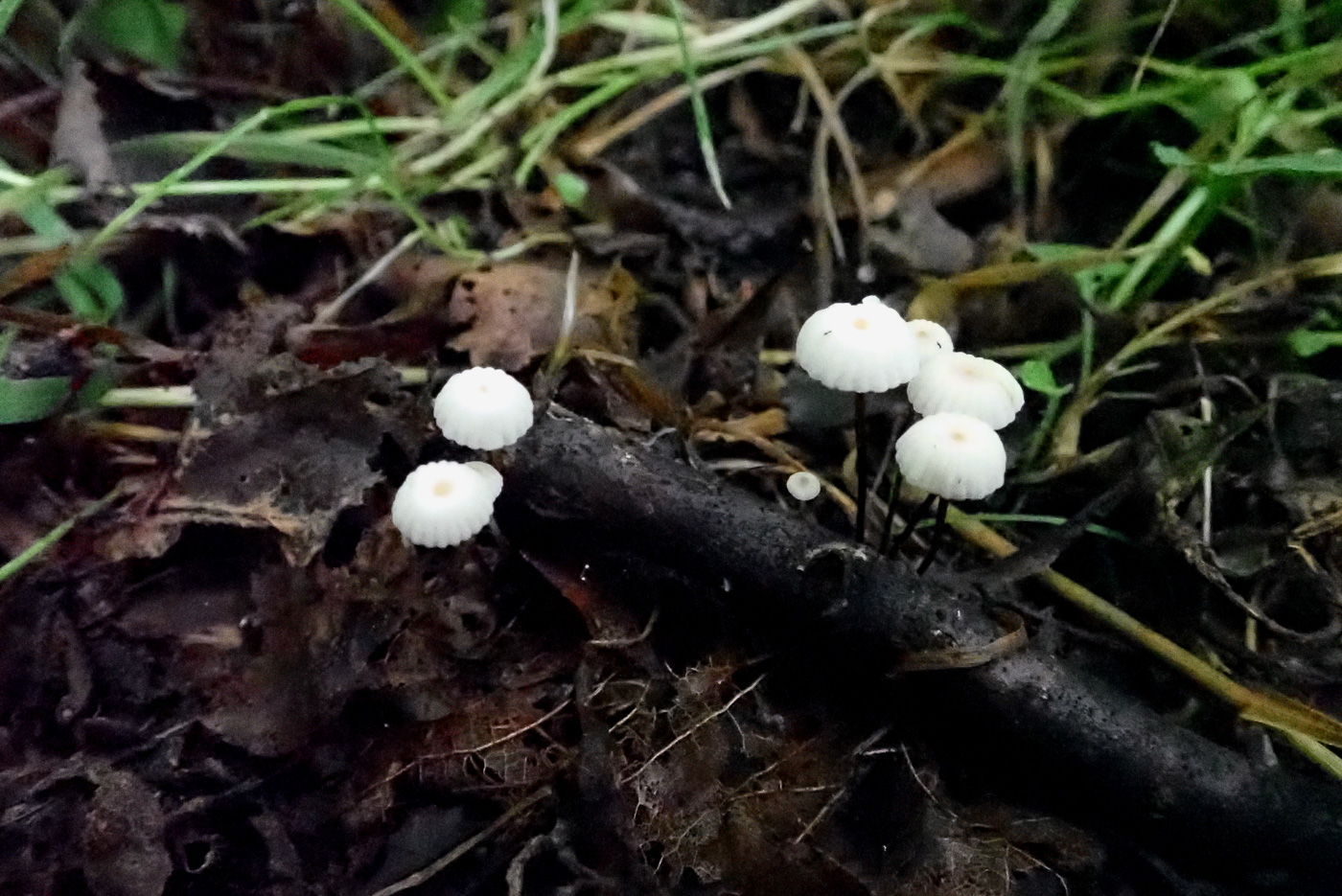
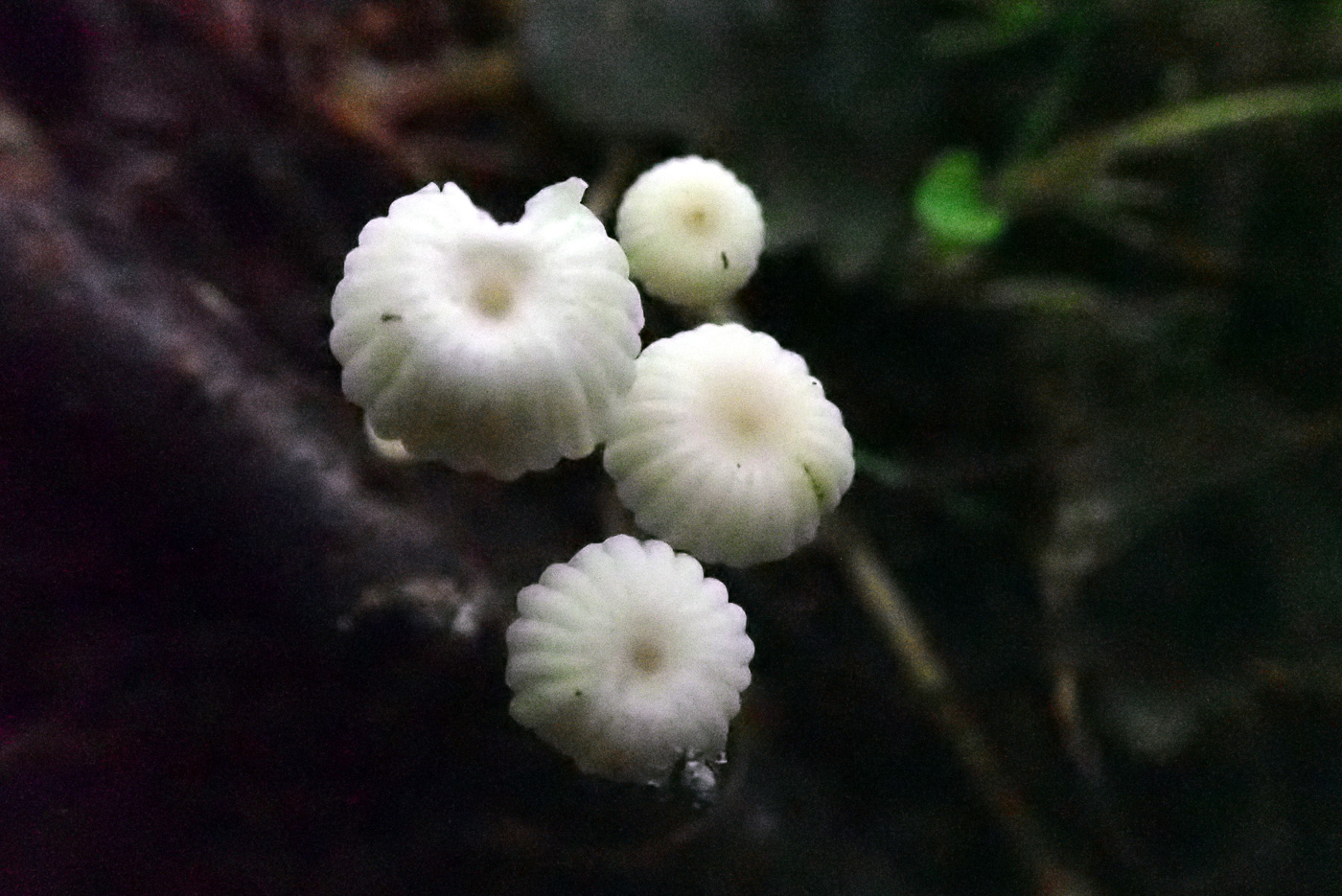
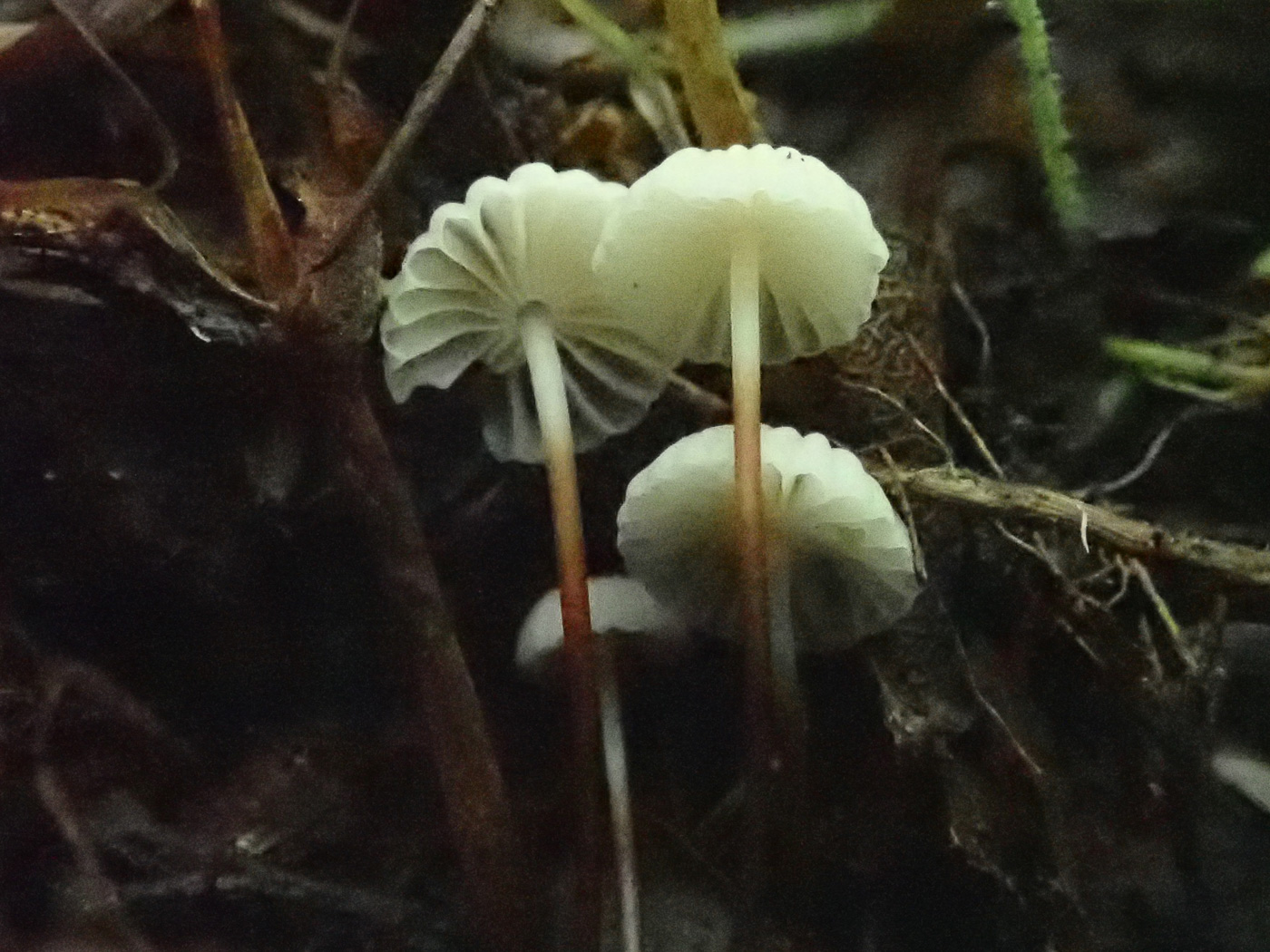 |
June 30th Marasmius rotula (Collared Parachute)
At Turville Heath Penny found good numbers of this small white common mushroom coming up in deciduous woody litter on damp sticks. Similar to a small white species of Mycena (Bonnet), the caps - up to 1 cm across or more - have a fluted edge with a darker 'eye' in the middle, the wiry stems are white at the top but below this orange then brown then black - typical of many in this genus, and finally the clincher: look for the cog-wheel free collar around the stem top to which the widely spaced gills attach (see photo 2). Only one other species, the much rarer Marasmius bulliardii, has this particular feature but it's even smaller than M. rotula with a more distinct blackish 'eye' and is found on deciduous leaves (most often Beech), not on wood.
|
June 28th 2021
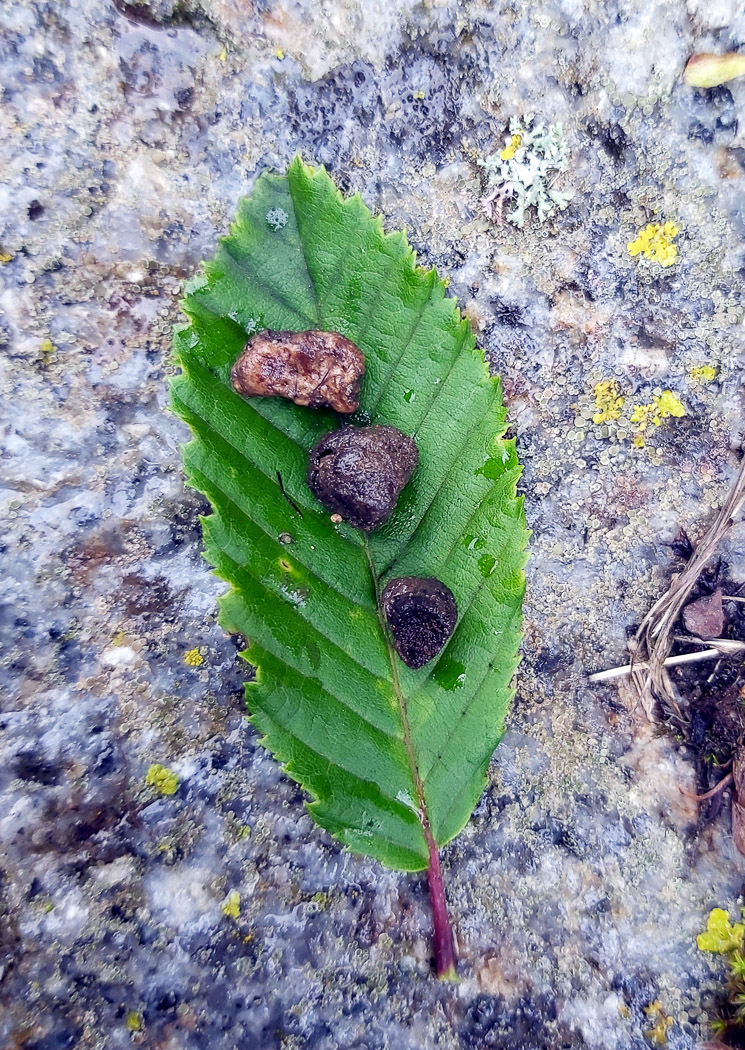 |
June 28th Hymenogaster citrinus (a species of Truffle with no common name) 
In Beaconsfield in a private garden, Jesper Launder spotted some 'dig holes' in grass under Hornbeam. Further investigation revealed three small dark brown truffles which he took home to work on and, having identified this species on a previous occasion, was able to make the determination. This is a difficult genus, having many species, though there are few mycologists who find and / or look at the various truffle genera, so we are lucky to have Jesper's expertise. This is a new county record and there are under 50 national records, so this was a notable find.
|
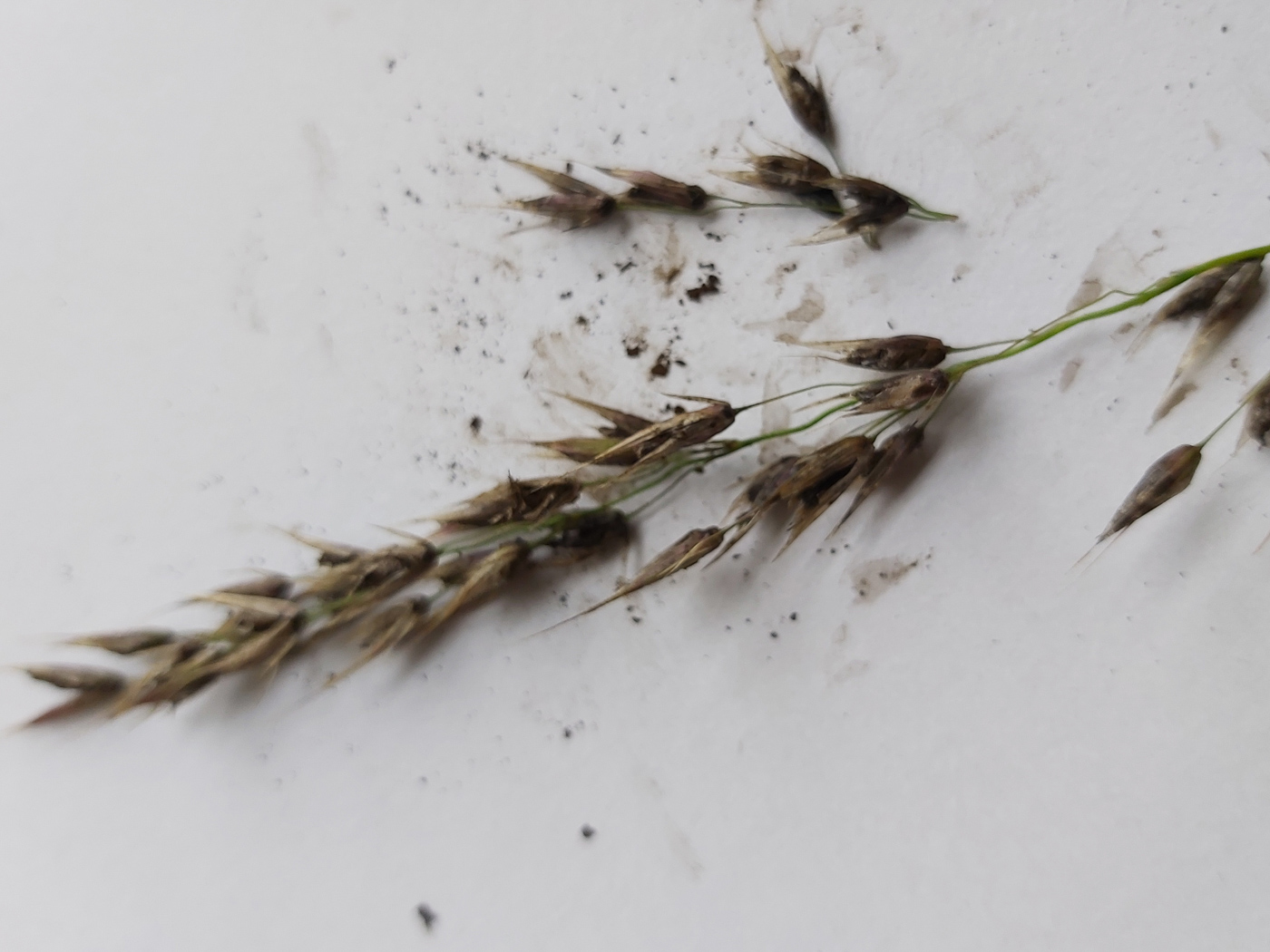
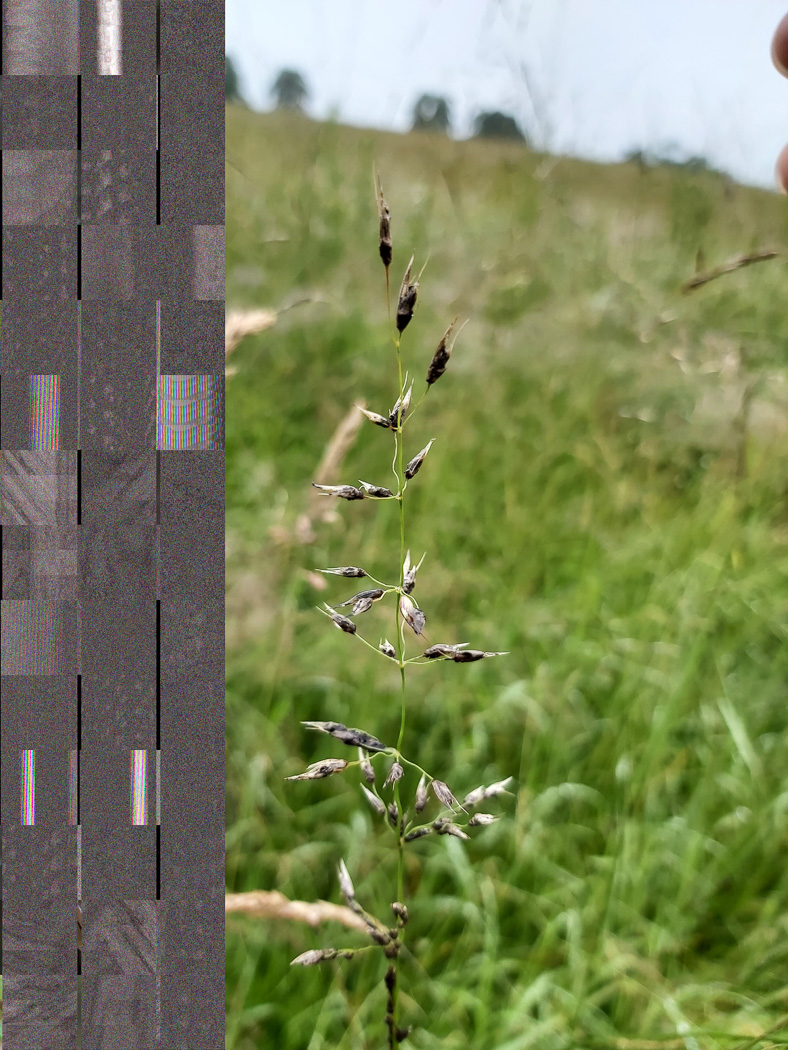 |
June 28th Ustilago avenae (Loose Smut) 
On his usual dogwalk around Jordans village Jesper Launder noticed this inconspicuous species growing on False Oat Grass. Though not a rarity this is a new species for the county, sadly reflecting the lack of local mycologists looking out for such species. Smuts are parasitic fungi found on grasses and are often host specific, thus if you know your grasses it makes identification of the smut species much easier.
|
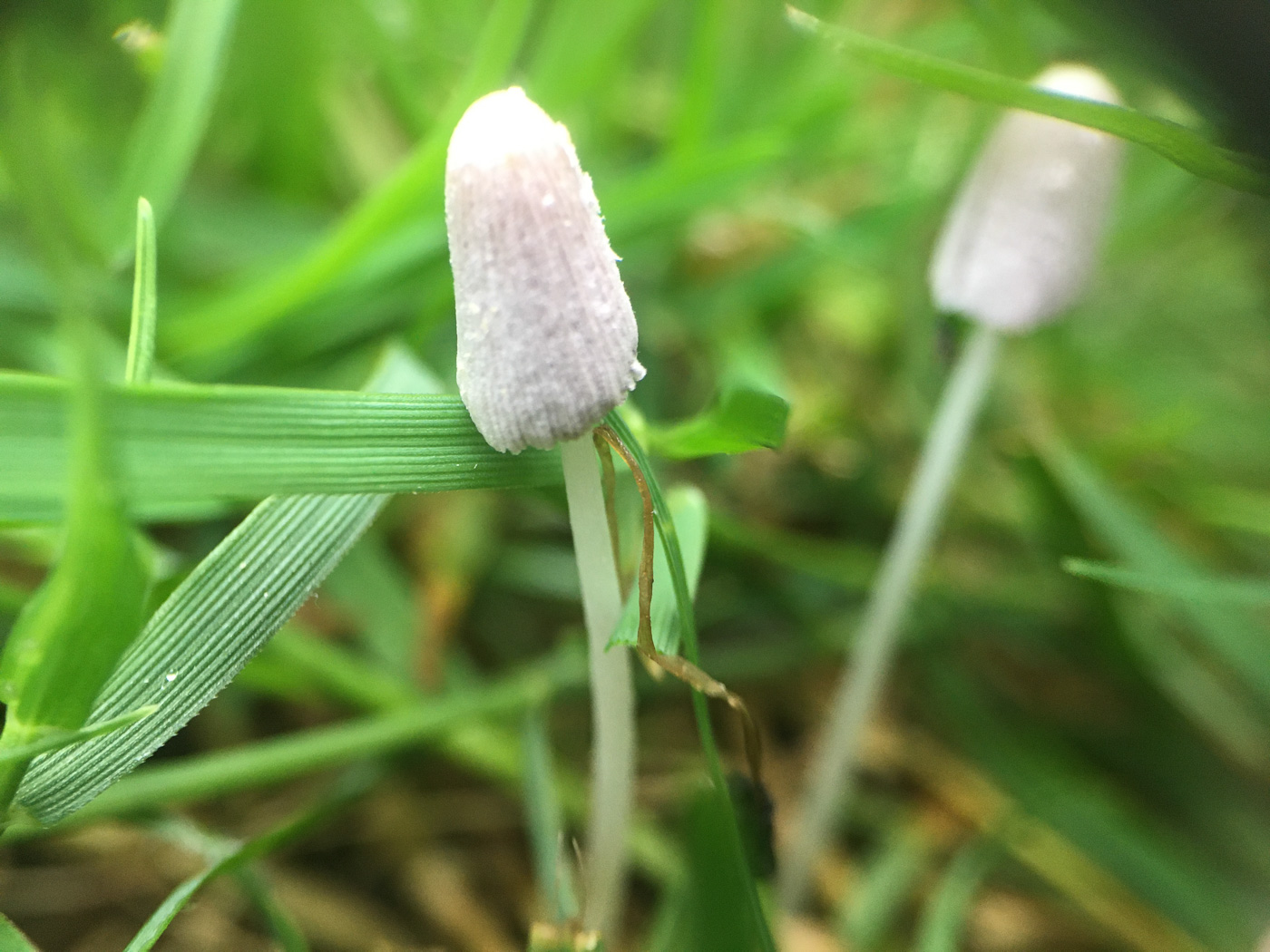 |
June 28th Coprinopsis friesii (an Inkcap with no common name) 
In his lawn at home in Burnham Russell Ness found these tiny Inkcaps, the caps being no more than 7 mm tall. He noted that they 'deliquesced' very quickly (a feature of the species) and checked the microscopy including spores and the veil (which can be seen as a light dusting on the cap surface) to confirm the identification. Derek was able to confirm Russell's identification through his emailed microphotos and says this is a common species which grows in dead and dying grass stems. However, we have only a few county records from just three other sites, so this was a nice find.
|
June 26th 2021
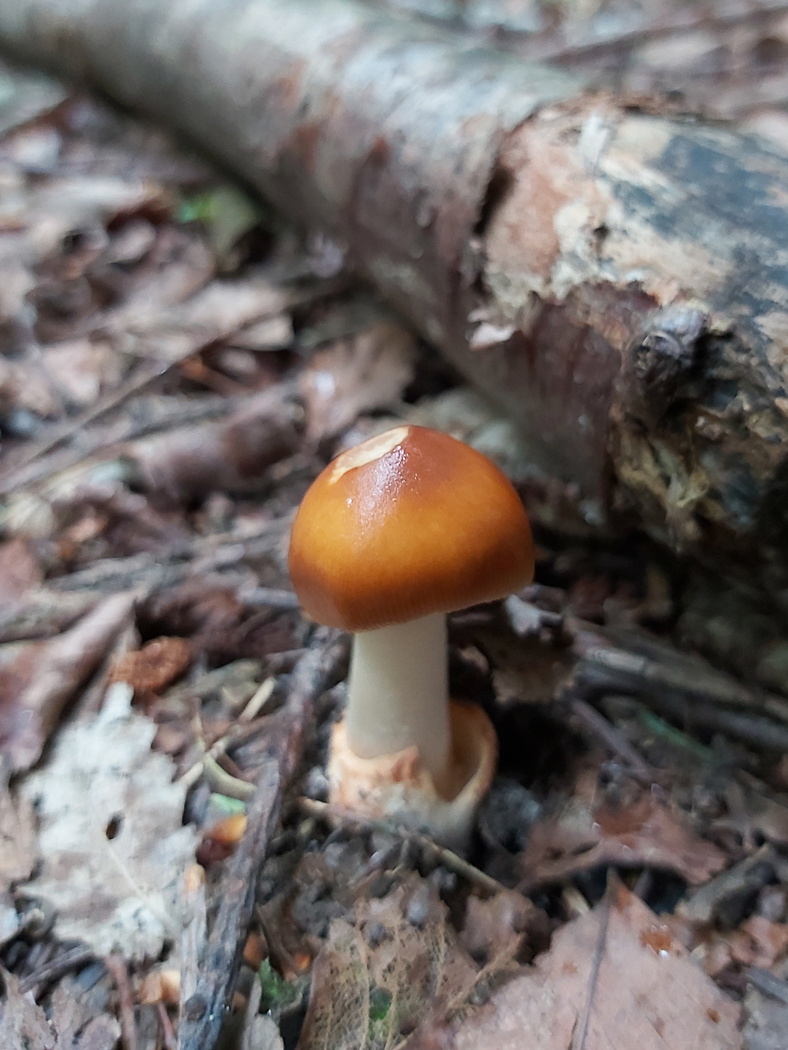 |
June 26th Amanita fulva (Tawny Grisette)
When walking in Chalfont St. Giles Jesper Launder spotted this early fruiting Amanita species just emerging. Here the volva at the stem base with its chestnut rim can be seen as the stem stem evxpands, note also the patch of veil still in tact on the cap though once mature the veil has usually disappeared. This is one of the genus which lacks a ring on the stem which is usually tapering upwards once the fruit body is fully expanded. Common under Birch and often early in the season, this species can also be found under other deciduous trees.
|
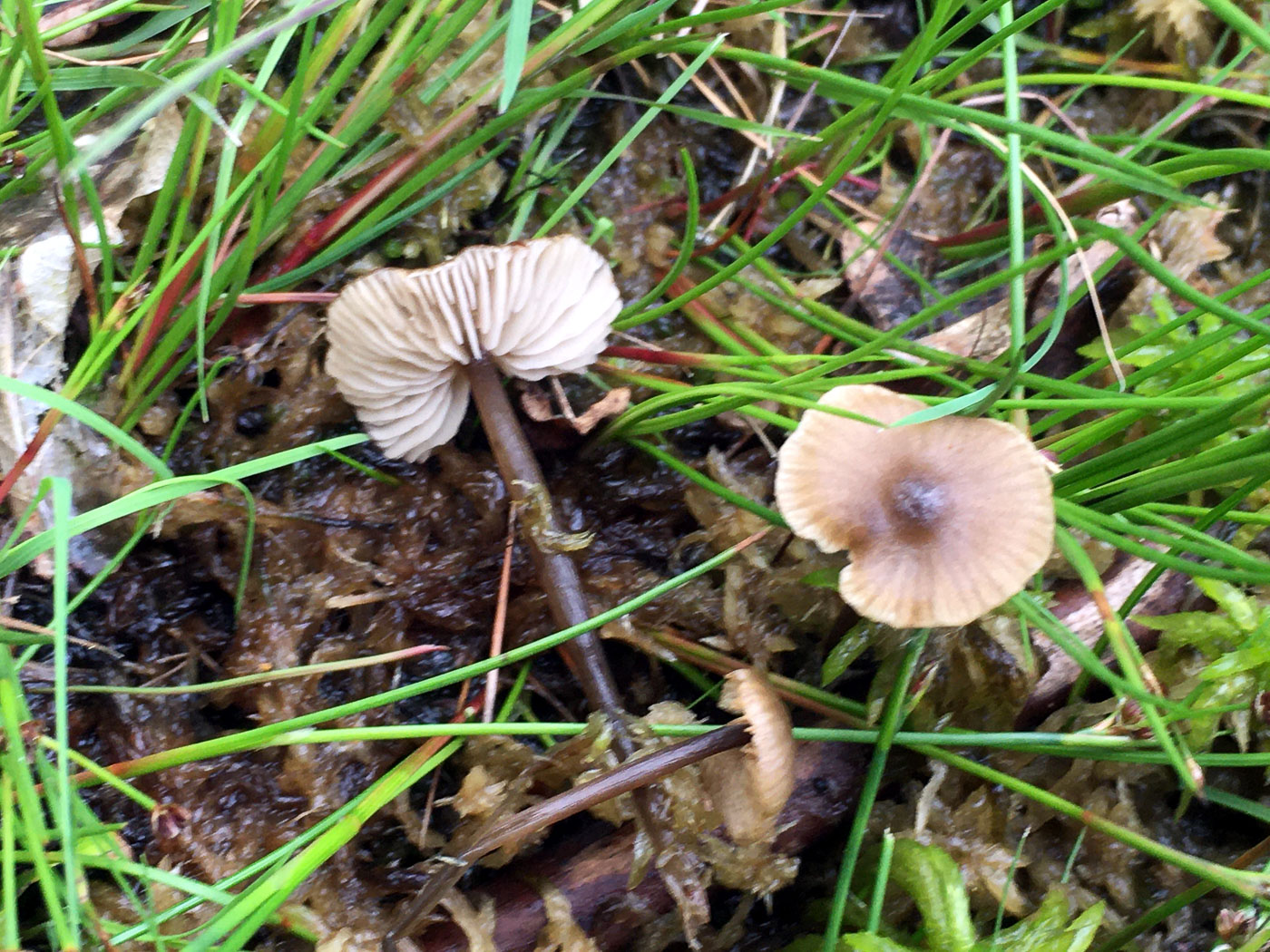
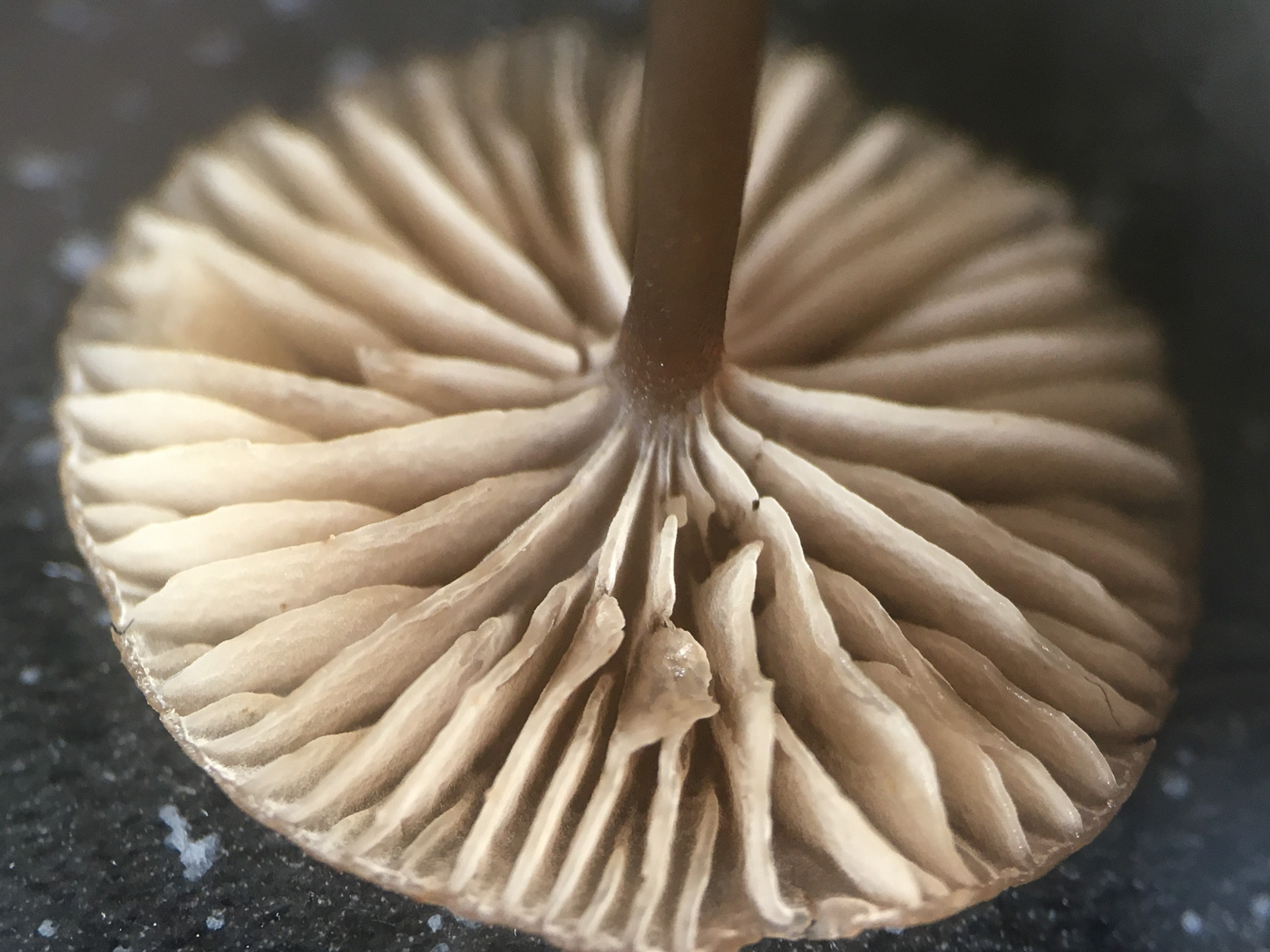
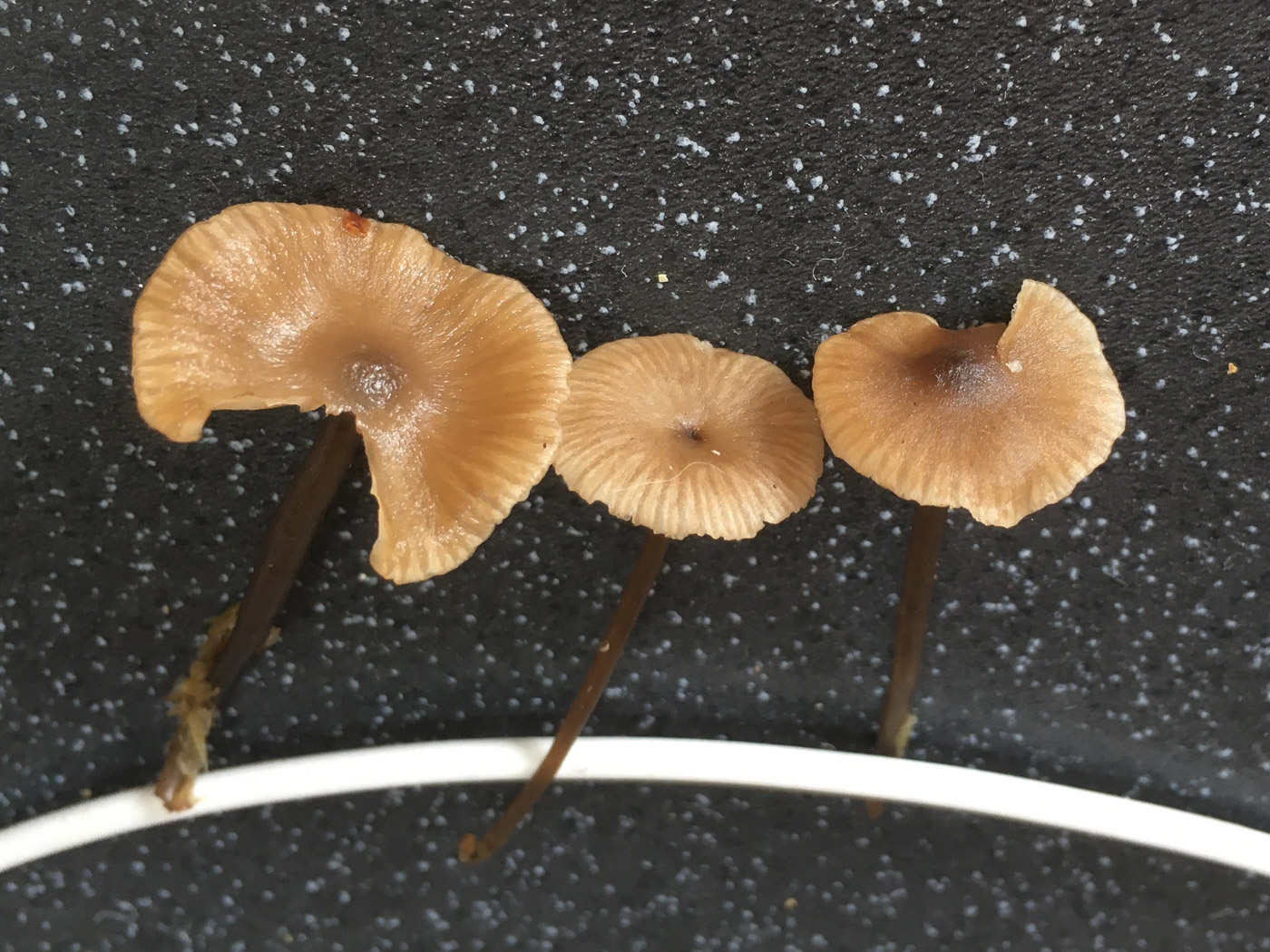 |
June 26th Sphagnurus paluster (an Agaric with no common name) 
In a boggy area in Burnham Beeches Russell Ness found this unusual species growing in Sphagnum (a previous name was Tephrocybe palustris, the species name referring to marshes / mires). This is a typical LBJ looking somewhat similar to an Entoloma but in the field has a couple of redeeming features besides the fact that it only occurs with Sphagnum: The spores are white (unlike the pink spores of Entoloma), the gills are emarginate to slightly decurrent (see photo 2) and it has a distinctive rather strong rancid smell which some describe as of cucumber! We have just three previous county records, all from various parts of Burnham Beeches.
|
June 24th 2021
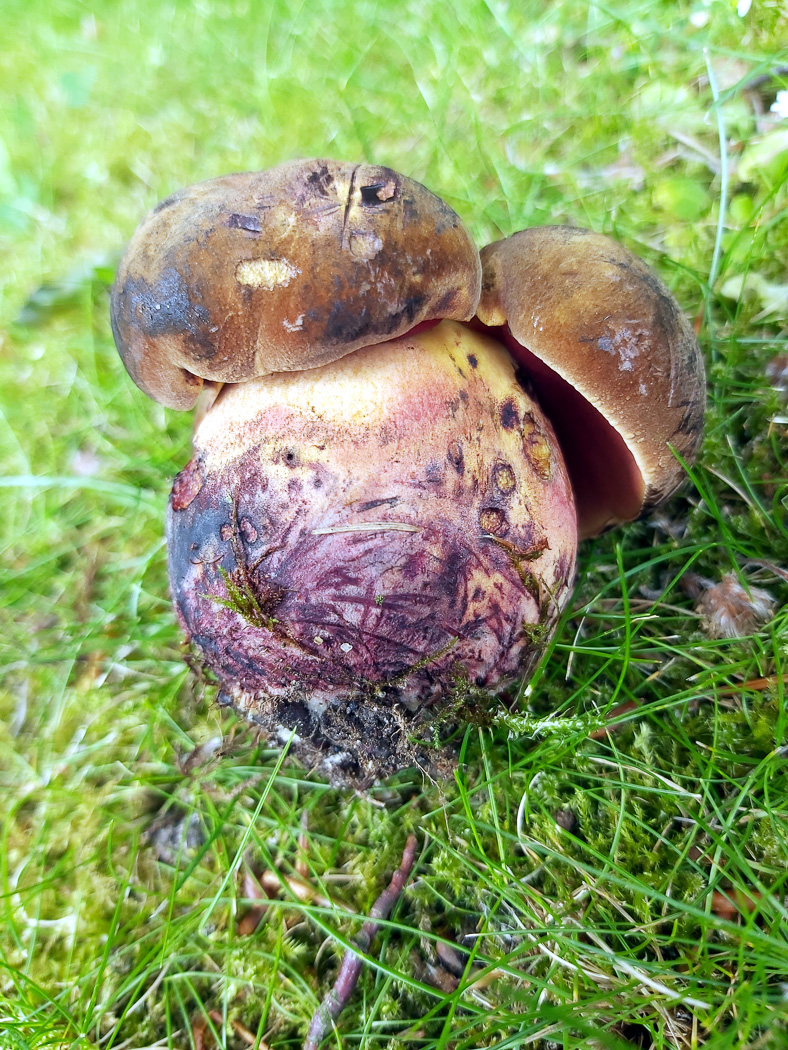 |
June 24th Neoboletus luridiformis (Scarletina Bolete)
In his local patch around Jordans village Jesper Launder noticed this early fruiting of a distinctive species of Bolete. This is one that appears frequently on our early autumn lists and, like several other species, can often start popping up in summer if conditions are suitably moist and warm. It is notable for its robust shape and size, the combination of brown cap and red pores which blue remarkably strongly when pressed, as also does the flesh if one cuts into the stem, it is happy under a mix of different deciduous trees, particularly Beech and Oak. So one to be looking out for now.
|
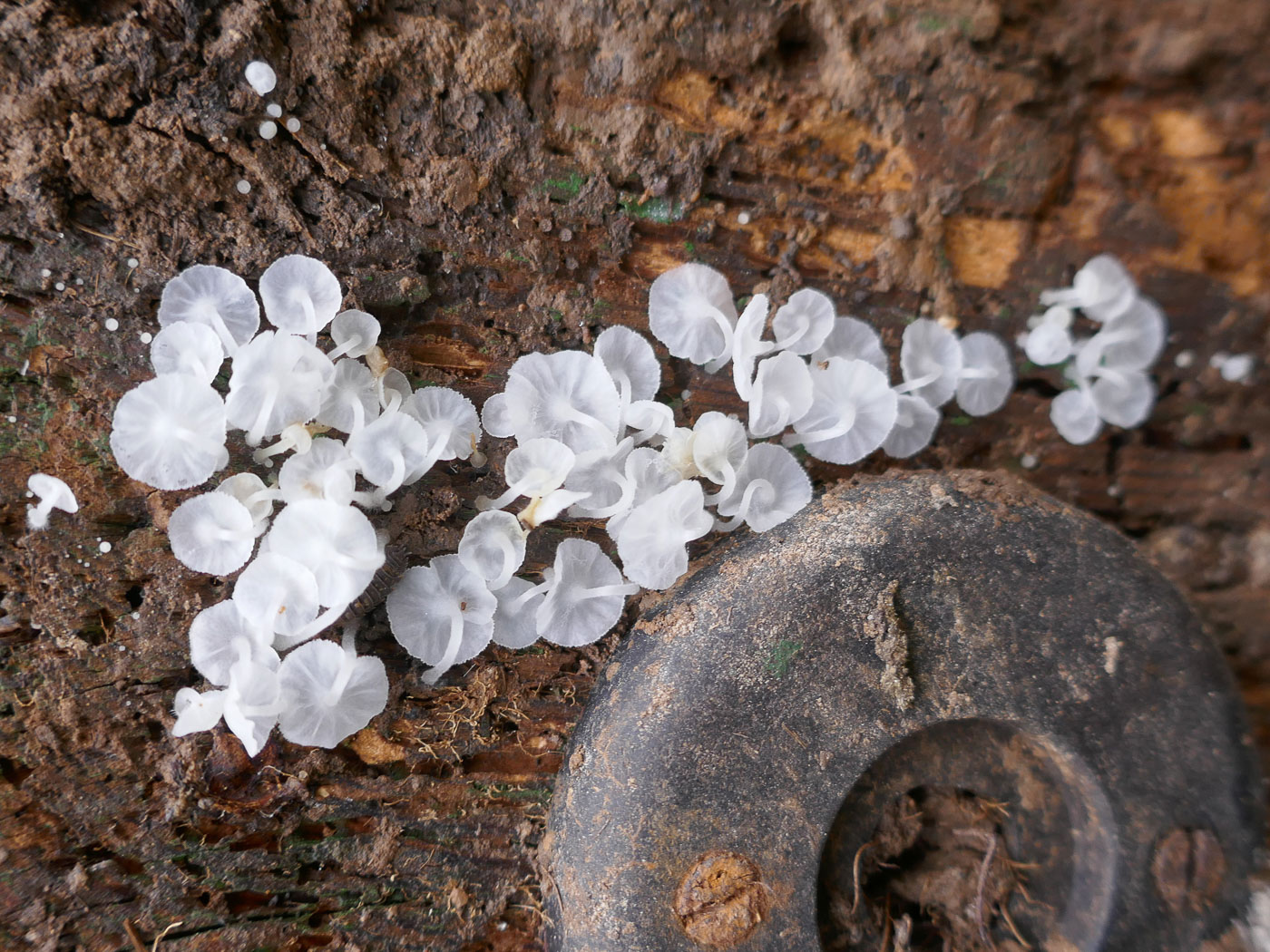
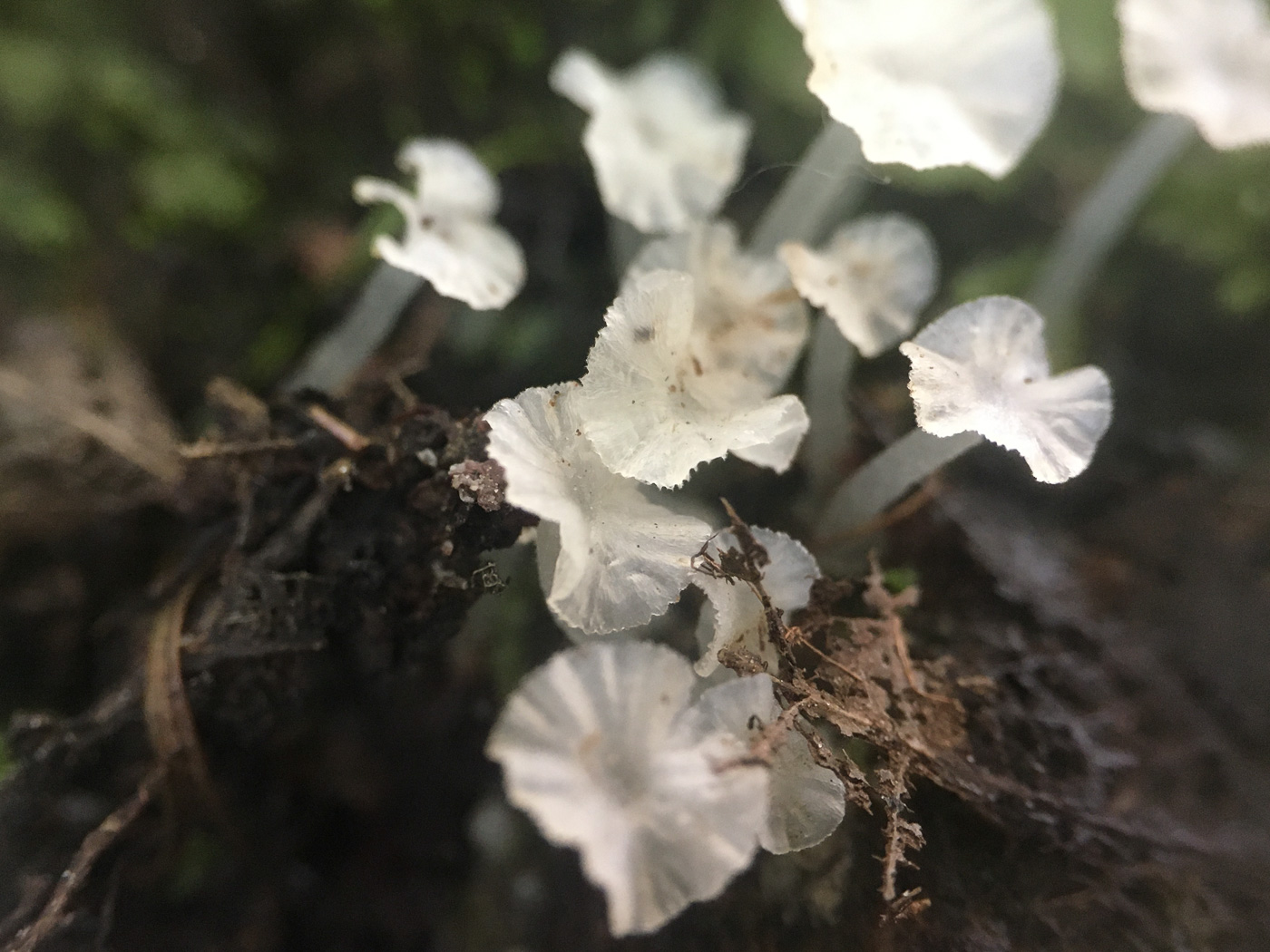
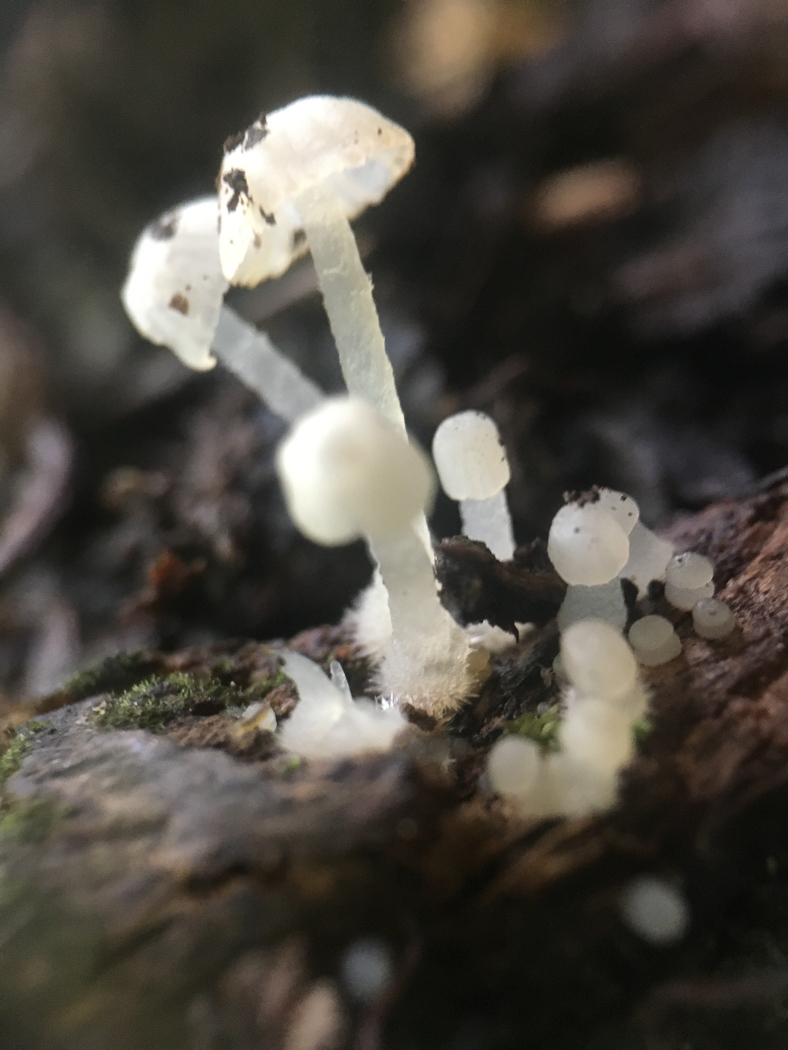 |
June 24th Delicatula integrella (a Mycena look-alike with no common name) 
Jackie Ewan noticed this cluster of tiny white mushrooms (photo 1) at Stampwell Farm growing on the underside of an old door now used as a reptile refuge! Then two days later Russell Ness found the same species in the mire at Burnham Beeches growing in good numbers on alder roots (photos 2 and 3). At first glance this could be one of several miniscule species of white Bonnets which can occur on rotting wood but there are clues which point to its identity in the field though this really needs confirmation from its microscopic characters (spore shape and size, also the lack of cystidia on the gill edge). Note the slightly serrated cap edge and rather veinlike reduced gills particularly towards the margin. Caps, no larger than 1 cm across, have an opaque spot in the centre. We have just a few sites where this occasional species has turned up - so two nice finds.
|
June 23rd 2021
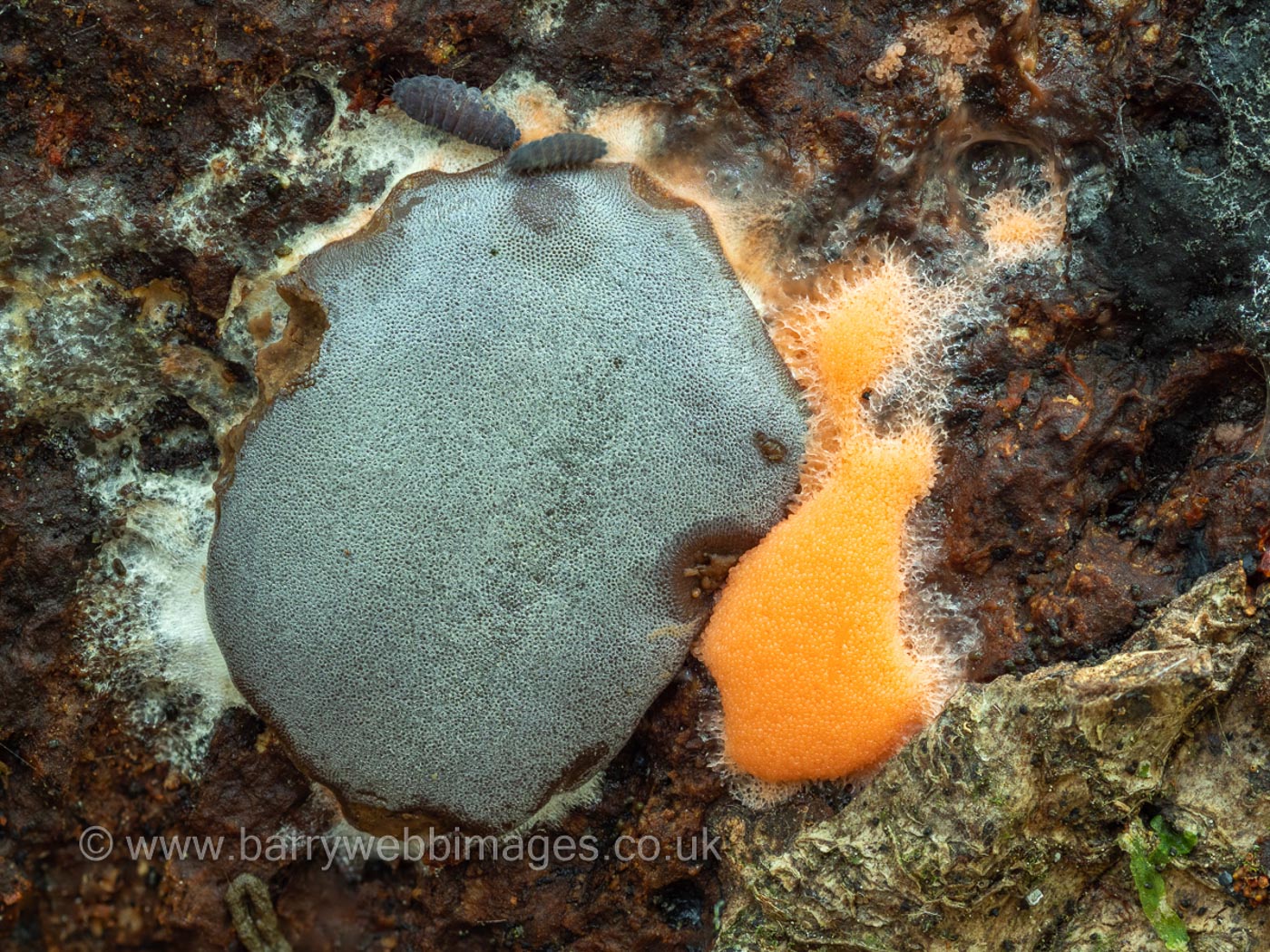 |
June 23rd Dictydiaethalium plumbeum (a Slime Mould with no common name)
On fallen Beech at Burnham Beeches Barry Webb found this unusual slime mould, one which is new to the site and with just two previous county records. It is a species with bright pink to orange plasmodium (seen here) which turns first grey (hence its Latin species name) then yellow-brown and forms flattened patches on rotting deciduous wood up to 5 cm long x 1 cm thick. At the plasmodium stage it would be possible to mistake it for the common Tubifera ferruginosa (also bright pink orange) if one was not aware of the identity of the host wood. Today's species occurs on rotting deciduous wood, especially Beech; T. ferruginosa occurs on rotting conifer (occasionally on alder or Birch)
|
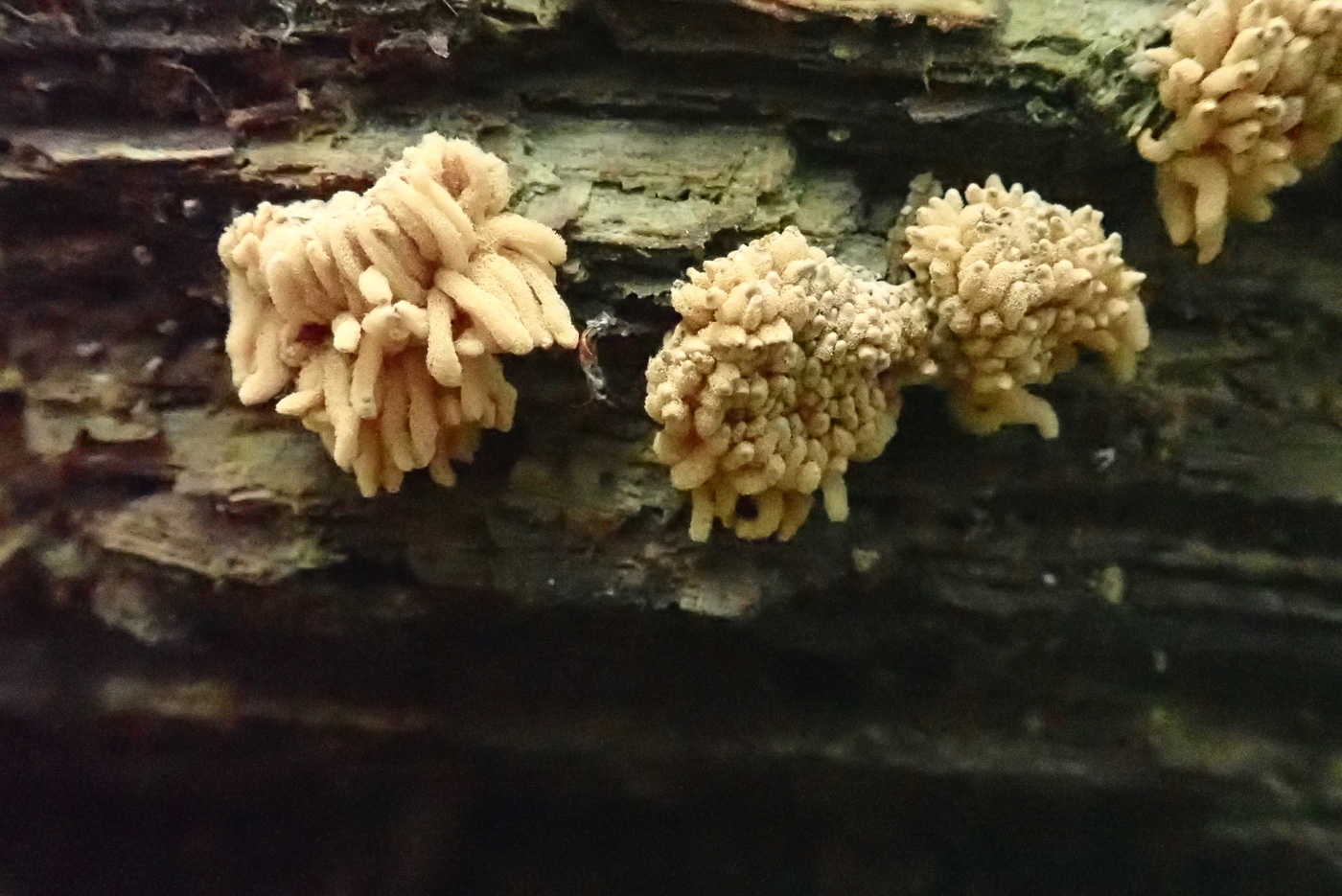
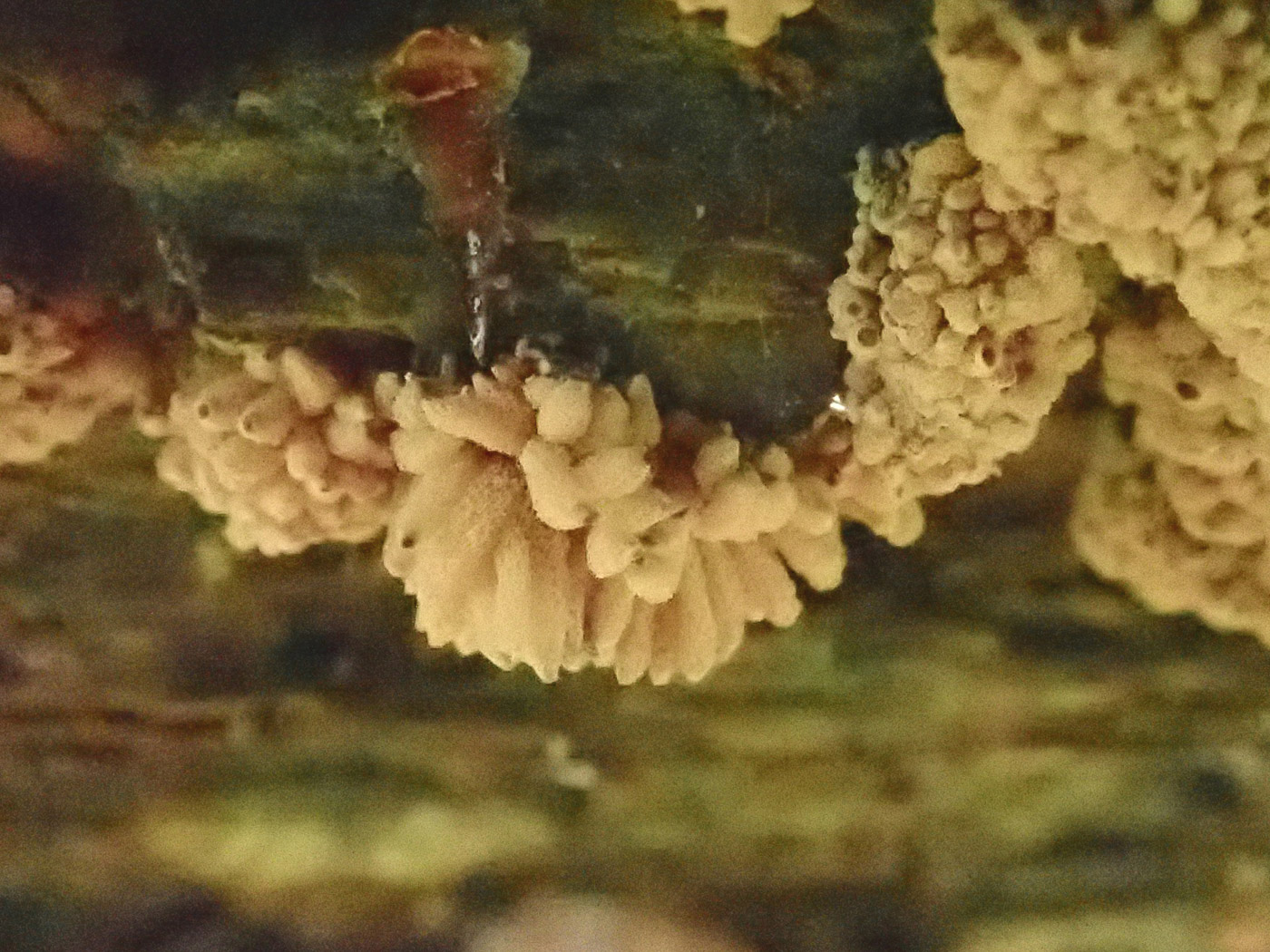 |
June 23rd Arcyria obvelata (a Slime Mould with no common name) 
At Stoke Common there was surprisingly little fungi about today despite the recent rain, but one that Penny found on an unidentified bare rotting log was this rather droopy species of Arcyria - an apt name for the genus would be Loofah but as with the majority of Slime Moulds no common name exists. The pale buff colour, very short stalks and flimsy heads which soon blow away when mature are characters which distinguish it from other species in the field. Apparently quite common, we have just two previous county records from Penn Wood but it seems to be new for today's site. See also amongst Barry Webbs Slime Mould photos.
|
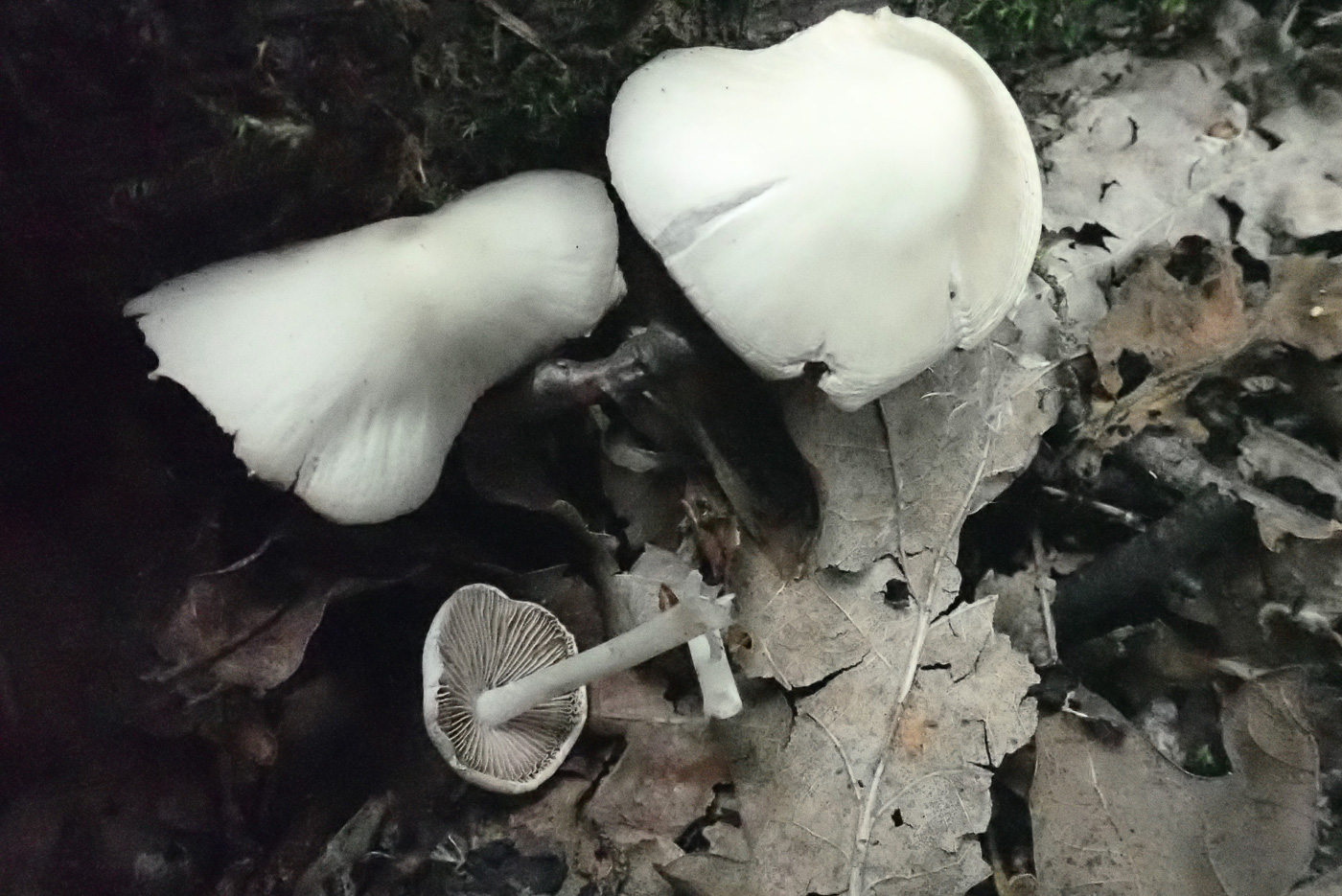 |
June 23rd Psathyrella candolleana (Pale Brittlestem) 
The only Agaric Penny managed to find at Stoke Common today was this species, nestling almost under a fallen Oak log. Possibly the commonest species in this large and tricky genus, it frequents grassy path edges and woody litter and is often one of the first mushrooms to appear in early summer. When young the very pale gills belie the dark spores which develop later to darken the gills, thus fooling one into thinking it must be a different genus, but the thin white fragile stem together with almost white cap are typical, as seen here. Often the cap has ragged bits of veil around the rim - missing today, however, probably due to the recent heavy rain.
|
June 22nd 2021
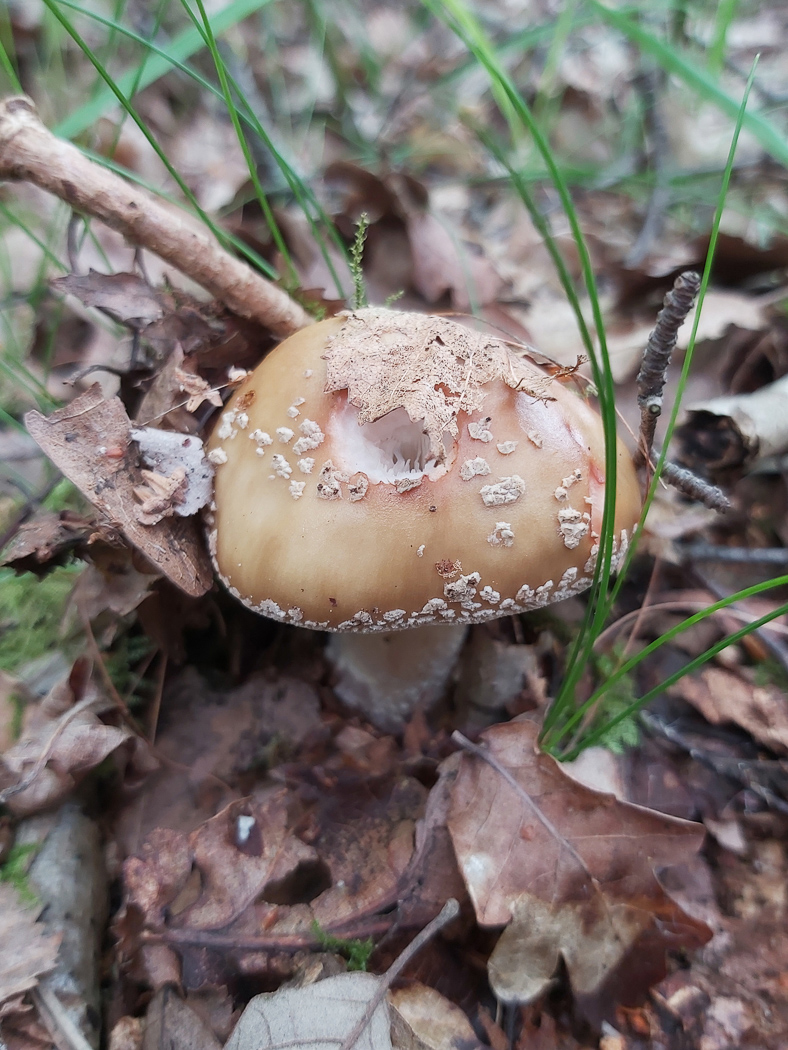 |
June 22nd Amanita rubescens (Blusher)
In Stoke Common Jesper Launder came across this early fruiting Amanita species - often one of the first of this genus to make an appearance as we approach the autumn season. Our decidedly damp June has certainly triggered some response from such species so anything might turn up: Amanita, Boletoid species and Russula are all genera to keep an eye out for at this time if conditions are favourable. To recognise the Blusher note the tell tale pink staining around the damaged part of the cap in the photo, also the loose flecks of whitish veil which often get washed off by rain. Then underneath (not visible here) the white gills and large ring on the stem which often stains pink also.
|
June 21st 2021
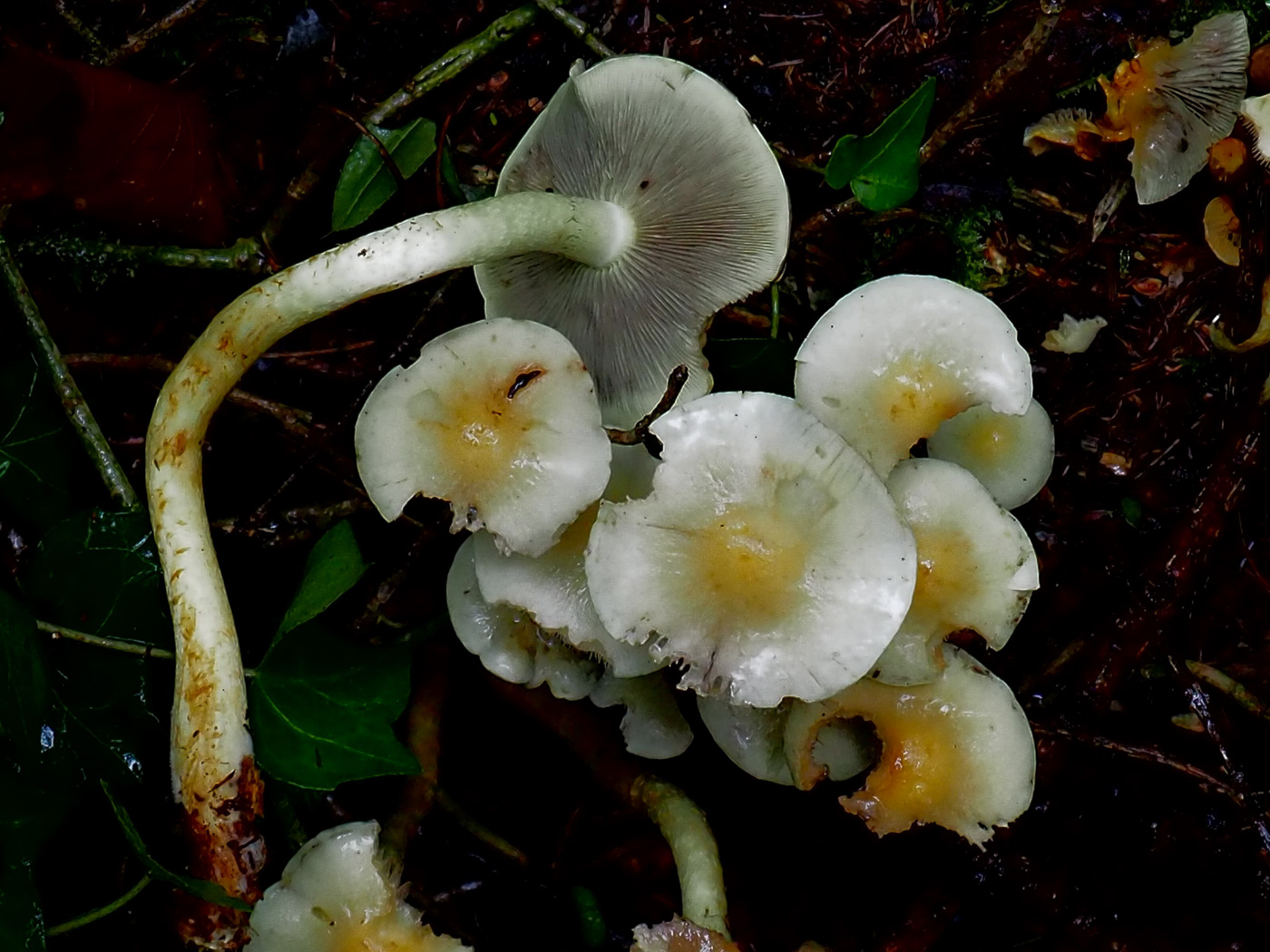 |
June 21st Hypholoma fasciculare (Sulphur Tuft)
In Tinkers Wood, Downley John and Leslie Catterson noticed this early fruiting clump of a very common summer to autumn woodland species. It is always associated with wood of one kind or another and here was on a fallen Larch log. Often much more obviously yellow than shown here, the caps have clearly been rather washed out by the recent rain. Note also how the gills (which start pale yellowish) are just beginning to darken as the purple-brown spores mature, also leaving a faint dark ring zone on the stem where some of them get trapped and here just visible on the upturned specimen. This species is dangerously toxic.
|
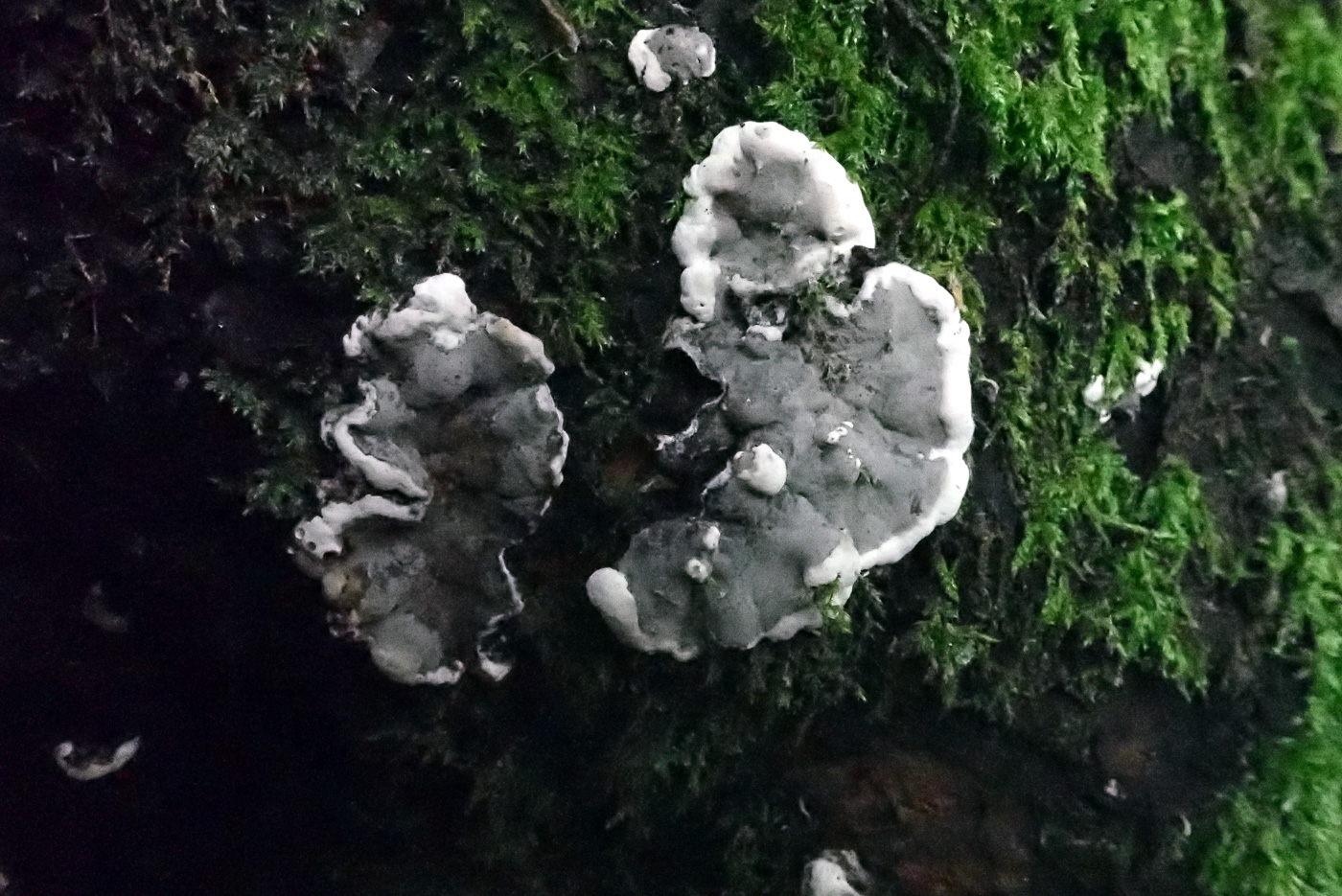
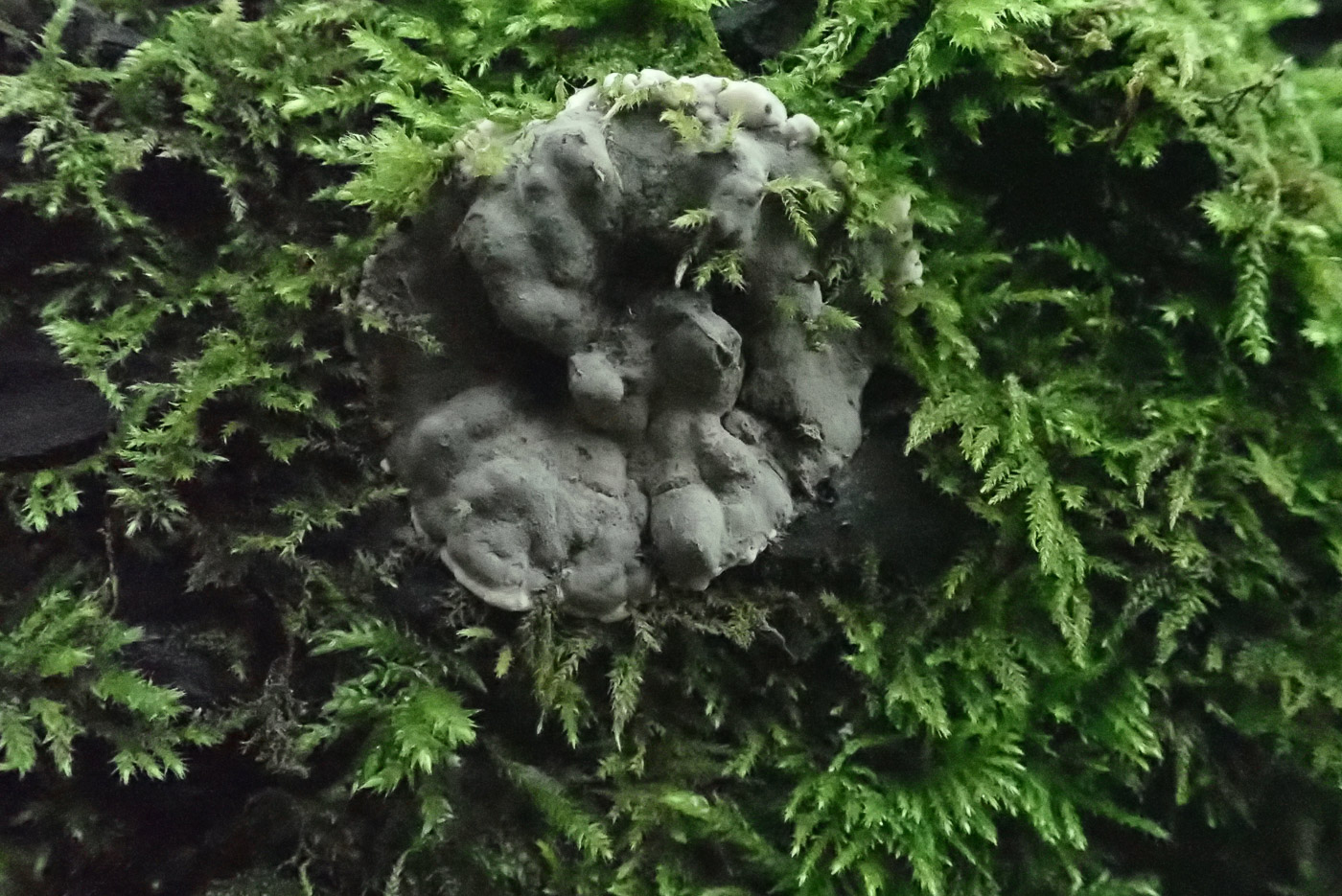 |
June 21st Kretschmaria deusta (Brittle Cinder)
At Turville Heath Penny found several trunks with good examples of this quite common Ascomycete just developing - photo 1 is on Small-leaved Lime, photo 2 is on Oak. At this early conidial stage it typically forms these rather uneven bumpy grey patches with a white rim and later becomes crusty and entirely black, like several other Pyrenomycete species. It is possibly better known by its earlier genus name Ustulina.
|
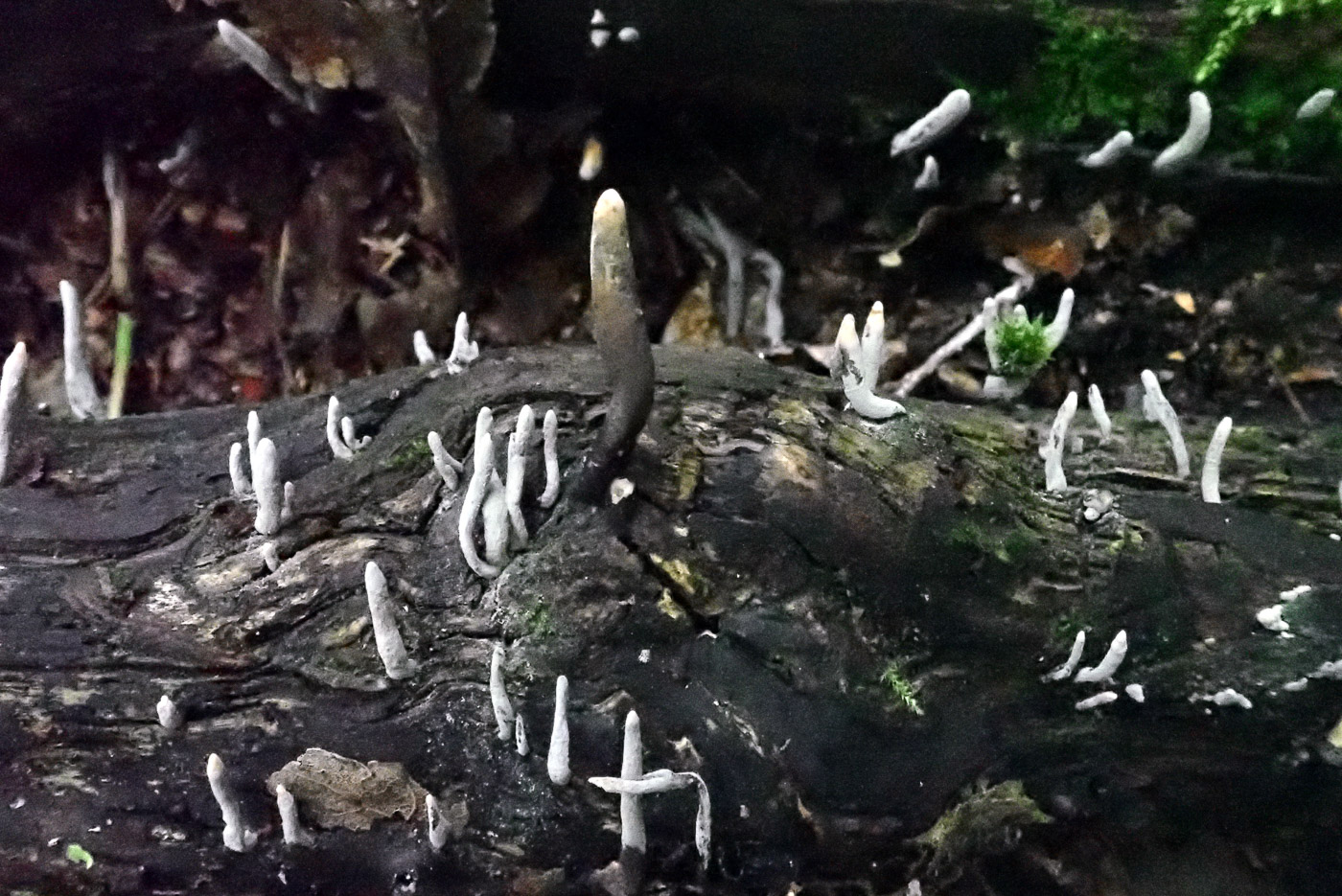
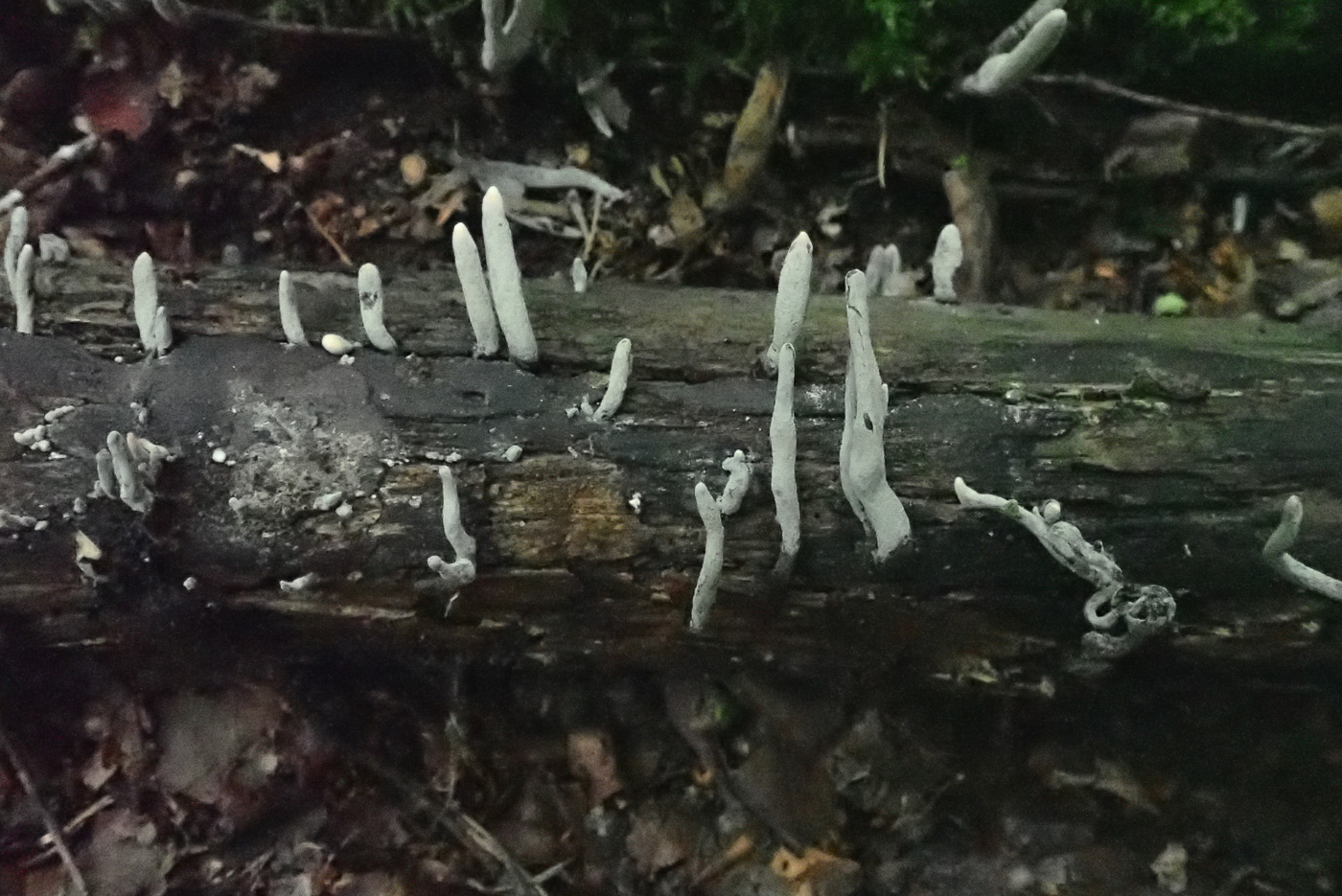
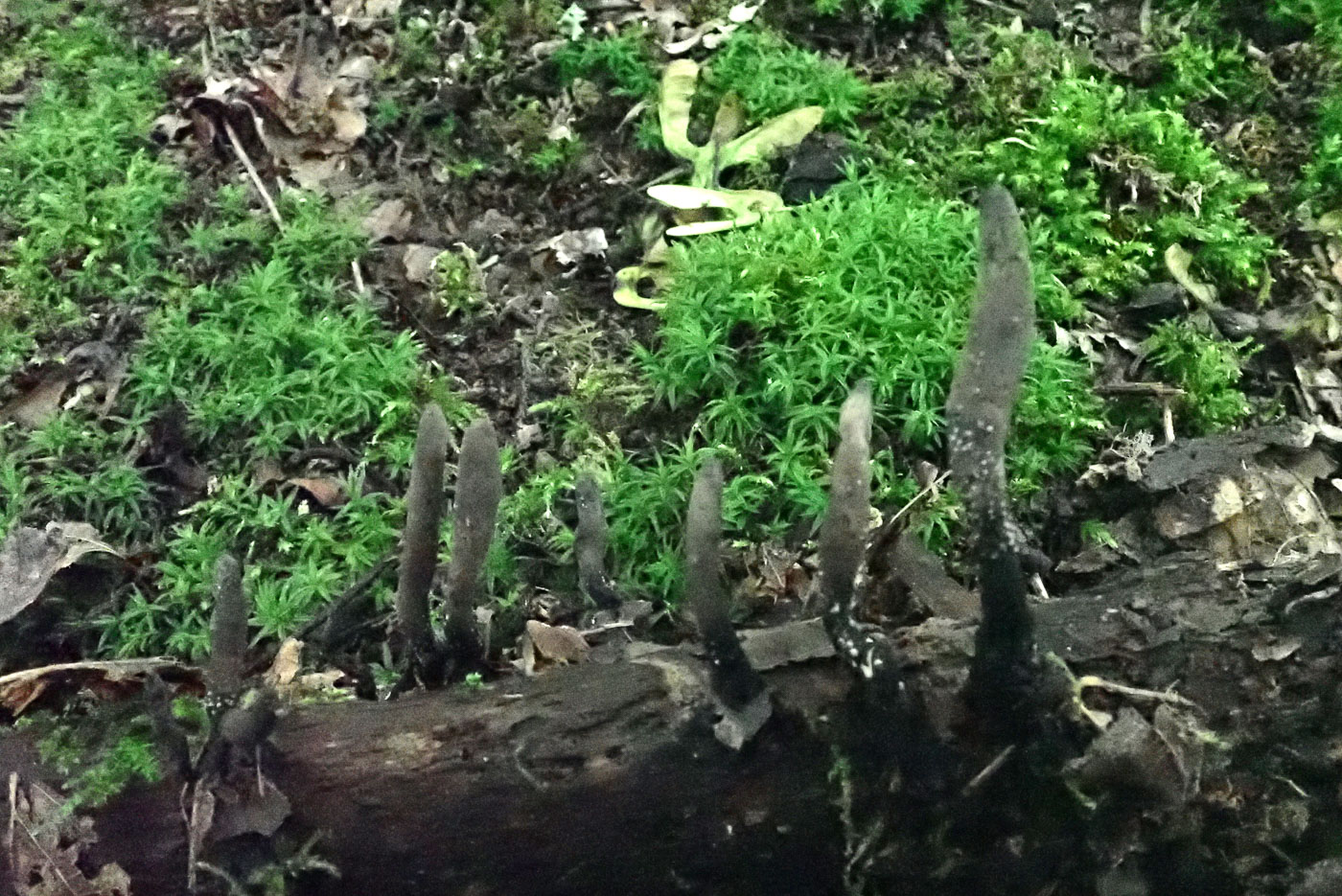
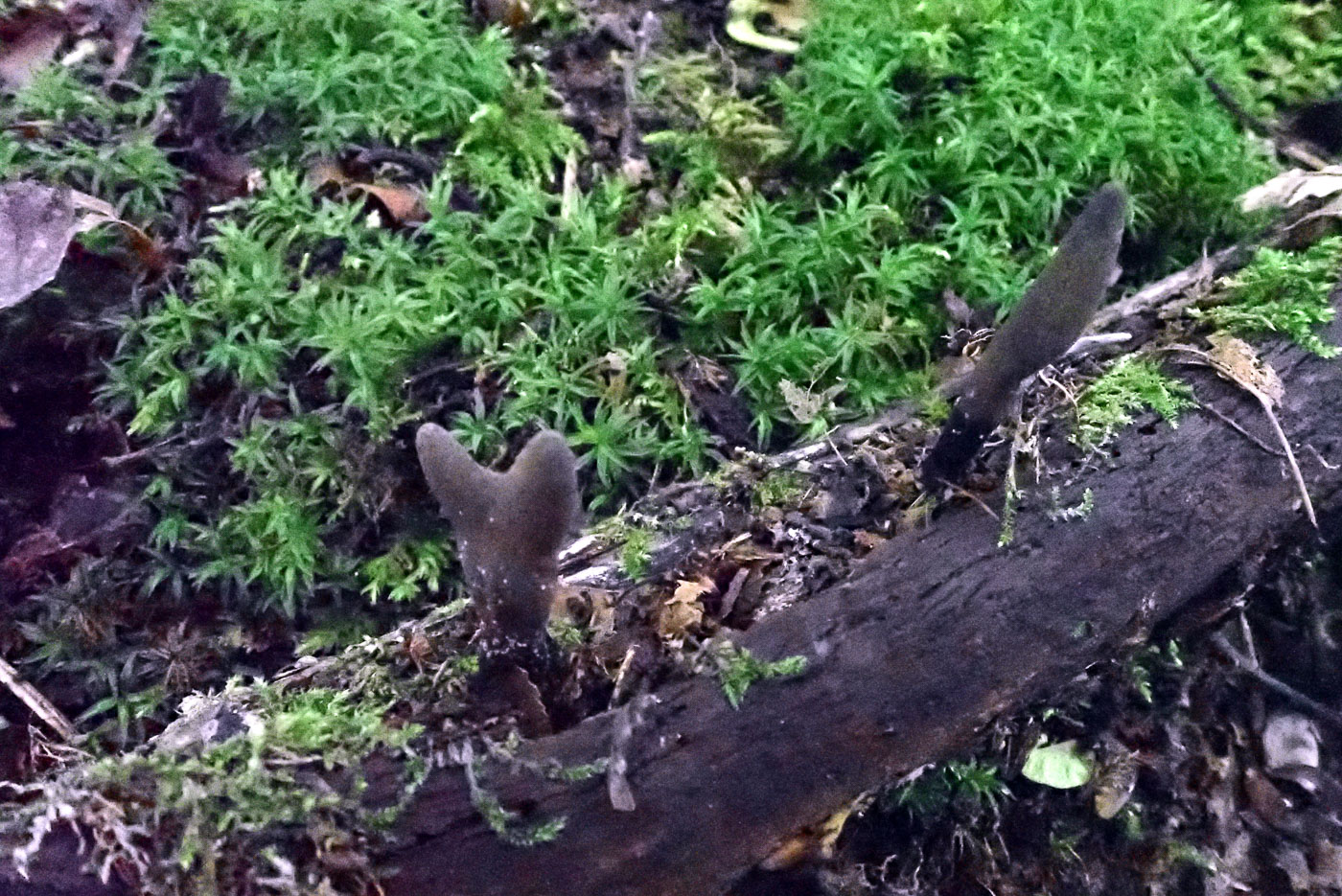 |
June 21st Xylaria polymorpha (Dead Man's Fingers)
At Turville Heath Penny found many fallen deciduous sticks, mainly Oak and Ash, with the early stages of this familiar Ascomycete though looking somewhat unfamiliar at this stage of development (photos 1 and 2). In fact she at first named it incorrectly as immature X. hypoxylon (Candle Snuff) and it was not until returning to the same site nine days later (photos 3 and 4) when some of the specimens had further developed that she realised her error! In the later photos one can see the typical blunt heads of Dead Man's Fingers - developing very differently from Candle Snuff - though they were still not mature enough to contain spores which would give definitive confirmation of the species.
|
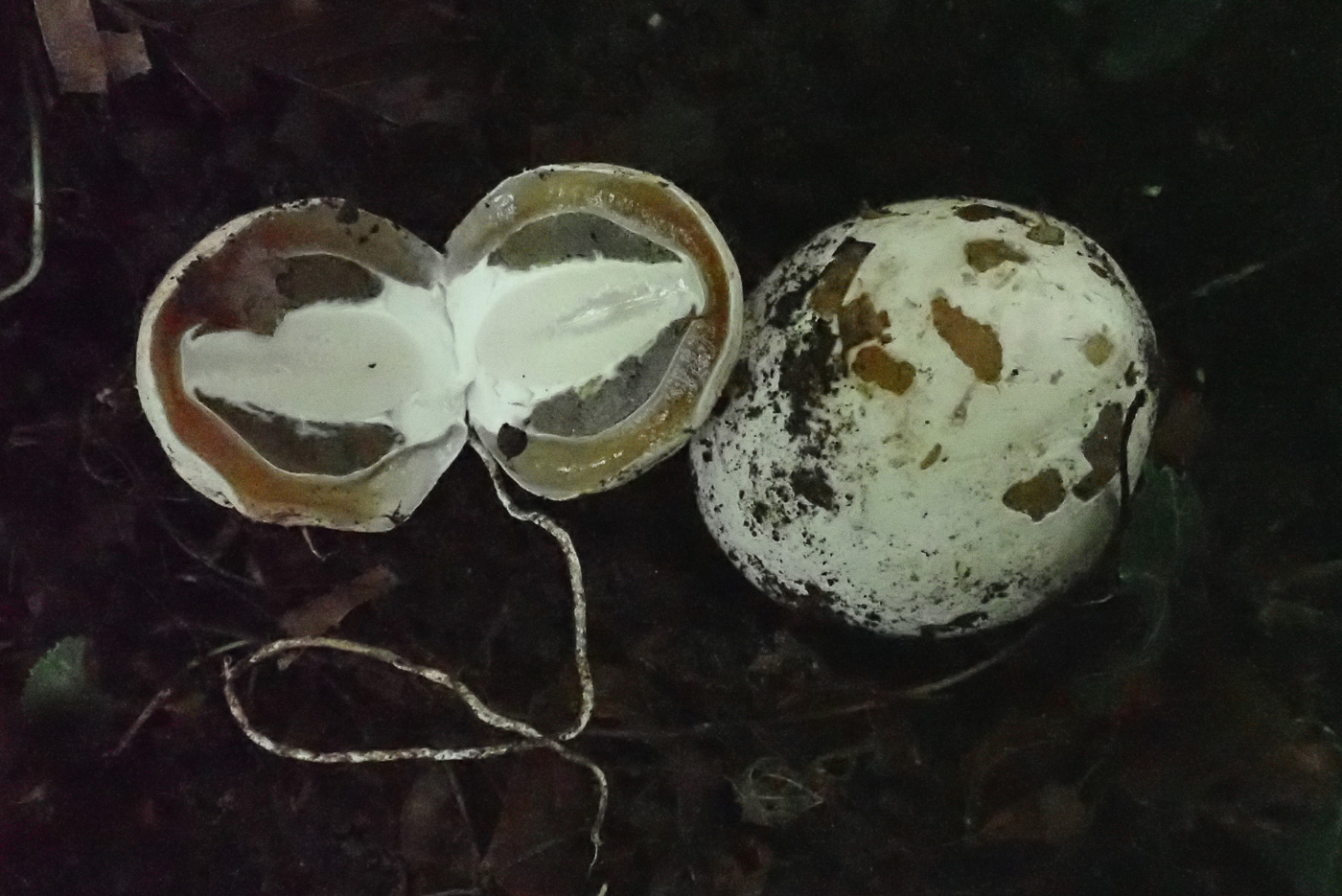 |
June 21st Phallus impudicus (Stinkhorn)
At Turville Heath in litter under Small-leaved Lime Penny found two Stinkhorns at the 'egg' stage. Splitting one in half revealed the undeveloped head of this familiar species with its dark olive green coating visible even at this stage, all surrounded by a thick gelatinous covering. Note also the long thin white mycelial strand which attaches it to the substrate. These eggs would take just a day or so to fully develop into the the familiar stinking fungus we know and love(!), the smell of which attracts many species of insect which oblige by devouring the coating thus dispersing its spores.
|
June 19th 2021
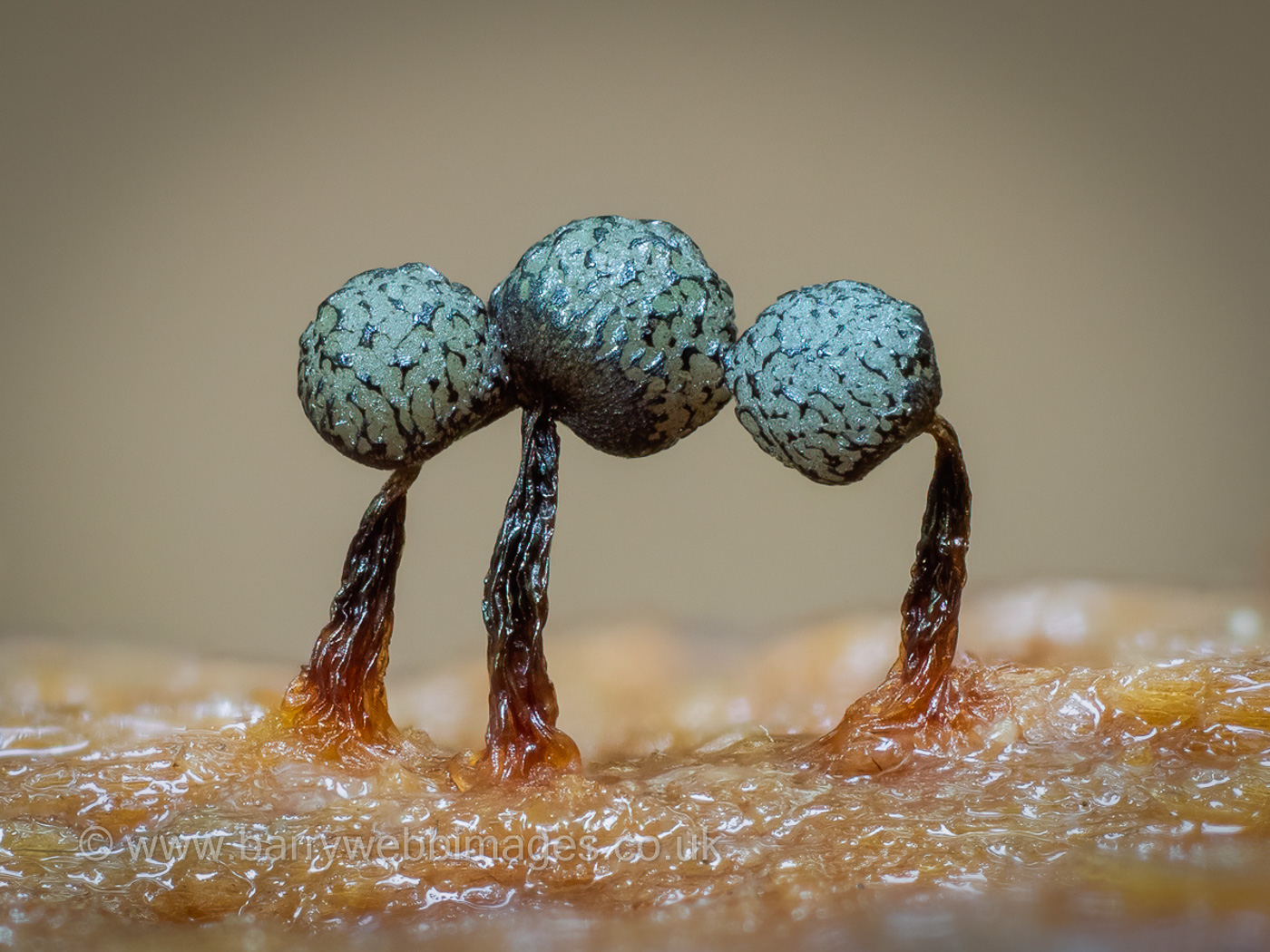 |
June 19th Cribraria aurantiaca (a Slime Mould with no common name)
On fallen rotting Birch in Burnham Beeches Barry Webb found this tiny but beautiful species which (surprisingly) has bright green plasmodium and as it develops to form fruiting bodies the colour of the heads changes thru green to blue (as here) and eventually to yellow ochre retaining this amazing mesh / network which characterises the genus (like a crib?). Why the species name? The stalk is a bright orange to reddish brown, it also tapers upwards notably. This is new not only to the site but to the county (though described as very common!) See also some green developing fruitbodies in Finds July-Dec dated July 5th - an equally stunning photo of Barry’s.
|
June 15th 2021
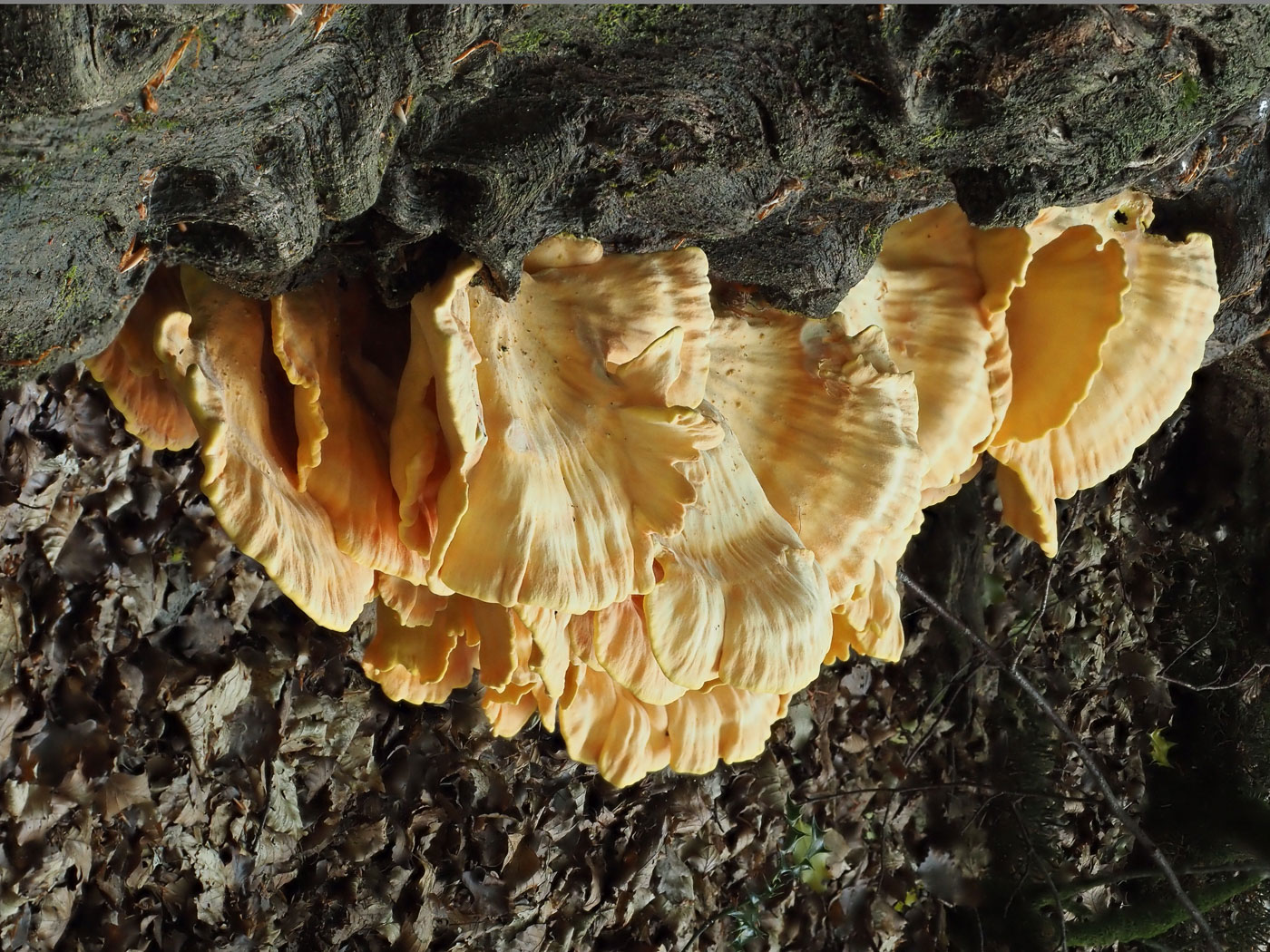
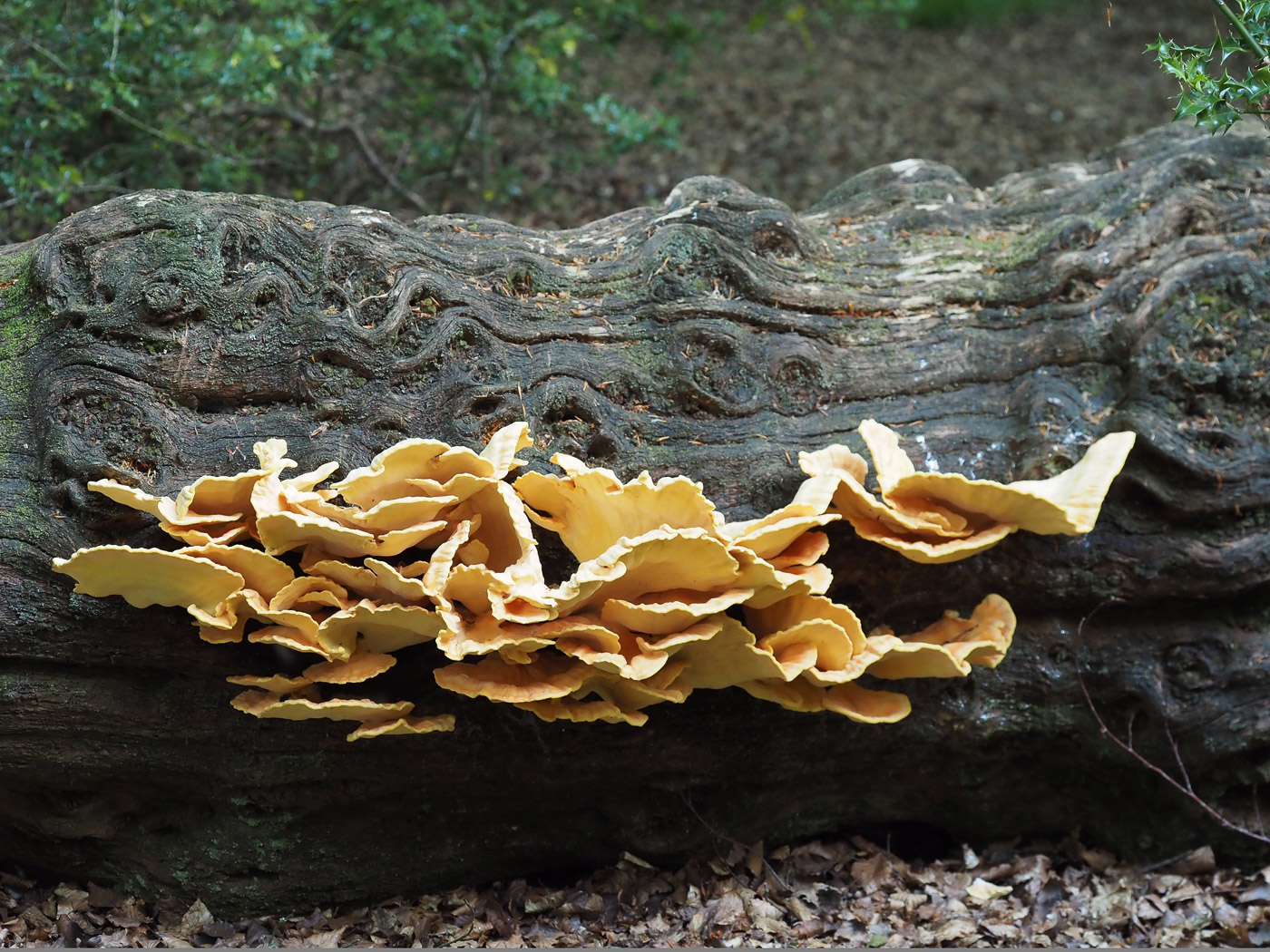 |
June 15th Laetiporus sulphureus (Chicken of the Woods)
Nine days ago (see photo from June 6th) Claire Williams found this quite common bracket just emerging on a log in Naphill Common. Today's photos are of the same specimen now measuring a meter across! She noted the typical tiers now seem quite thin and wondered if this was caused by the dry warm conditions. I suspect, however, it could be more to do with the fact that the tissue is thinning out as a result of it expanding to such a size. What a magnificent sight!
|
June 10th 2021
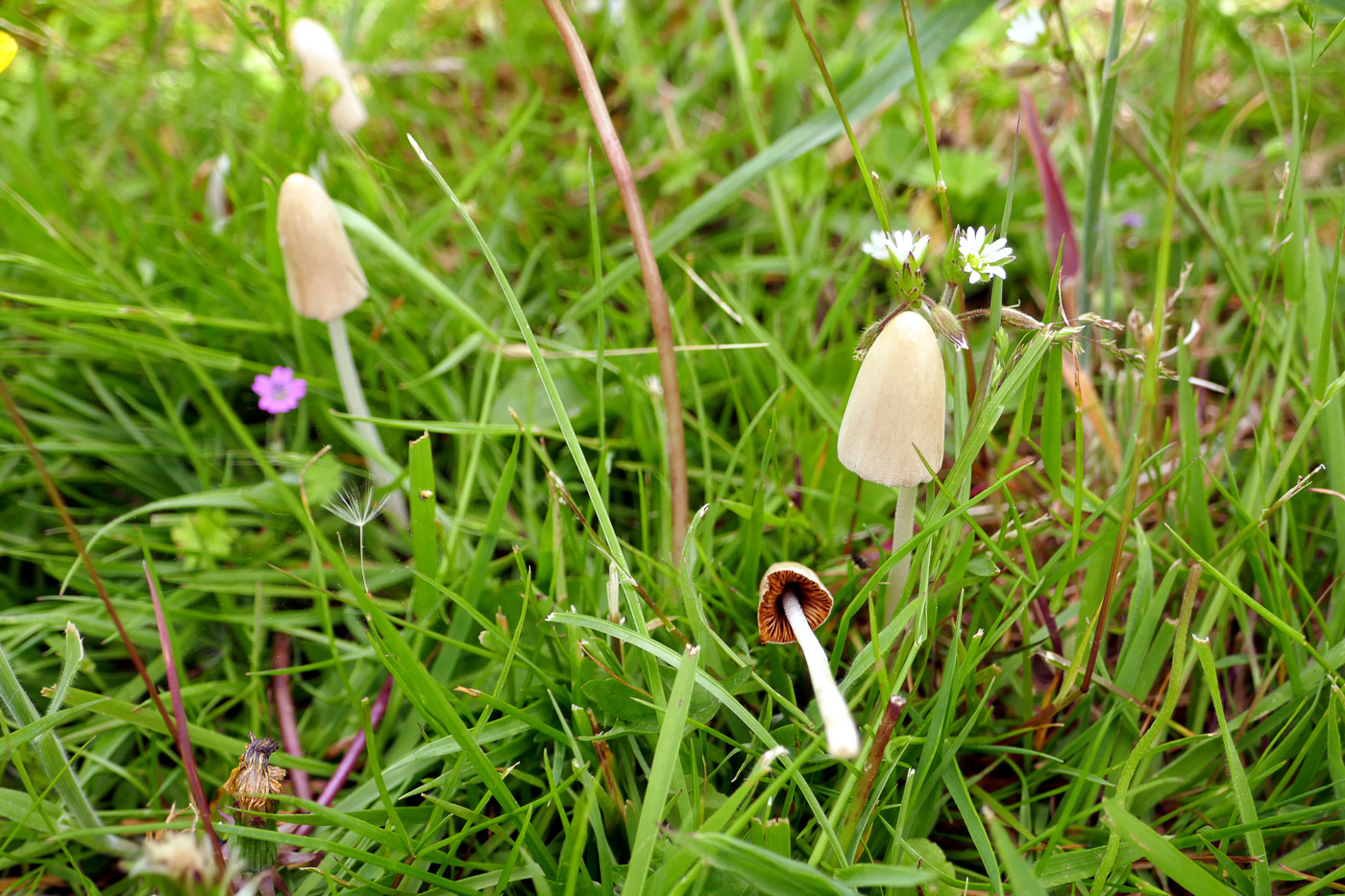 |
June 10th Conocybe apala (Milky Conecap) 
In a grassy path at Stampwell Farm Jackie Ewan found this quite distinctive Conocybe - usually a contradiction in terms as many species in this genus look extremely similar and are well nigh impossible to separate from one another in the field. Today's species is recognisable not only by its rather acutely conical milky ivory cap - the palest in the genus, but in having an equally pale somewhat flimsy stem with a small bulb at its base. Not a rare species, it occurs in lawns as well as in (manured) meadows from late spring through to autumn. (Some books will be using its older and probably better known name of C. lactea (which of course describes it perfectly).
|
June 9th 2021
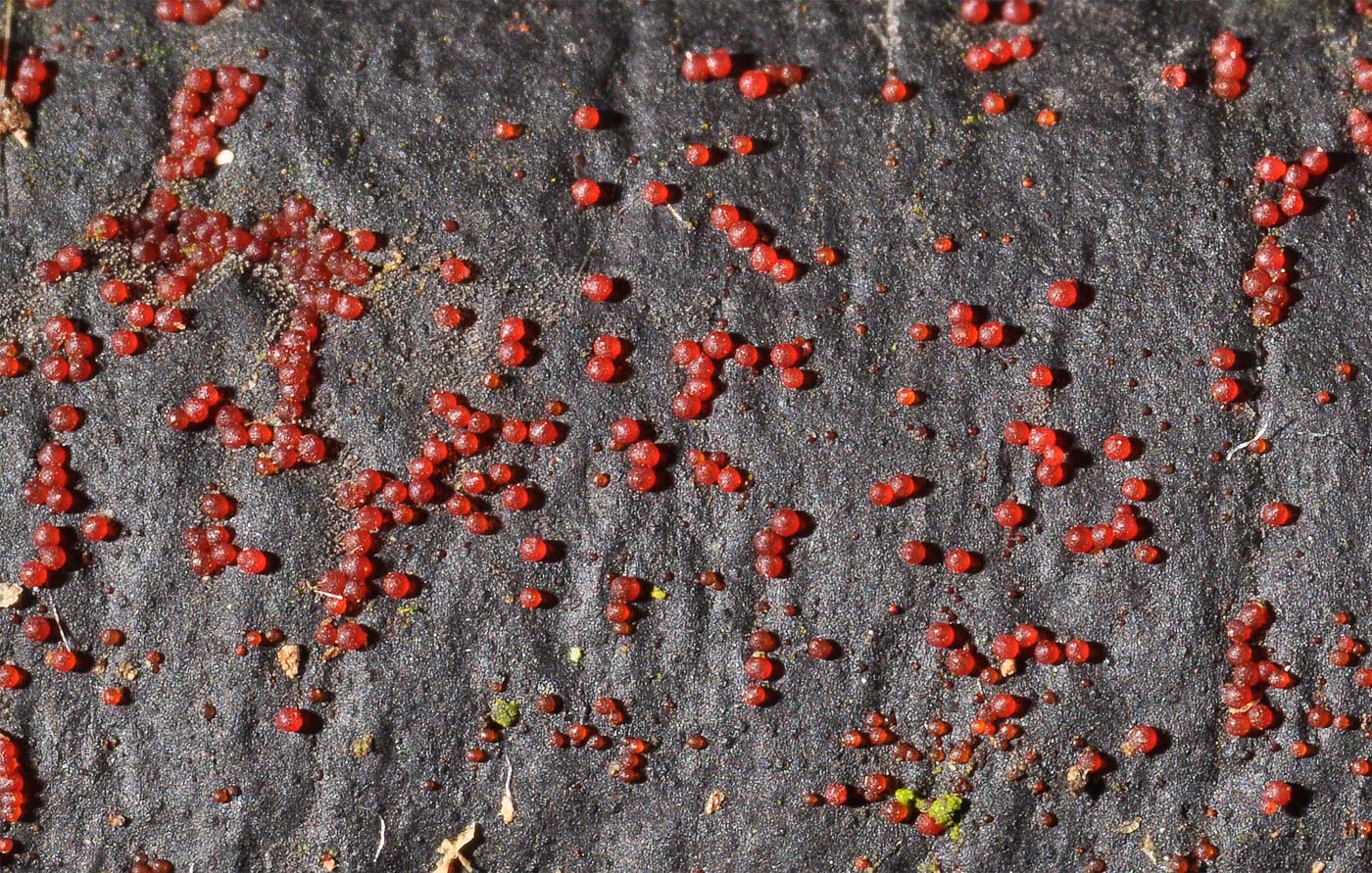 |
June 9th Nectria episphaeria (a species of Coral Spot with no common name)
In the Mire at Burnham Beeches Kerry Robinson noticed these tiny red specks on the common black Pyrenomycete Diatrype stigma. An example of a fungus growing on a fungus, this is a species often missed unless one knows to search for it on the host fungus - which can be one of several different crusty black Pyrenomycetes - because it is hard to see even with a handlens, being under 1 mm at most! The photo here is a library photo of Kerry's as this is a tricky species to get a decent image of in the field for obvious reasons.
|
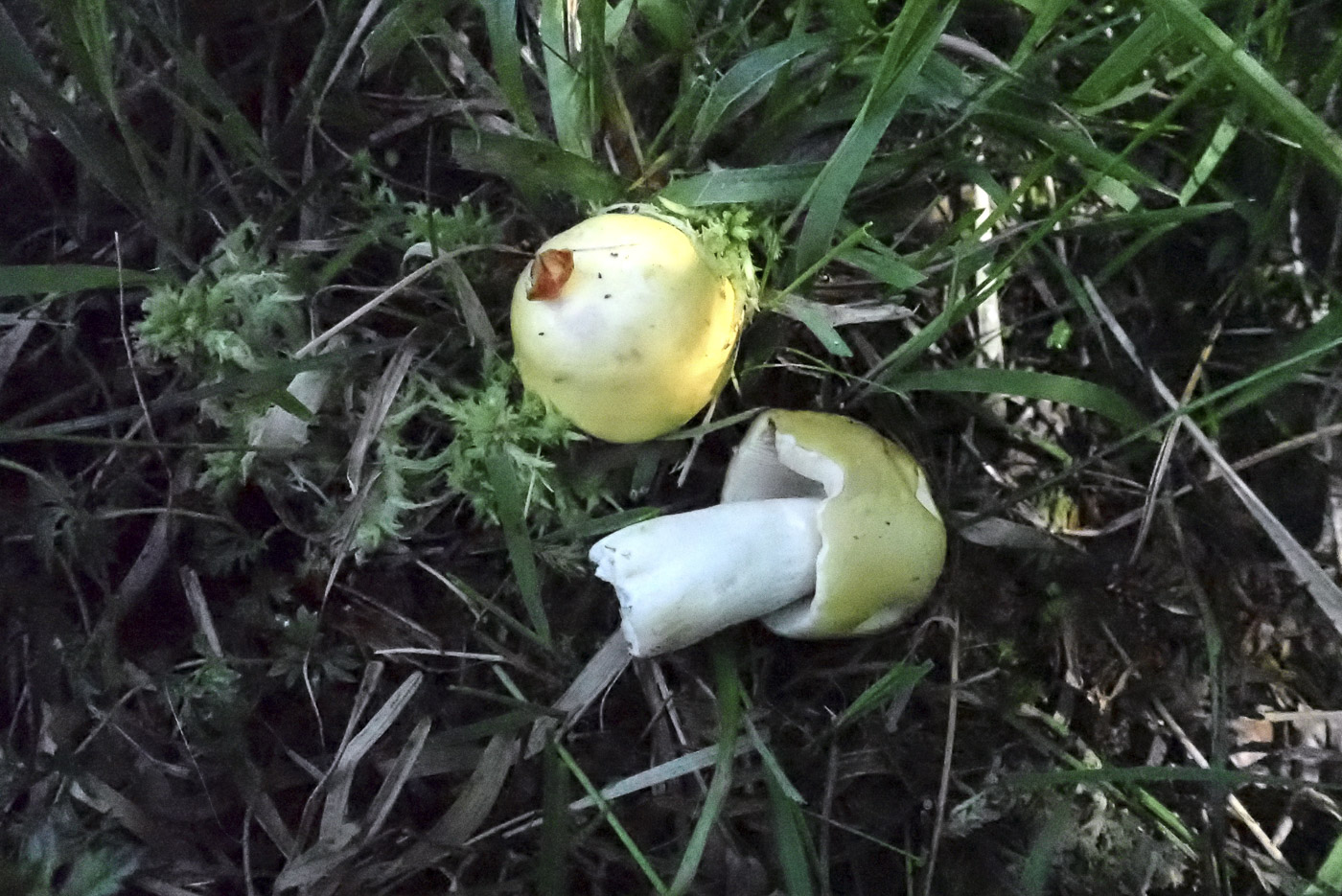 |
June 9th Russula claroflava (Yellow Swamp Brittlegill)
In the Mire at Burnham Beeches Penny was somewhat surprised to find this autumn species just emerging in Sphagnum under Birch this early in the year. It can be distinguished from the several other Brittlegills which have bright yellow caps by its cream coloured gills when mature (not white nor orange), its occurrence only under Birch usually (but not exclusively) in damp areas and having a stem which blackens where damaged though this takes an hour or so to develop after handling / scratching. See Finds 2020 dated Sept 15th for photos (also from this site) of a mature collection and of the blackening stem.
|
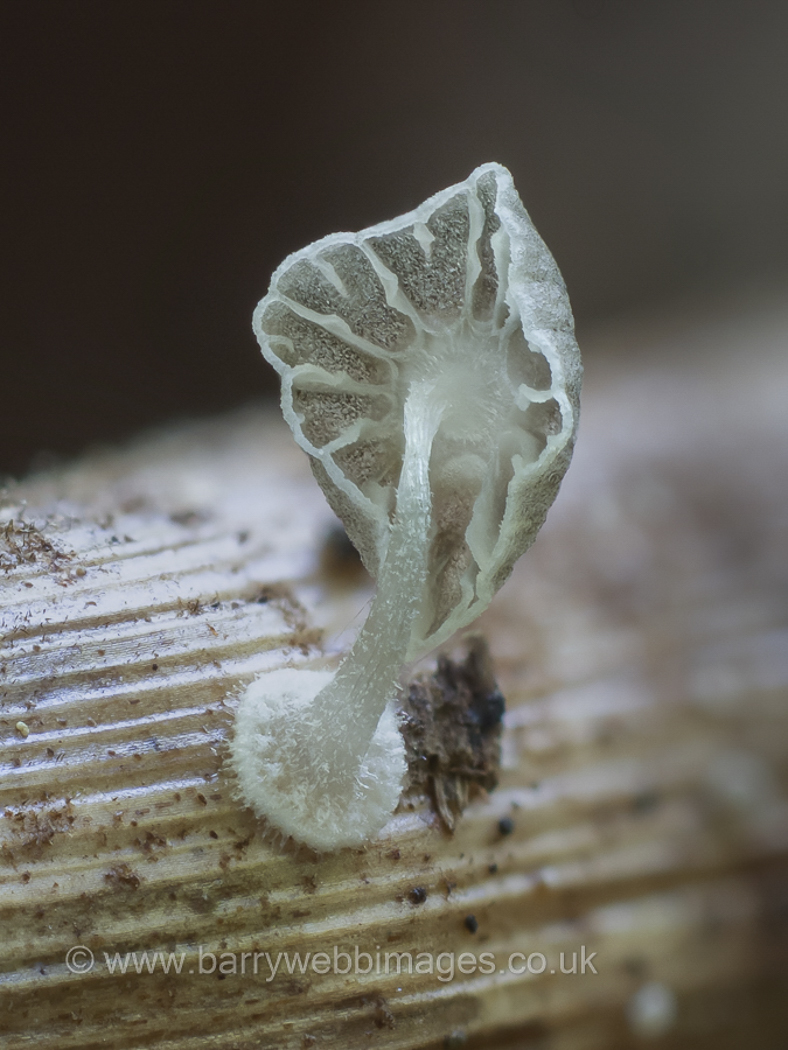 |
June 9th Mycena bulbosa (Rush Bonnet)
In the Mire at Burnham Beeches Derek searched amongst the dead Juncus stems and was rewarded with four beautiful specimens of this one of the tiniest species of Bonnet. The base of Juncus stems is a good substrate on which to find a range of tiny fungi, but this particular species is easy to distinguish despite its diminutive size (here no more than 5mm tall) because of its platform-like stem base. It is the only Bonnet found on Juncus with which it is host specific.
|
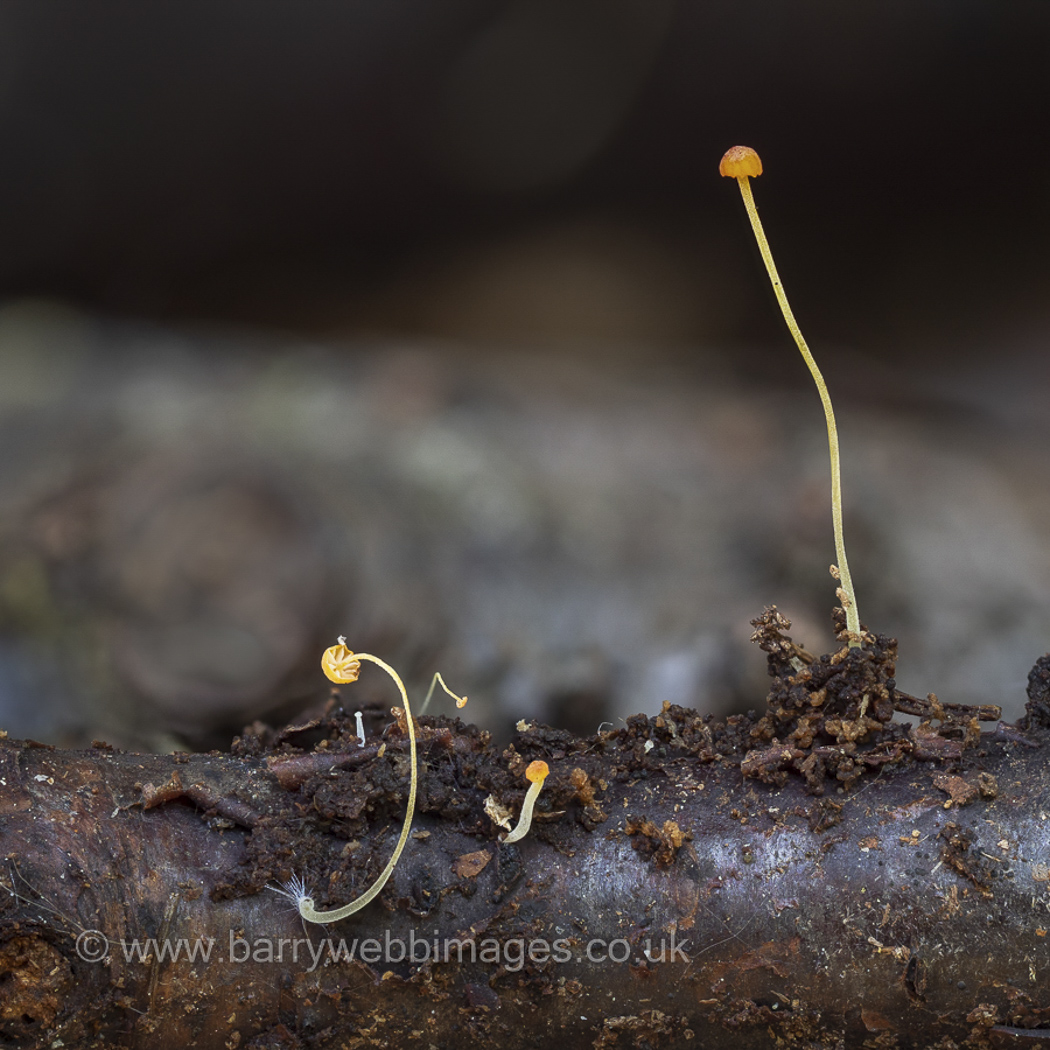 |
June 9th Mycena acicula (Orange Bonnet)
On the edge of the Mire at Burnham Beeches Barry Webb was searching for tiny fungi amongst woody litter and noticed a tiny speck of orange. Further investigation revealed a piece of stick with this cluster of miniscule fruit bodies just emerging. Even when this size (the largest cap can't have been more than 2mm across at most!) the distinctive combination of orange cap and bright yellow stem make this delightful species unmistakeable.
|
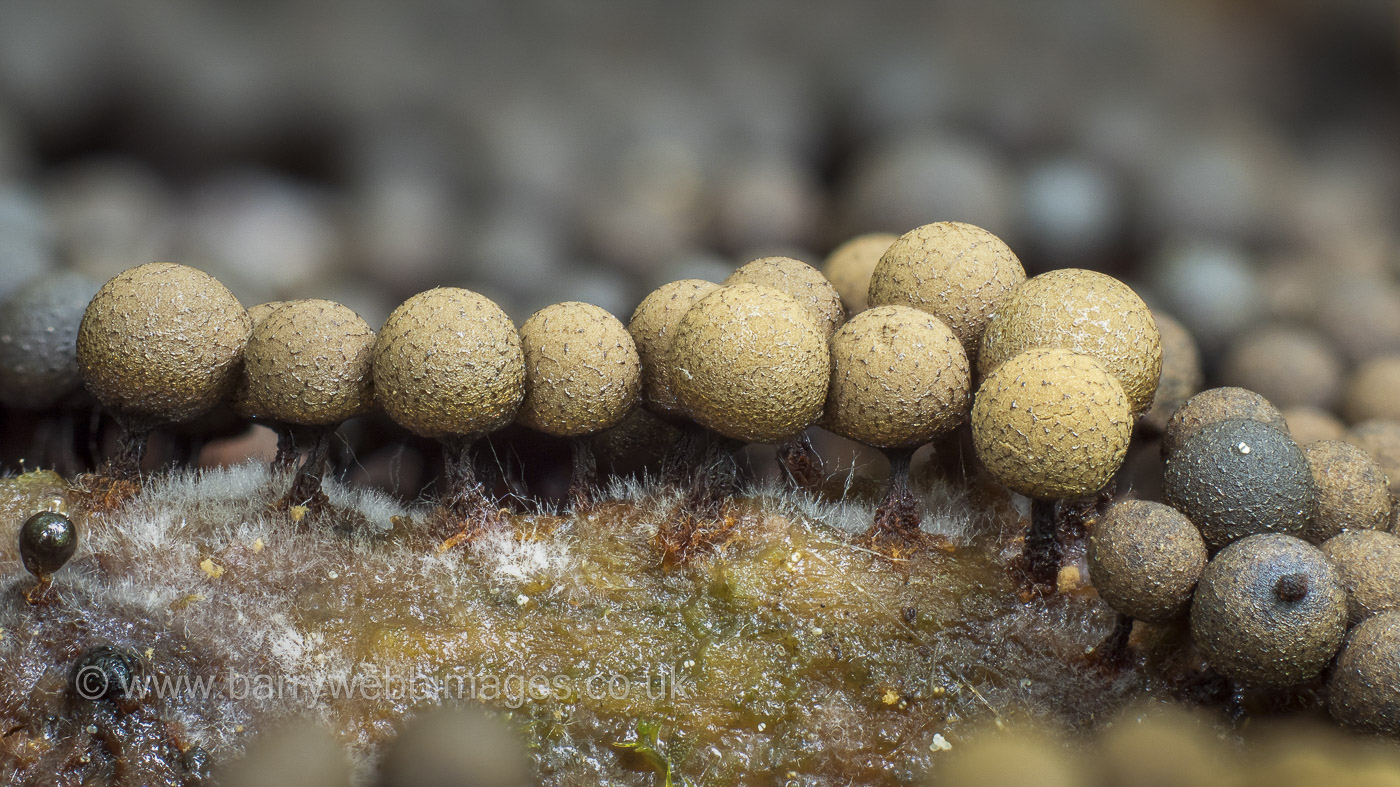 |
June 9th Cribraria argillacea (a Slime Mould with no common name)
On a visit to Burnham Beeches a few days previously Barry Webb had noticed a rotting fallen birch trunk with a large colony of this tiny species so took our small group to see it today where it was maturing nicely but with the netlike mesh typical of the genus still visible. Typical of this particular species is the very short stalk and pale clay-coloured 'sporangia' (heads). See an example of the species at an earlier stage of development in Barry's Slime Mould photos in Members Finds where the sporangia is typically gun metal blue and still shiny.
|
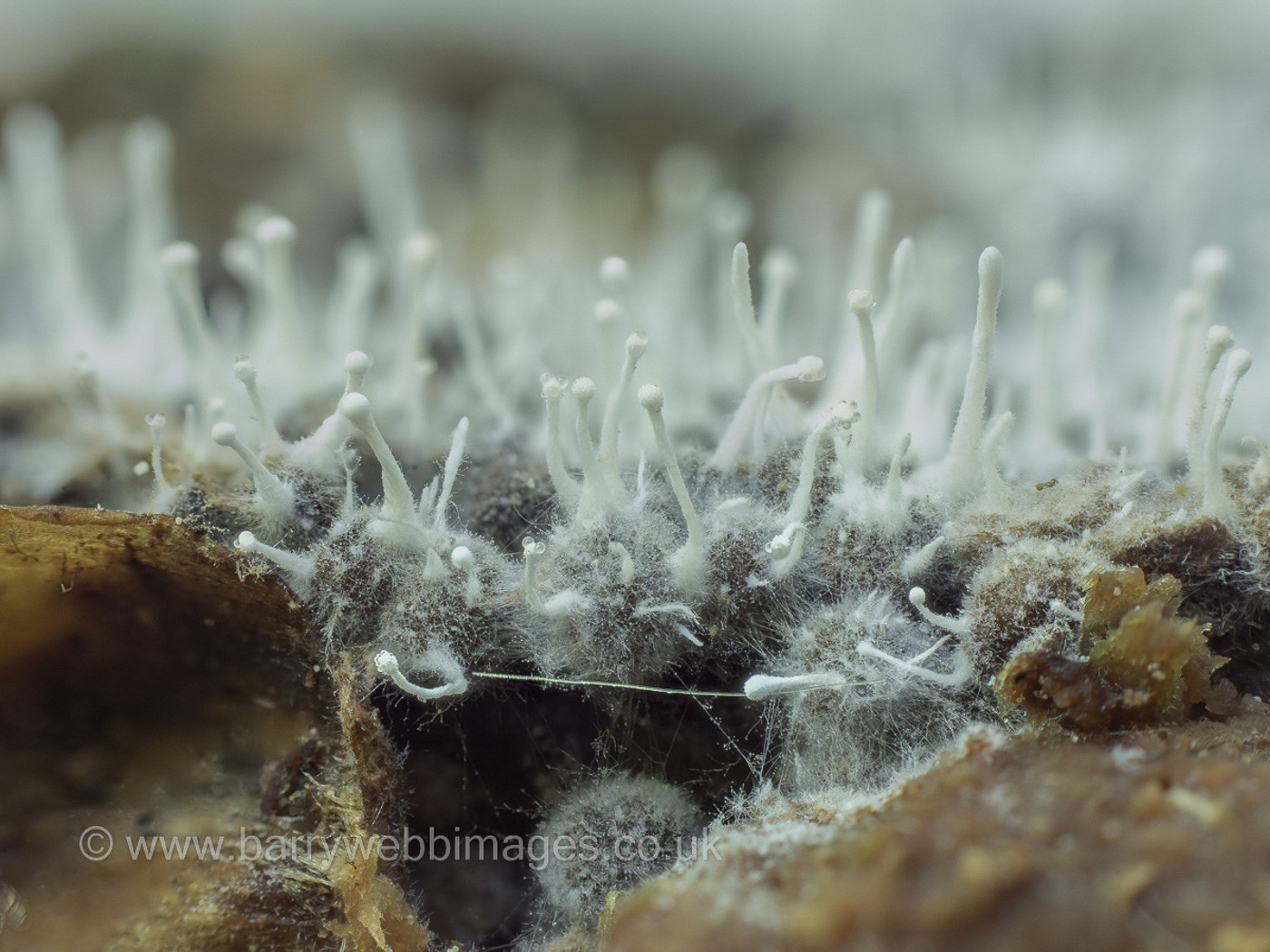 |
June 9th Stilbella byssiseda (a species of Hyphomycete with no common name) 
This rare species was noticed liberally smothering a colony of the slime mould Cribraria argillacea which a group of us saw at Burnham Beeches. With a hint to its possible identity from expert Kerry Robinson, Penny was able to name it at home later. It is described as occurring solely on two species of slime mould, one of these being C. argillacea, and is new to the county. (Photo Barry Webb)
|
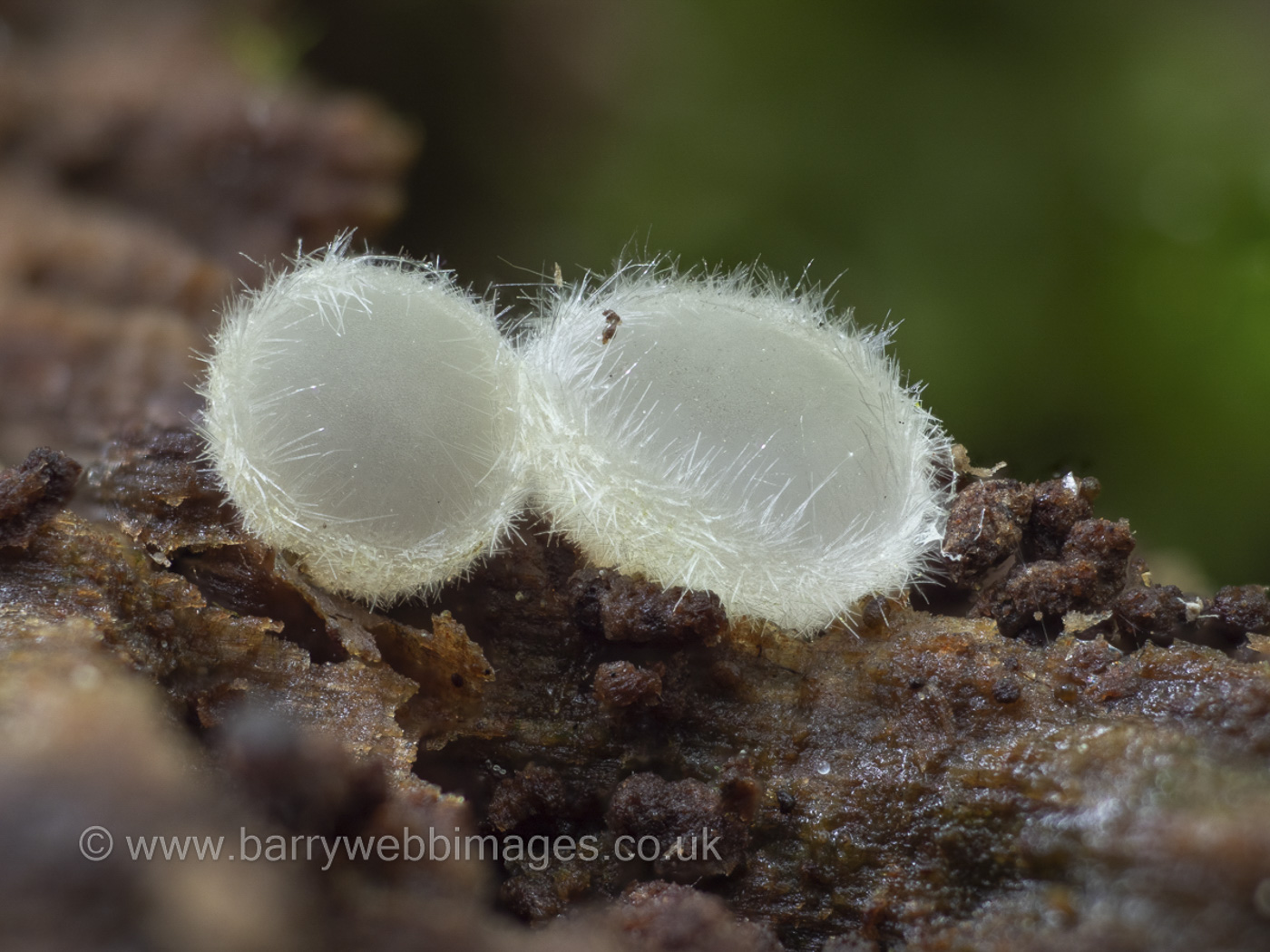
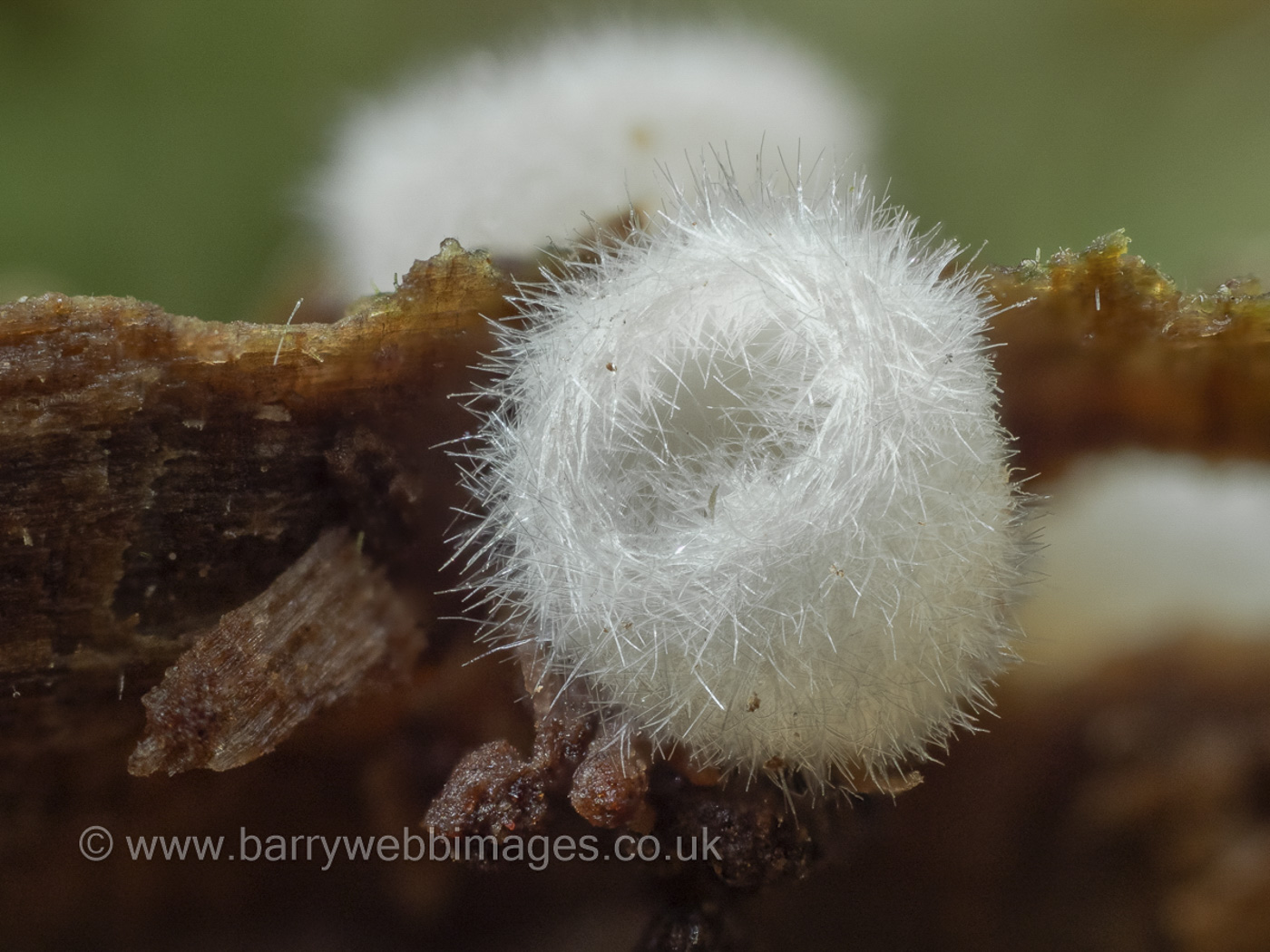
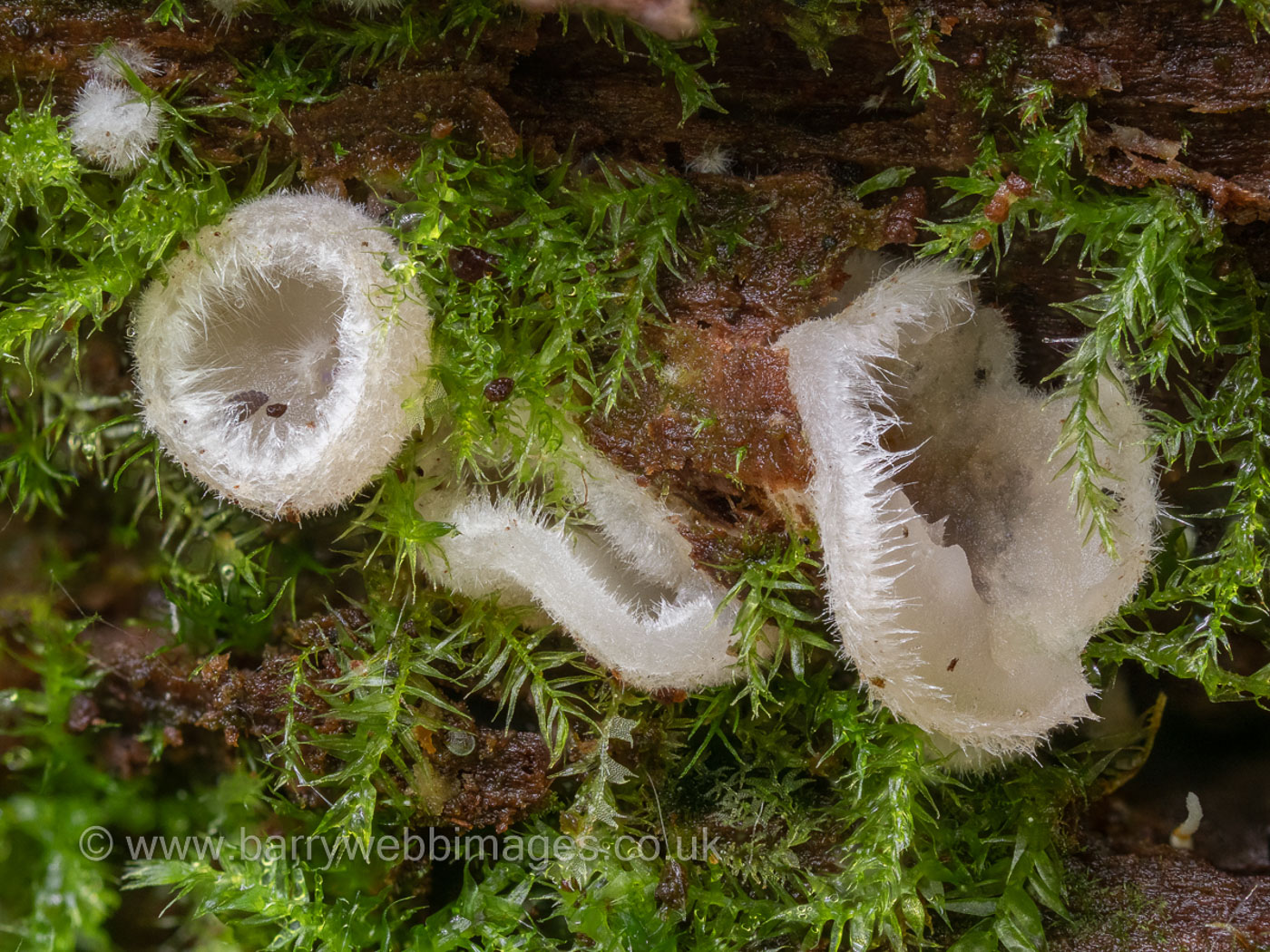 |
June 9th Leucoscypha leucotricha (an Ascomycete cup fungus with no common name) 
On a very rotten fallen Birch trunk at Burnham Beeches Barry Webb noticed these tiny little beauties which Asco expert Kerry Robinson was able to identify later at home. The cups were less than 5 mm across and typical of the species is its mass of delicate white 'hairs' perhaps suggesting some of the commoner white species of the genus Lachnum. However, the lack of stem is diagnostic as also are its microscopic features. This is a rare species with only around 50 national records and is yet another first for Bucks. Photo 3 is of a further collection found nearby by Barry 10 days later.
|
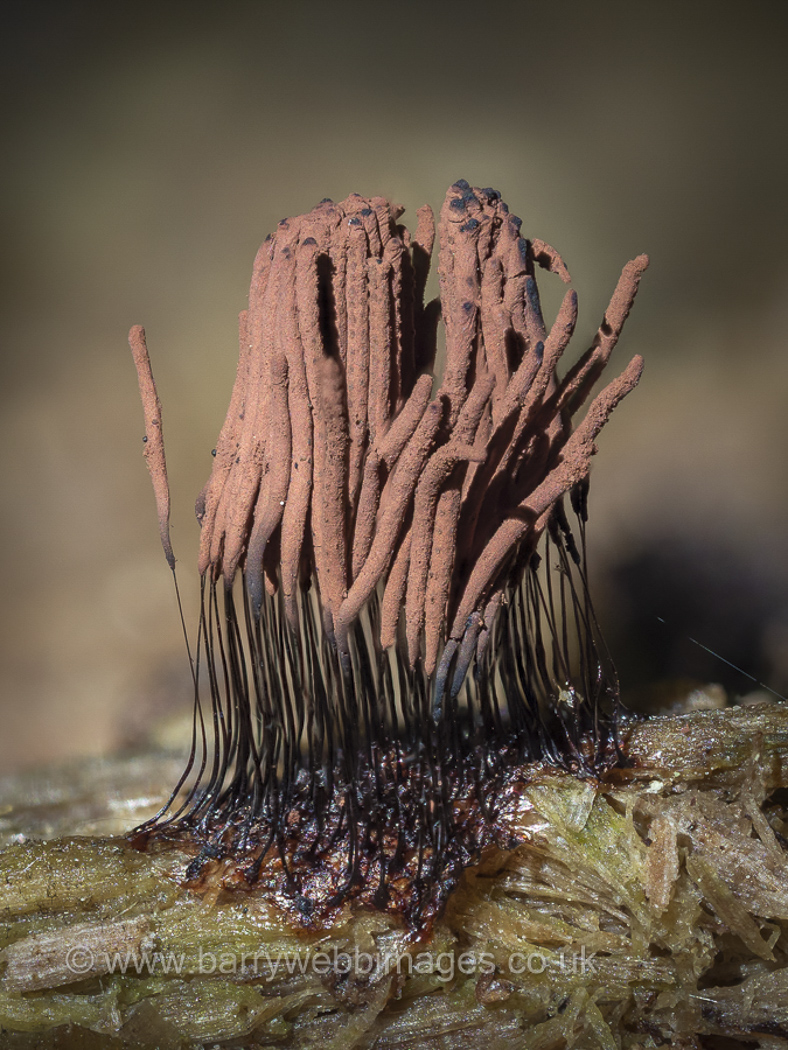 |
June 9th Stemonitis fusca (a species of 'Pipe-cleaner' Slime Mould with no common name) 
On a rotting bare Birch trunk in Burnham Beeches Gill Ferguson found these little clusters of chocolate pipe-cleaners. Although nearby was a trunk with Stemonitis flavogenita, it could not be assumed that this collection was the same species, so Penny collected samples of both to examine at home. This second collection turned out to be the commonest species within the genus, characterised not just by microscopic differences but also by having a notably shiny black stalk forming up to half the total height (in S. flavogenita the stalk is only up to one third). (Photo Barry Webb)
|
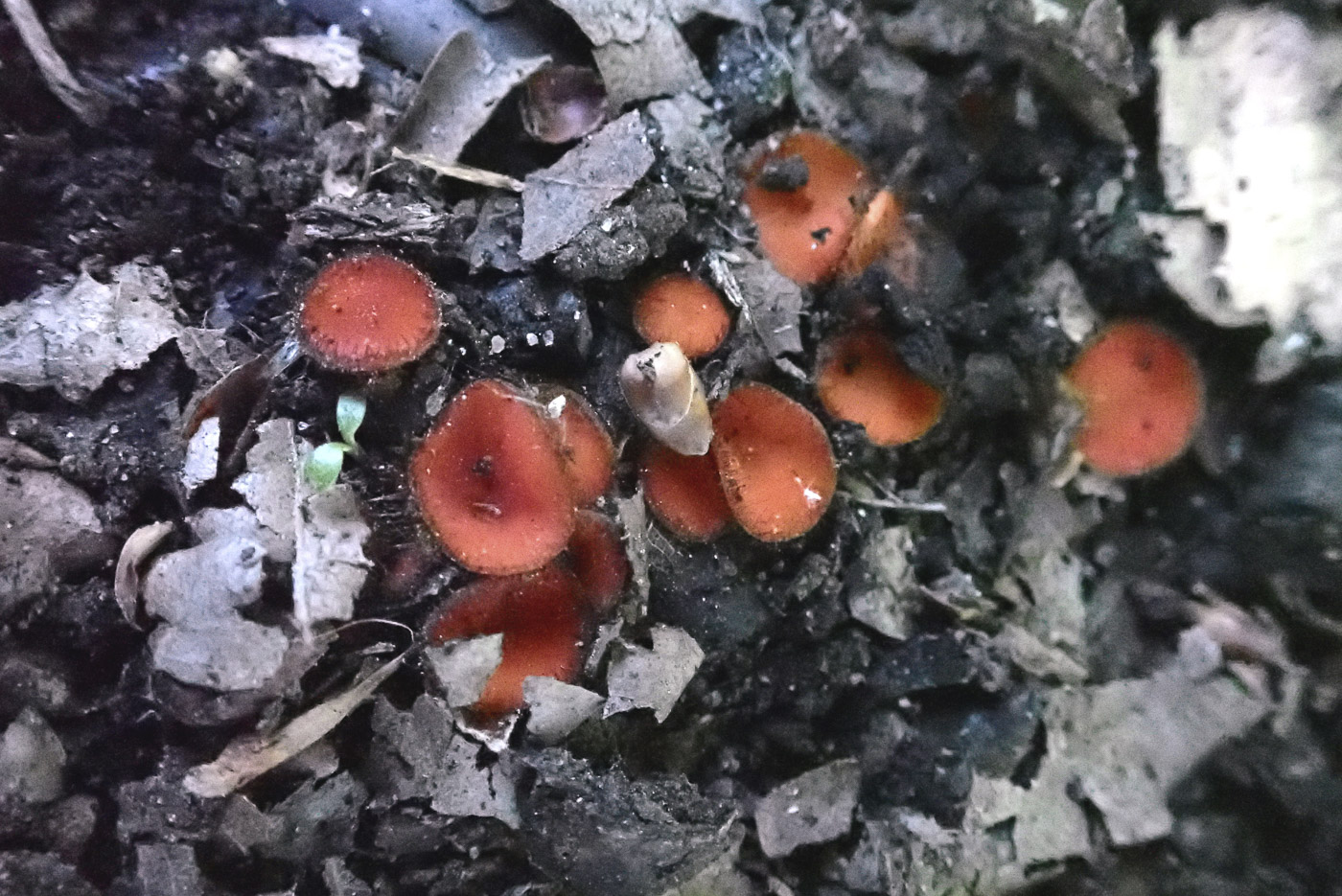
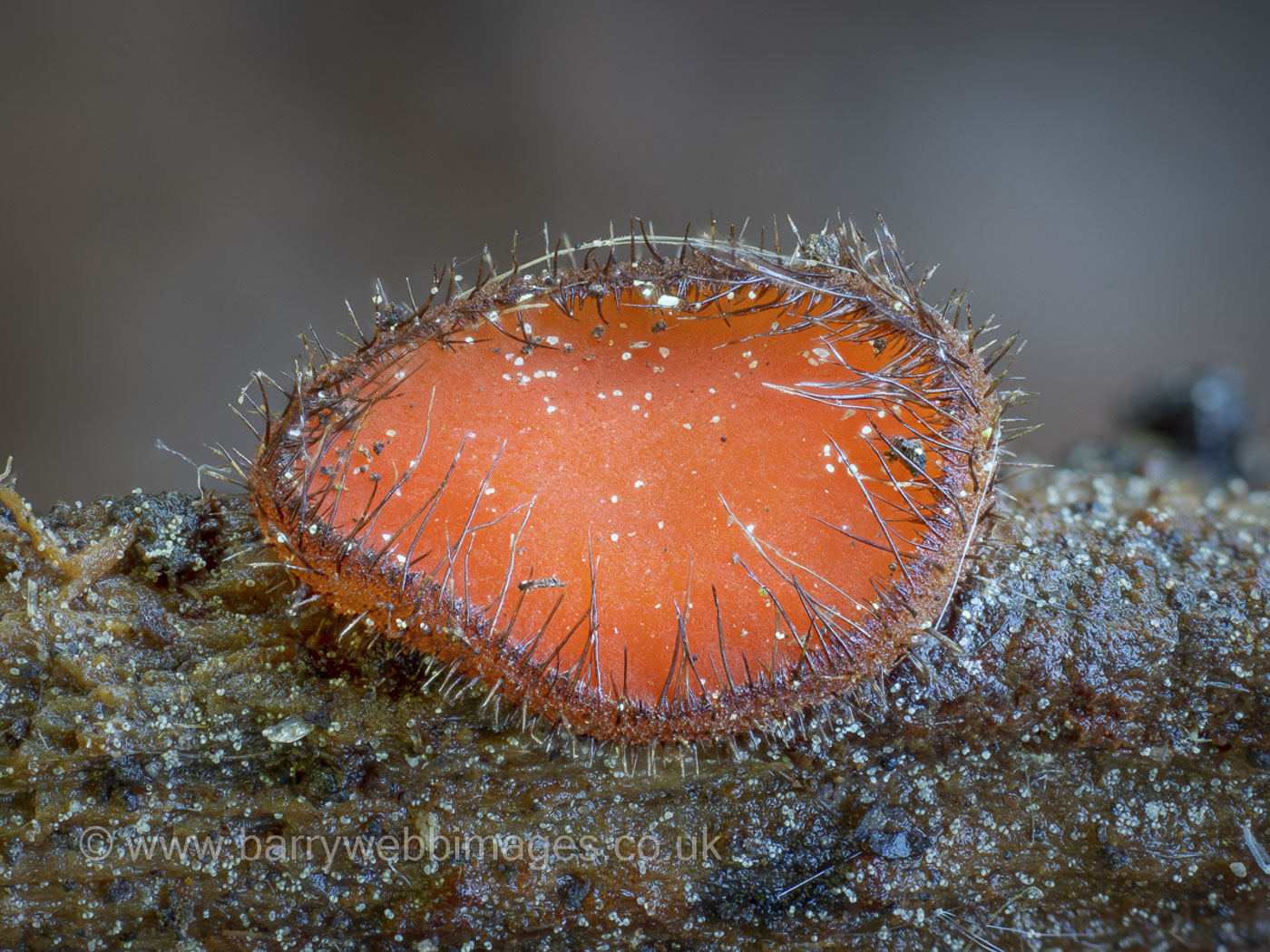 |
June 9th Scutellinia scutellata (Common Eyelash) 
On the edge of the Mire at Burnham Beeches Penny found just a singleton Eyelash in a muddy path, whereupon our small group then noticed several large clusters a few feet away. It was suspected in the field that this might turn out to be a different species of Eyelash because the Common Eyelash is much more commonly on wood of some sort rather than on soil (though the clearly lengthy hairs visible with a handlens belied this as it has the longest hairs of all species in the genus). Sure enough, Derek identified it as S. scutellata - disappointing in one way but it was such a sizeable collection so worth including here. Photo 1 is Penny's to give an impression of the numbers, photo 2 is Barry Webb's - a real stunner!
|
June 6th 2021
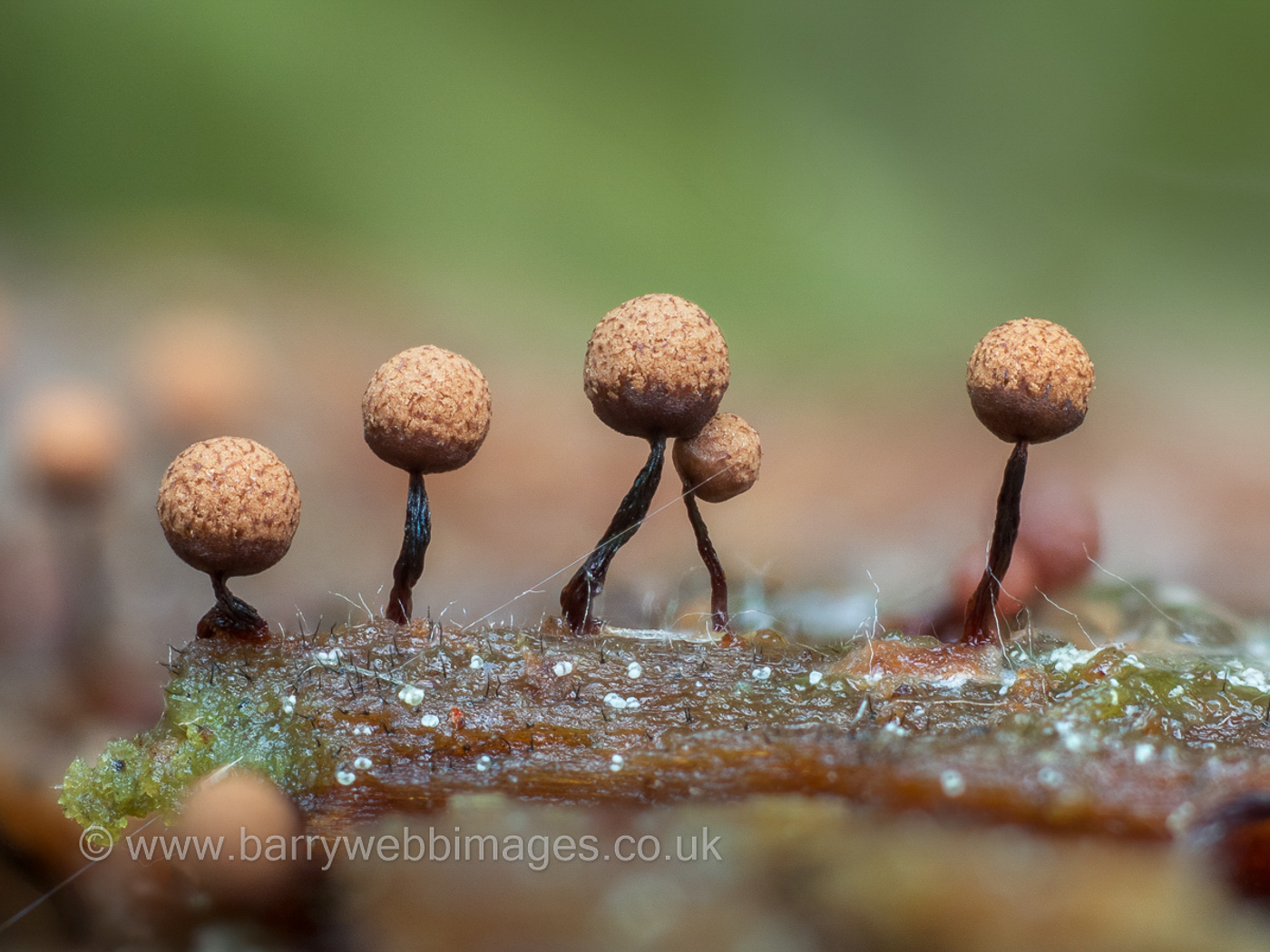 |
June 6th Cribraria vulgaris (a slime mould with no common name)
In Burnham Beeches (06.06.2021) on fallen damp Pine Barry found these minute (even for a slime mould) specimens which were only 0.5 mm across! (The determination was confirmed online by Myxo expert Edvin Johannesen.) A rare species with few national records, this was an exciting find. The single record for the county dates back to 1923 (at Burnham Beeches) with both collector and identifier as 'Anon', so probably best overlooked, making this new to Bucks.
|
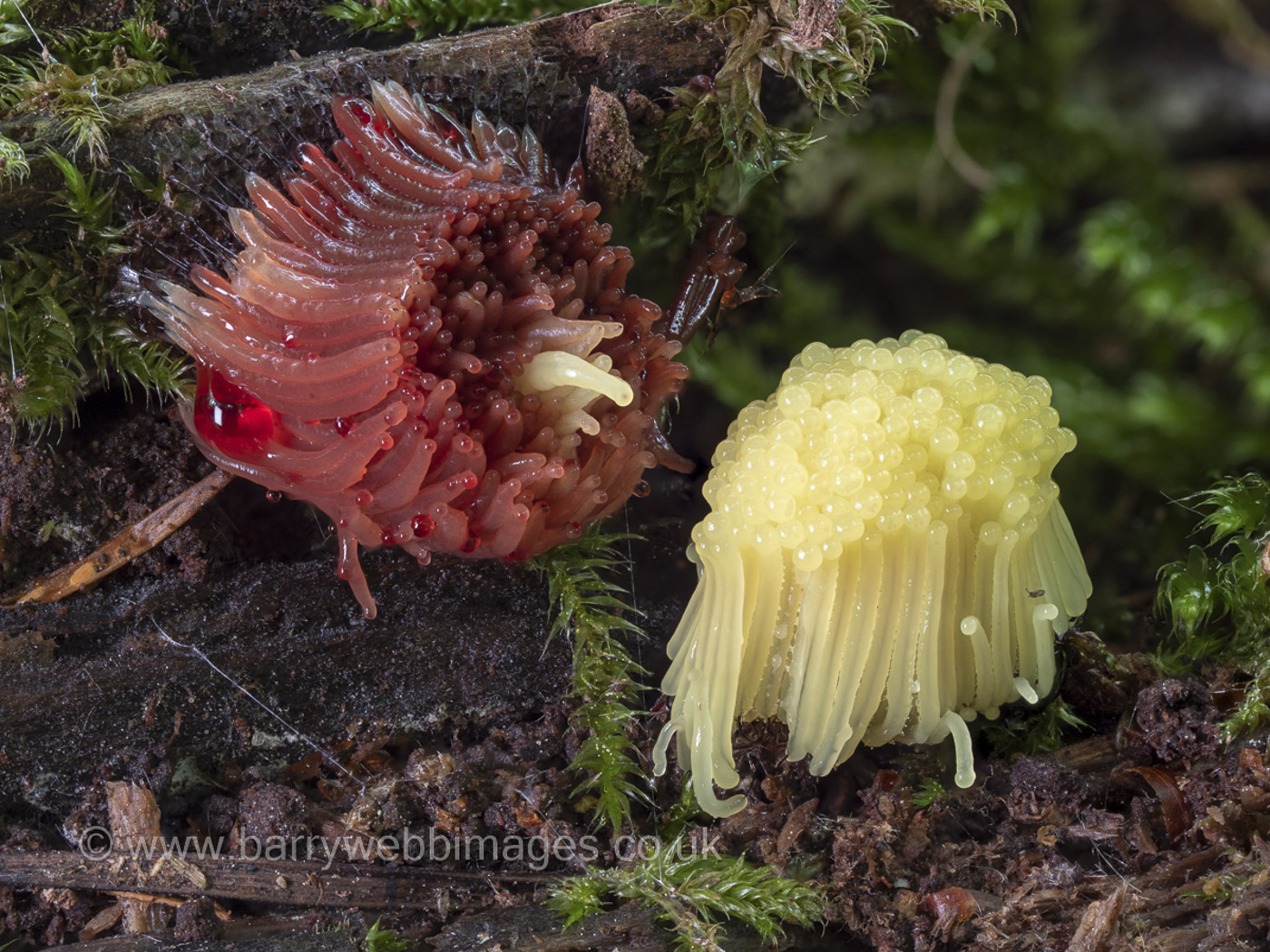
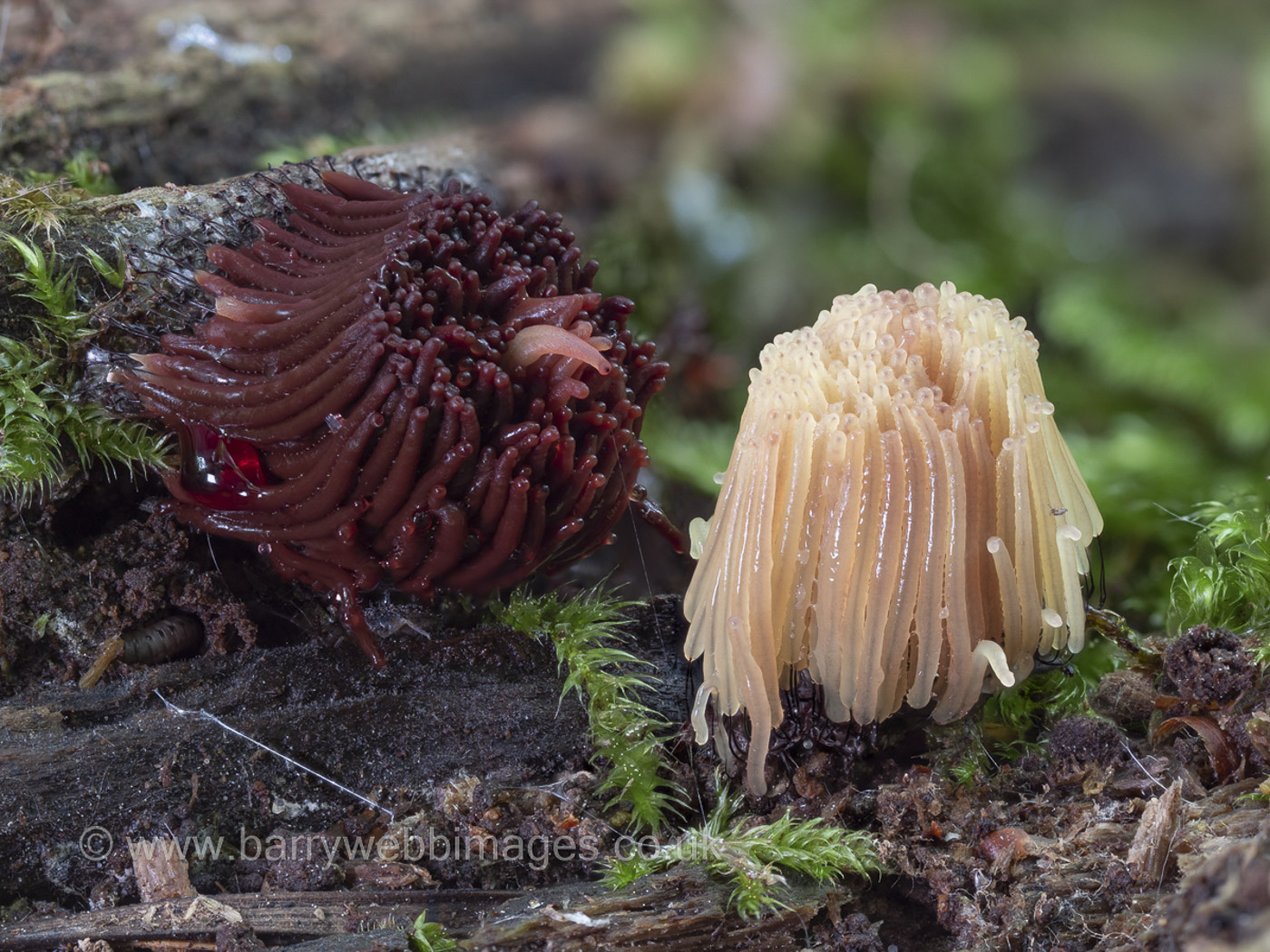
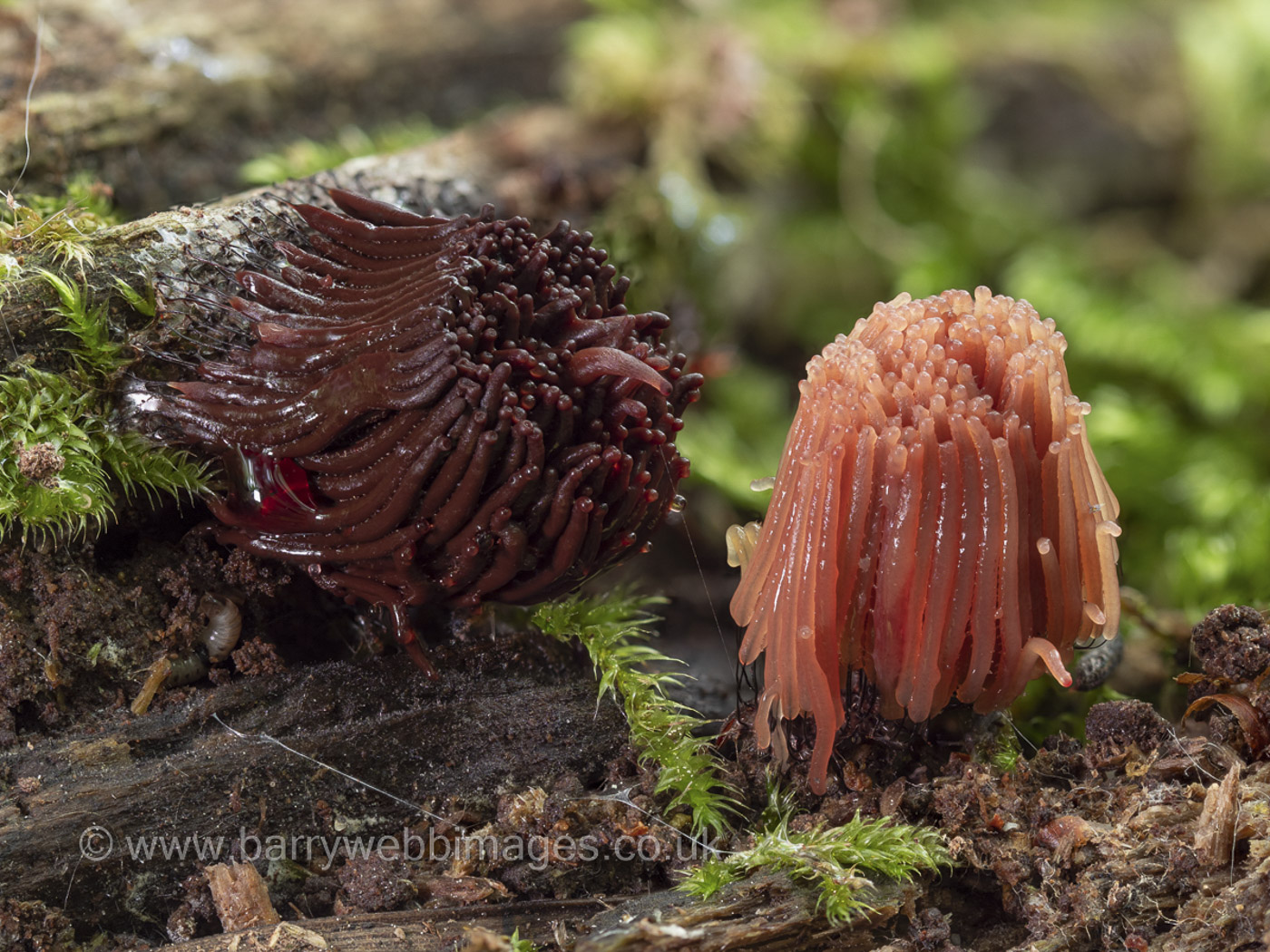
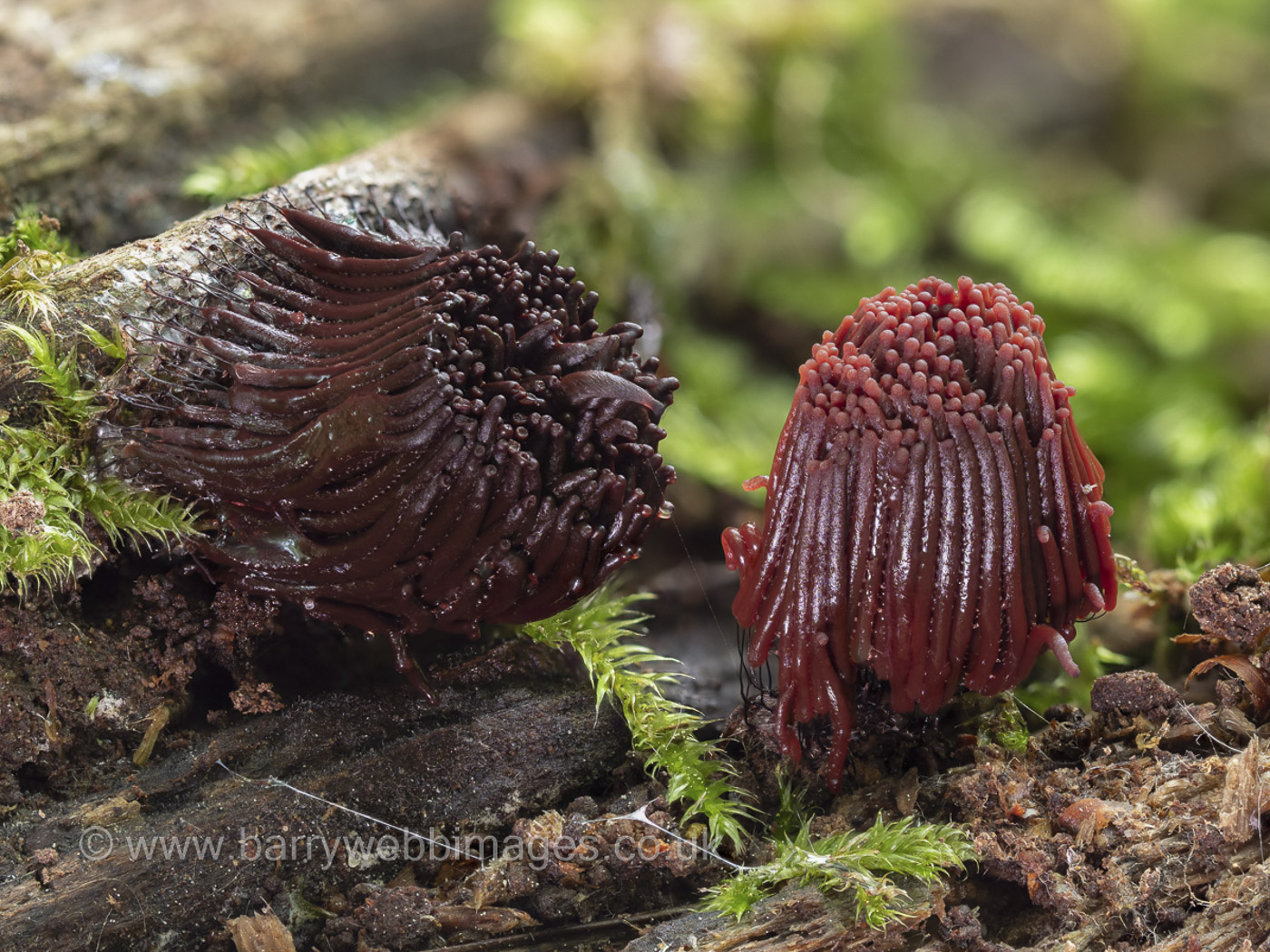
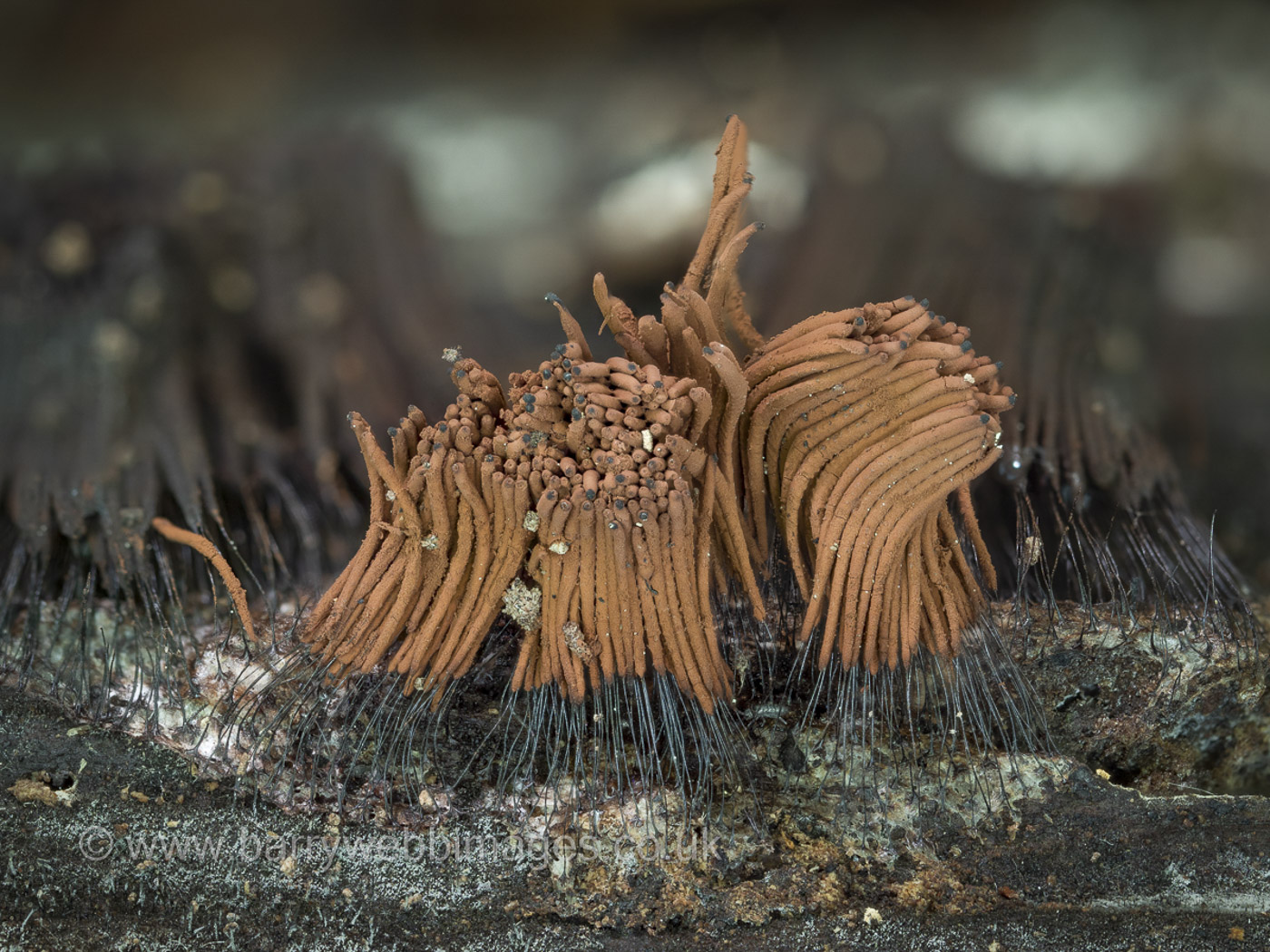 |
June 6th Stemonitis flavogenita (a species of 'Pipe-cleaner' Slime Mould with no common name) 
Barry Webb found a rotting fallen Birch trunk in Burnham Beeches with this Stemonitis species (at this stage unidentified) just starting to develop from the plasmodium (slimy) stage when the transformation in colour, shape and texture can be quite dramatic. He took this amazing set of photos over the space of several hours apart from the final one - taken when a group of us visited the site 4 days later when Penny took a now fully mature specimen to identify to species with a scope (only possible at this stage). S. flavogenita is alone in the genus in having bright yellow plasmodium rather than the normal white (as its Latin species name implies), but if not seen at this initial stage (just a slimy fragile shapeless mound) this useful clue is missed as all species tend to go through the same colour changes once the stalks and pipe-cleaner shape have formed: first yellowish then gradually pinkish and eventually some shade of cocoa brown - all in a matter of a few hours once it starts - before drying off completely as in the final photo here. The species is not rare but also not the commonest of the genus which is S. fusca - seen also on June 9th nearby, the photo also on Finds for that date.
|
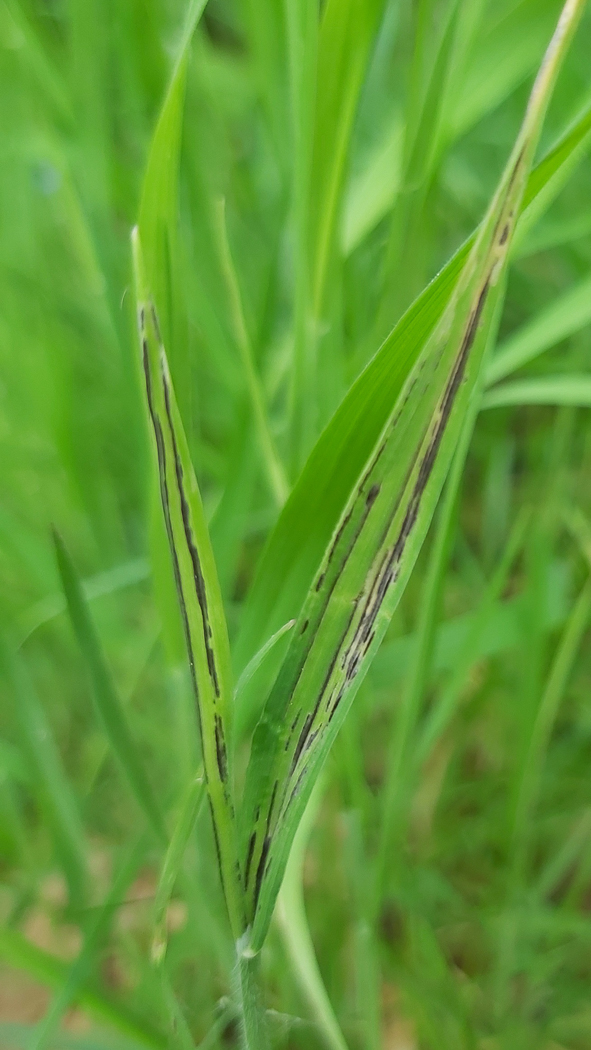 |
June 6th Ustilago striiformis (a species of Stripe Smut with no common name) 
In his garden lawn which he has been allowing to grow recently Jesper Launder identified this smut on the perennial grass Yorkshire Fog (Holcus lanatus). This apparently is a complex of species found on various grasses at this time of year and though not considered rare we appear to have no previous county records.
|
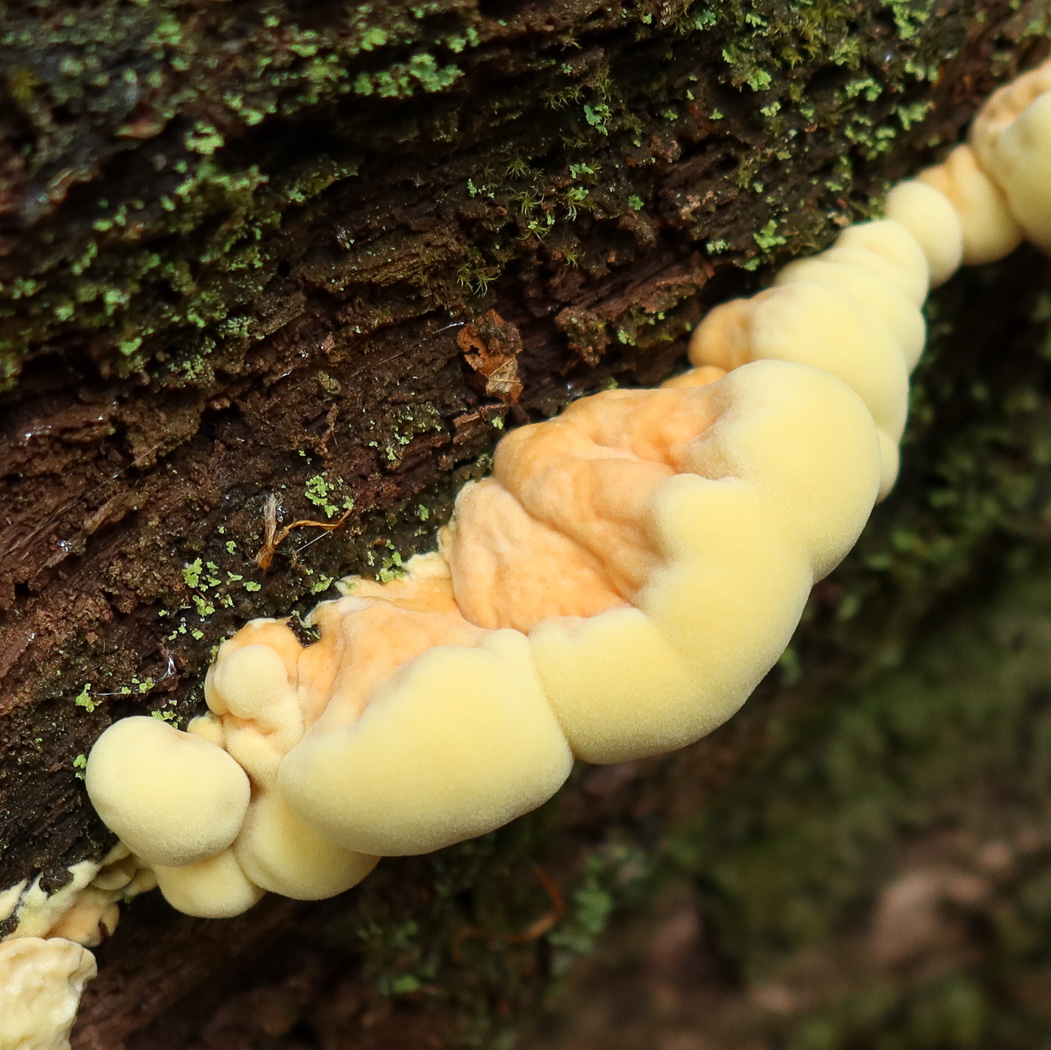 |
June 6th Laetiporus sulphureus (Chicken of the Woods)
In Naphill Common on the same log that she found this species last year, Claire Williams noticed this beautiful fresh growth just making an appearance. This is quite a common species worth looking out for now and often fruits in early summer on a range of different standing woods if conditions are suitable. The log here was not identified, but it favours Cherry, Oak, Pear, Poplar (though apparently not Beech) and can also be found on Yew and occasionally Larch. See also in Finds 2020 dated Sept 08.
|
June 4th 2021
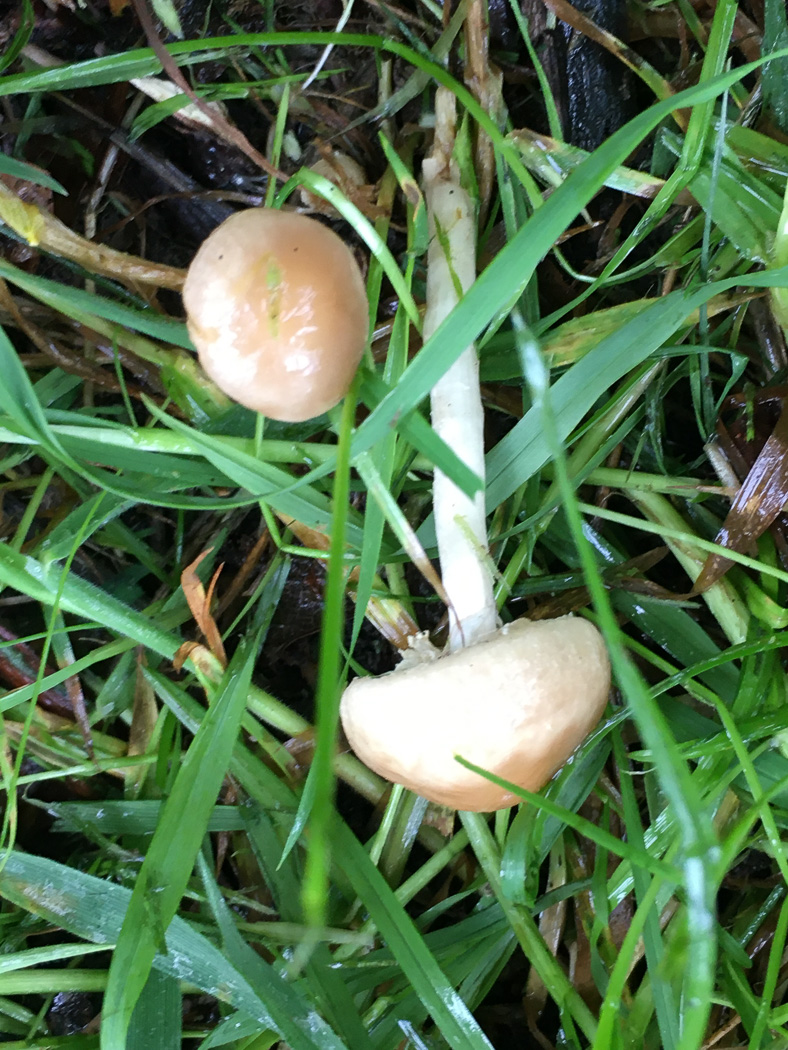 |
June 4th Agrocybe praecox (Spring Fieldcap)
In Brill Common Joanna Dodsworth found these nice fresh specimens in grassy soil near a Lime tree. More more about the species see also under May 25th where we have several other examples - this is a species clearly abundant at the moment.
|
May 31st 2021
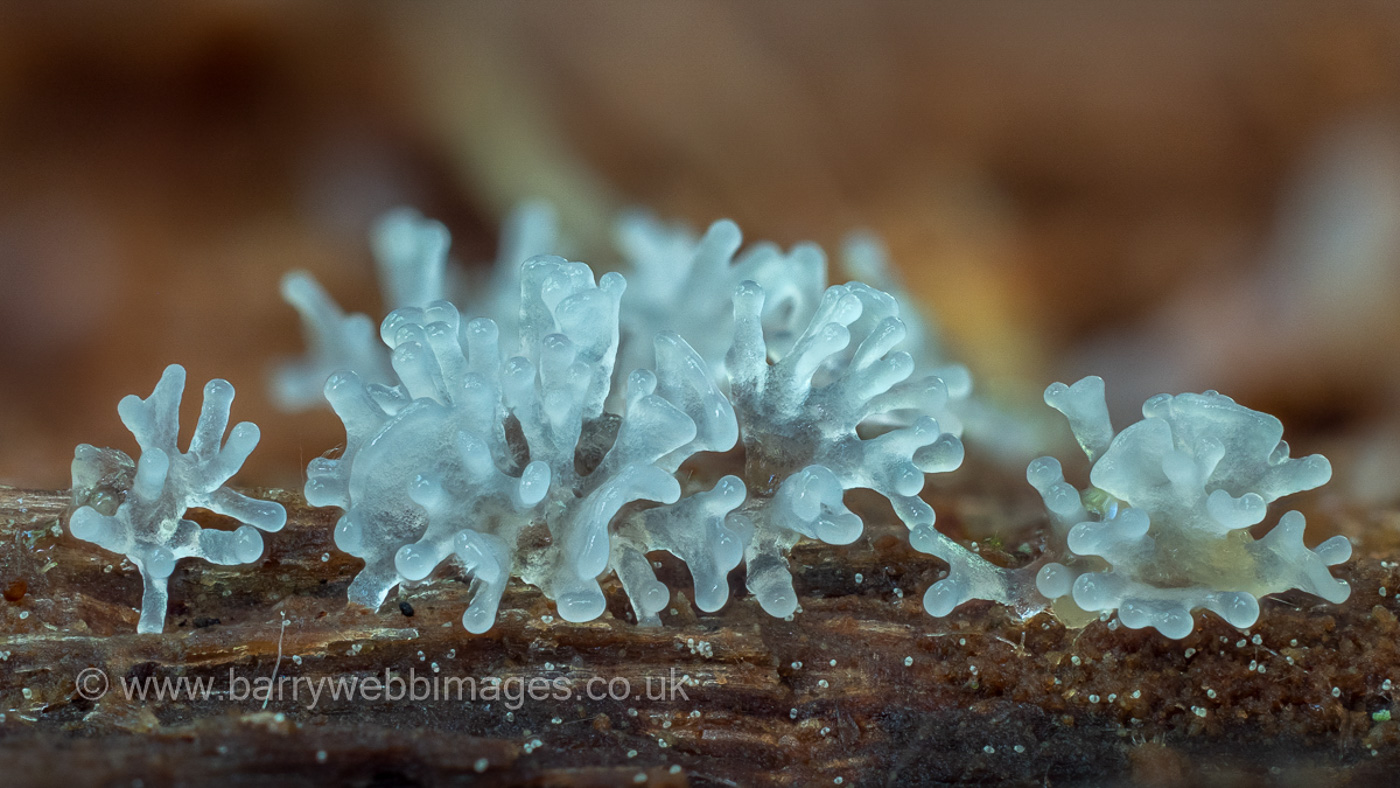
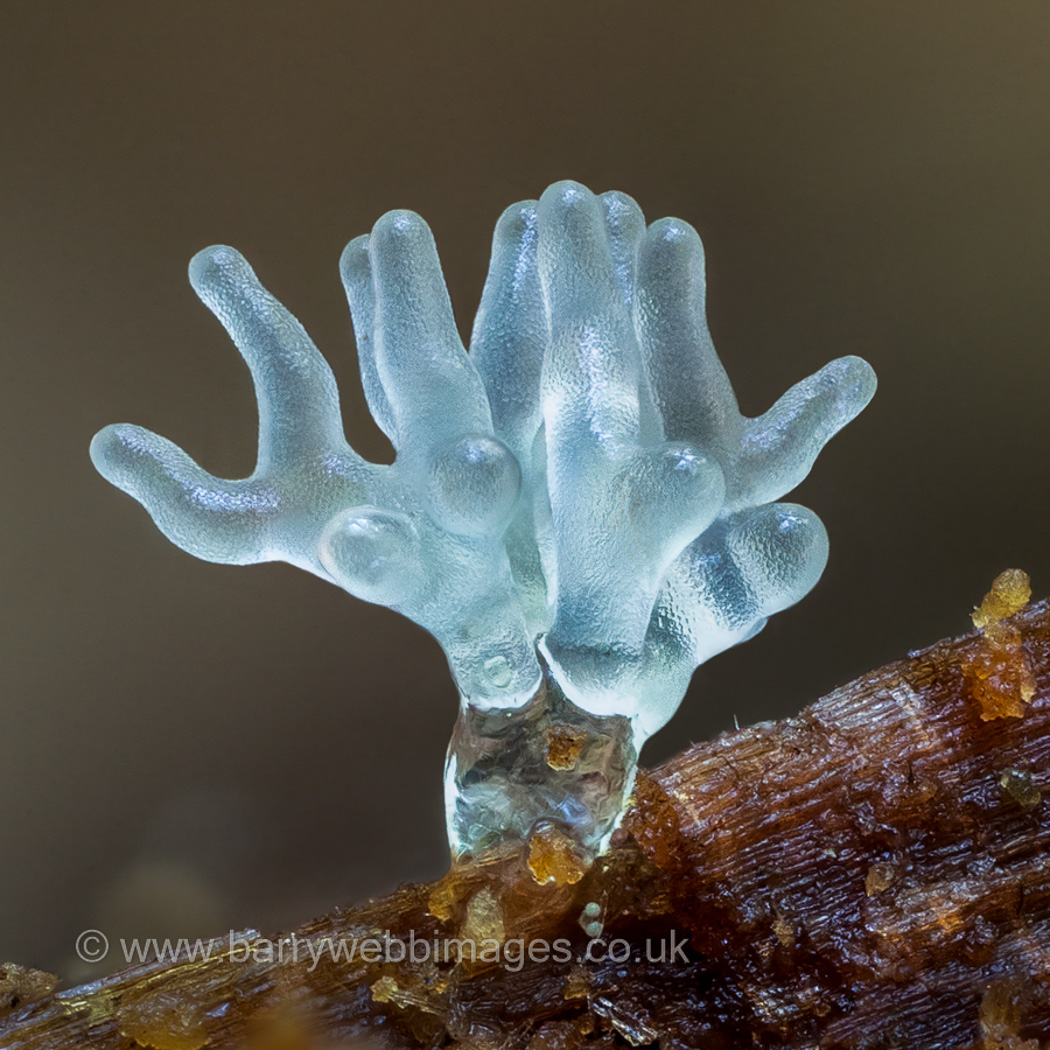 |
May 31st Ceratiomyxa fruticulosa (Coral Slime Mould)
Barry Webb took these beautiful photos of this tiny but quite common Slime Mould on a damp Pine stump in Burnham Beeches. The individual delicate watery white branches are usually less than 5mm high and a handlens is needed to appreciate their beauty. It can form quite large clusters up to 10 cm across, most commonly on conifer stumps but sometimes on other woods. (See also Finds 2020 dated Oct 18th and Nov 6th)
|
May 28th 2021
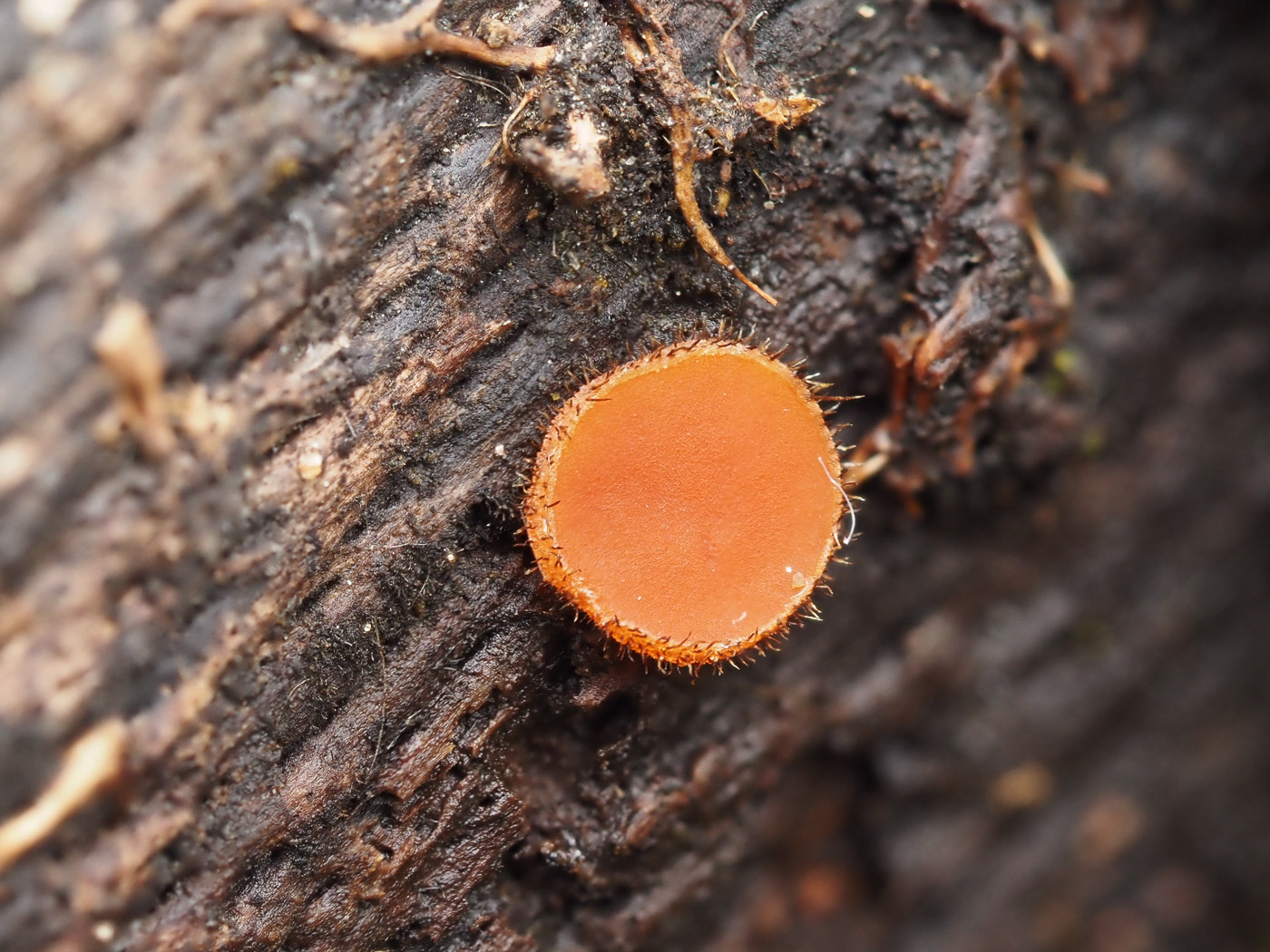 |
May 28th Scutellinia scutellata (Common Eyelash)
Claire Williams noticed this tiny brightly coloured cup, an Ascomycete, on a damp log near Mannings Pond, Downley. There are quite a few different species of Eyelash, really needing as scope to be positive as to species, but much the commonest and also the one with the longest most prominent lashes (clearly visible around the edge here) is this one. Often found in clusters, the cups can get to 1 cm across or more and favour damp rotting wood. If you find one growing on soil then it's likely to be one of the other rarer species.
|
May 26th 2021
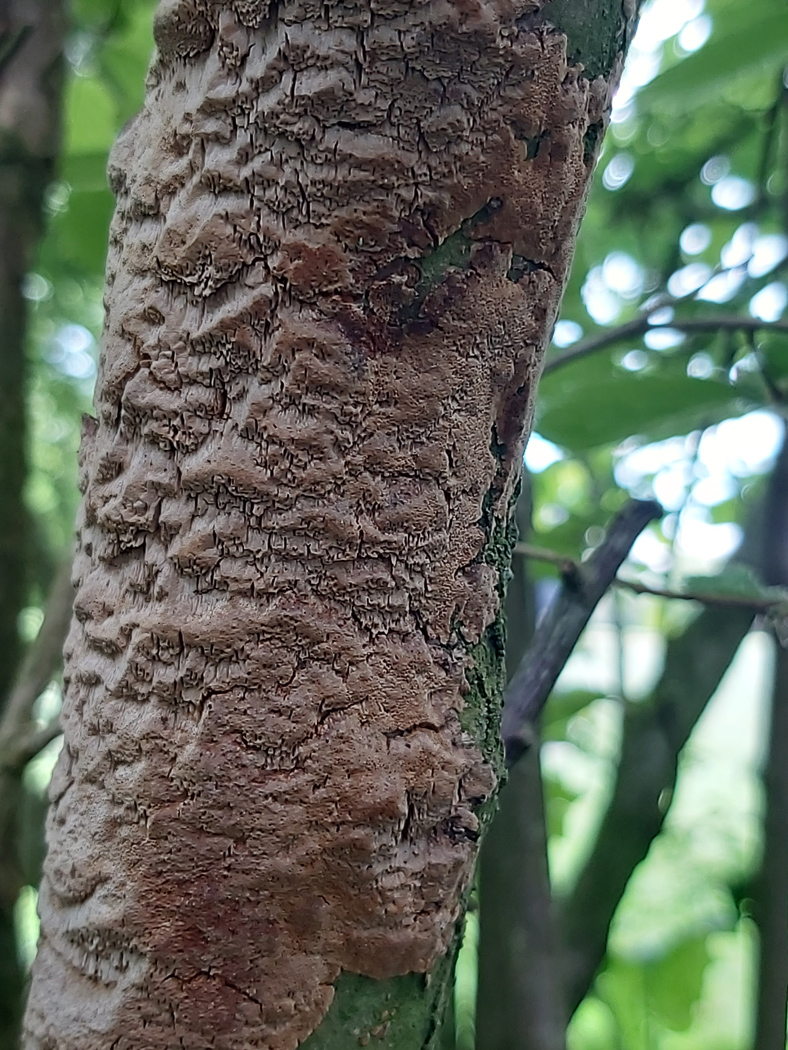 |
May 26th Fuscoporia ferruginosa (previously Phellinus ferruginosus) (Rusty Porecrust) 
On a Hazel branch at Oakland Park Golf Course Jesper Launder found this patch of fungus and took a piece home to examine, knowing that there are two extremely similar crusts - F. ferrea (previously Phellinus ferreus) being by far the commoner of the two. Both occur on a wide range of deciduous fallen woods and have distinctive brown 'setae' - fine pointed hairs needing a microscope to see, but only today's species has these setae in the marginal tissue where the fungus joins the substrate. They are not easy to find but Jesper succeeded!
|
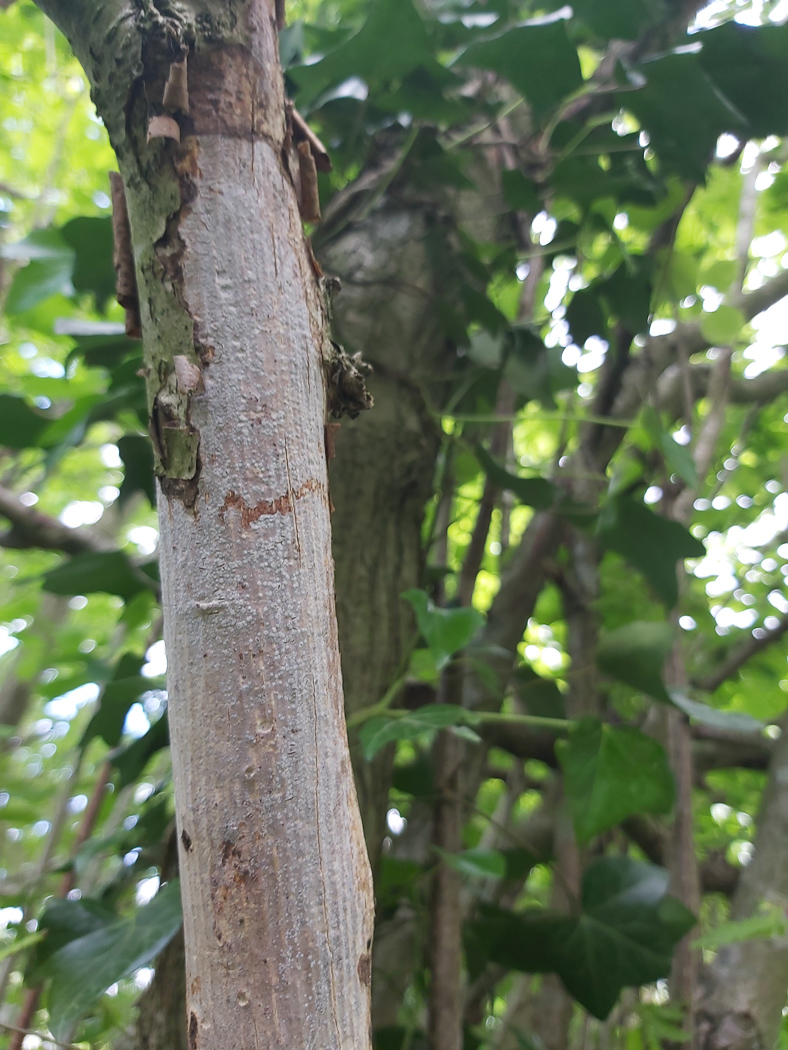 |
May 26th Vuilleminia coryli (a corticioid fungus with no common name) 
At Oakland Park Golf Course Jesper Launder noticed this patch of fungus spreading smoothly over a Hazel branch. It is somewhat similar to the many other corticioid fungi but is found mainly on Hazel (also on Hawthorn and Dogwood) and has a soft waxy slightly pinkish surface but needs examination with a scope to make the determination secure. Apparently quite a common species, we have around 10 county records.
|
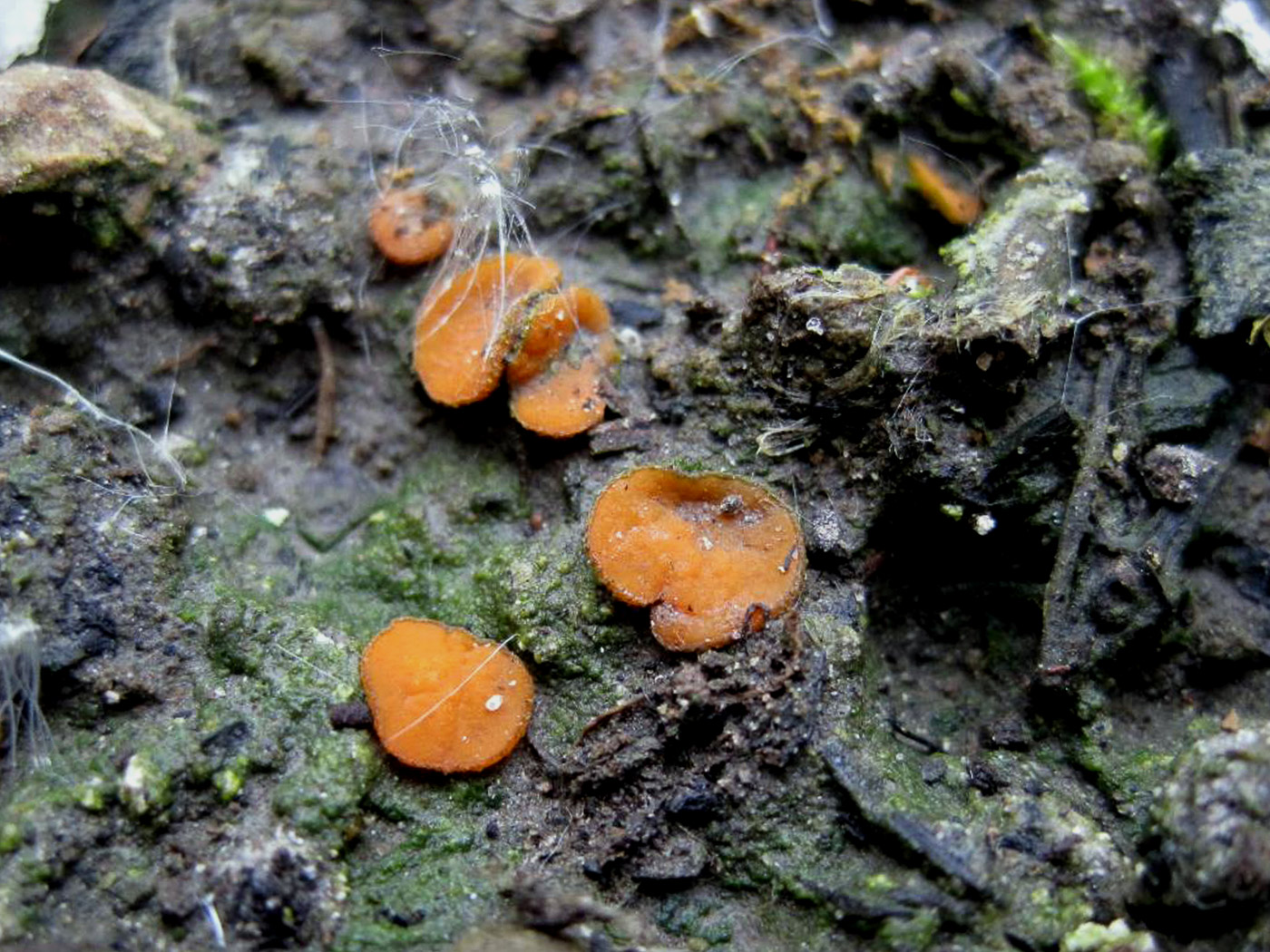 |
May 26th Anthracobia macrocystis (an Ascomycete with no common name) 
Joanna Dodsworth found these tiny red cups on burnt ground in Brill Common. Not unlike a small example of Common Eyelash (see an example dated May 28th) in general appearance, it lacks the distinctive dark hairs around the rim, never gets as large as the Eyelash and under the scope is very different. It is one of quite a few different fungi associated with old bonfire sites or ground previously burnt - a substrate always worth a close inspection for fungi when you come across it.
|
May 25th 2021
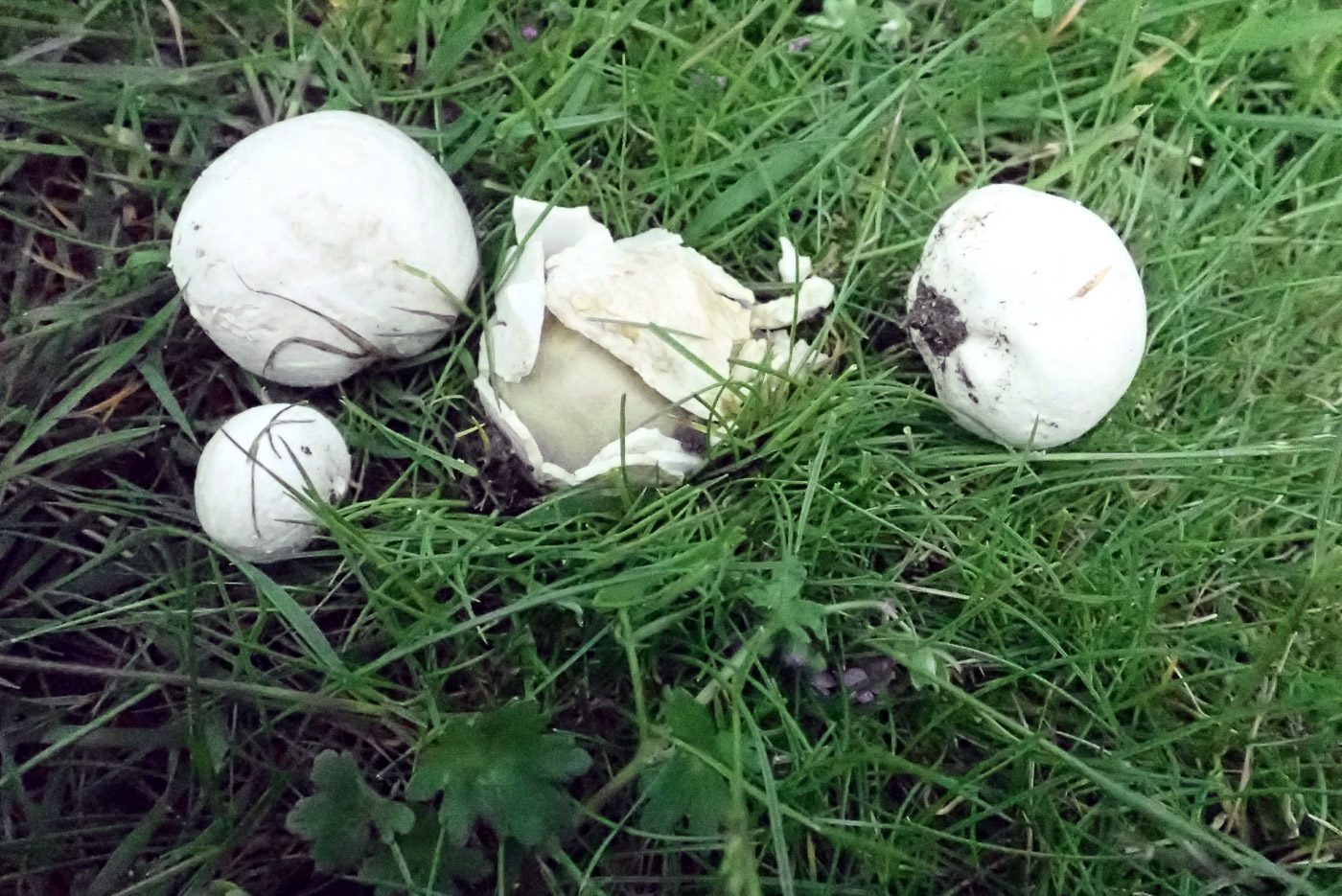 |
May 25th Bovista plumbea (Grey Puffball) 
Penny came across these puffballs in a grassy path at Stampwell Farm and initially thought they were Vascellum (now Lycoperdon) pratense (Meadow Puffball) until she noticed the way the surface of the one mature specimen (seen in the centre) was flaking away to reveal the thick skinned covering protecting the spore mass within. This doesn't happen in the Meadow Puffball and at home the finely ornamented round spores with a long 'tail' matched those for the Grey puffball. When old this common grassland species turns greyish and can often be found having detached from the substrate blowing around.
|
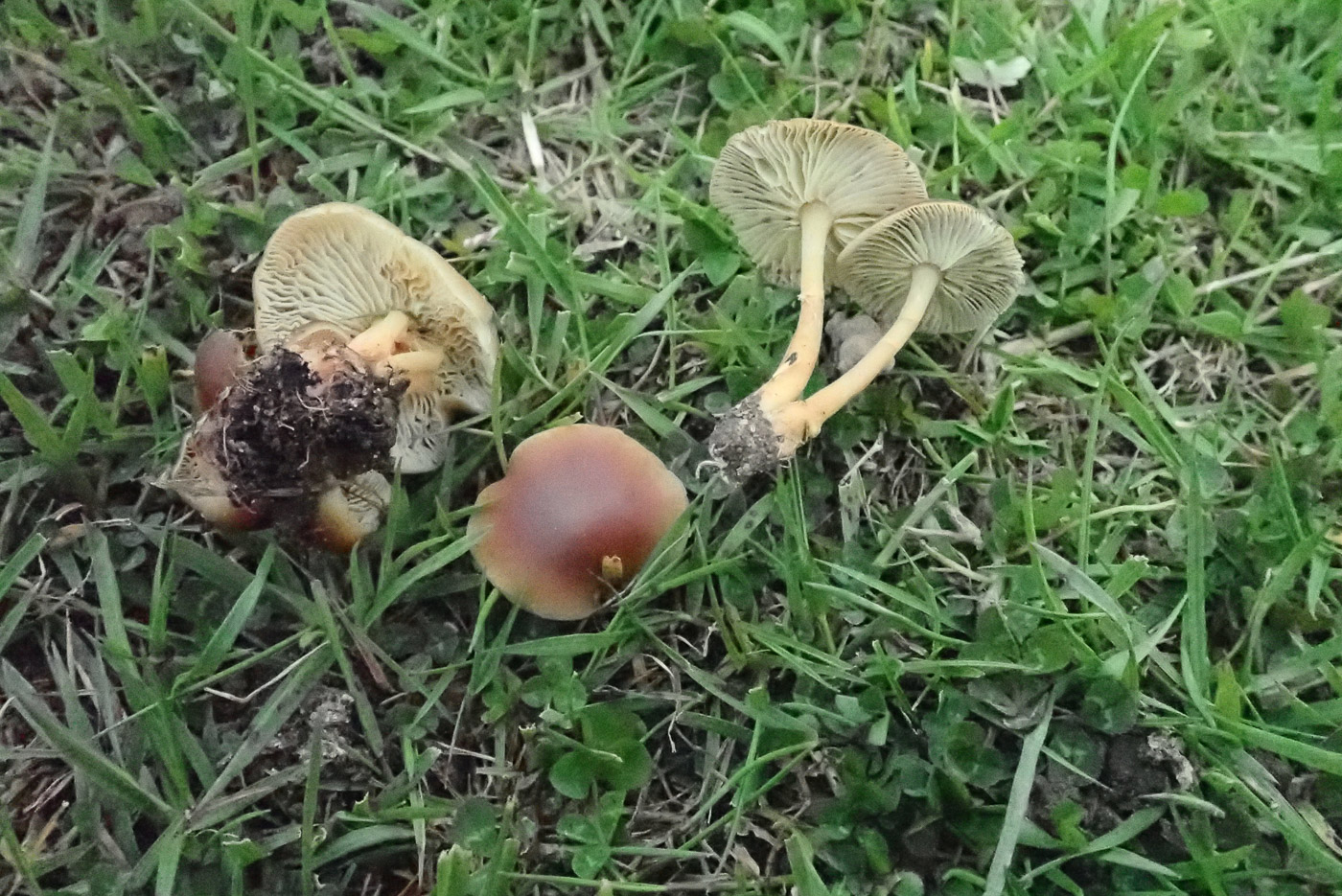
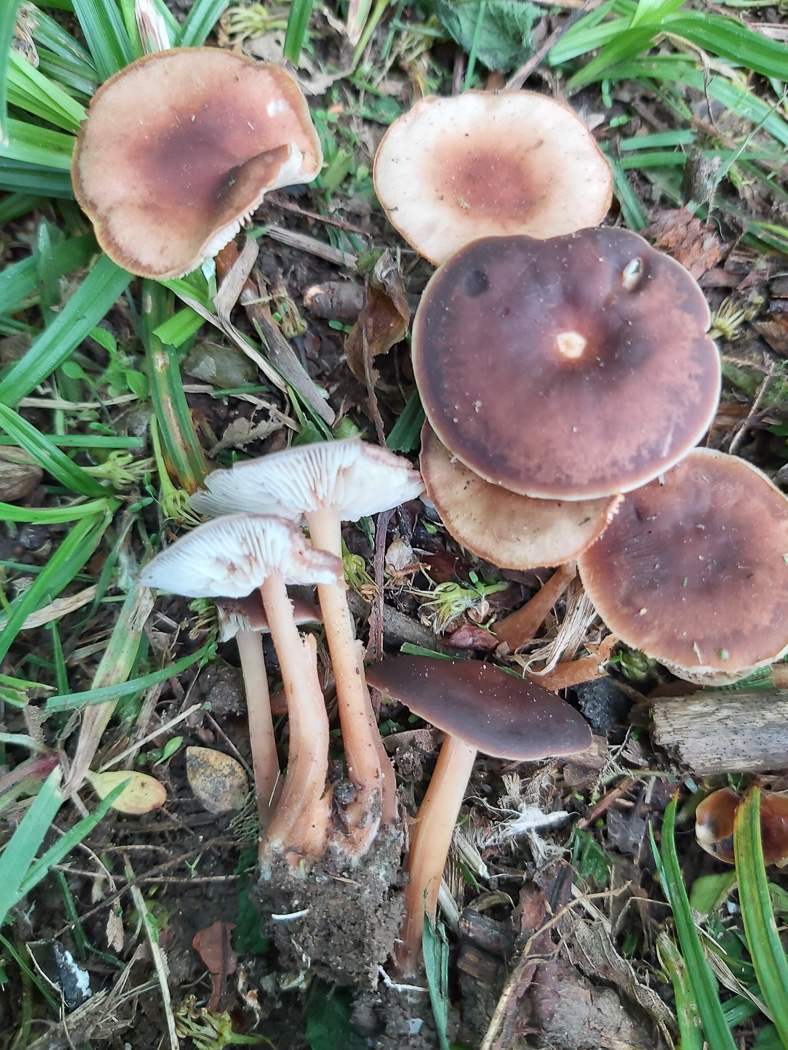 |
May 25th Gymnopus (was Collybia) ocior (Spring Toughshank) 
On a visit to Stampwell Farm near Seer Green Penny was pleased to find this quite unusual Toughshank in soil in a grassy area. Very similar to the common G. dryophilus - one which fruits early in the main fruiting season - the species is distinguished in the field by the darker red-brown cap colour and the gill colour which has a marked yellow tinge, a feature which seems to develop a few hours after collection. We have about 10 previous records, made mostly between May and September, whereas the earliest months for our 250 or so records of G. dryophilus are from July / August. This fits with general descriptions which state that it tends to fruit earlier than G. dryophilus. Photo 2 from a grassy patch in Jordans Village was sent in two days later by Jesper Launder.
|
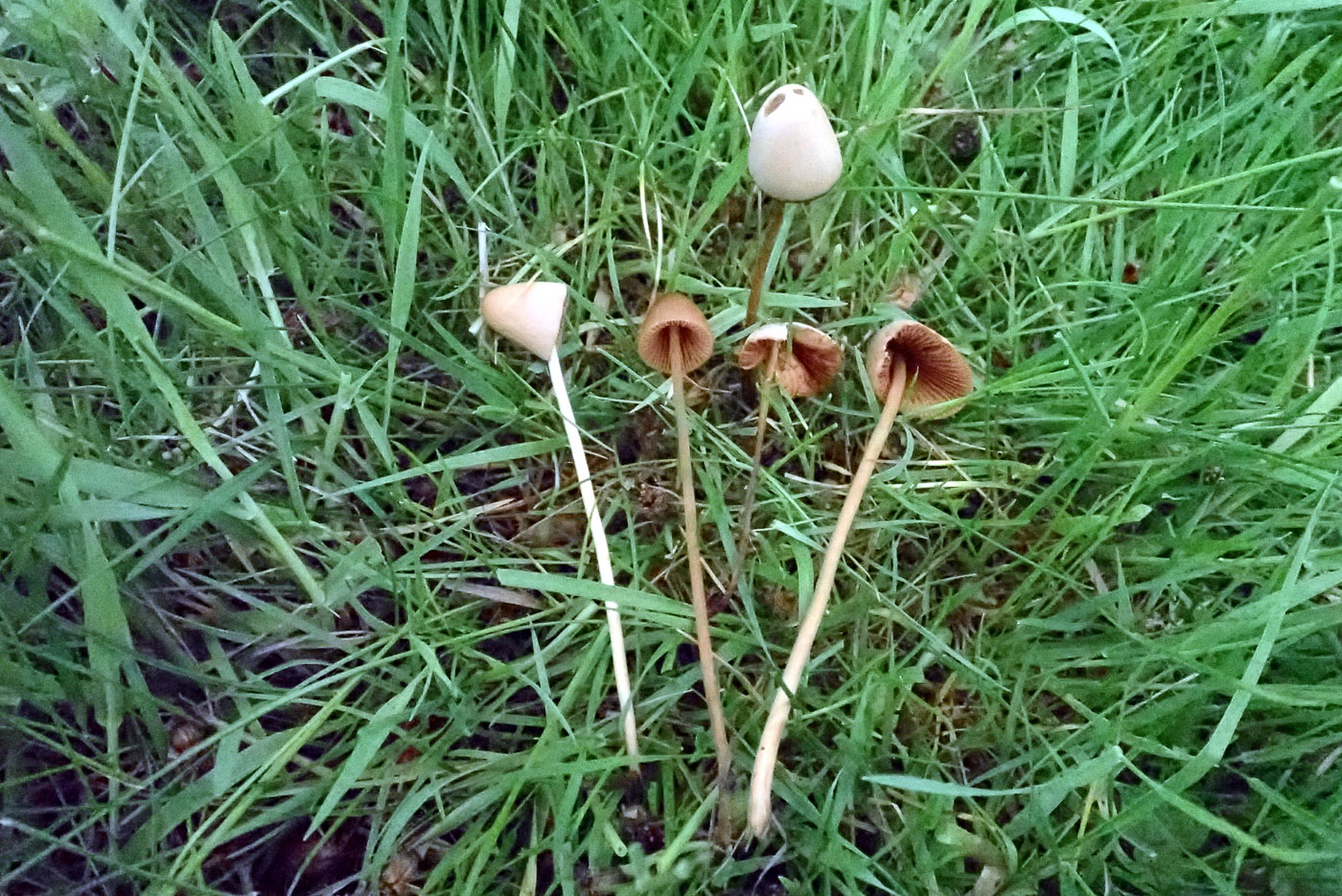 |
May 25th Conocybe macrospora (a species of Conecap with no common name) 
On a visit to Stampwell Farm near Seer Green Penny found several fruit bodies of an interesting LBJ which needed work at home to identify. The rusty gills were an indication that it was a Conecap and at home the distinctive skittle-shaped cells on the gill edge confirmed this. Following through the lengthy key eventually arrived at this unusual species which amongst other features has basidia which bear only two spores each, thus producing notably larger spores than others in the genus. We have just one other county record with only about 30 UK records on the national database.
|
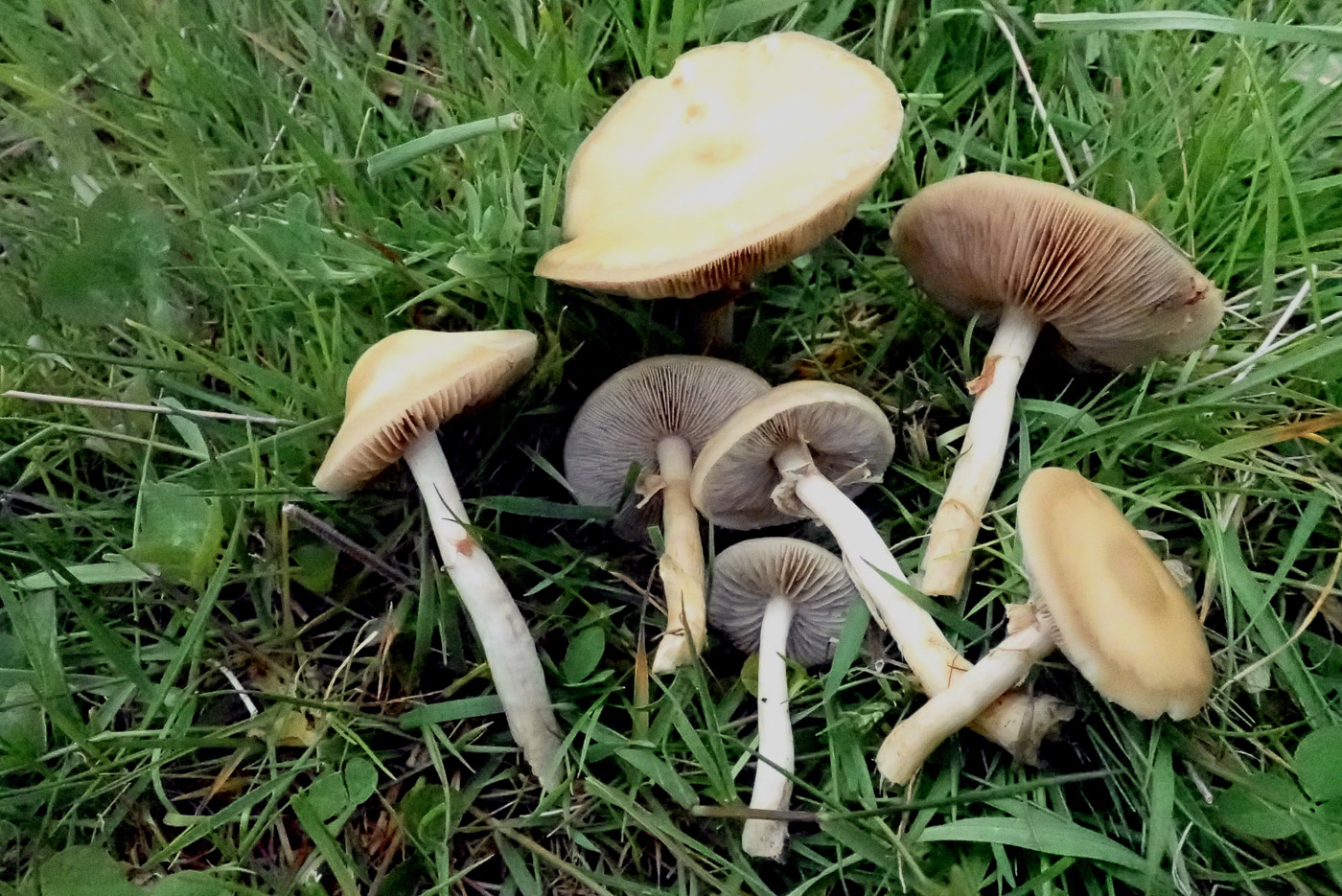
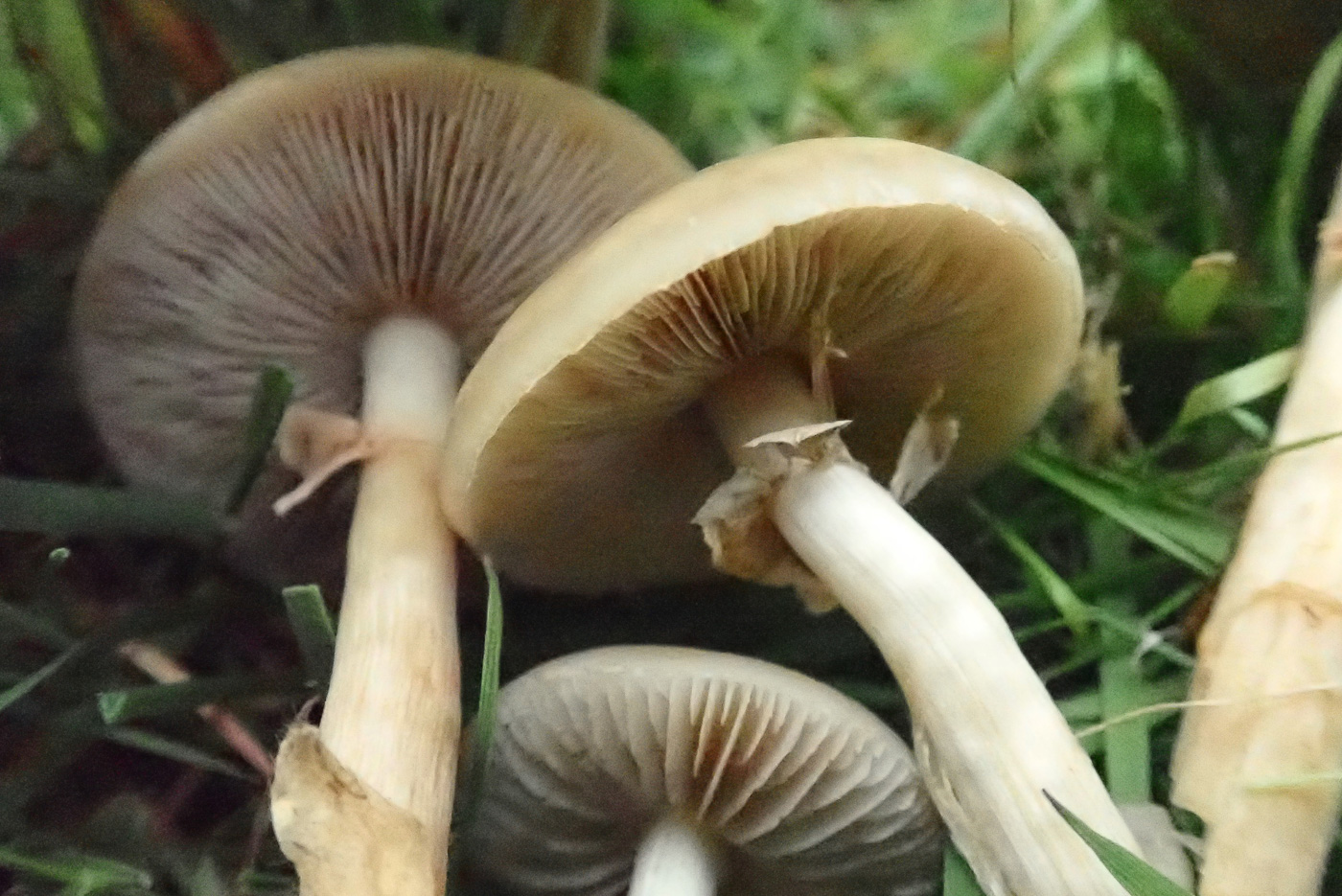
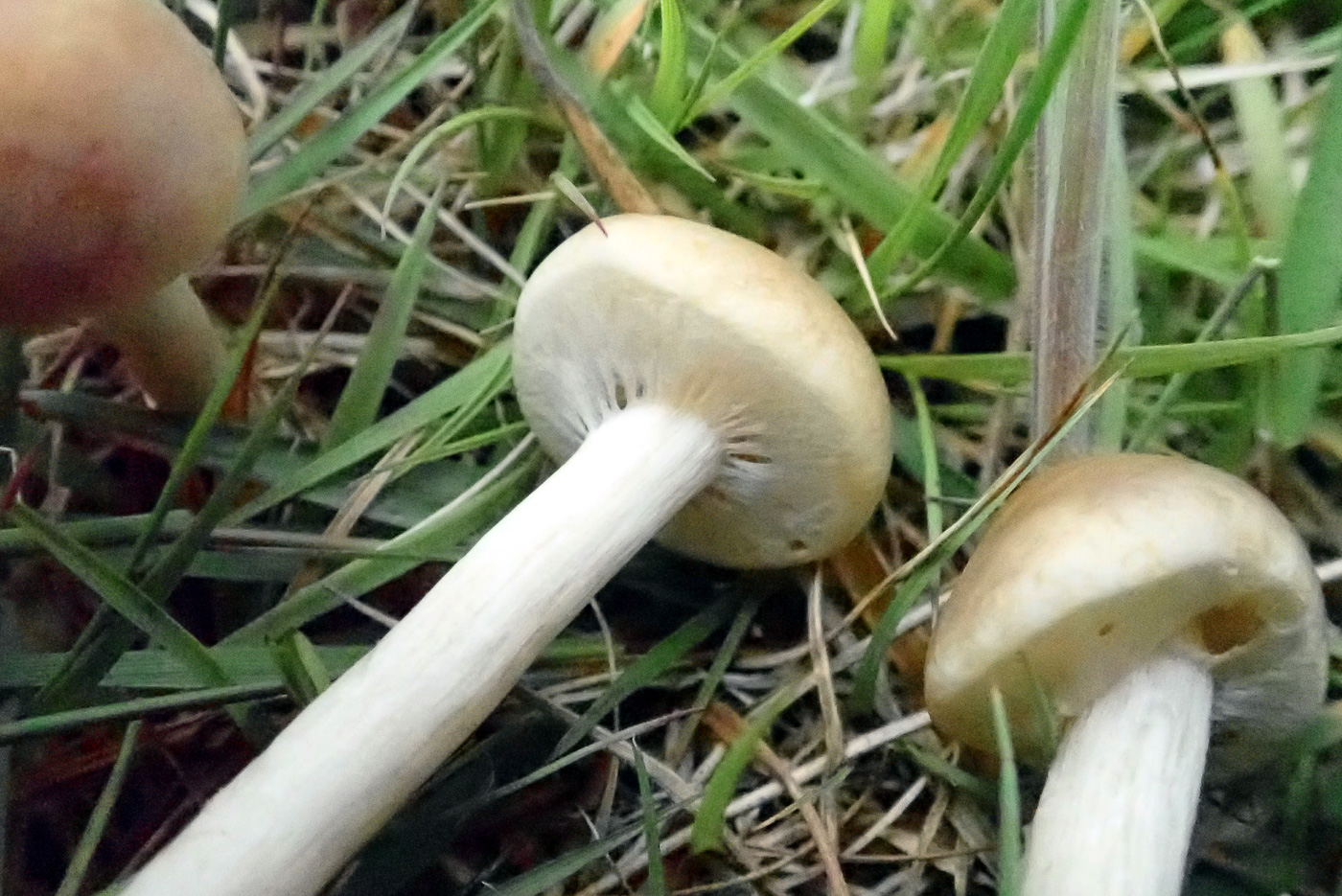
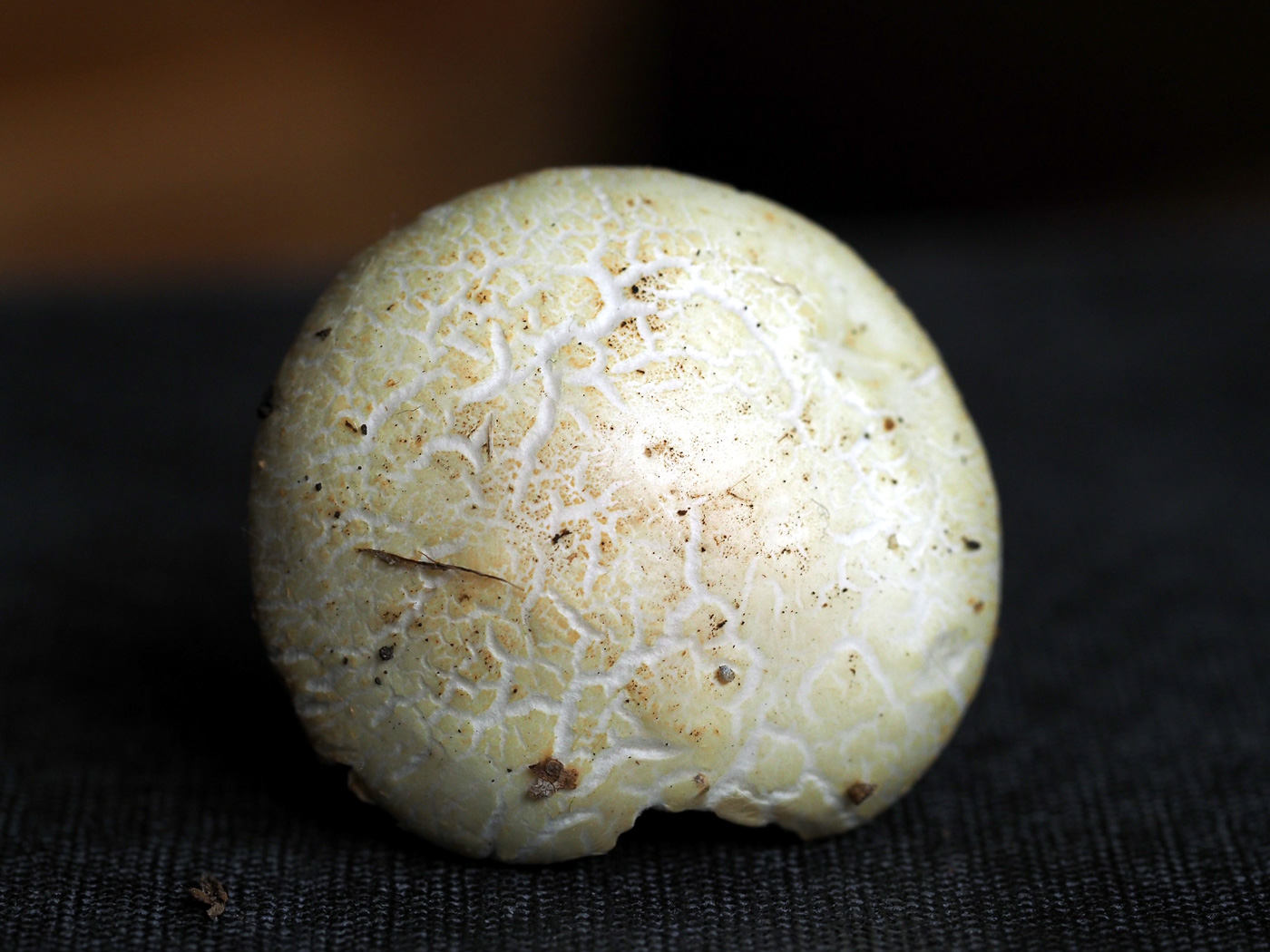 |
May 25th Agrocybe praecox (Spring Fieldcap) 
On a visit to Stampwell Farm near Seer Green Penny found good numbers of this species in soil in grazed pasture. This is one of the genus which has a ring on the stem which often disappears quite quickly but can be clearly seen still covering the gills on the young specimens in photo 3 with remnants visible on older specimens in photos 1 and 2. The yellow ochre caps can get to 6 cm across and in dry weather often become remarkably cracked (a useful character) but here they were smooth, also slight sticky after the rain. Photo 4, however, shows an example of a typically cracked cap sent in by Claire Williams a few days later. This is quite a common springtime species given the correct grassland habitat.
|
May 24th 2021
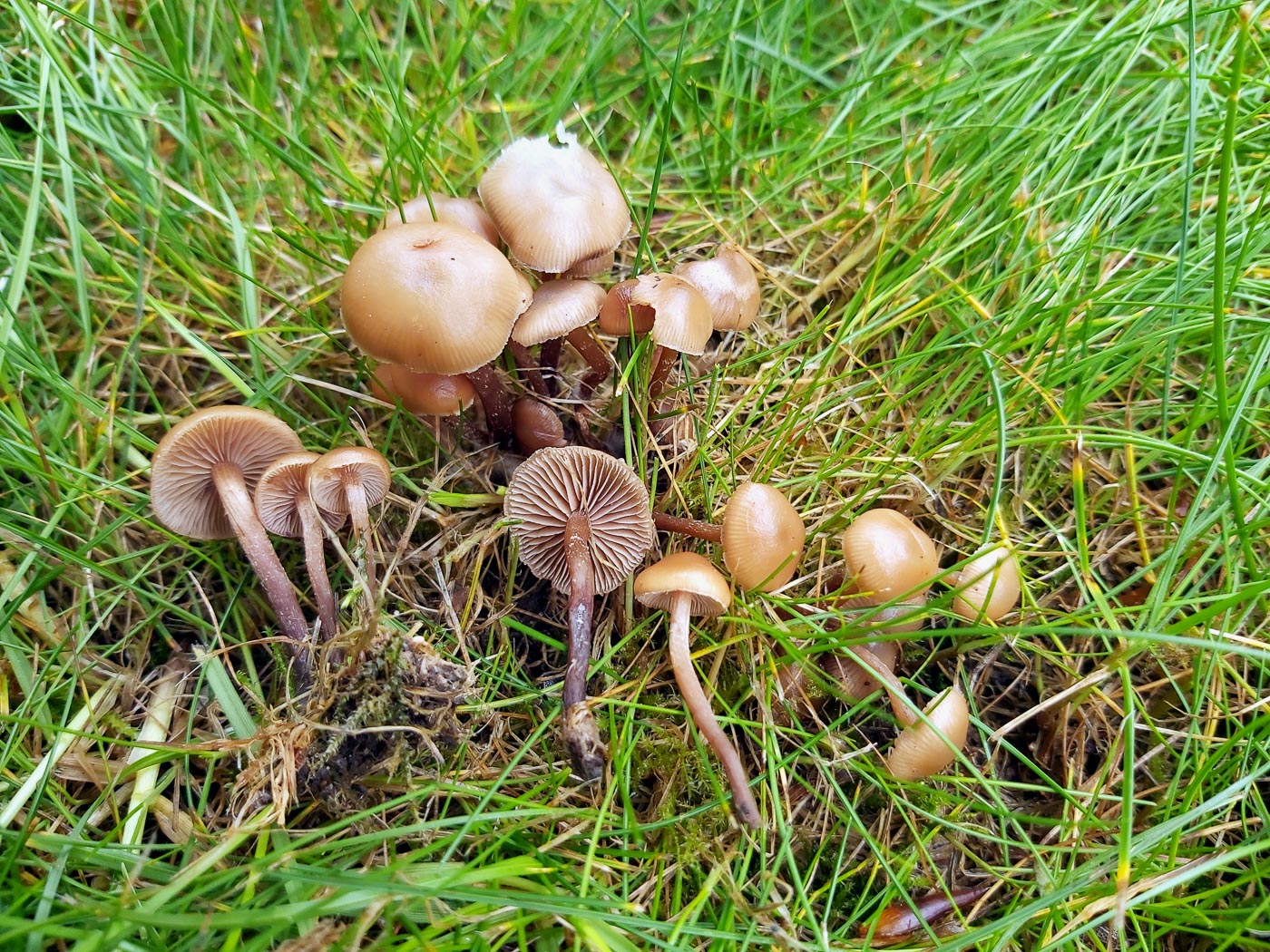 |
May 24th Deconica (was Psilocybe) inquilina (a species of Brownie with no common name) 
On his lawn at home in Jordans Jesper Launder found this uncommon species - a typical rather non-descript LBJ needing careful examination to identify. An important feature is its sticky rubbery cap covering which can be peeled off completely and this taken into account together with its microscopic features and spring fruiting in lawns / grassland were diagnostic. We have just two previous county records, both from lawns in May.
|
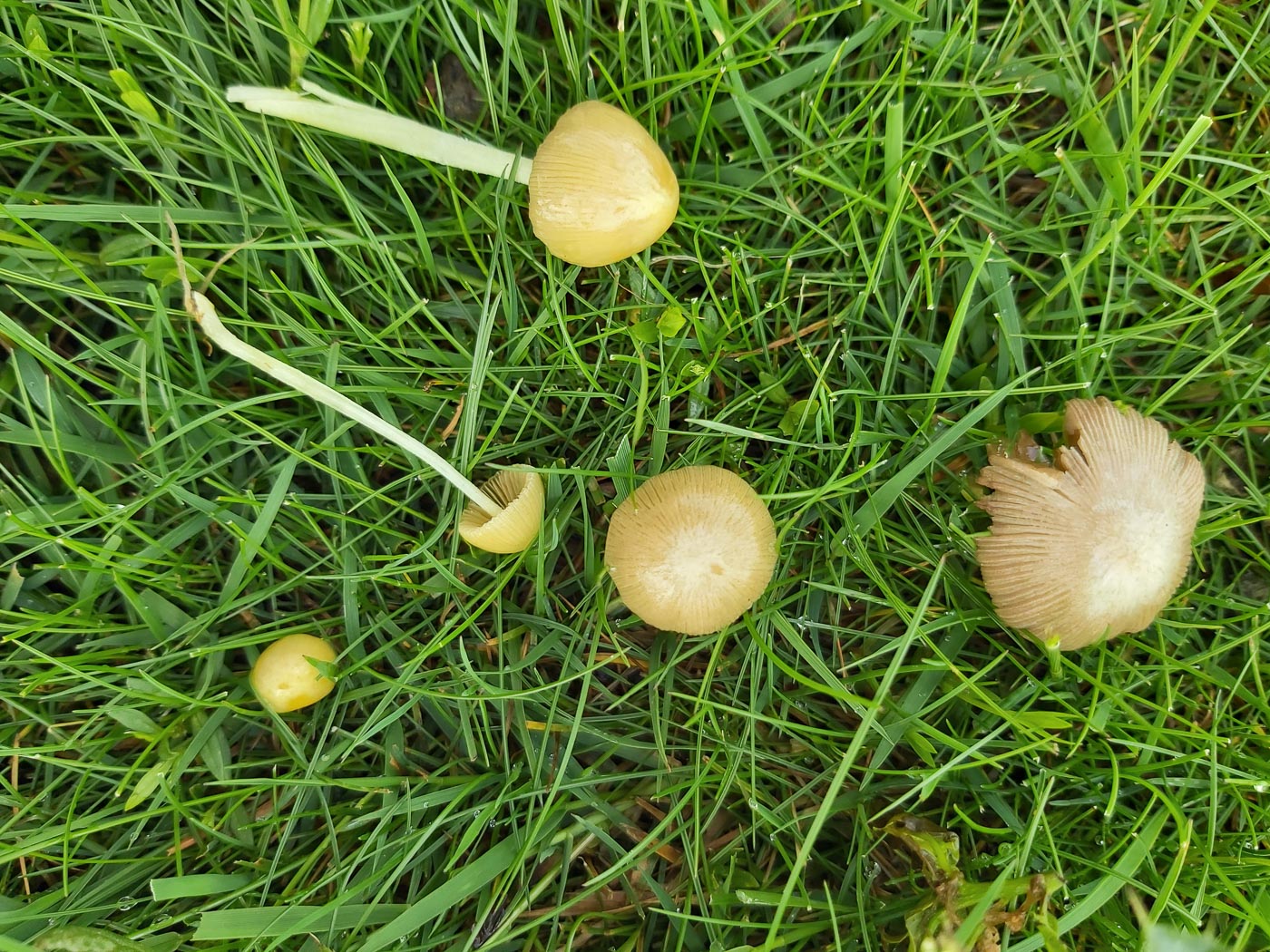 |
May 24th Bolbitius titubans (Yellow Fieldcap)
Jesper Launder found this nice collection in a chalky field near Jordans village. Note the smooth egg yolk yellow immature cap just emerging (top right) in contrast to the mature pale beige cap with the typical radial striations (left), with all stages in between gradually losing the yellow. This is a common grassland species, also sometimes found in woodland rides and woodchip piles. See also dated Mar 31st and in Finds 2020 dated Sept 29th and Nov 1st.
|
May 22nd 2021
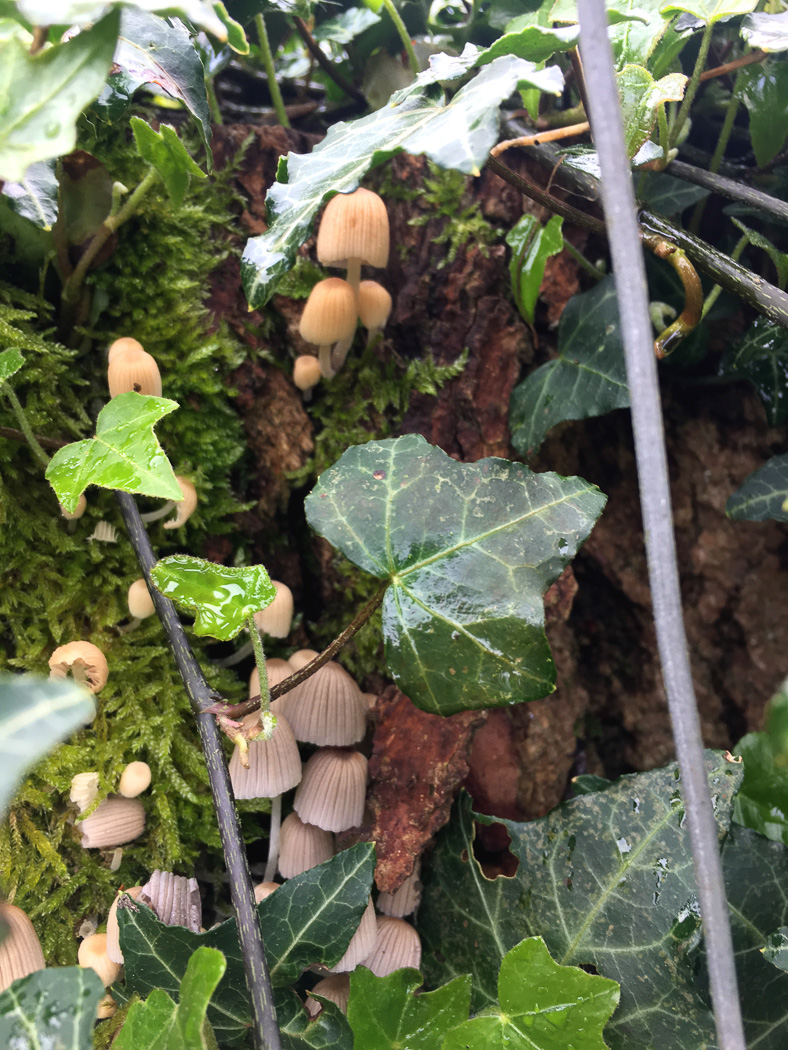 |
May 22nd Coprinellus disseminatus (Fairy Inkcap) 
Joanna came across this attractive clump of little Inkcaps on Brill Common amongst the moss and ivy on an old deciduous stump. This common species will come up sometimes in impressively large numbers at any time of year given suitably damp conditions and some rotting woody remains. To recognise it note the rather flat topped cap with rather straight sides - it's a bit like a mini Glistening Inkcap. See also Finds 2020 dated Sept 8th.
|
May 20th 2021
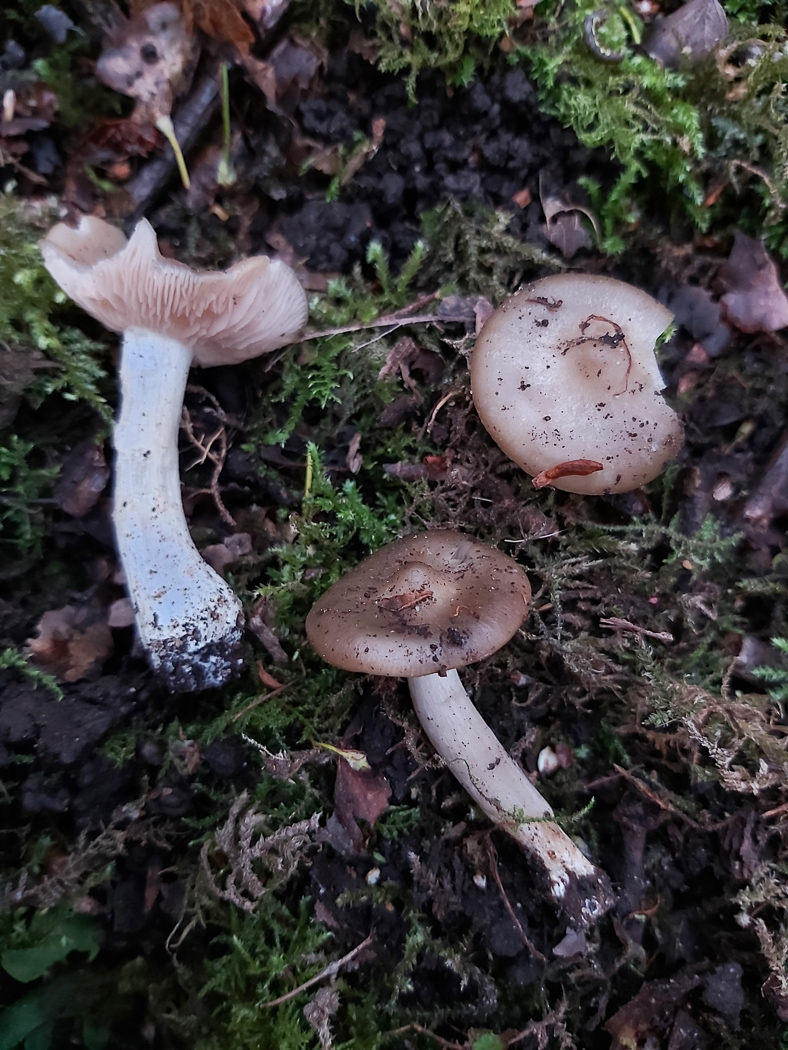
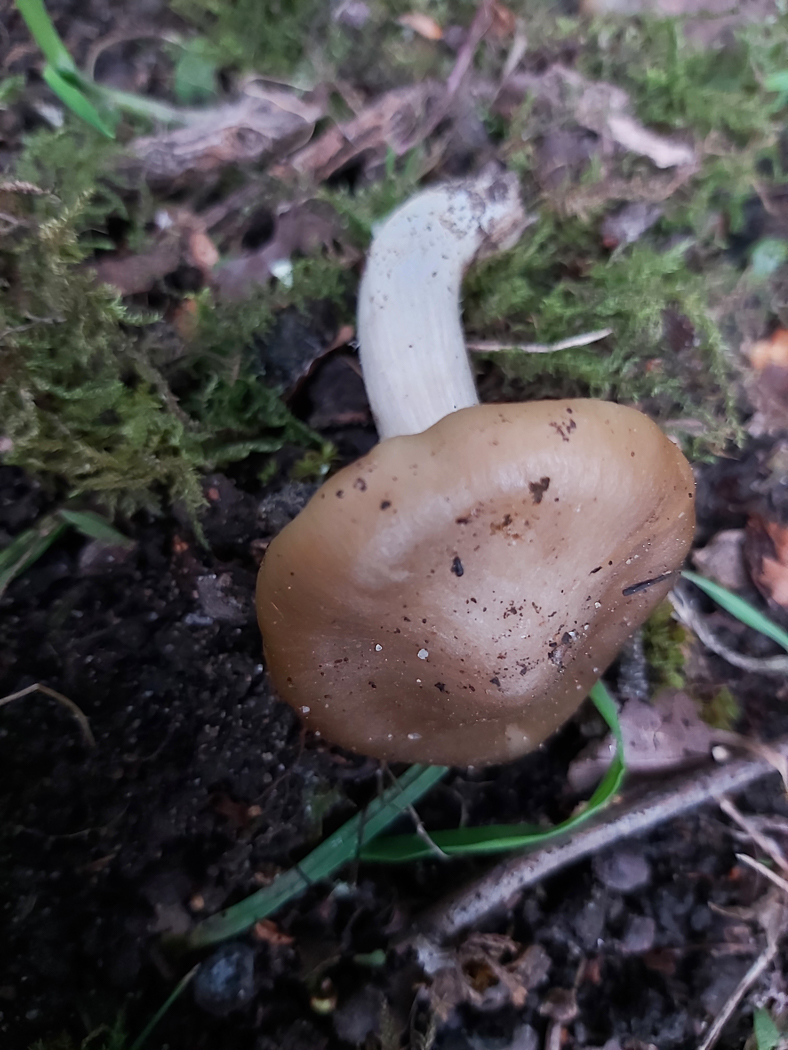
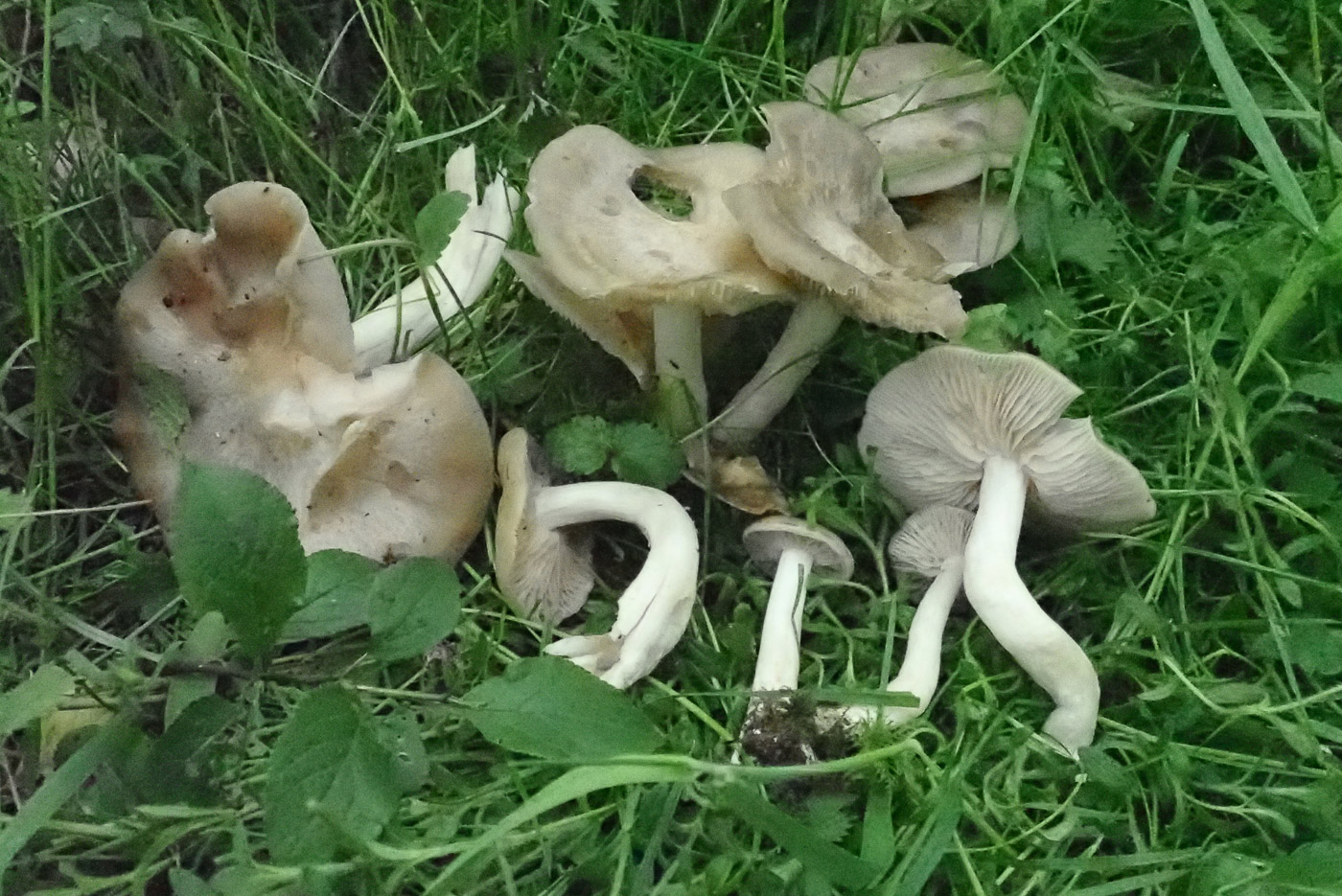 |
May 20th Entoloma clypeatum (Shield Pinkgill) 
Jesper Launder found this Spring fruiting species in soil / Hawthorn scrub whilst walking at Beaconsfield Golf Club. It is one of only a very few Pinkgills to be found at this time which makes it easier to identify, especially as it is alone in fruiting under Rosaceae (to which Hawthorn belongs), often to be found in hedgerows and gardens as well as at woodland edges. Though at first glance it is similar to the genus Pluteus (Shield, and also with pink gills) that species only grows on wood and the gills are free, not adnate (adjoining the top of the stem) as here. We have a handful of sites where it has previously been recorded. Photo 3 shows a large collection made at Stampwell Farm by Penny a few days later.
|
May 19th 2021
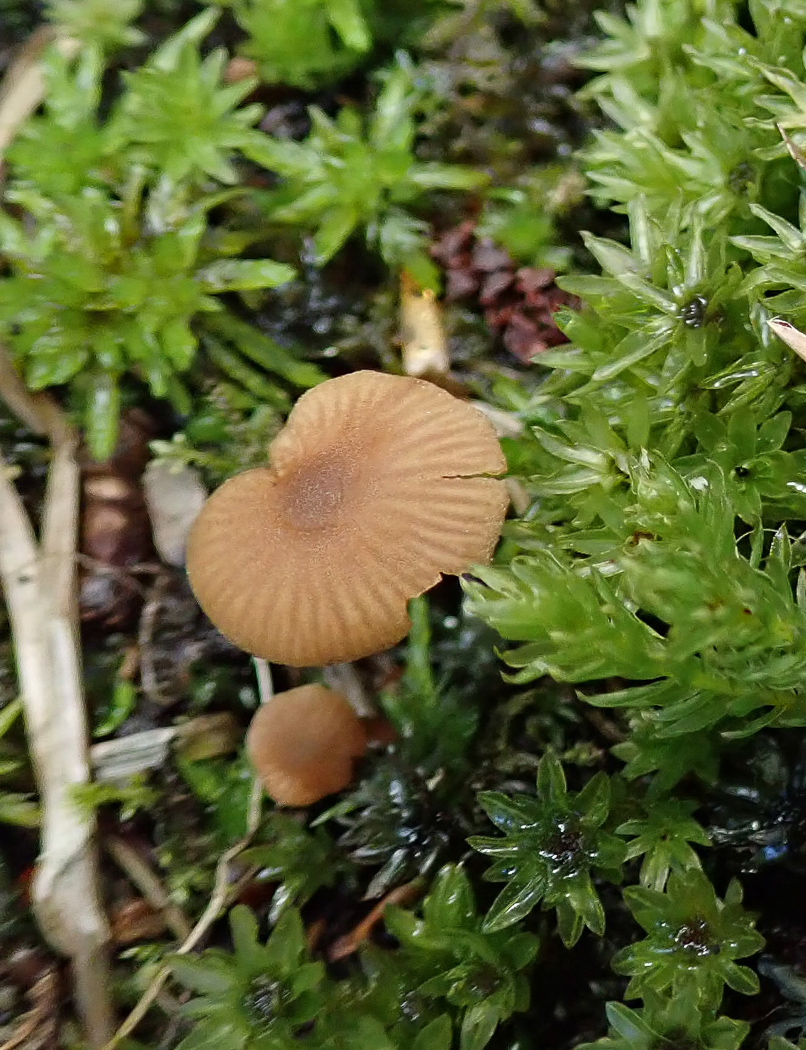 |
May 19th Naucoria scolecina (a species of Aldercap with no common name) 
In the Mire at Burnham Beeches Kerry Robinson found this unusual species in wet soil under Alder, later identified by Derek. The genus is a tricky one to identify, most species having a mycorrhizal relationship with Alder - a few with Willow. They are typical LBJs and very similar at first glance to Galerina and Conocybe as can be seen from Derek's photo. Our database has just two previous records, both from the Beeches 70 years ago made by Derek Reid - Head of Mycology at RBG Kew with a reputation second to none at the time, so Kerry is in good company!
|
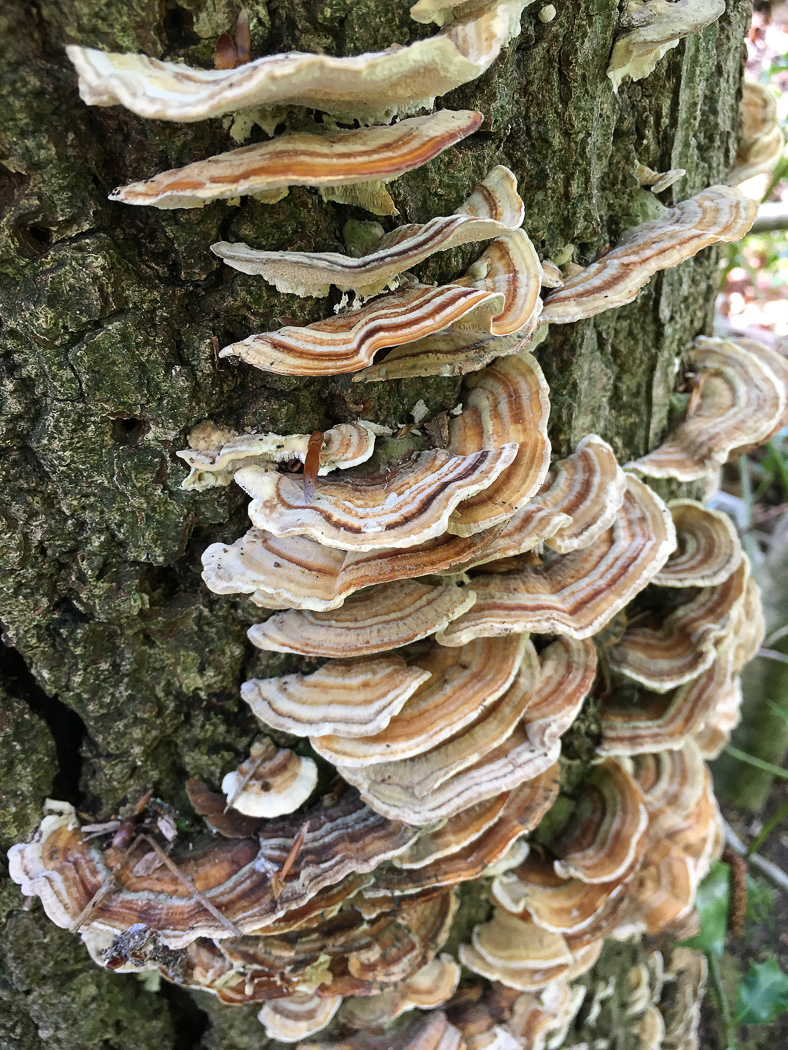 |
May 19th Trametes versicolor (Turkeytail)
Derek Schafer noticed an attractive tiered example of this very common bracket at Burnham Beeches (possibly on standing Oak?). This collection is quite pale compared to most but this is why the species name (versicolor) is so apt. See also Finds 2020 dated Sept 26th.
|
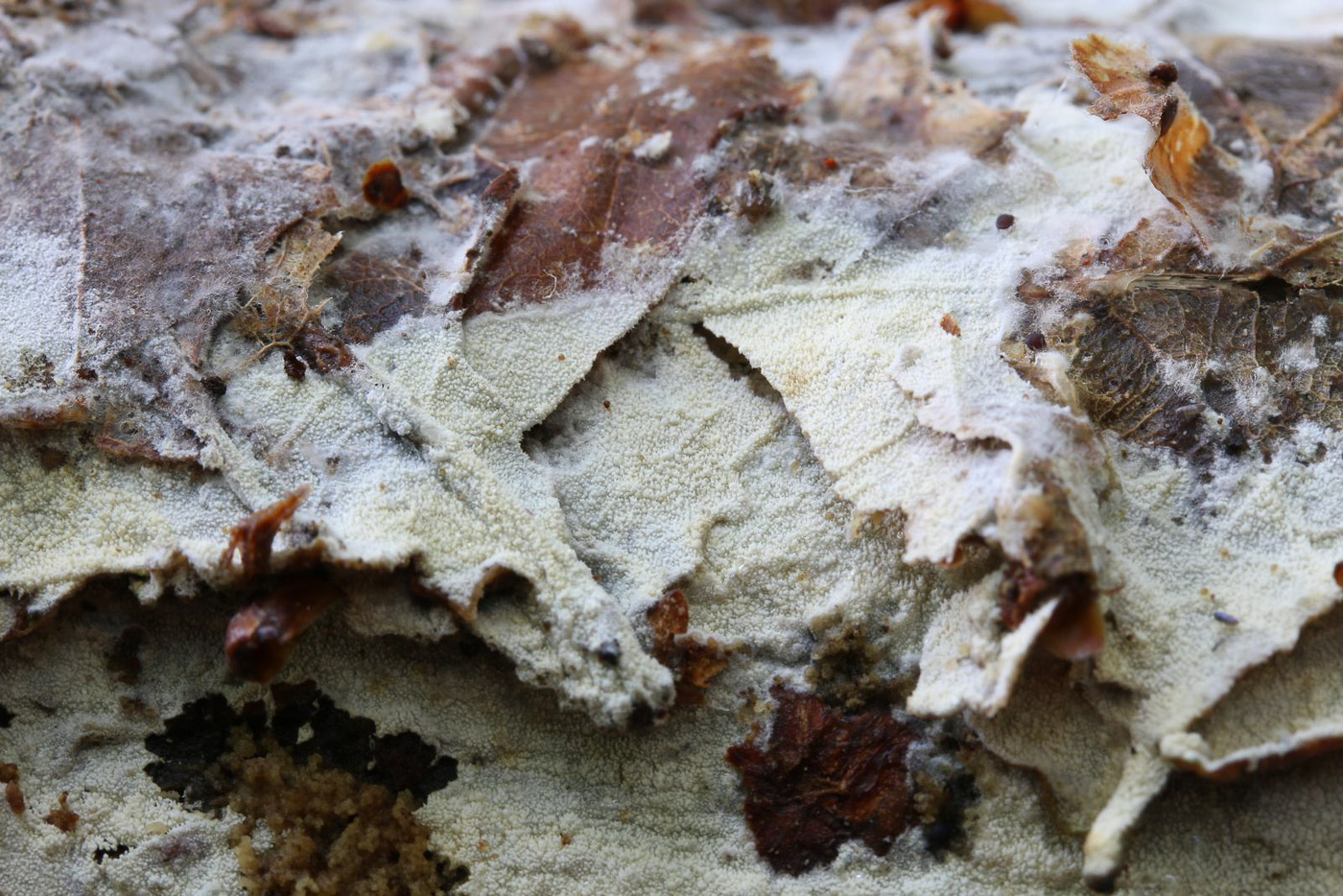 |
May 19th Sistotrema brinkmannii (a Corticioid with no common name) 
Kerry Robinson found this uncommon corticioid on the underside of a rotting deciduous log in Burnham Beeches. It is one which has a soft fragile granular white surface but one needs to check the microscopic features to confirm the identification. it appears to be new not only to the site but also to the county. (Photos Claudi Soler)
|
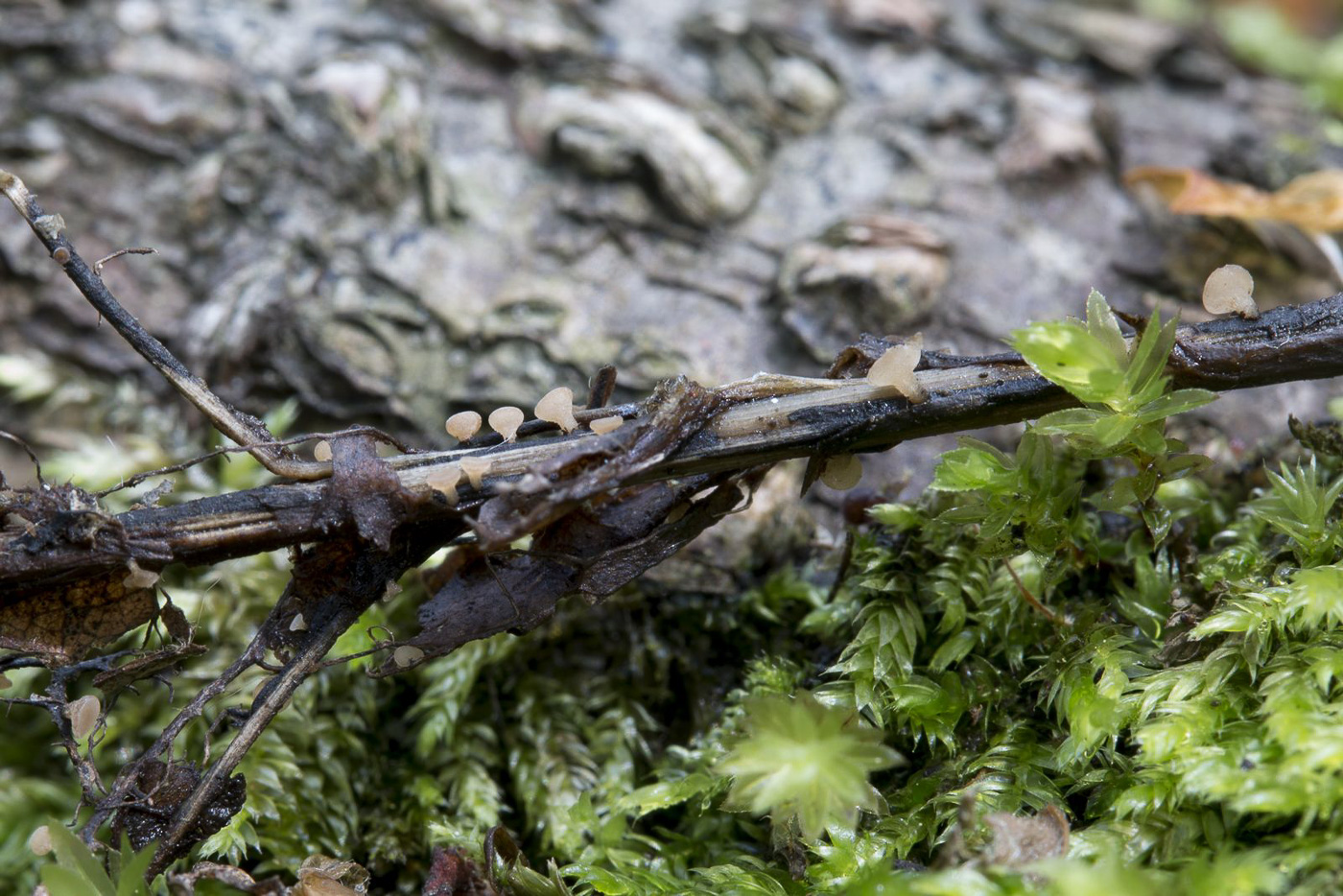 |
May 19th Rutstroemia conformata (an Ascomycete with no common name)
At Burnham Beeches Kerry Robinson found this uncommon tiny stalked cup fungus on the central rib of a rotting Alder leaf. It occurs in late spring / early summer mainly on leaves of Alder, occasionally also of Birch, Poplar or Willow, the cups less than 5mm across but sometimes with relatively long stems. A species not often noticed and recorded, yet again this is new to the site and to the county. (Photo Claudi Soler)
|
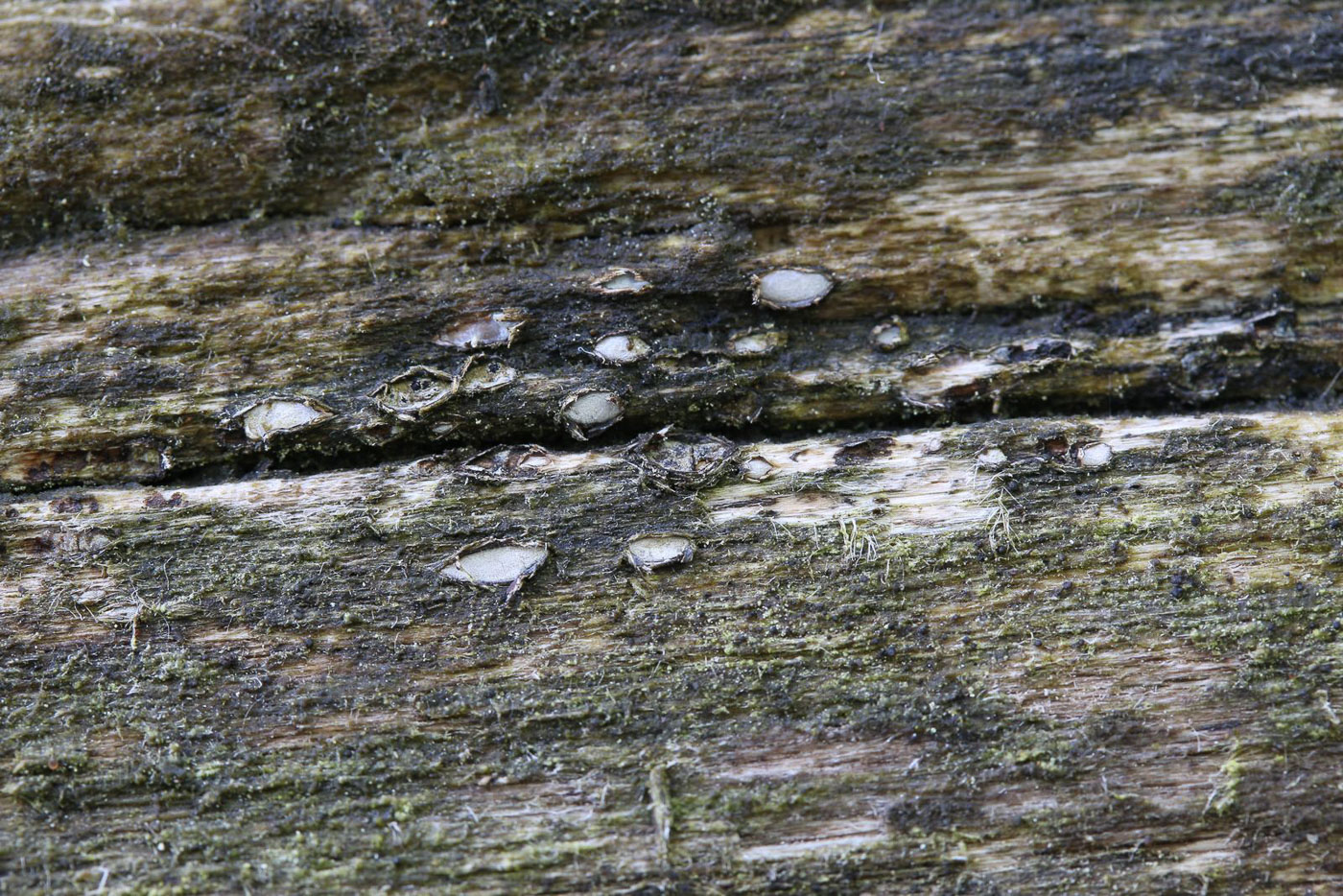 |
May 19th Propolis farinosa (an Ascomycete with no common name)
At Burnham Beeches Kerry Robinson found this tiny species - each less than 1cm across - on rotting damp bare deciduous wood typically emerging through the surface with flakes of the substrate attached at the margin. Though not uncommon this is new to the site and to the county (yet more proof of the lack of Asco specialists recording in Bucks!) (Photo Claudi Soler)
|
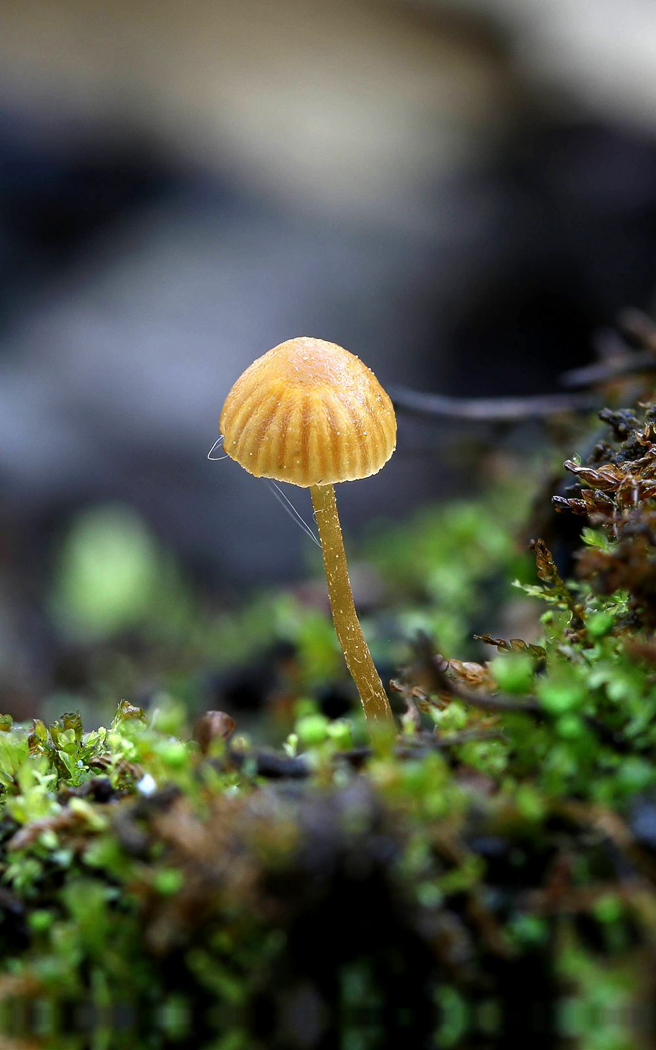 |
May 19th Galerina hypnorum (Moss Bell) 
At Burnham Beeches Kerry Robinson found and named this small mushroom growing on a damp mossy bank in the Mire (later confirmed by Derek at home). A sizeable genus of LBJs, Galerina always needs checking with a scope as many species are similarly bell-shaped, pale orange fawn and often slightly fluted with almost transparent thin fleshed caps - also easily confused in the field with Conocybe or even Tubaria. Today's species is one of the commonest and tends to associate with moss either on wood or soil. (Photo Claudi Soler)
|
 barba-jovis Burnham Beeches 19.05.2021 CVS 1.jpg)
 barba-jovis Burnham Beeches 19.05.2021 CVS 2.jpg)
 barba-jovis Burnham Beeches 19.05.2021 DJS 1.jpg) |
May 19th Hyphodontia (= Kneiffiella) barba-jovis (a corticioid with no common name) 
At Burnham Beeches Claudi Soler found this species on a fallen Birch log, identified in the field by expert Kerry Robinson and later confirmed separately by Derek and Claudi. It can be found on several different deciduous and coniferous woods and the toothed surface is distinctive, the tips of each tooth being 'fringed' / brushlike (see photo 2 - Claudi and photo 3 - Derek). Other features to note in the field are the soft texture and creamy centre with paler less toothed margin. Though apparently not rare, we have no previous site or county records, so this was a nice find.
|
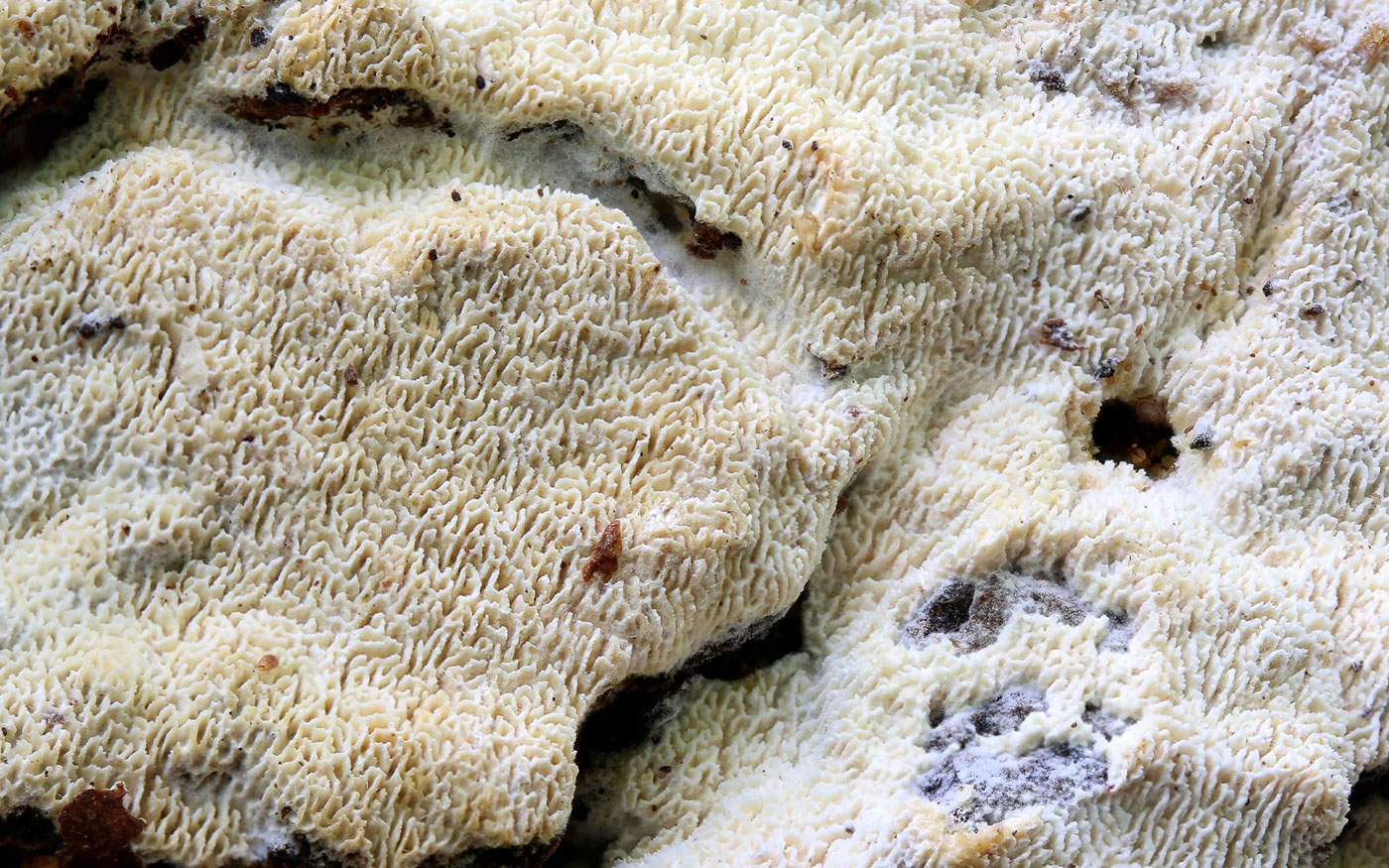 |
May 19th Schizopora paradoxa (Split Porecrust)
At Burnham Beeches Claudi Soler together with Derek Schafer and Kerry Robinson found this quite common resupinate fungus on fallen Oak though it occurs on the wood of many other deciduous trees. Features to look for to identify it are the obvious irregularly poroid surface which bruises brownish when touched (if fresh) - this can just be seen in the centre of this specimen, and its tendency to form a 'semi-bracket' - also seen here. Furthermore it notably peels away easily from the substrate.
|
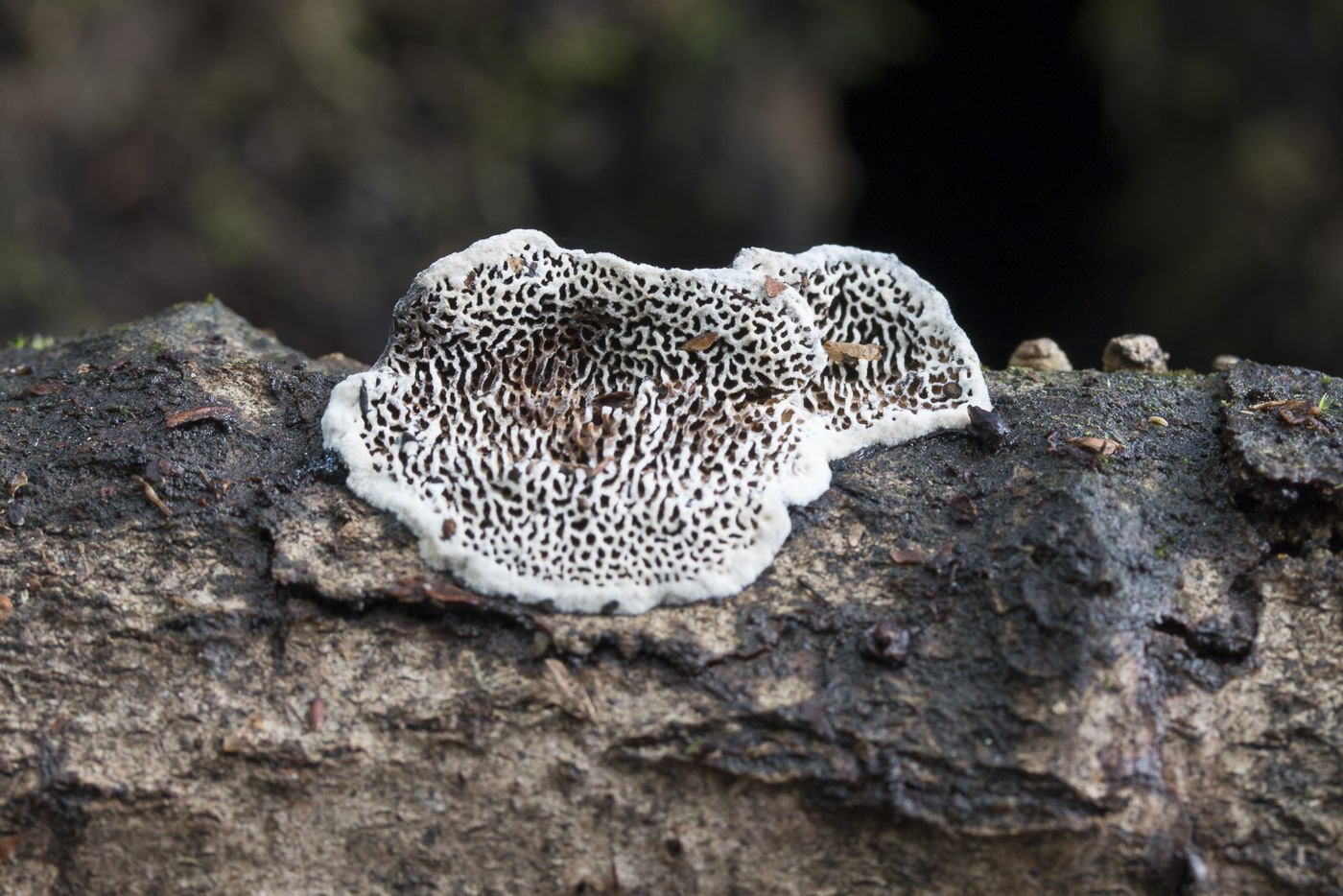 |
May 19th Datronia mollis (Common Mazegill) 
At Burnham Beeches Claudi Soler found this very common species on fallen Oak. It is often to be seen covering large expanses of smallish dead deciduous branches and this photo shows its typical labyrinthine poroid creamy surface well, though at earlier stages of development it is easily confused with the many other creamy white corticioid fungi.
|
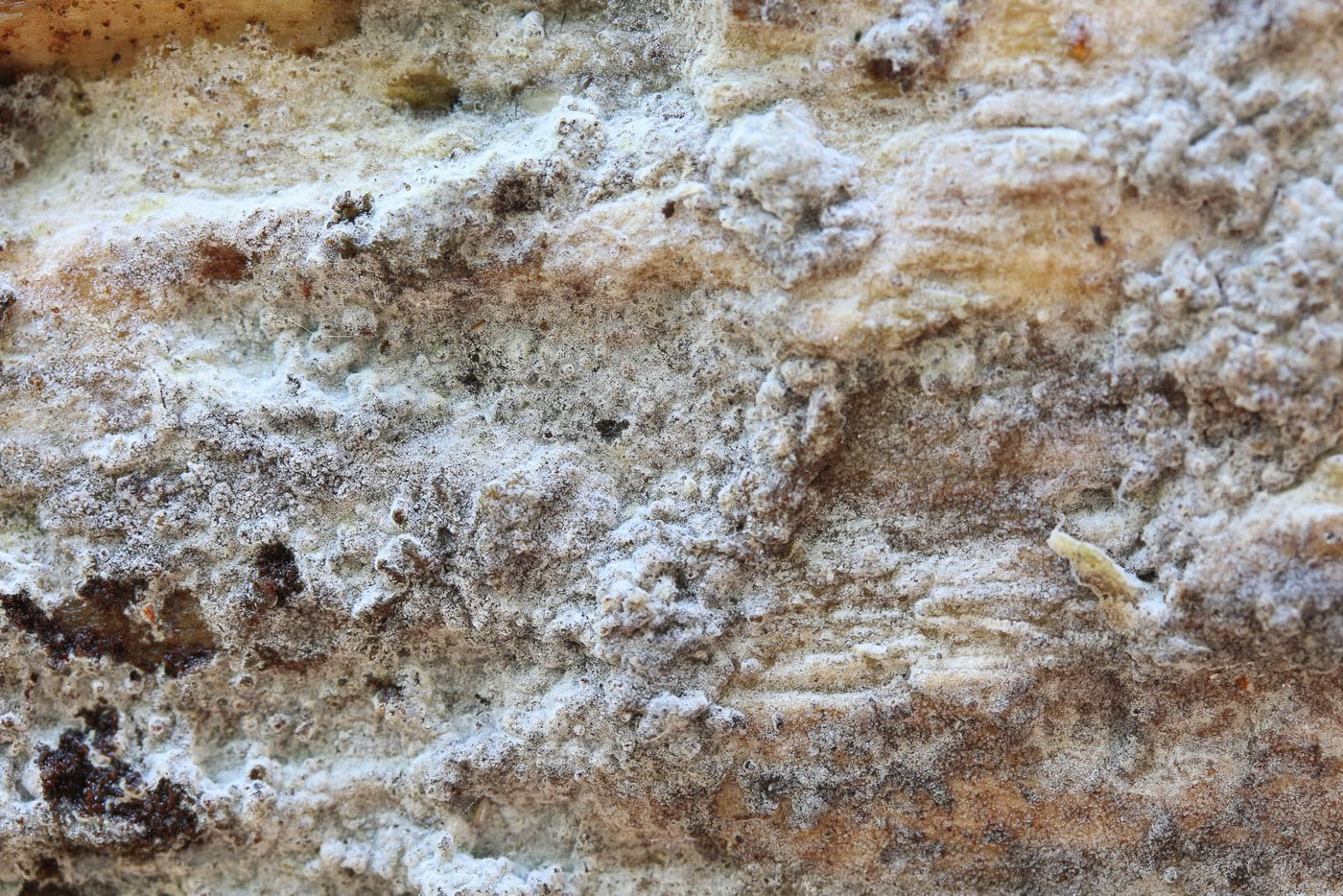 |
May 19th Botryobasidium conspersum (a corticioid with no common name) 
At Burnham Beeches Claudi Soler found this species on the underside of a deciduous log. An uncommon species, this is appears to be a first for the site with just one other county record. The genus Botryobasidium is characterised by having somewhat thin loosely cobwebby interwoven texture, usually dirty whitish but often with a yellowish 'conidial' stage. Today's species favours decorticated deciduous wood and can sometimes form large expanses.
|
May 18th 2021
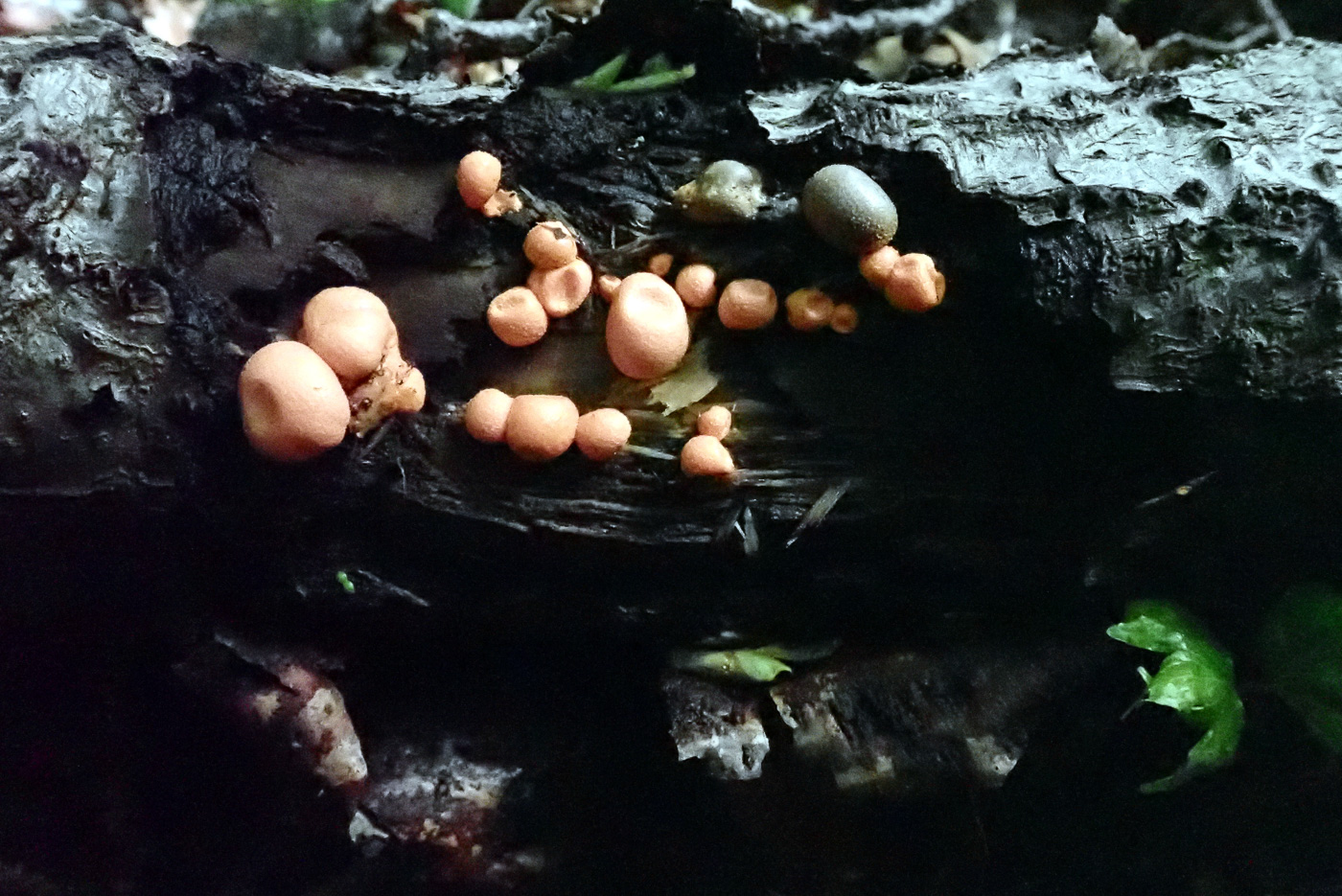
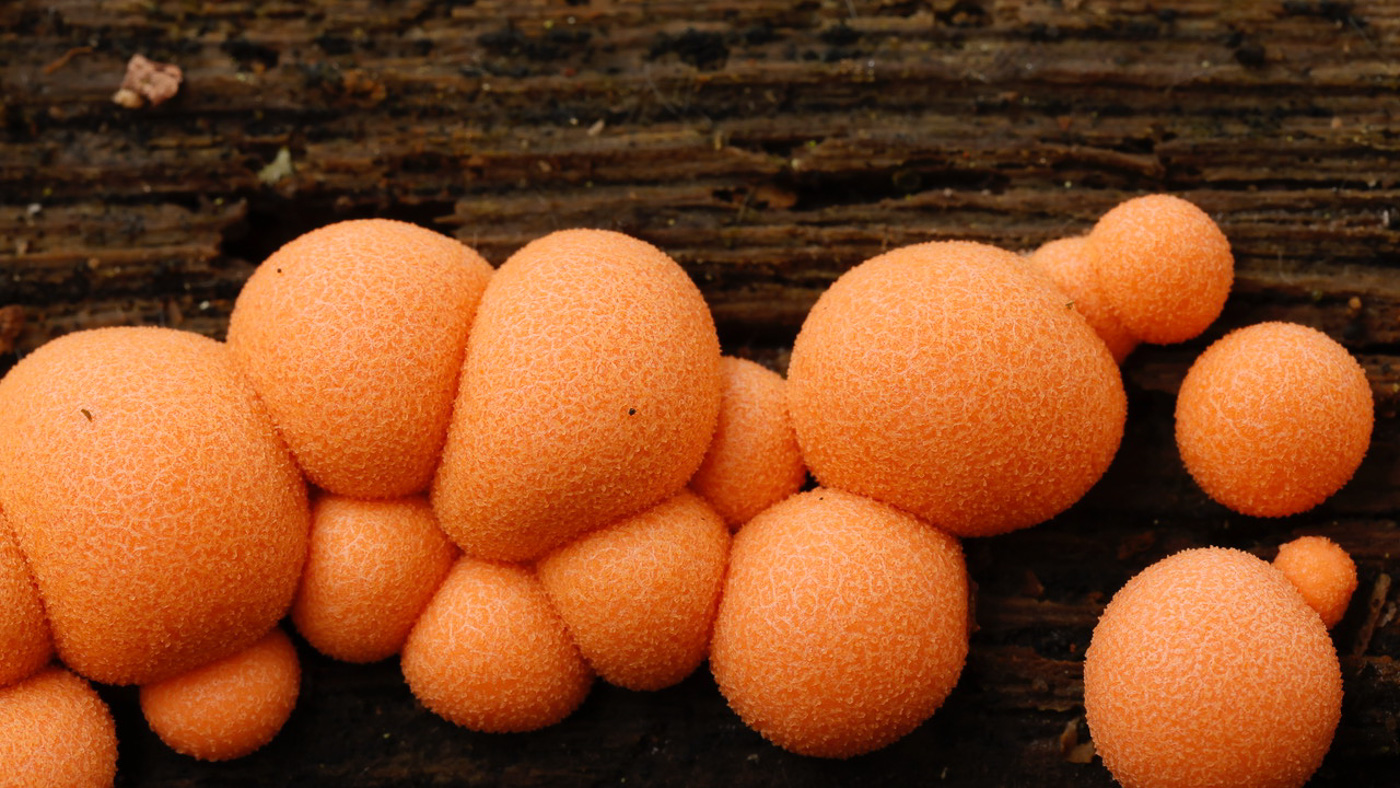
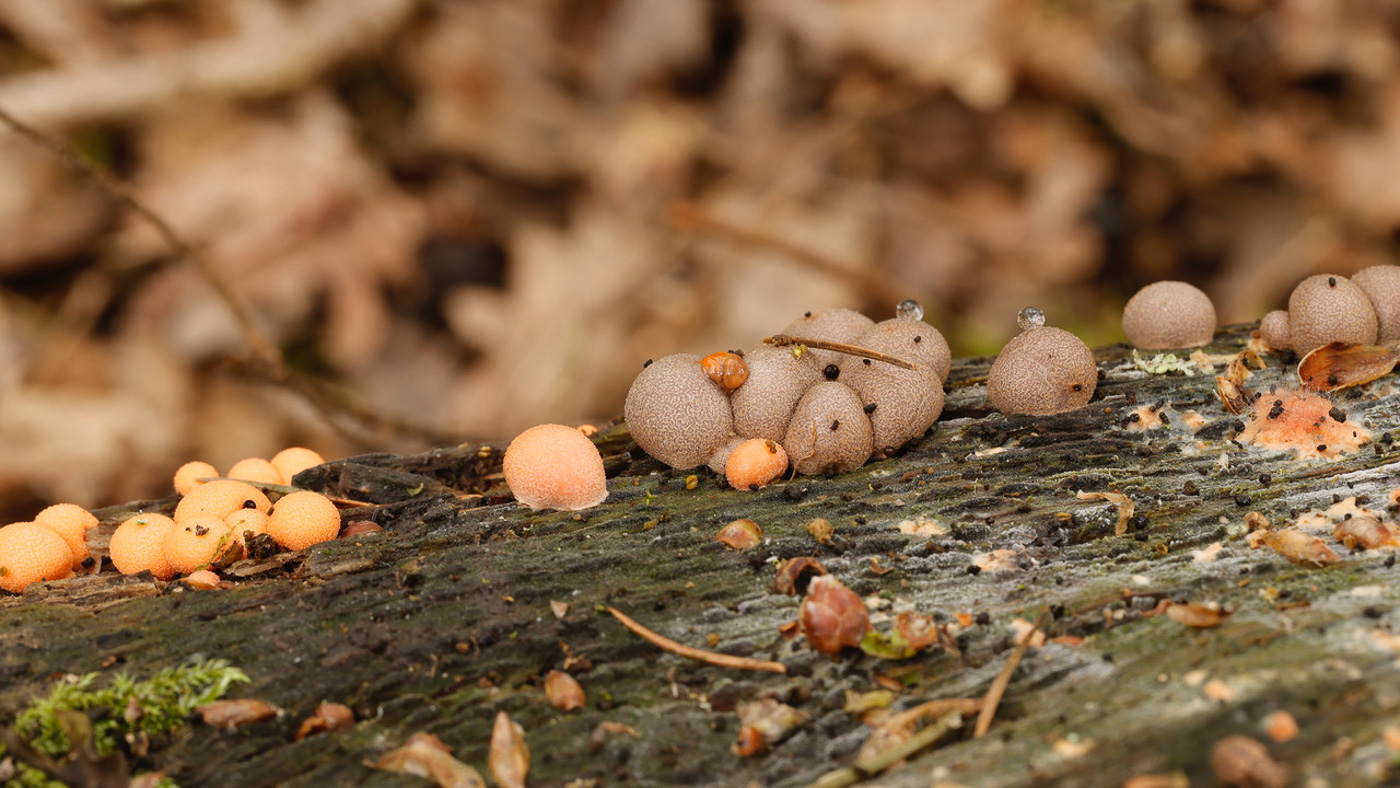 |
May 18th Lycogala terrestre (Wolf's Milk)
Penny noticed these brightly coloured blobs on fallen Beech at Turville Heath. In fact this is not a fungus but a Slime Mould and when the peachy blobs are touched this becomes obvious! This is the slimy 'Plasmodium' stage. Note in the photo the two mature greyish pale brown blobs at the top: these have developed a firm dry covering and are full of the mature spores which are dispersed as the covering disintegrates. The Genus name refers to its similarity to a small Lycoperdon (Puffball) when mature. Photos 2 and 3, taken by Paul Goby 10 days later in Naphill Common, show a nice close-up view followed by some specimens just beginning to dry off.
|
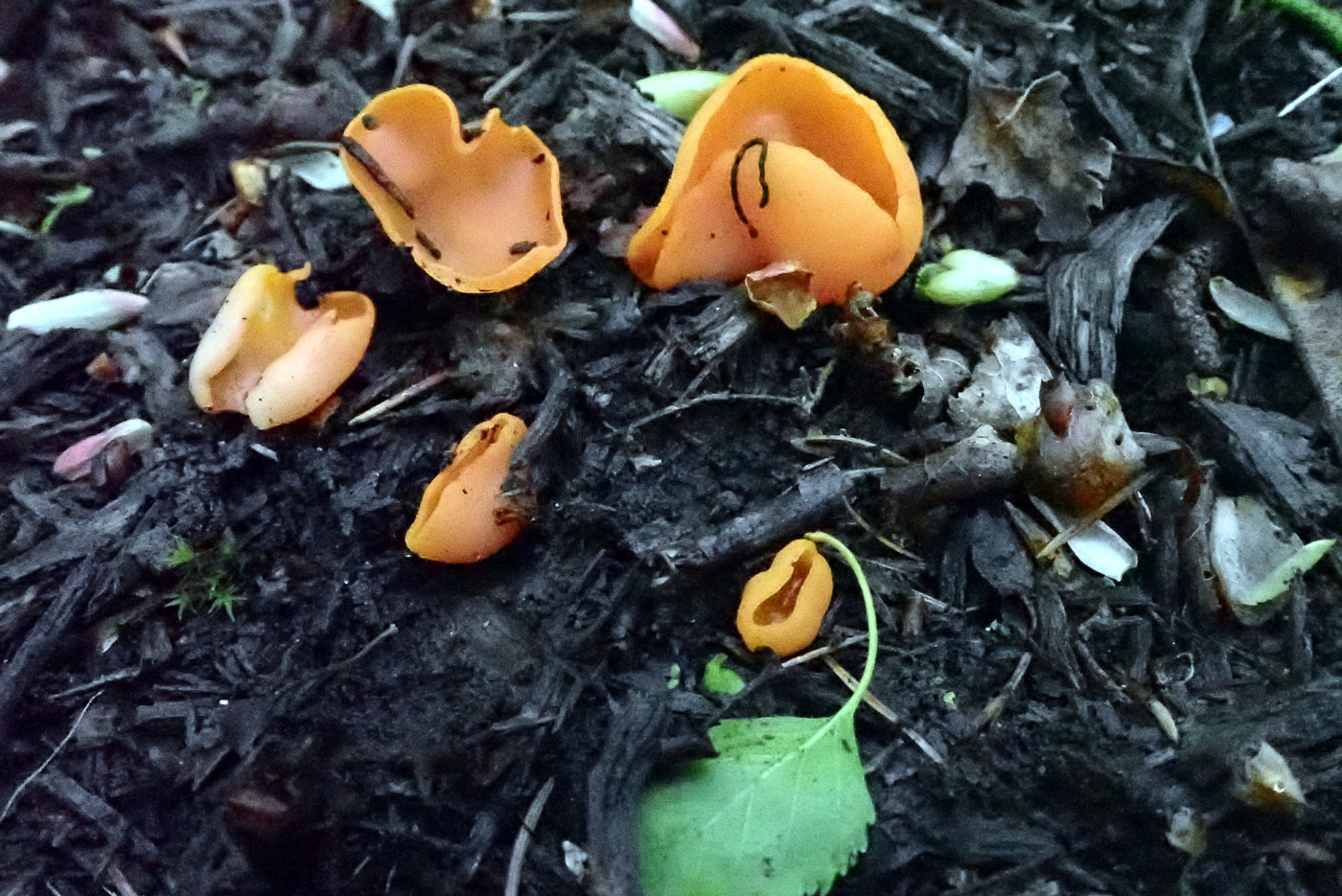 |
May 18th Aleuria aurantia (Orange Peel Fungus)
Penny found these beautiful cups just emerging in a rotting woodchip pile at Turville Heath. A common species in late summer and autumn, out of our 50 odd county records this is a first for this time of year. It favours disturbed ground and these brightly coloured cups can get to around 10 cms across, usually fruiting in clusters. So if you see one (and have established that it isn't someone's discarded orange peel!) its worth looking around for more.
|
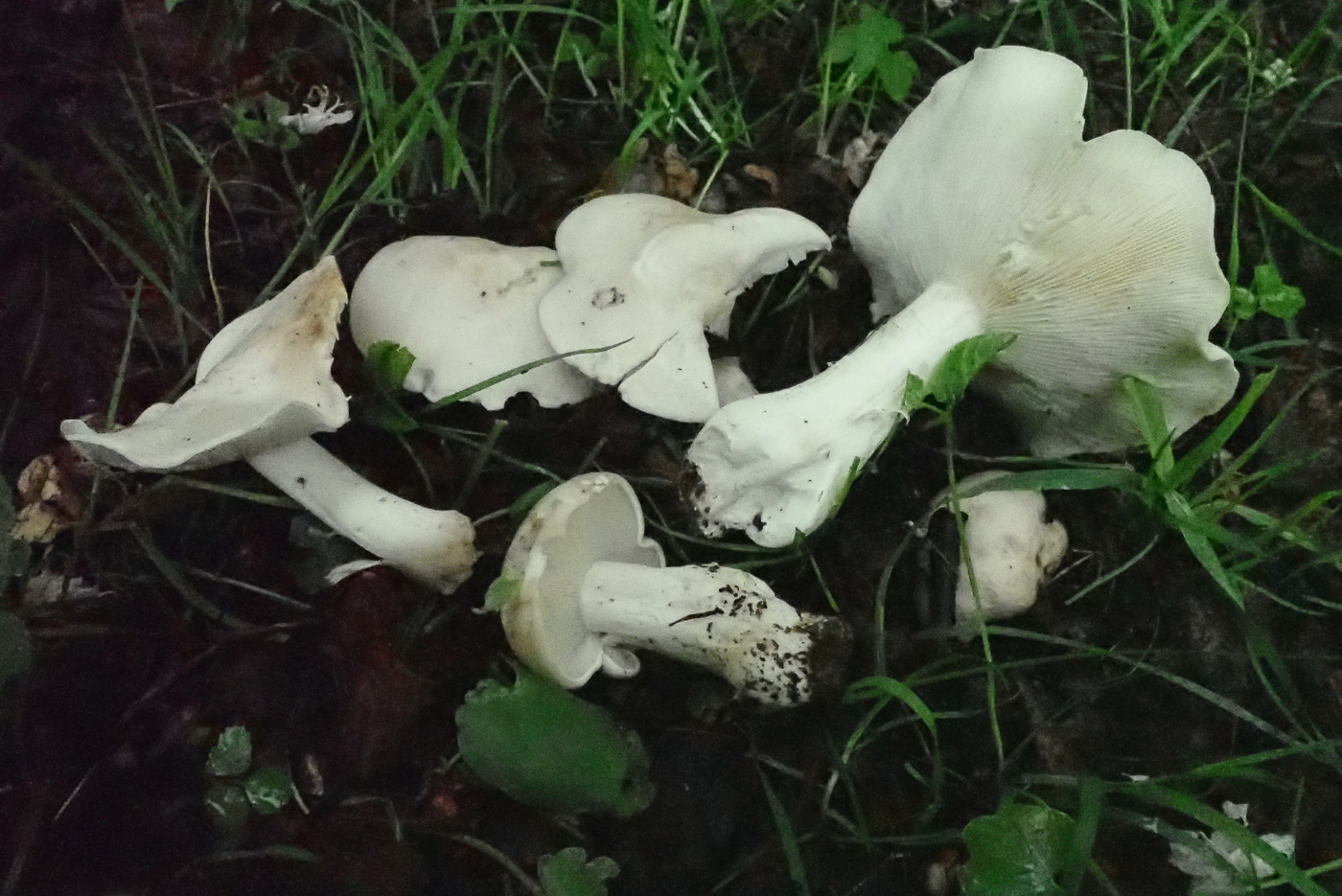 |
May 18th Calocybe gambosa (St. George's Mushroom)
At last! Where has this common springtime species been hiding recently? It usually appears very promptly on or just before St. George's Day (which was nearly a month ago now) but Penny had not received any sitings till she found this large clump in grassy soil under Lime at Turville Heath today. This is an easy mushroom to recognise because there's nothing else similar likely to fruit at this time: It looks like one of the several large white autumn Tricholoma species (and in fact resided in Tricholoma at one time) but unlike those species has a very pronounced 'meally' smell. Considered a good edible by some, it should be eaten with caution and can cause heart palpitations so probably best avoided.
|
May 14th 2021
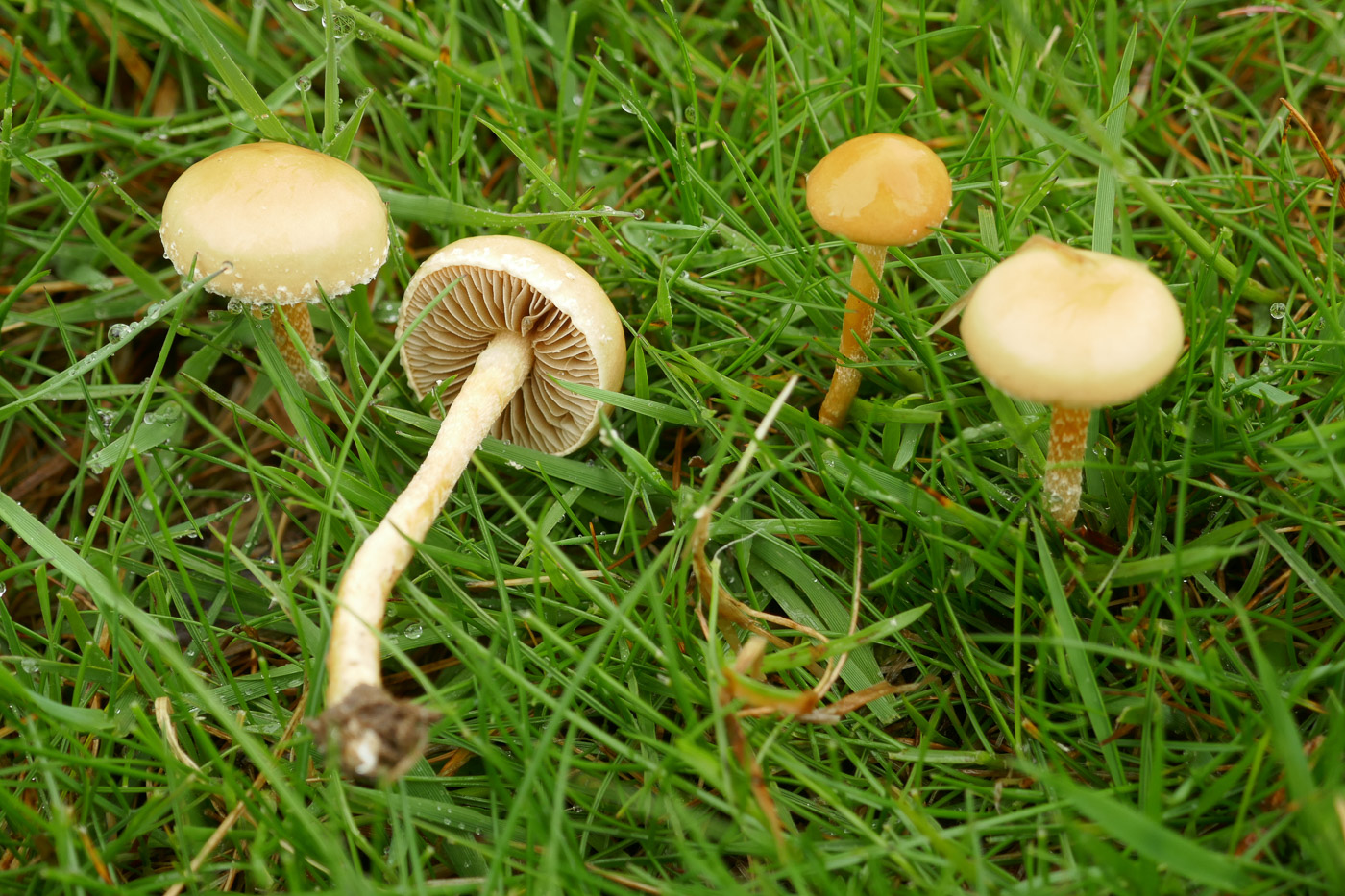 |
May 14th Agrocybe pediades (Common Fieldcap)
At Stampwell Farm near Chalfont St Peter Jackie Ewan found these small mushrooms growing in well manured soil in grazed pasture. The genus tends to fruit in spring or summer and has about 10 species known in Britain. A. pediades is in fact a complex of species and is likely to be split up further as further sequencing is undertaken. We have very few records for the county.
|
May 13th 2021
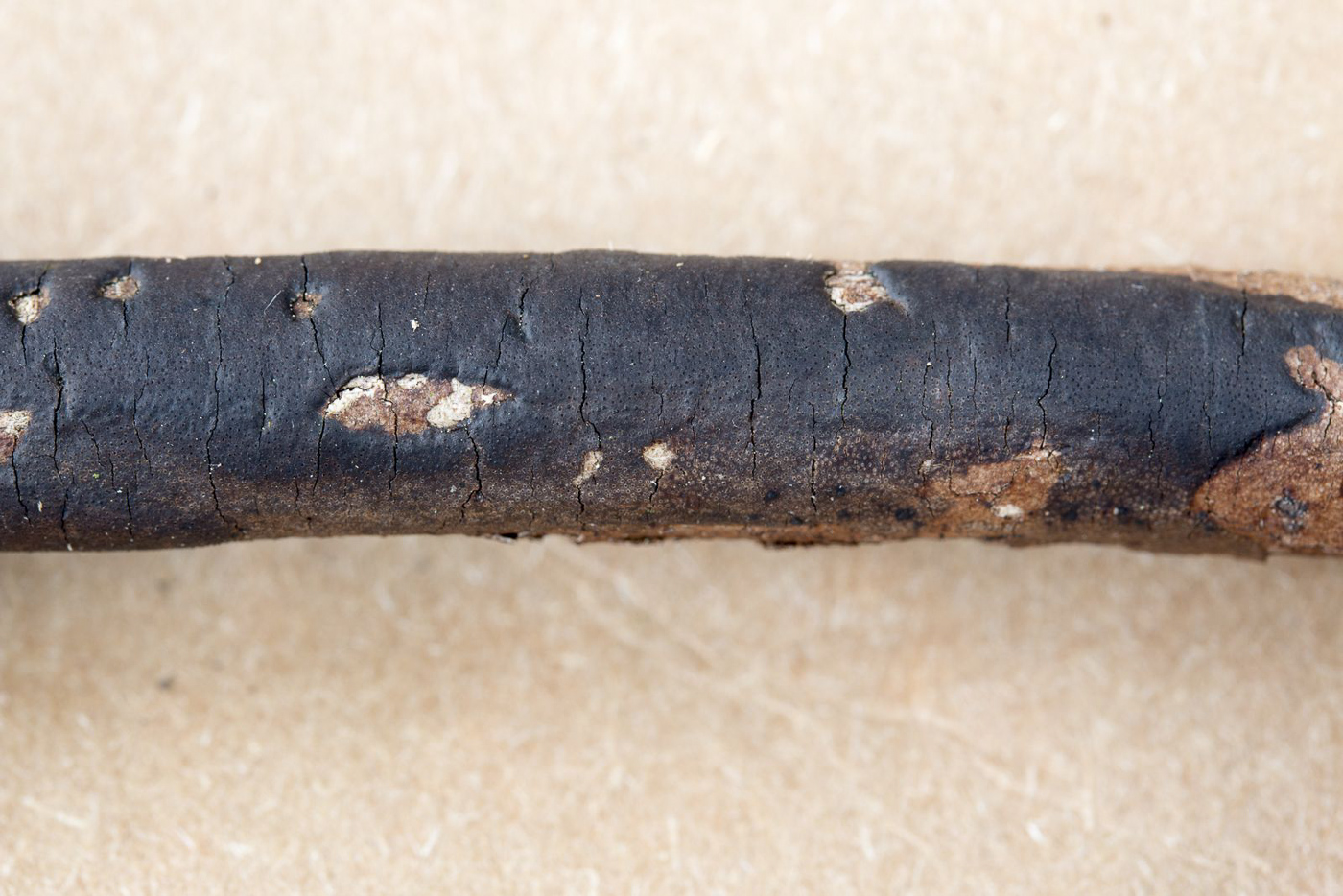 |
May 13th Diatrype stigma (Common Tarcrust)
Claudi Soler found this common crusty ascomycete on a Beech log at Dancersend. It often forms large sheets on fallen Beech still with bark, and a closer look reveals the tiny ostioles - slightly raised holes - which cover the surface and through which the spores are expelled.
|
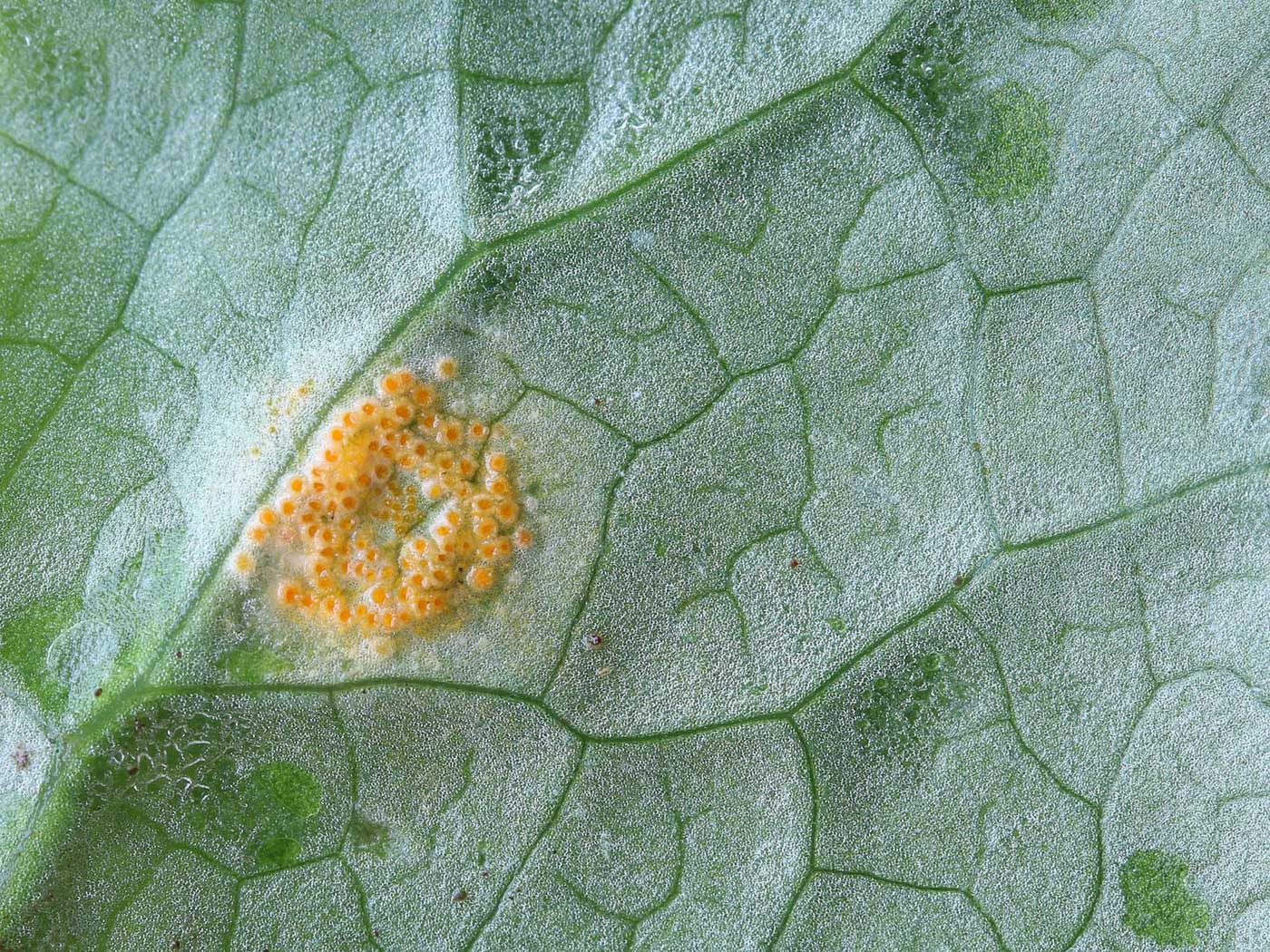 |
May 13th Puccinia sessilis (Arum Rust) 
Claudi Soler noticed some small rusty patches on the leaves of Arum maculatum (Lords and Ladies) at Dancersend and took some home to identify. Puccinia is a genus of Rusts forming part of the Basidiomycetes and with an enormous number of species, many of which can be identified purely by recognising the host plant. Care must be taken, however, because some species can occur on several different plants, also some plants can have several different species!
|
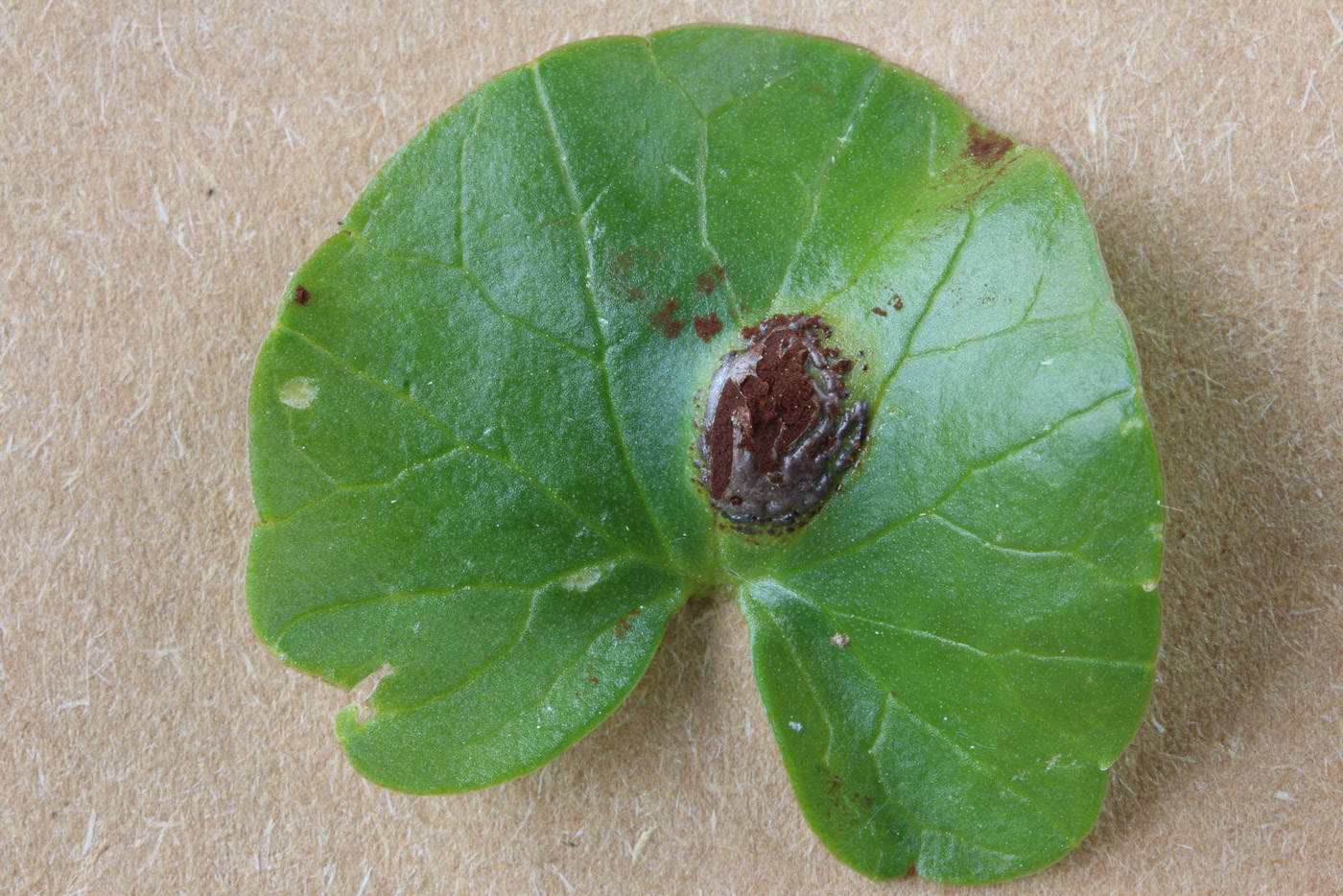
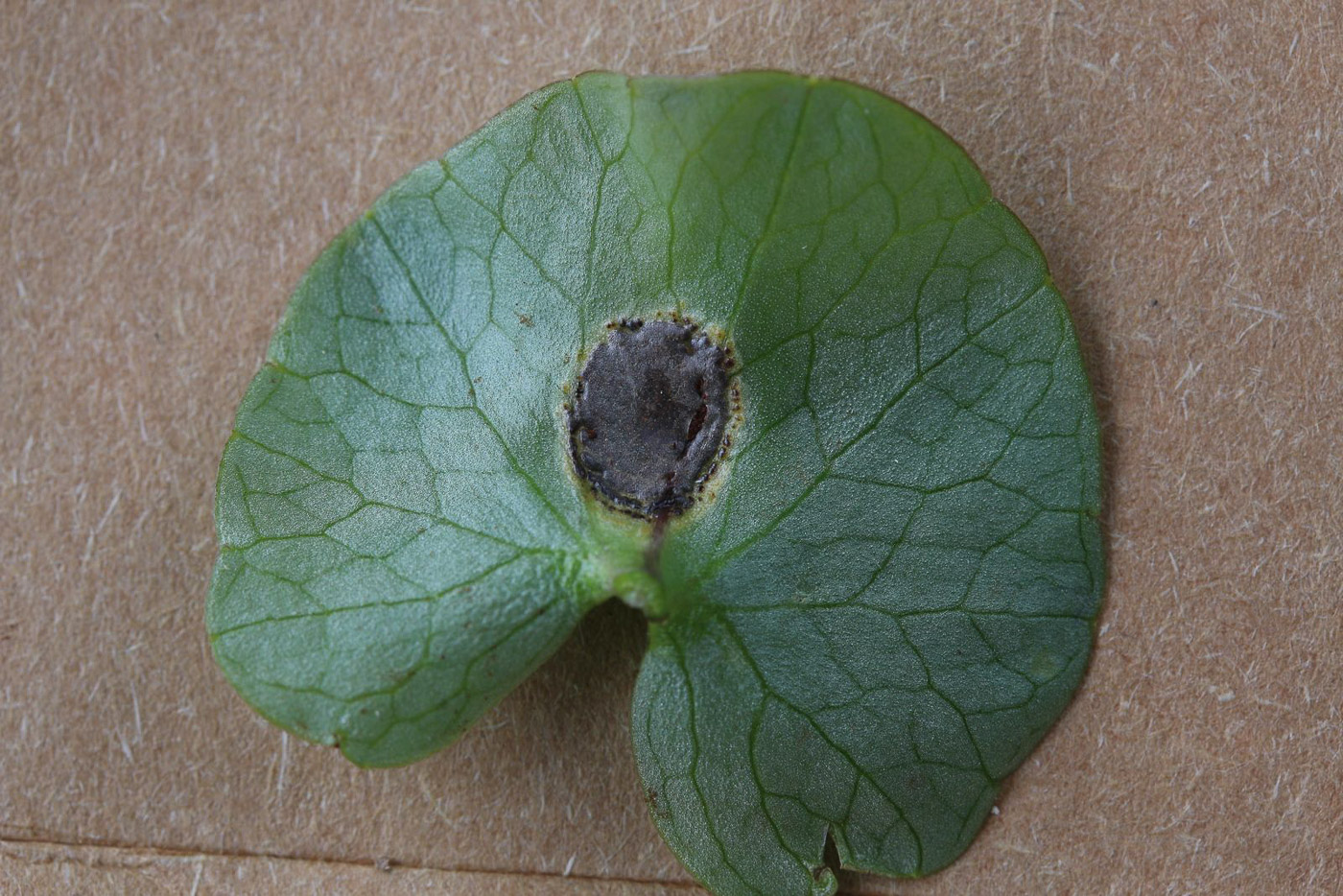 |
May 13th Uromyces ficariae (Bitter Chocolate Rust) 
Claudi Soler noticed these dark patches on living leaves of Ranunculus ficaria (Lesser Celandine) at Dancersend. This is a relatively common Ascomycete species and is host specific to this plant, occurring in Spring.
|
May 12th 2021
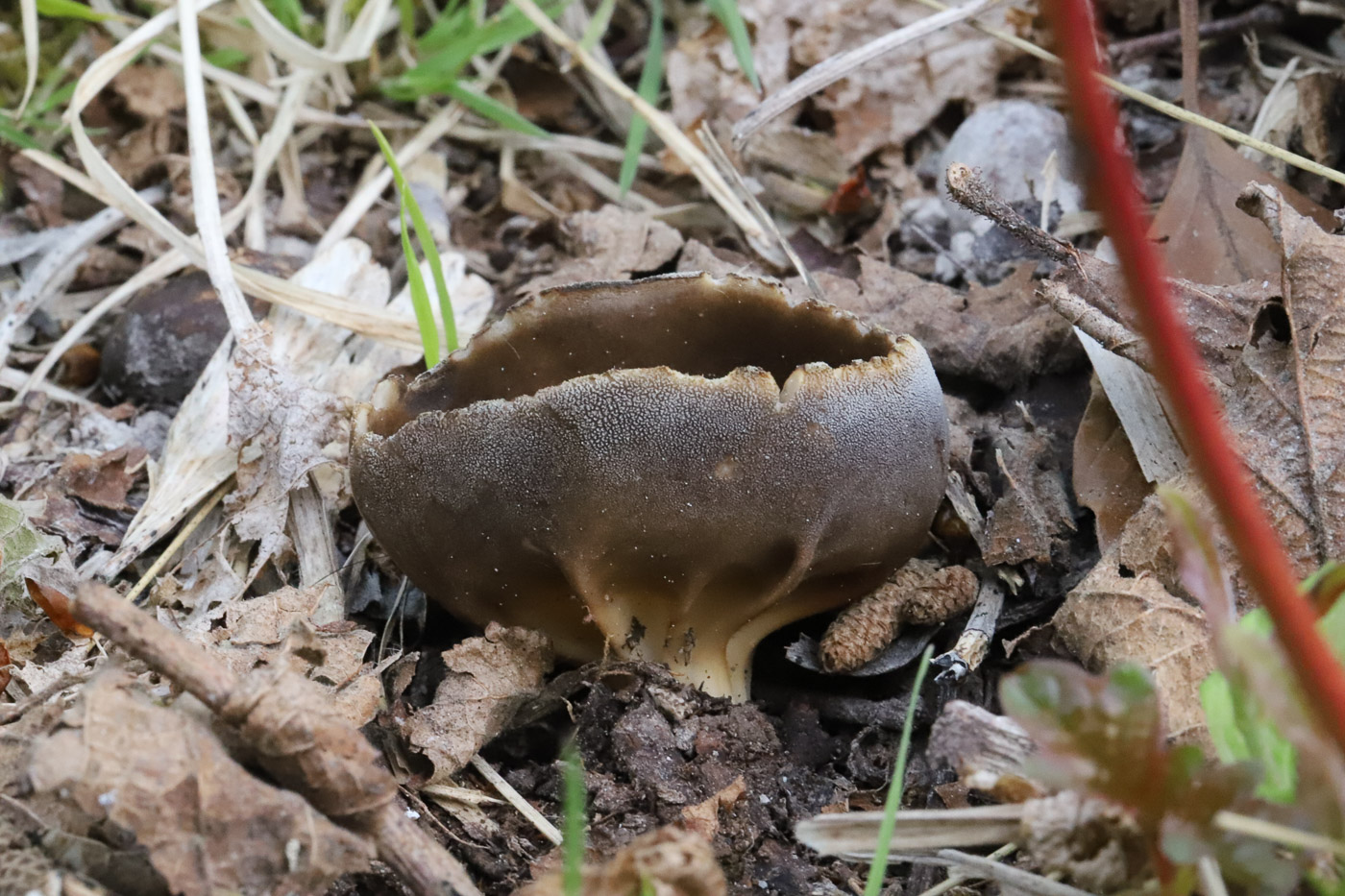 |
May 12th Helvella acetabulum (Vinegar Cup)
At Ragpits Reserve Phil Townsend found this springtime ascomycete at the edge of the meadow under Hazel. This is considered an occasional species and is quite a large cup, up to 5cms across or so, possibly looking more like a Peziza than a Helvella but differing considerably from Peziza under a scope. The distinct whitish stem is a salient feature to look for, as are the ribs / veins which form on the outside of the cup.
|
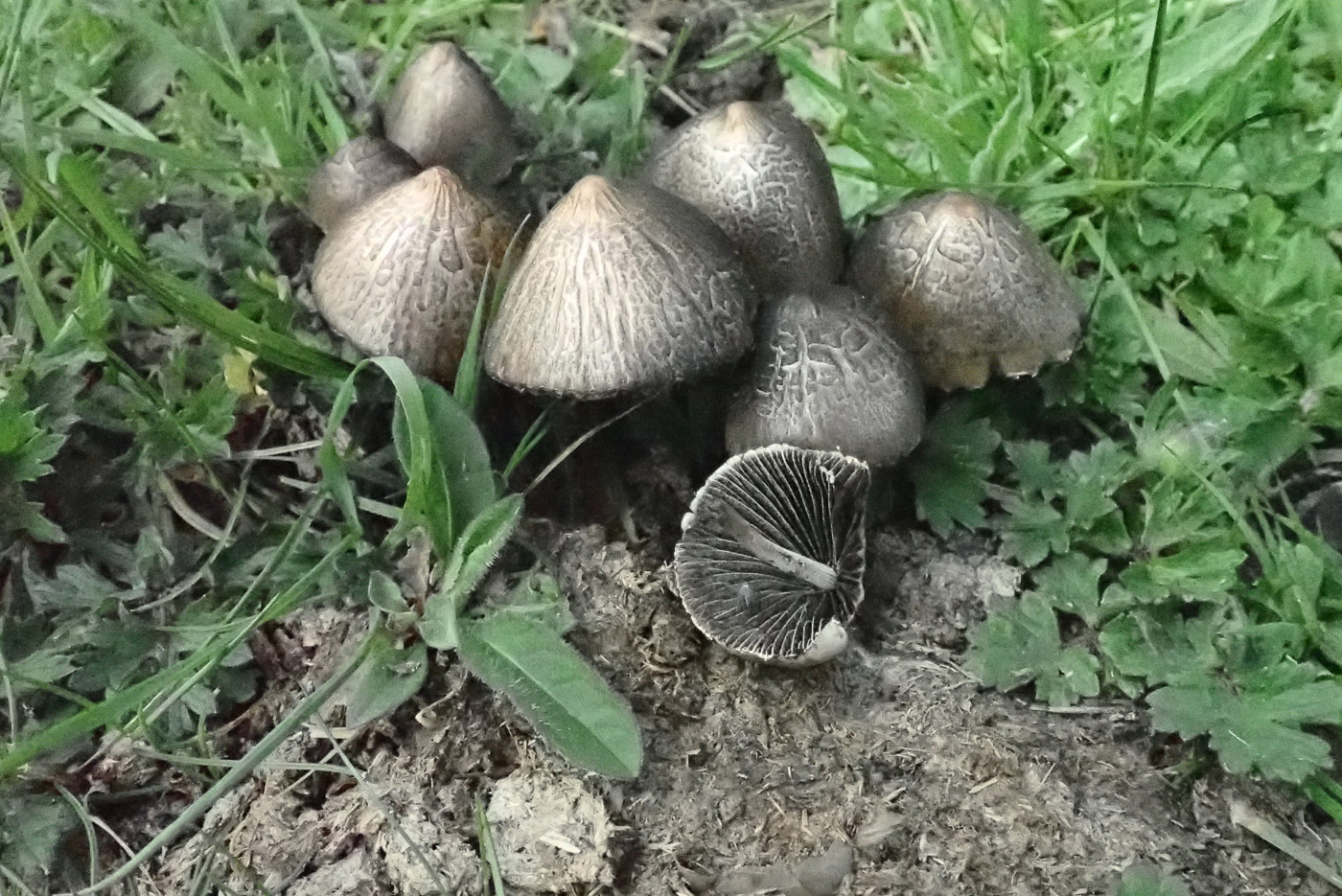 |
May 12th Panaeolus olivaceus (a Mottlegill with no common name) 
Whilst walking in Bernwood Meadows Penny came across this clump of rather desiccated mushrooms in a dried up cowpat. The genus was clearly Panaeolus, having the typically dark and mottled gills, but a scope and a detailed key were needed to decide upon the species. Amongst other things the spore shape and size together with the substrate soon settled the name: a unusual species which occurs in grassland where animals have been present, either on dung or well manured soil.
|
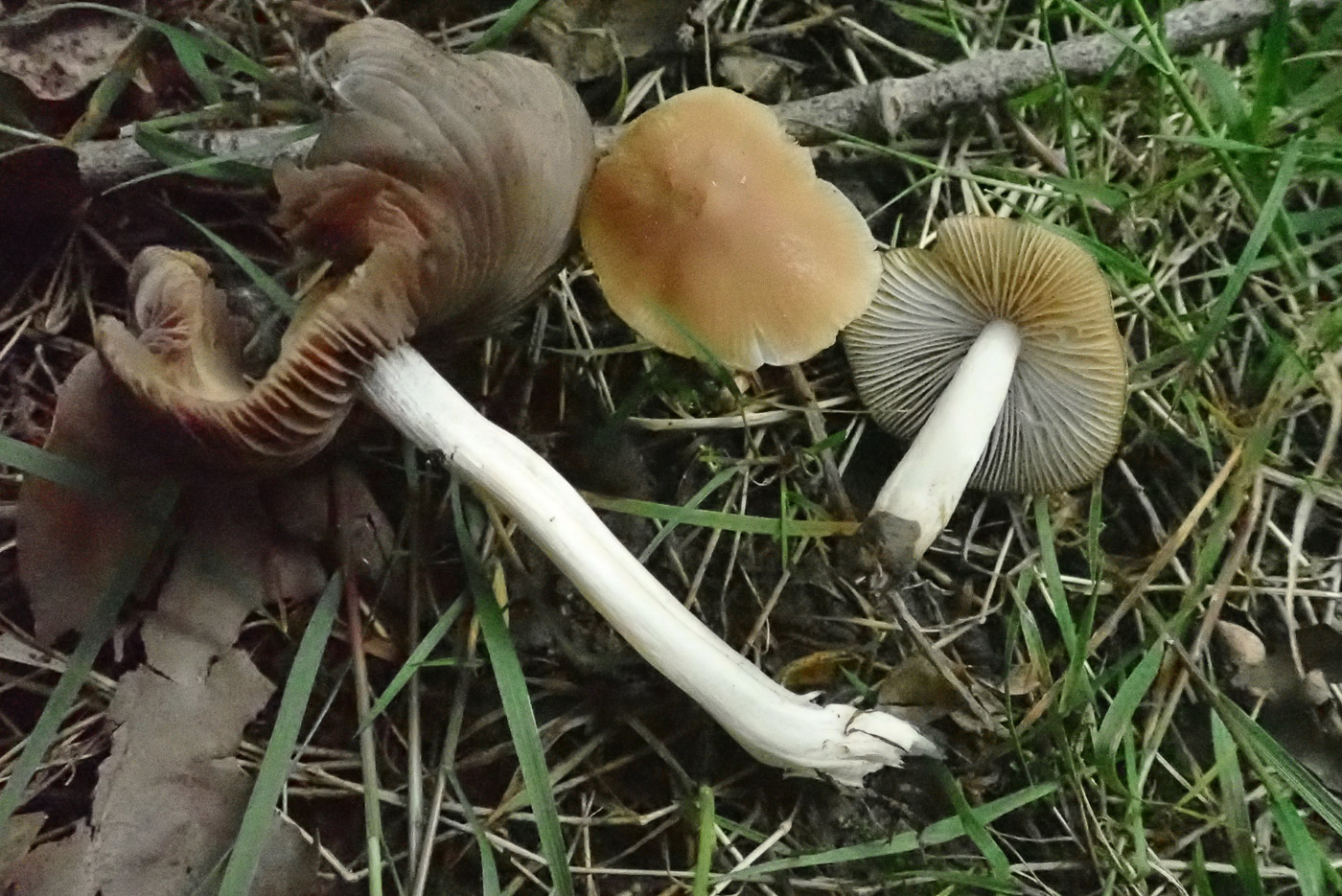 |
May 12th Psathyrella spadiceogrisea (Spring Brittlestem) 
In Bernwood Forest along a muddy path Penny found this nice collection of fresh fruiting bodies. At the time she leant towards the genus Agrocybe (often found fruiting in early summer) but was unsure. At home a scope revealed the dark red brown spores (too dark for Agrocybe despite the misleadingly pale almost white immature specimen). She then remembered this particular Psathyrella which fruits now, and sure enough all the features fitted. It's not rare and the recent much needed rain had clearly triggered its appearance.
|
May 10th 2021
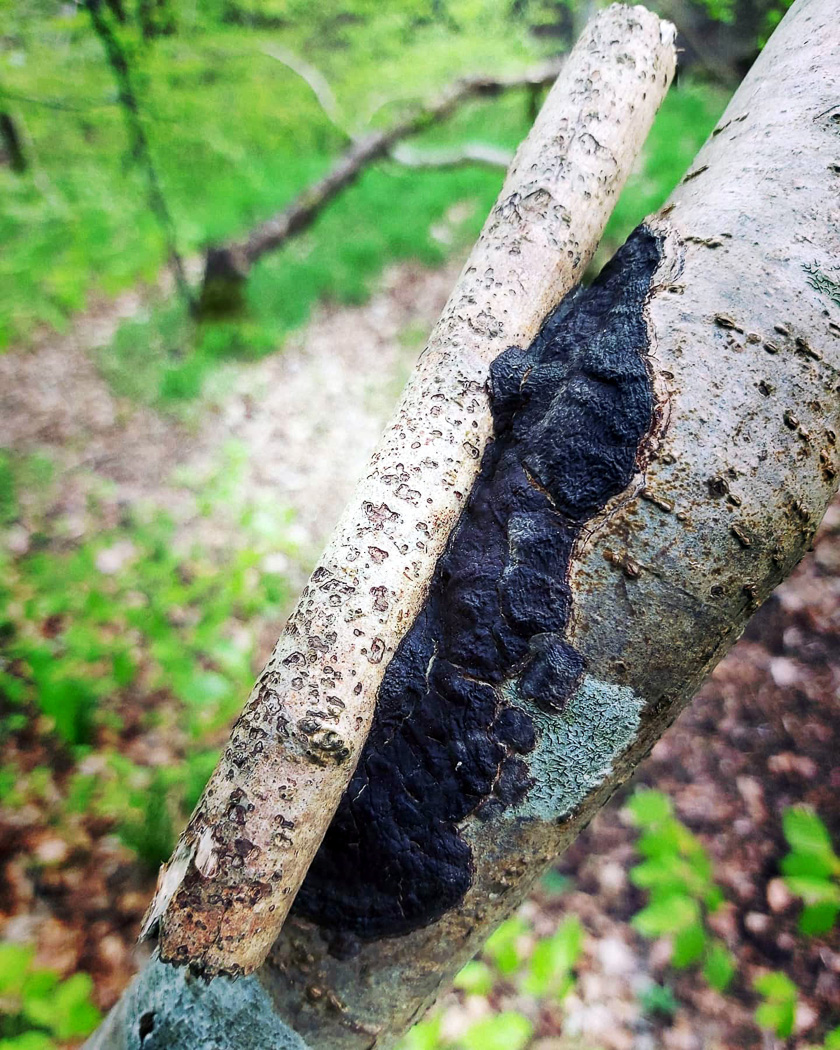
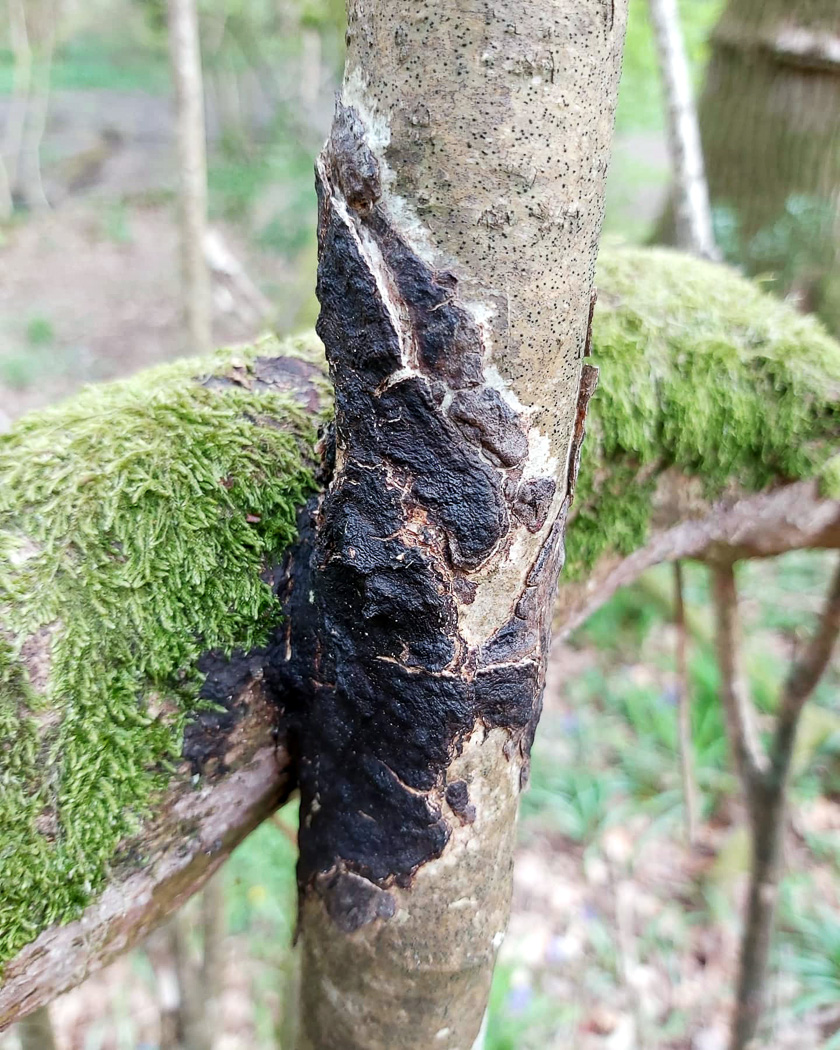 |
May 10th Hymenochaete corrugata (Glue Crust)
On the outskirts of Burnham Beeches in a Hazel bush Jesper Launder noticed how two dead branches had been fixed unnaturally together, and sure enough there was the fungus responsible for this phenomenon. It starts out much paler brown looking more like a species of Phellinus (or Fuscoporia) along a Hazel branch, then when meeting with a suitably adjacent twig it grows across to encompass both, thus preventing them from falling to provide itself with the nutrients from the dying wood. Clever or what?! See another example in Finds 2021 dated Feb 5th.
|
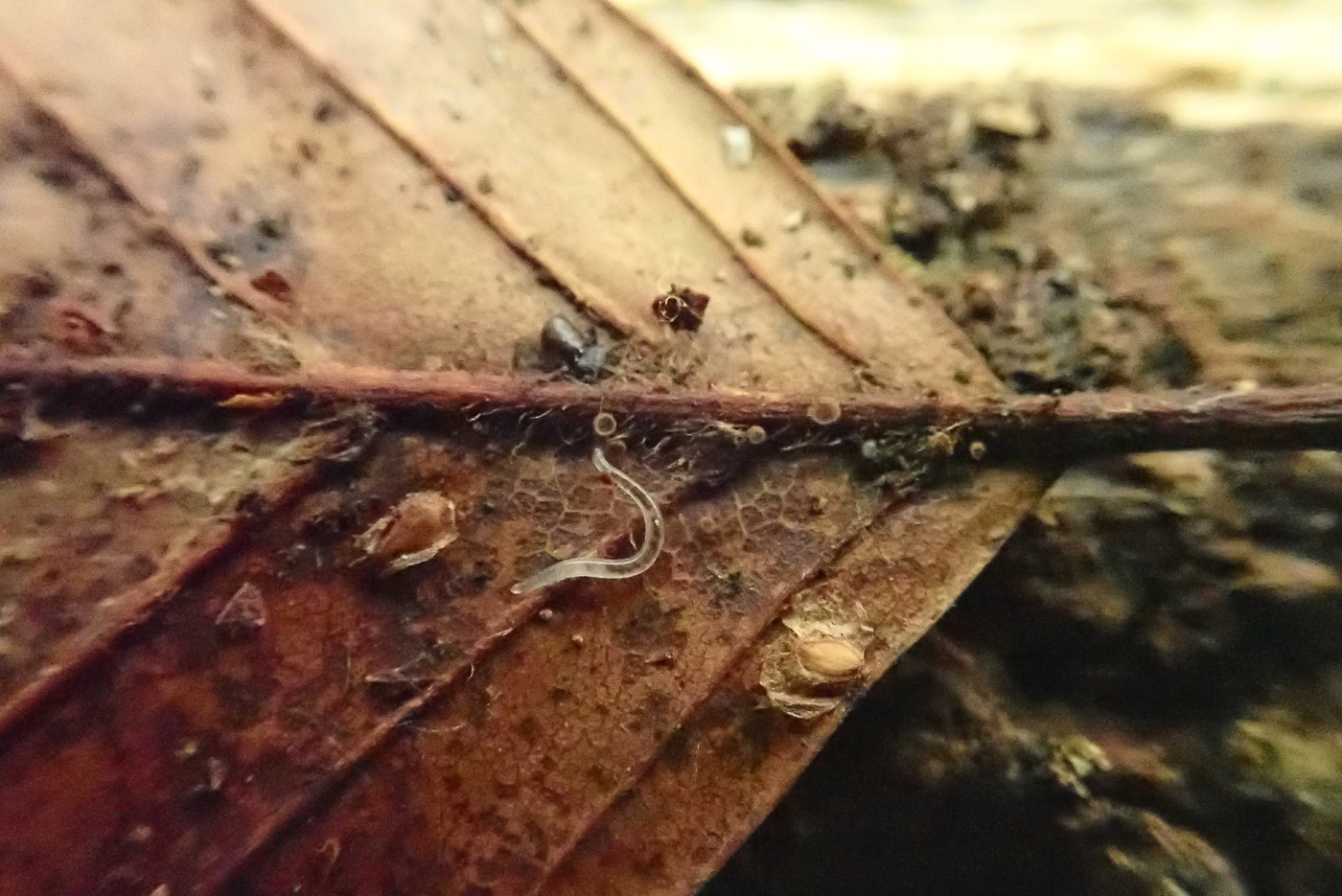
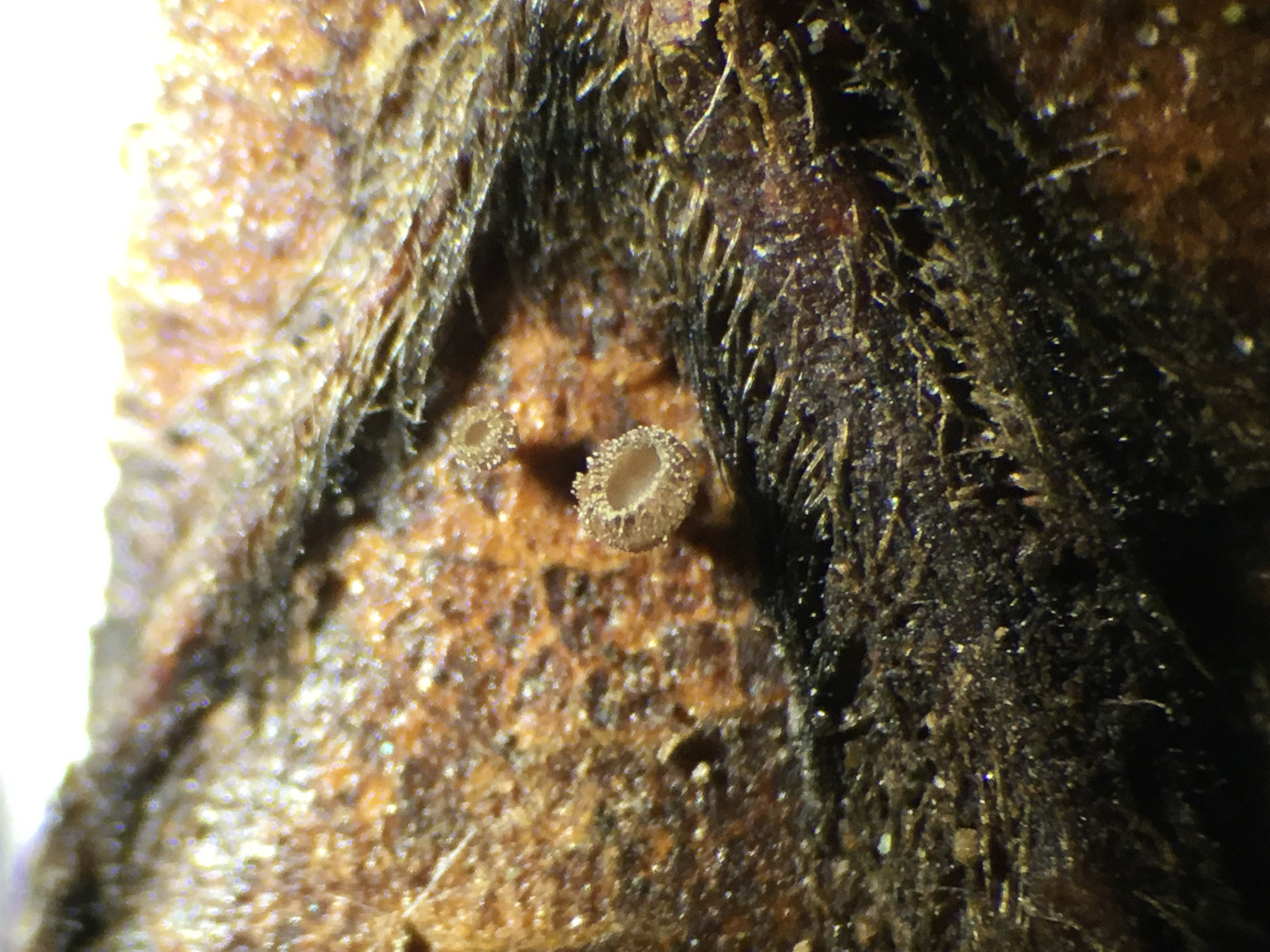 |
May 10th Lachnum fuscescens (an Ascomycete with no common name) 
On our visit to Burnham Beeches last week Asco expert Kerry Robinson found and named this tiny springtime discomycete on the veins on the underside of damp dead Beech leaves, but no photo was taken. Today Russell Ness and Penny returned independently and managed to find it again, though Russell's close-up photo was taken in the adjacent Egypt Woods. (Photo 1 is Pennys.) These miniscule cups are less than 1 mm across (and even with a handlens are quite hard to spot) and covered in fine brown hairs (which under a scope are tipped with crystals).
|
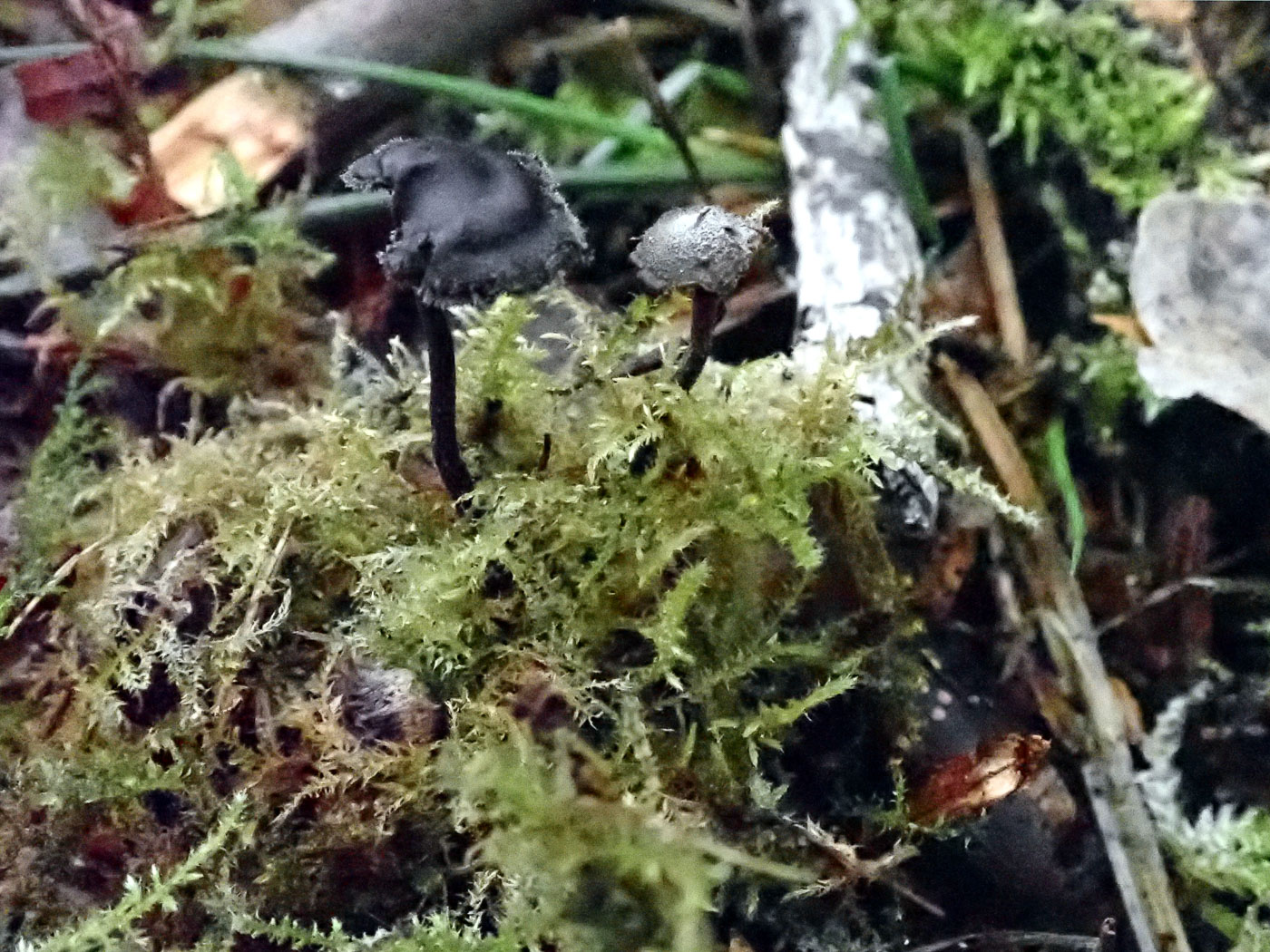
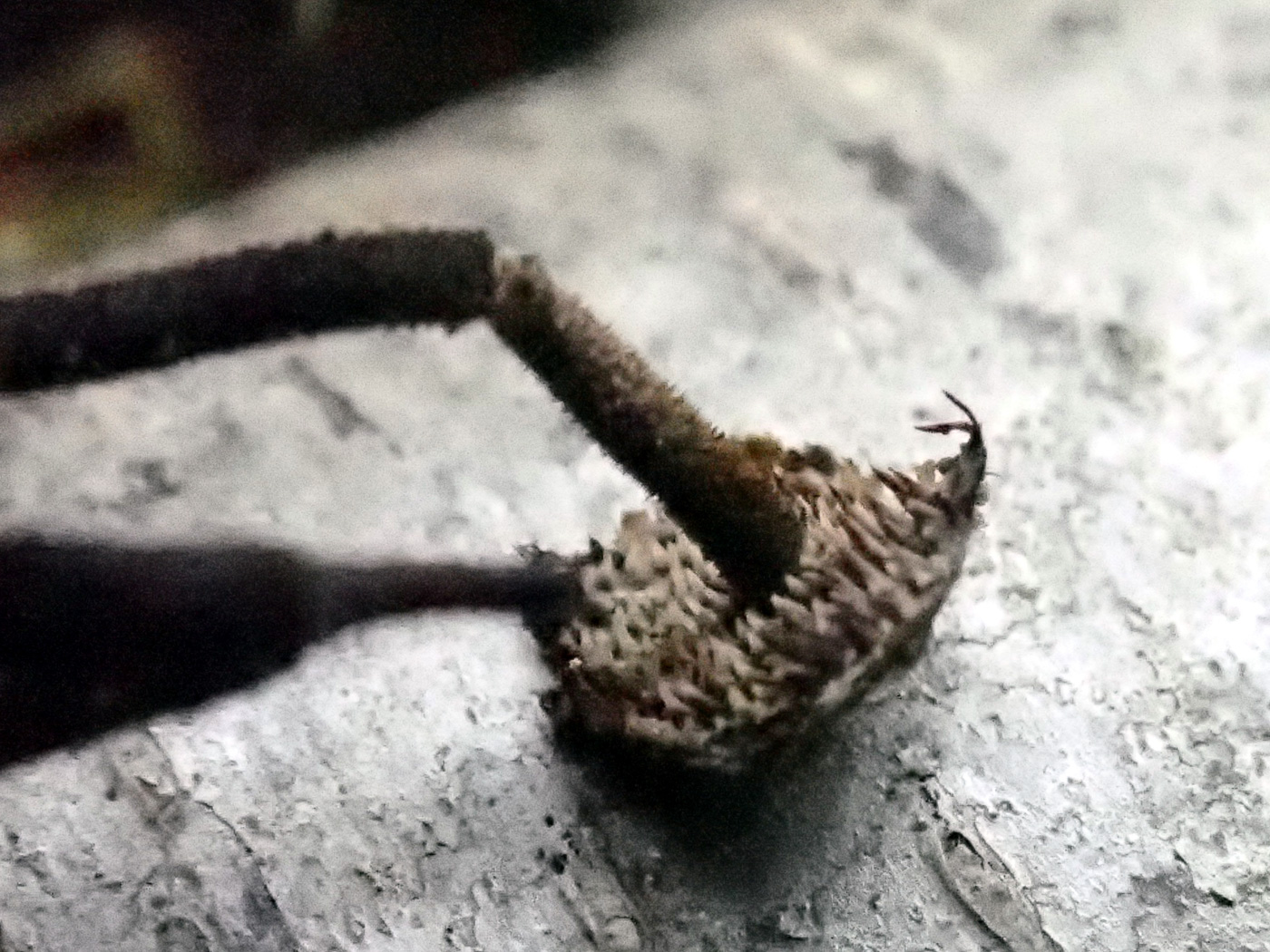 |
May 10th Auriscalpium vulgare (Earpick Fungus)
Whilst searching amongst Pine litter in Burnham Beeches Penny was surprised to spot a couple of tiny mushrooms. Further investigation revealed they were growing on a mossy Pine cone and even further investigation revealed the unmistakeable spines underneath in place of gills or pores. This species is described as occurring in summer or autumn and certainly today's specimens were not fresh so presumably they'd dried in situ and had managed to survive.
|
May 9th 2021
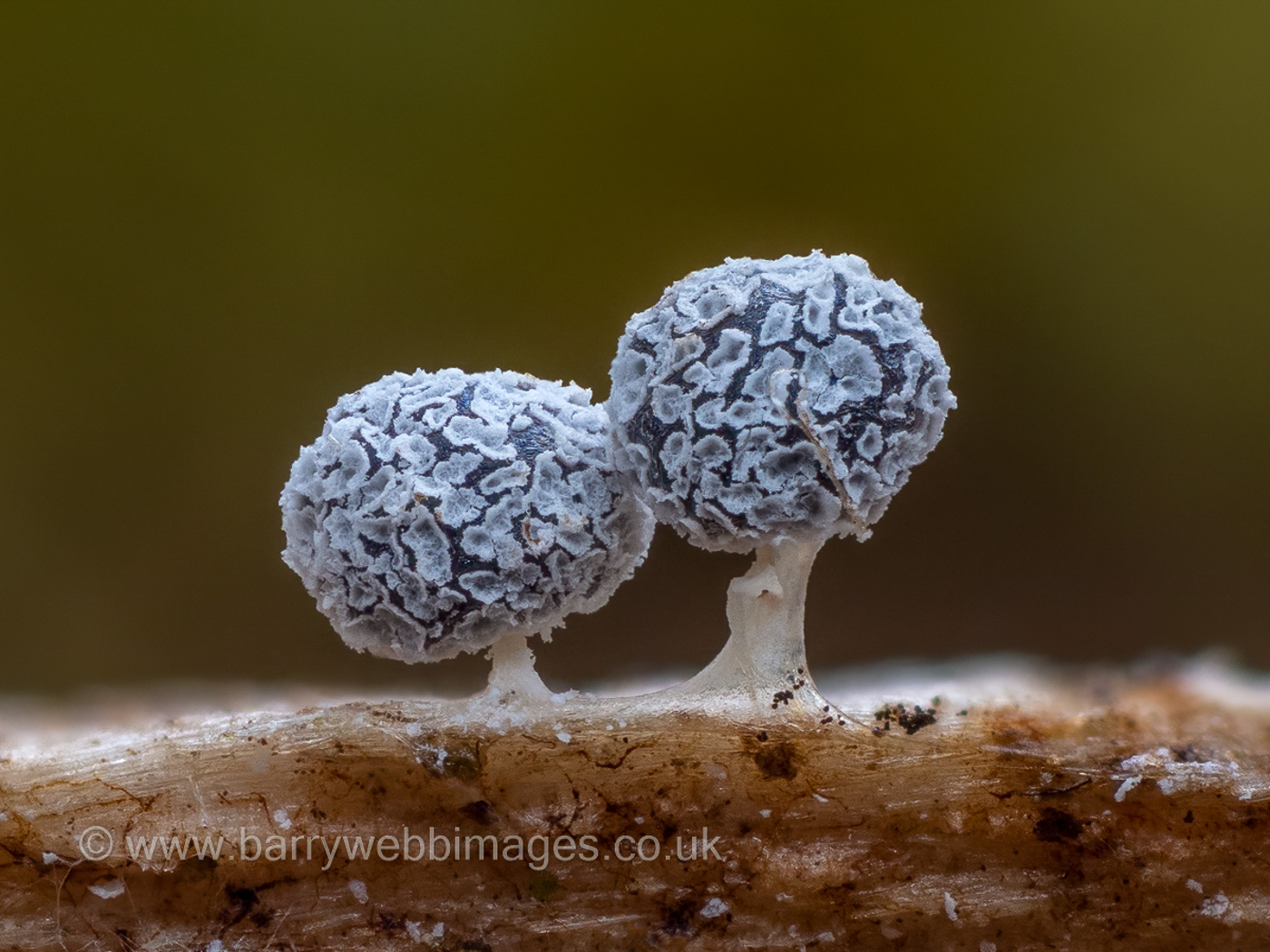 |
May 9th Didymium squamulosum (A Slime Mould with no common name)
Barry Webb found these tiny little beauties on a woodchip pile in Burnham Beeches. This is one of the commoner species in a genus of around 30 or so, many of which are very similar to today's species. Features to note here are the patches of egg-shell-like crust of calcium carbonate on the surface and the short white stalk. See also Barry's Slime Moulds on the Members' Finds page where there are further Didymium photos.
|
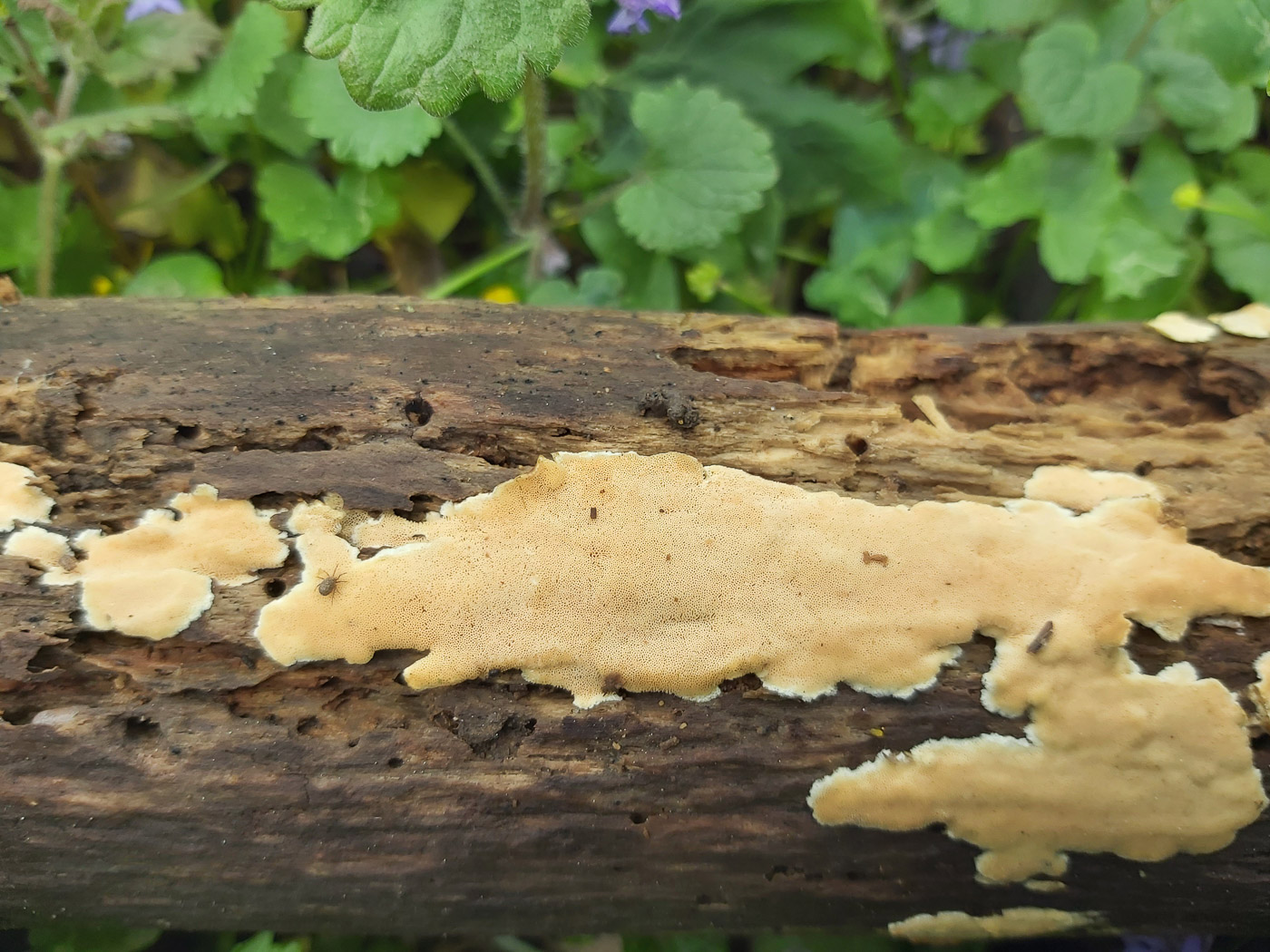
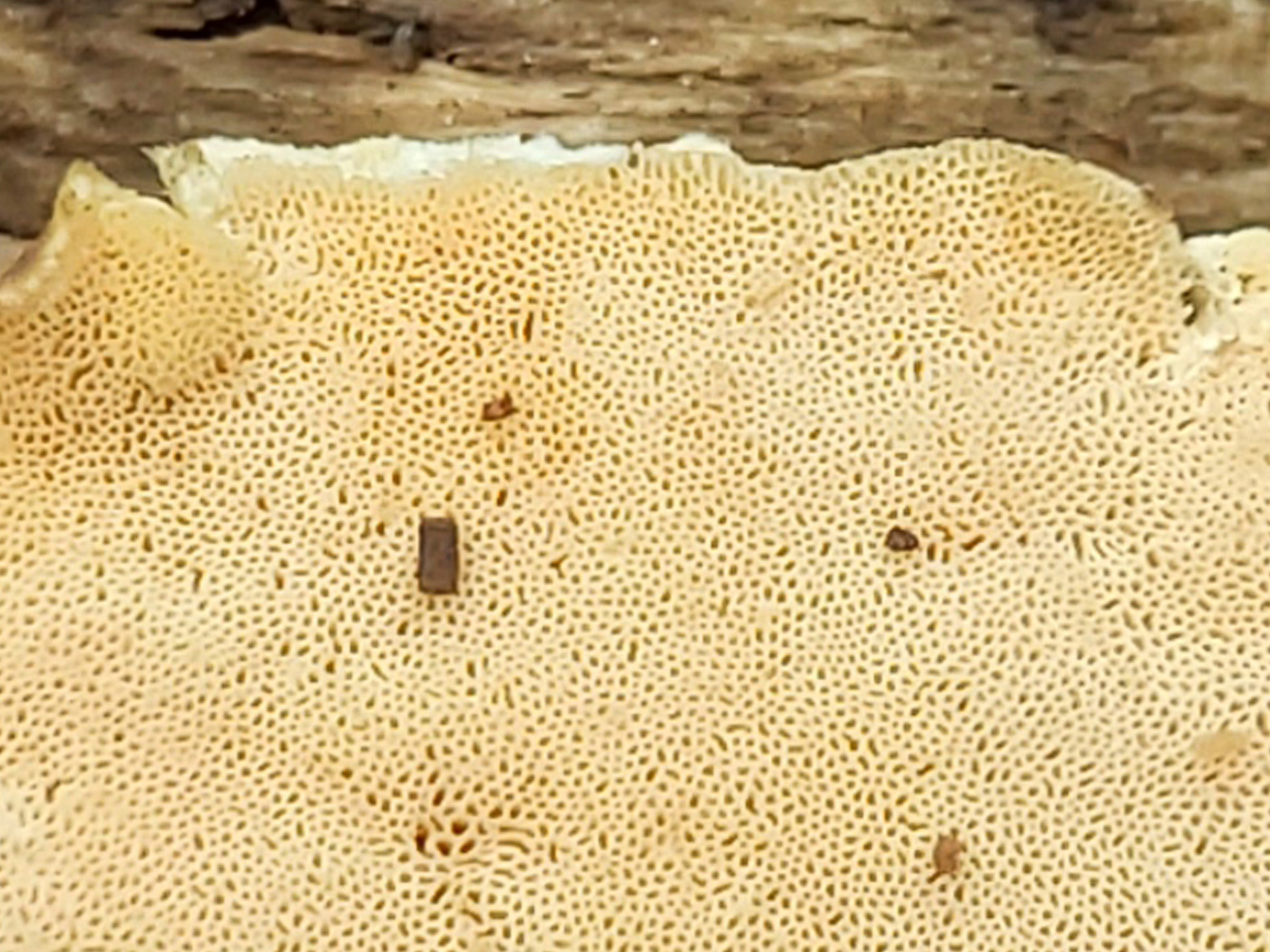 |
May 9th Junghuhnia nitida (a corticioid fungus with no common name)
Jesper Launder found this quite distinctive species growing on fallen deciduous wood (probably Ash or Sycamore) in woodland between Chalfont St. Giles and Chalfont St. Peter. It can form large patches and can be recognised in the field by its distinctly poroid surface (seen in photo 2) which is ochraceous pinky buff, having a contrasting white margin. It can be found on various deciduous woods, particularly Beech, occurring mainly but not exclusively in autumn - not common but we have quite a few records in the county.
|
May 8th 2021
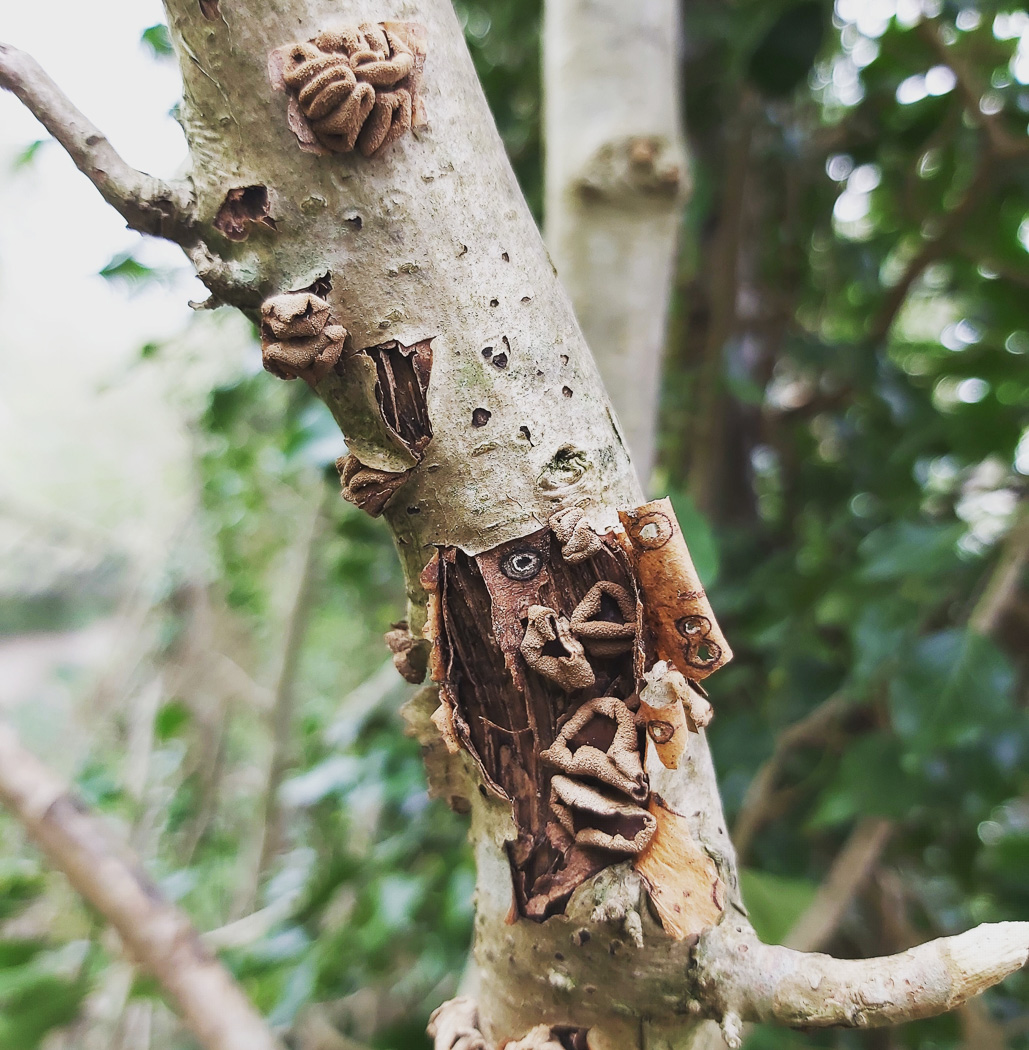
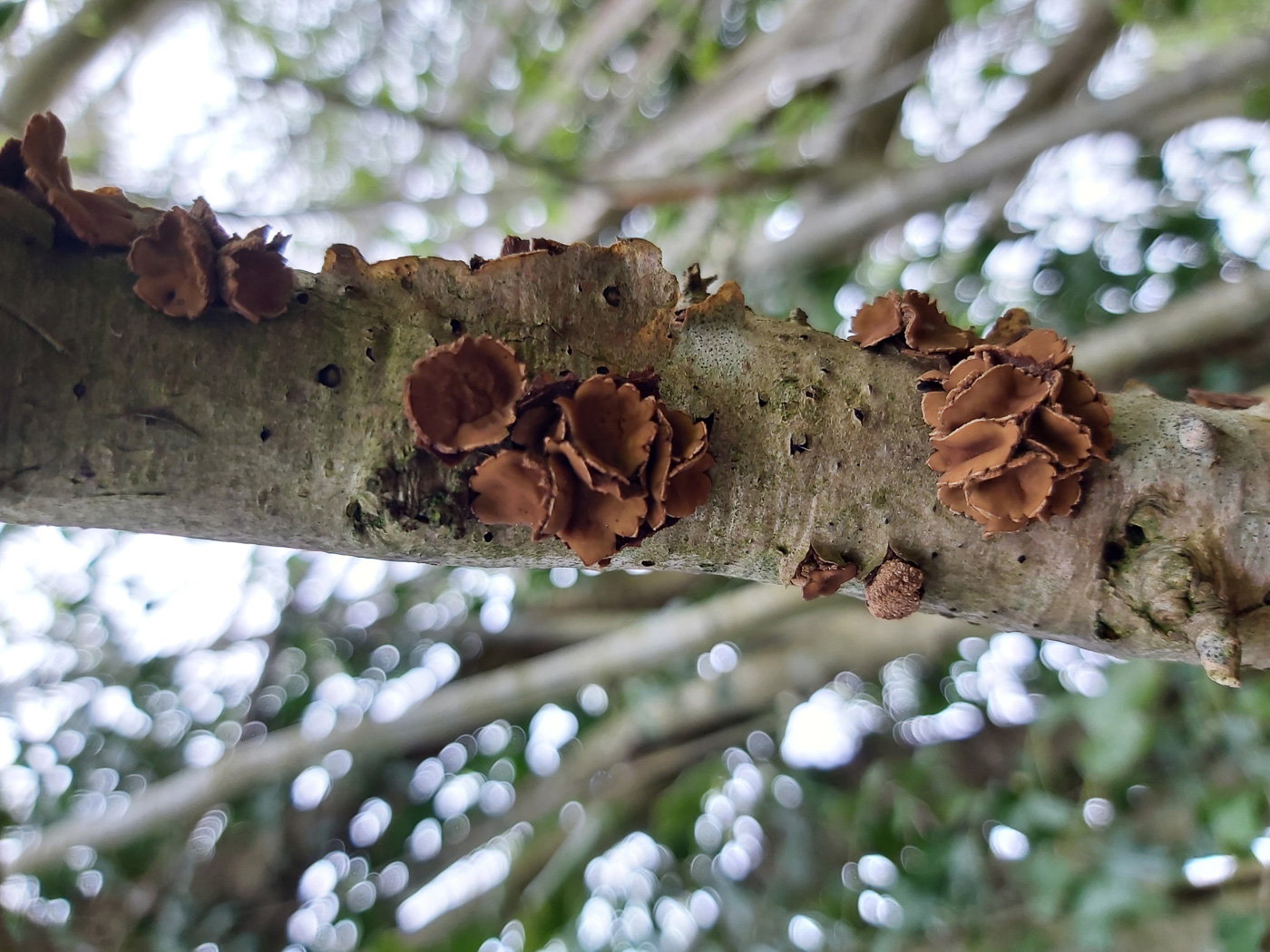 |
May 8th Encoelia furfuracea (Spring Hazelcup)
On a path near Jordans Jesper Launder first noticed this good collection of cups on standing but presumably dying Hazel on April 27th (photo 1) when it was looking somewhat desiccated. Then 10 days later he found the same material completely rejuvenated after recent rain (photo 2) - what a transformation! This is a particularly impressive group of a species considered not common but occasional and host specific on Hazel. See another example in Finds 2021 dated Feb 5th.
|
May 5th 2021
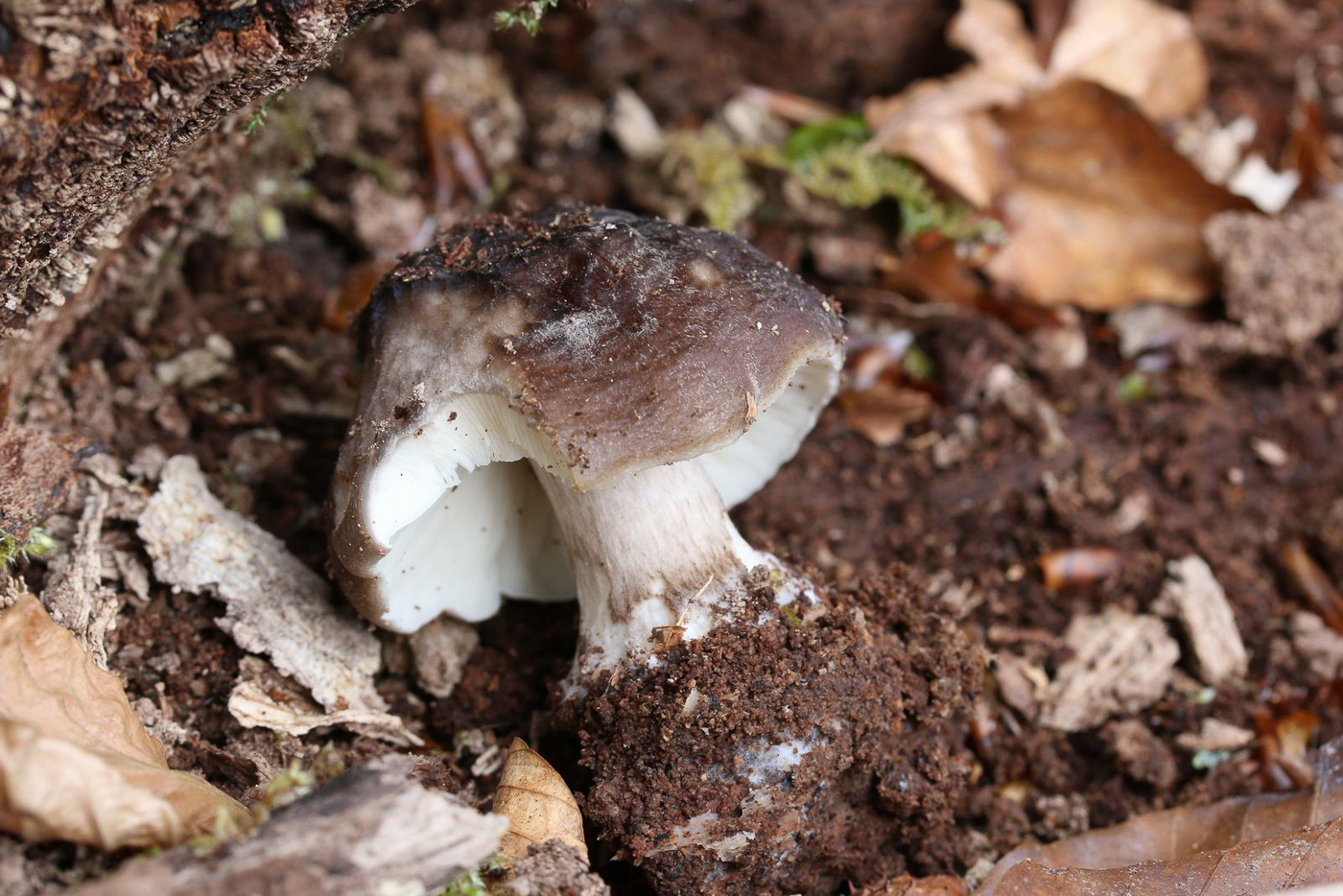 |
May 5th Pluteus cervinus (Deer Shield) 
At our visit to Burnham Beeches today Joanna Dodsworth found this the only agaric on our list of 35 species - one that is common on fallen deciduous wood in the autumn but was certainly a surprise in May! See also Finds 2020 dated Sept 18th and Nov 17th. (The photo is Claudi Soler's.)
|
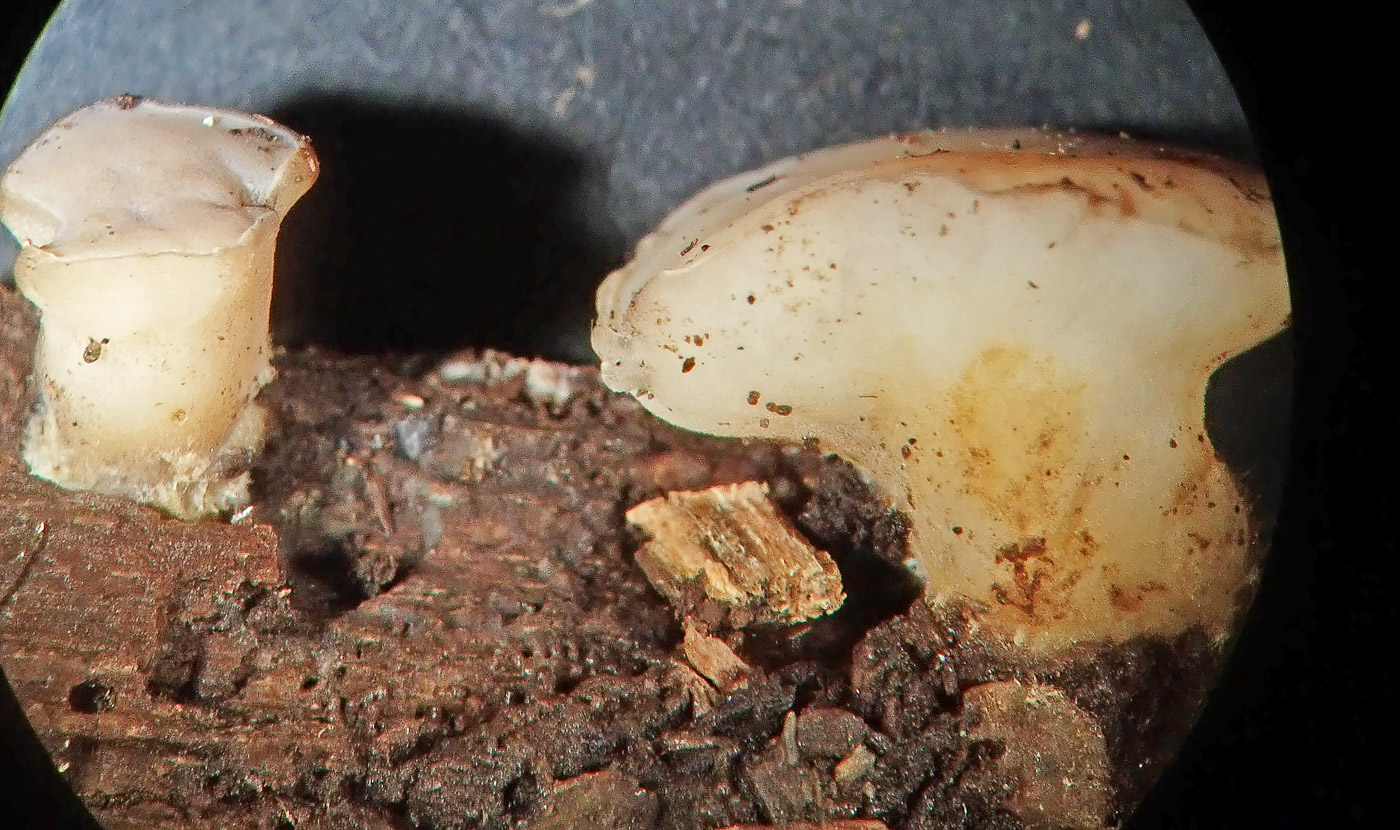 |
May 5th Cudoniella clavus (Spring Pin)
At our visit to Burnham Beeches today Joanna Dodsworth found this quite unusual ascomycete which could easily be mistaken for a small polypore, growing as it does on damp bare wood or woody remains. The underside, however, is entirely smooth (i.e. no pores or gills) and it favours spring fruiting - hence its common name. Today’s find was about 15mm across but it has a much smaller and commoner baby sister species, Cudoniella acicularis, which we find commonly on bare rotting wood in the autumn. See Finds 2020 dated Oct 22nd to compare the two species. Photo 1 is Penny's, photo 2 is Derek's.)
|
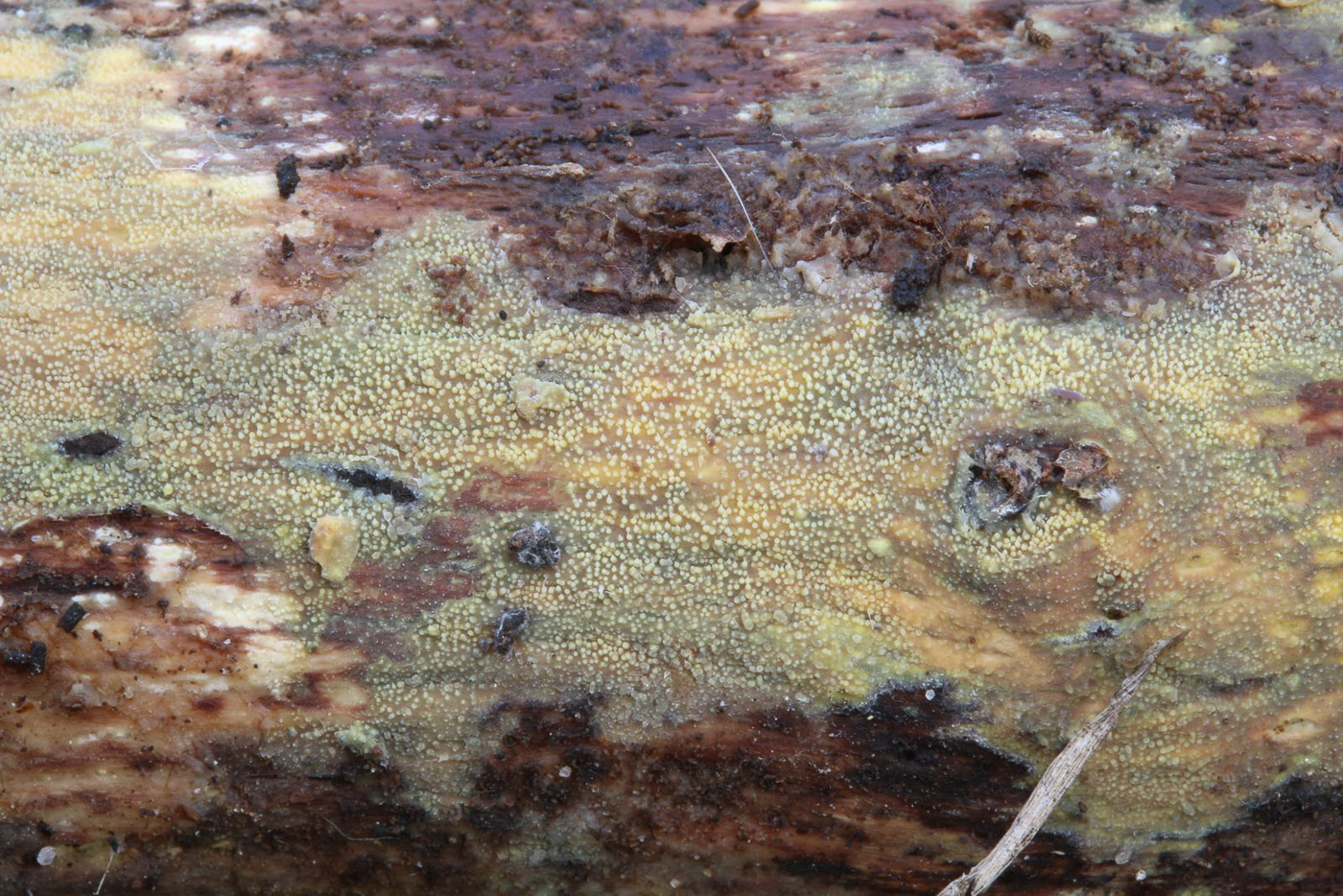 |
May 5th Mycoacia uda (a Corticioid with no common name) 
On the underside of a Birch stick in the Mire at Burnham Beeches today Penny found some nice young material of this not uncommon species - recognisable in the field by its yellow colour and almost 'toothlike' spiny surface. It can form quite large patches covering bare fallen deciduous branches. In Claudi Soler's photo here the surface is only just beginning to develop its characteristic appearance, but to see a more mature example see his photo in Finds 2020 dated Oct 19th.
|
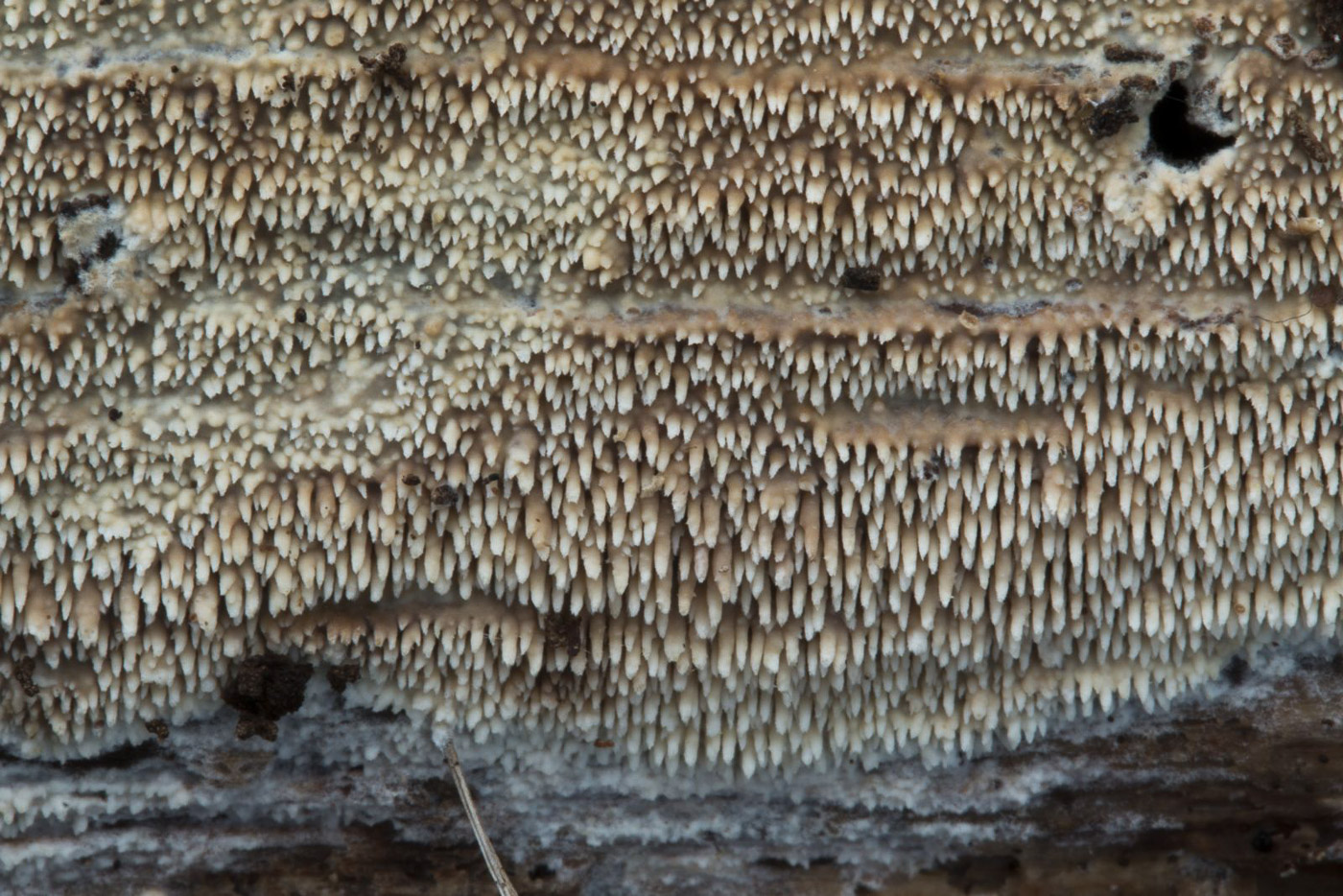 |
May 5th Mycoacia fuscoatra (a Corticioid with no common name) 
On the underside of an Oak stick in the Mire at Burnham Beeches Penny found this quite rare species - new to the site and to the county. It was identified by expert Kerry Robinson and, like the more common M. uda (seen just below), favours the underside of damp rotting deciduous wood. The 'toothlike' spiny surface is very obvious but it differs from M. uda by starting out pale off-white but gradually turns brownish to black rather than yellow - hence its Latin species name. (The photo is Claudi Soler's.)
|
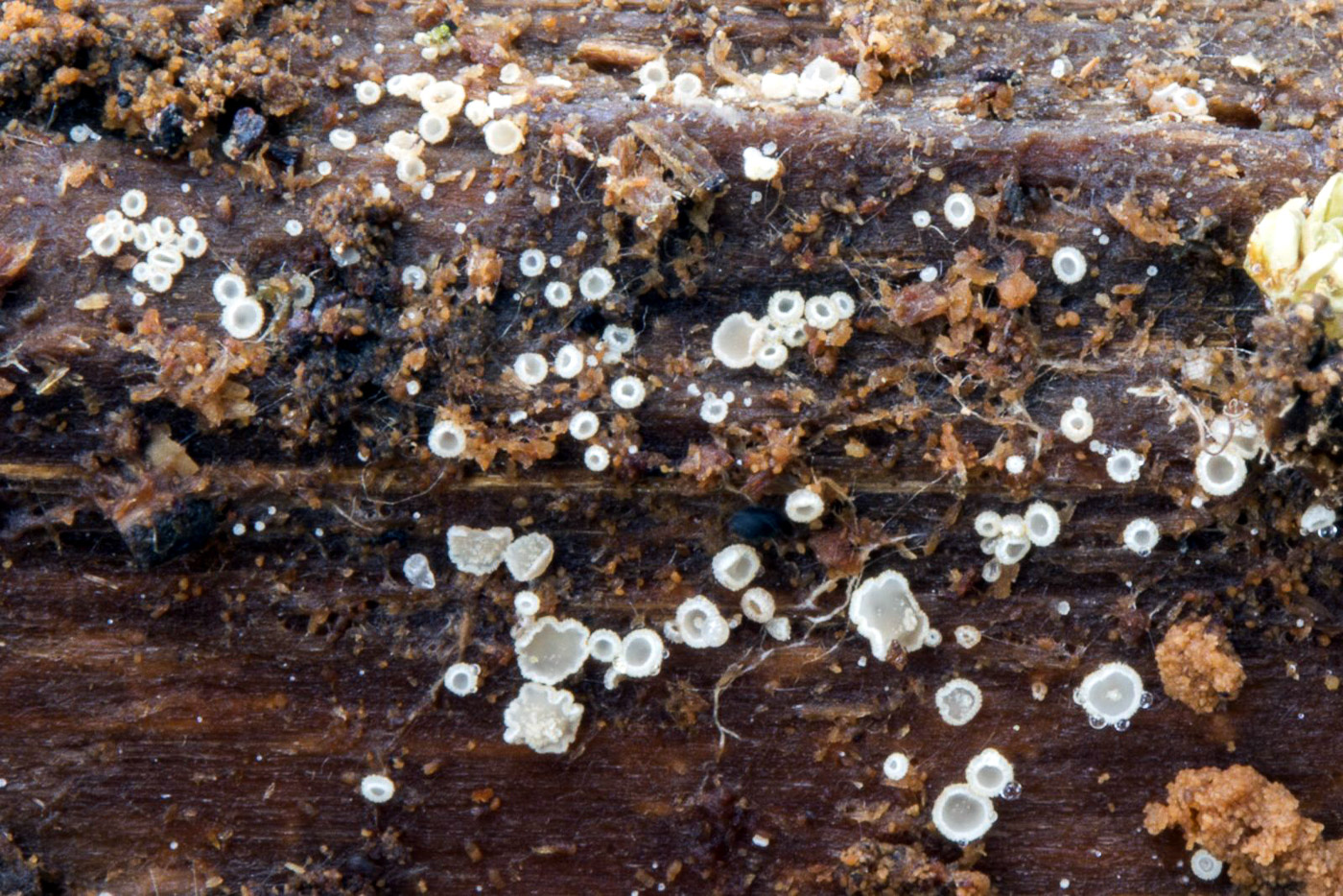 |
May 5th Hyaloscypha aureliella (an Ascomycete with no common name) 
In the Mire at Burnham Beeches Russell Ness turned over a piece of soggy Pine and noticed these tiny cups. Identified in the field (and confirmed later with a scope) by expert Kerry Robinson, the cups are not dissimilar to the very common Lachnum virgineum, often having droplets between the very fine hairs around the rim (seen in Claudi Soler's photo), but they are smaller (less than 4mm across), lack the hairy stem of the Lachnum and occur only on bare rotting Pine as here. Though not considered rare this was a new species to the site.
|
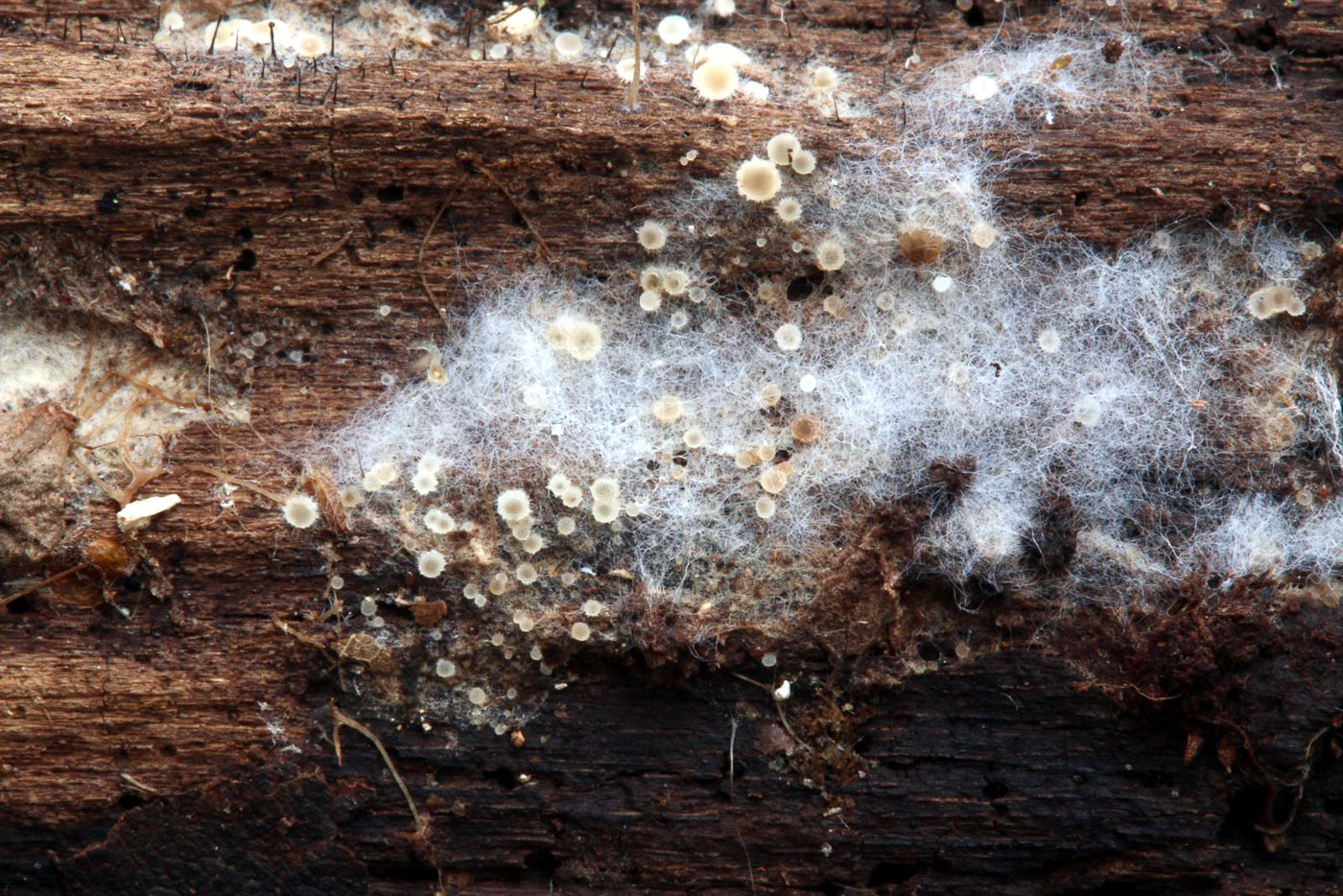 |
May 5th Arachnopeziza aurata (an Ascomycete with no common name) 
On the underside of an Oak stick in the Mire at Burnham Beeches Penny found this unusual species. Identified in the field (and confirmed later with a scope) by expert Kerry Robinson, the colony of tiny white cups (less than 0.5mm across) are enveloped in pale cobwebby mesh which Penny assumed was a different fungus. Not so. This is in fact a fine network of hyphae and characteristic of the genus - hence the reference to both spiders' webs and cup fungi in the genus name. The species can be found at all times of year on rotting damp deciduous wood though is not common and this find was a first for the site and for the county. (The photo is Claudi Soler's.)
|
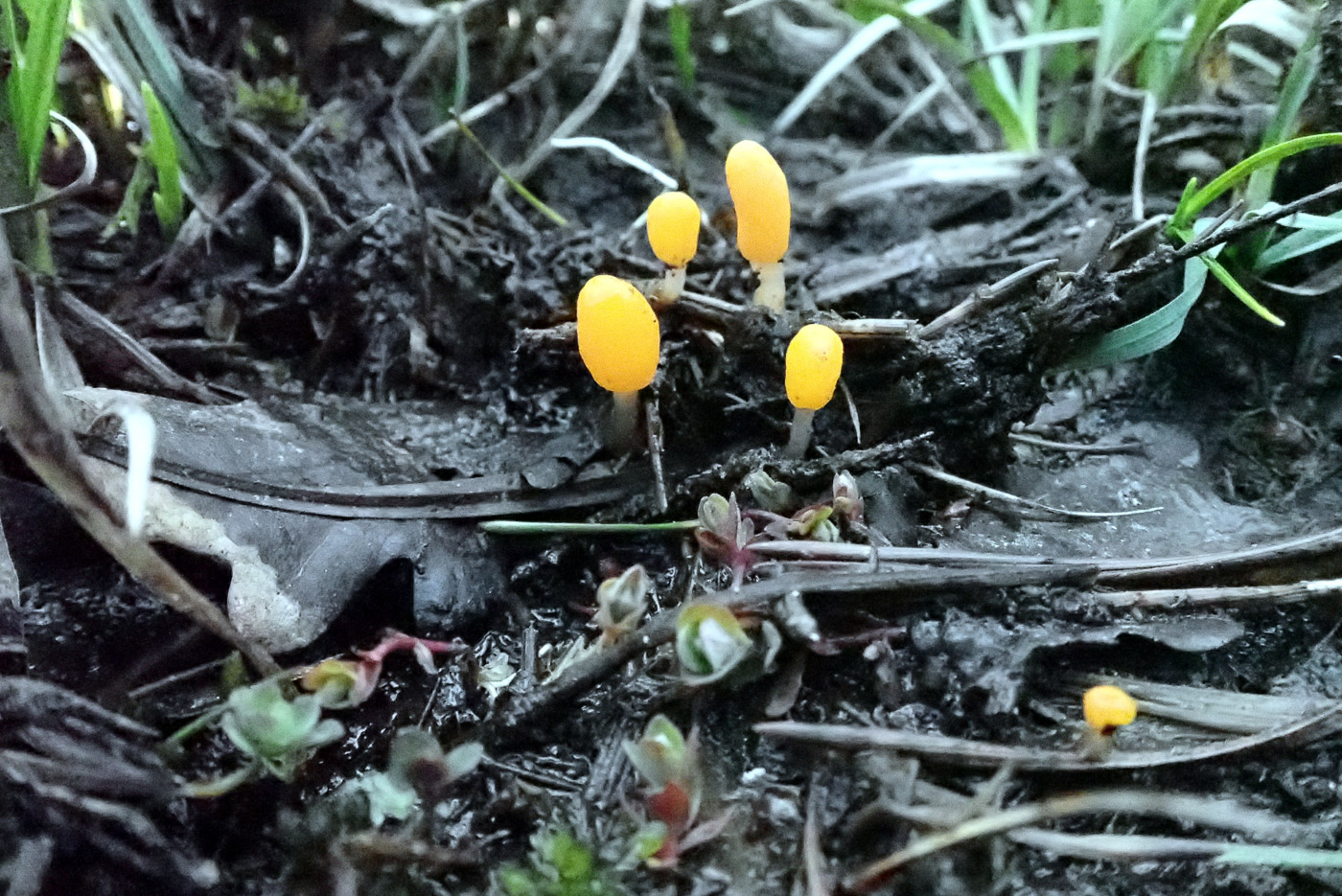
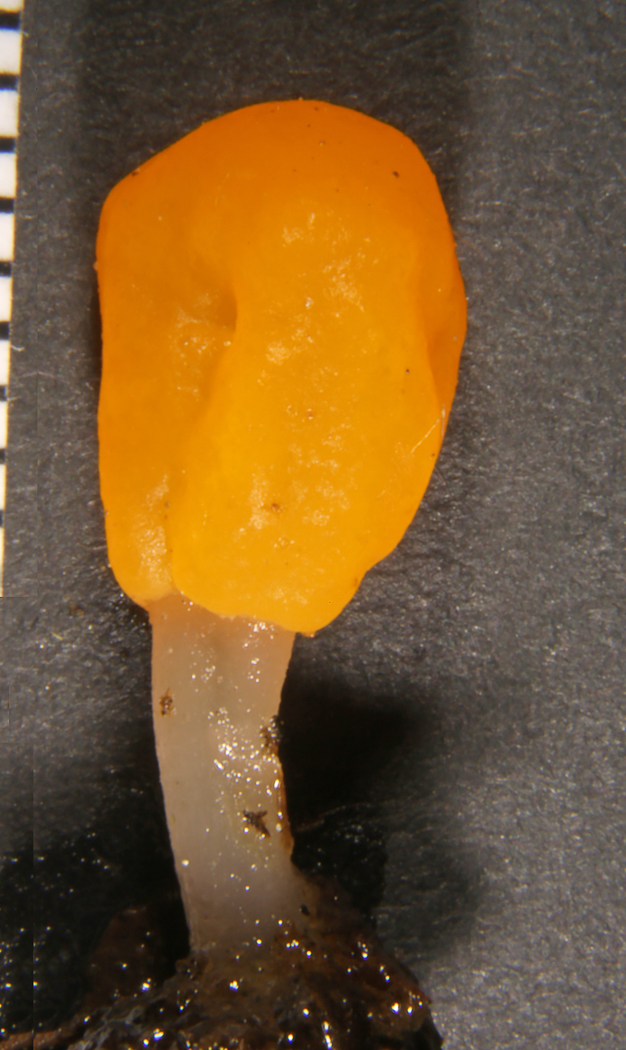
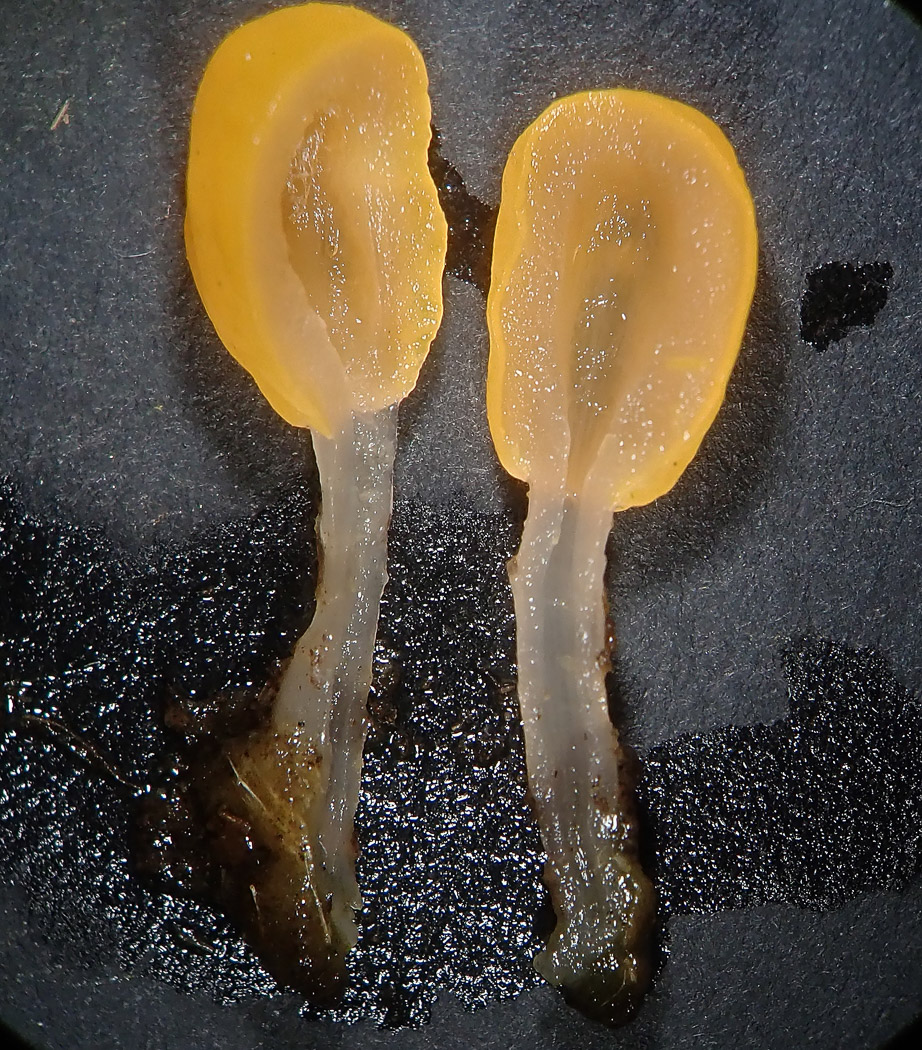 |
May 5th Mitrula paludosa (Bog Beacon)
In the Mire at Burnham Beeches Penny was delighted to come across this attractive little ascomycete. At first glance it is not unlike Mycena acicula in colour and size, but this is a species of wet boggy places, ditches, standing water and the like, typically fruiting at this time of year, and a closer look reveals its lack of gills and typical clavate head on a whitish stem, the whole only 2cms tall or so. It tends to fruit in large numbers as it was here though only just coming up, so if you find one it's worth looking around for more. Though not rare given suitable habitat we have just one other site besides this one for the species (near Milton Keynes) and this is only our third county record. Photo 1 is Penny's, photo 2 and 3 are Derek's, the last showing a specimen sliced in half and hollow in the centre.
|
April 24th 2021
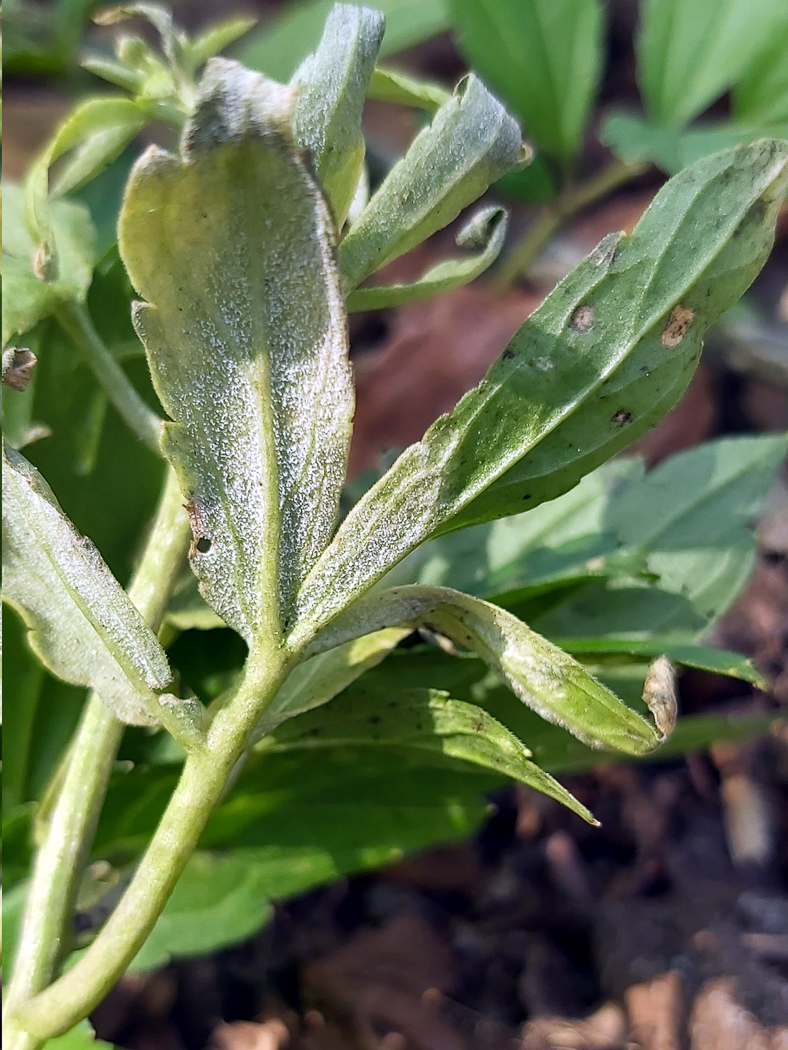

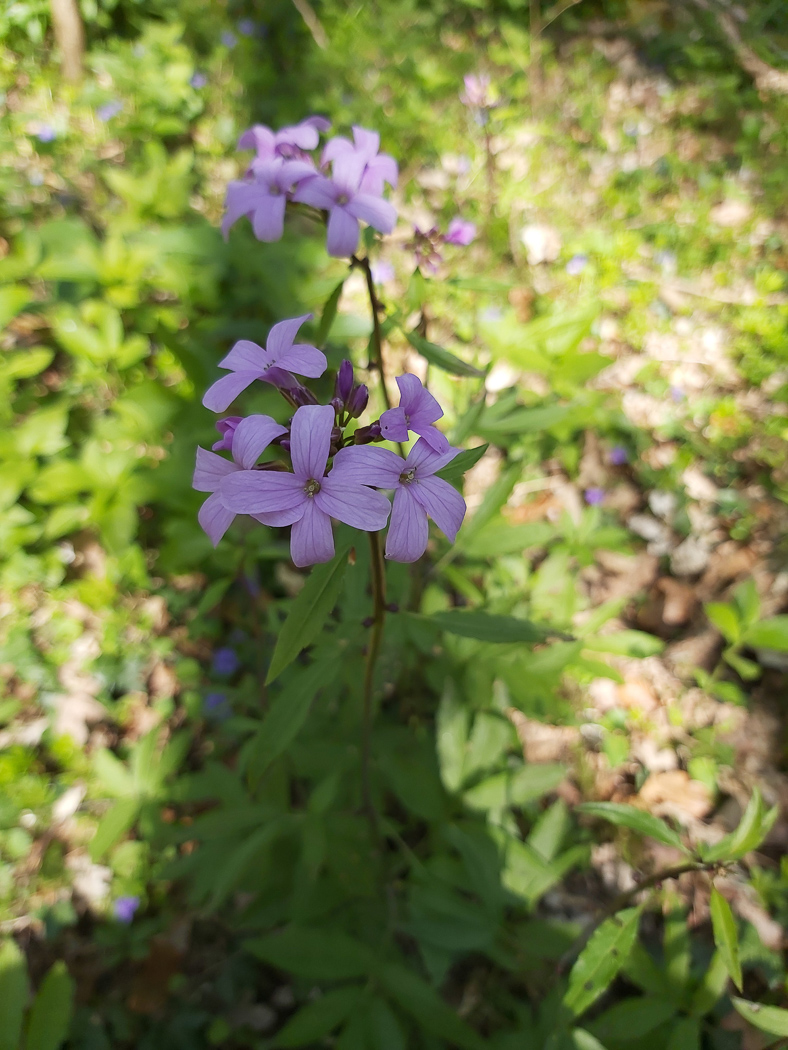
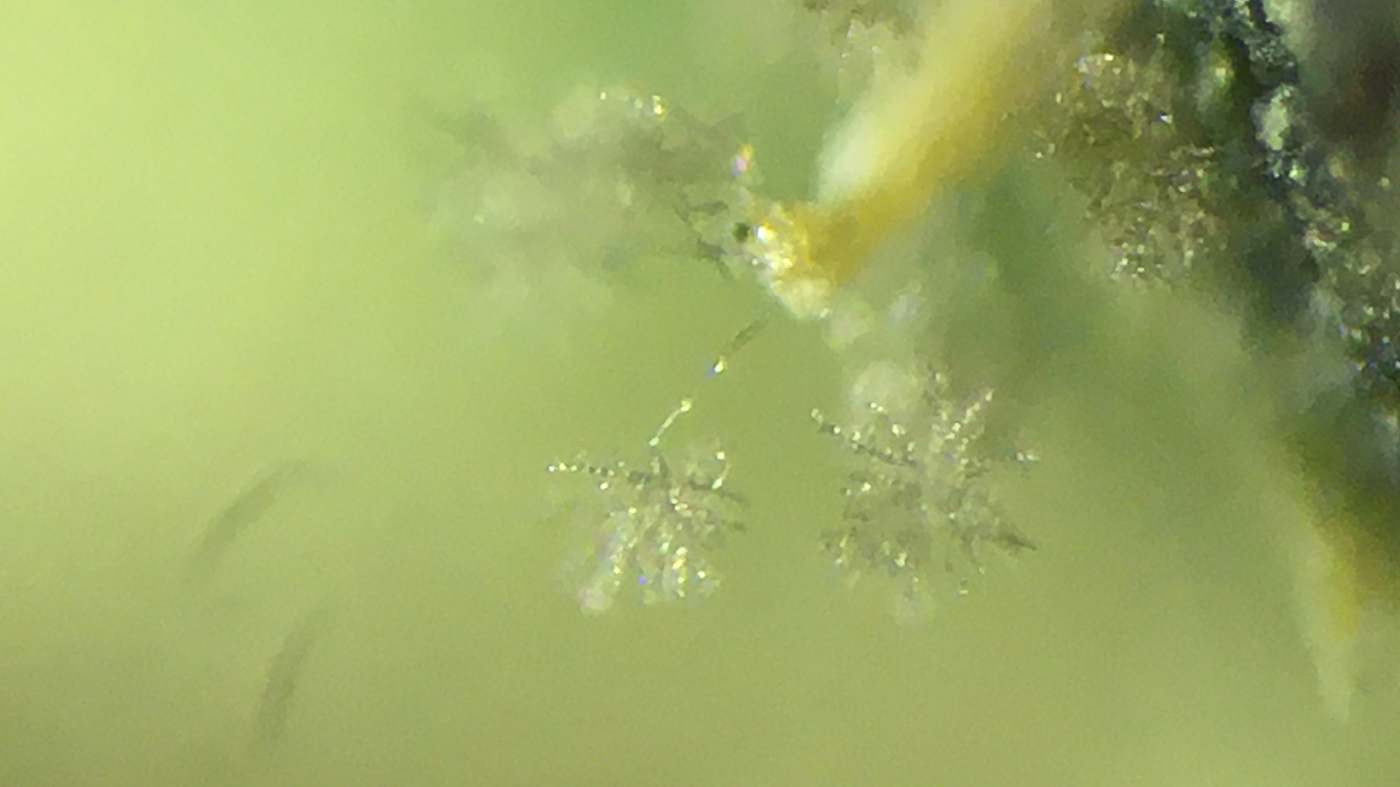 |
April 24th Hyaloperonospora dentariae (a downy mildew with no common name) 
In Layters Green Wood near Chalfont St Peter Jesper Launder found this rare species, not often recorded because the plant it occurs on is also quite rare in the UK but favours mature dry Beech woodlands where it may be locally abundant as it was here. The host plant is Cardomine bulbifera (Coral Root Bittercress) and the fungus occurs in Spring. (More familiar to many and closely related is the plant Cardomine pratensis (Cuckoo Flower / Lady's Smock - much more common and found in damp meadows, often near streams.) Jesper took photos of the plant as well as the mildew, so both the plant and the fungus are worth looking out for now in local Chiltern woodlands. We have just one previous county record from Hodgemoor Woods where it was found by the mildew expert Elizabeth Mordew 20 years ago on the BMS Spring Foray in May. The final photo is of another find from near Little Marlow made 10 days later by Russell Ness, taken at x 100 magnification and showing the beautiful crystals.
|
April 24th 2021
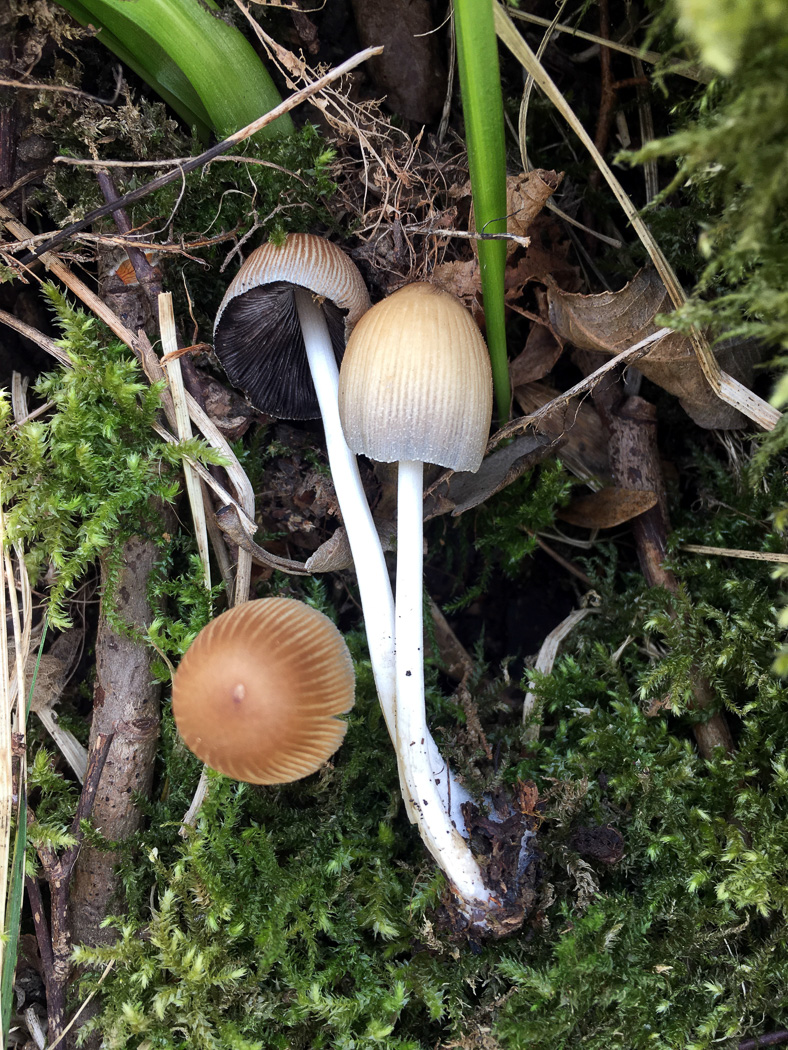 |
April 18th Coprinellus micaceus (Glistening Inkcap) 
Joanna Dodsworth found this nice fresh material in woody litter at the base of a deciduous stump in Rushbeds Wood. Despite the recent night frosts it appears to be in good condition and is a species which can be found at any time given suitable damp woody remains - Rushbeds tends to retain its dampness well having underlying clay. See also Finds 2021 dated March 12th and Finds 2020 dated Sept 11th and Oct 13th.
|
April 6th 2021
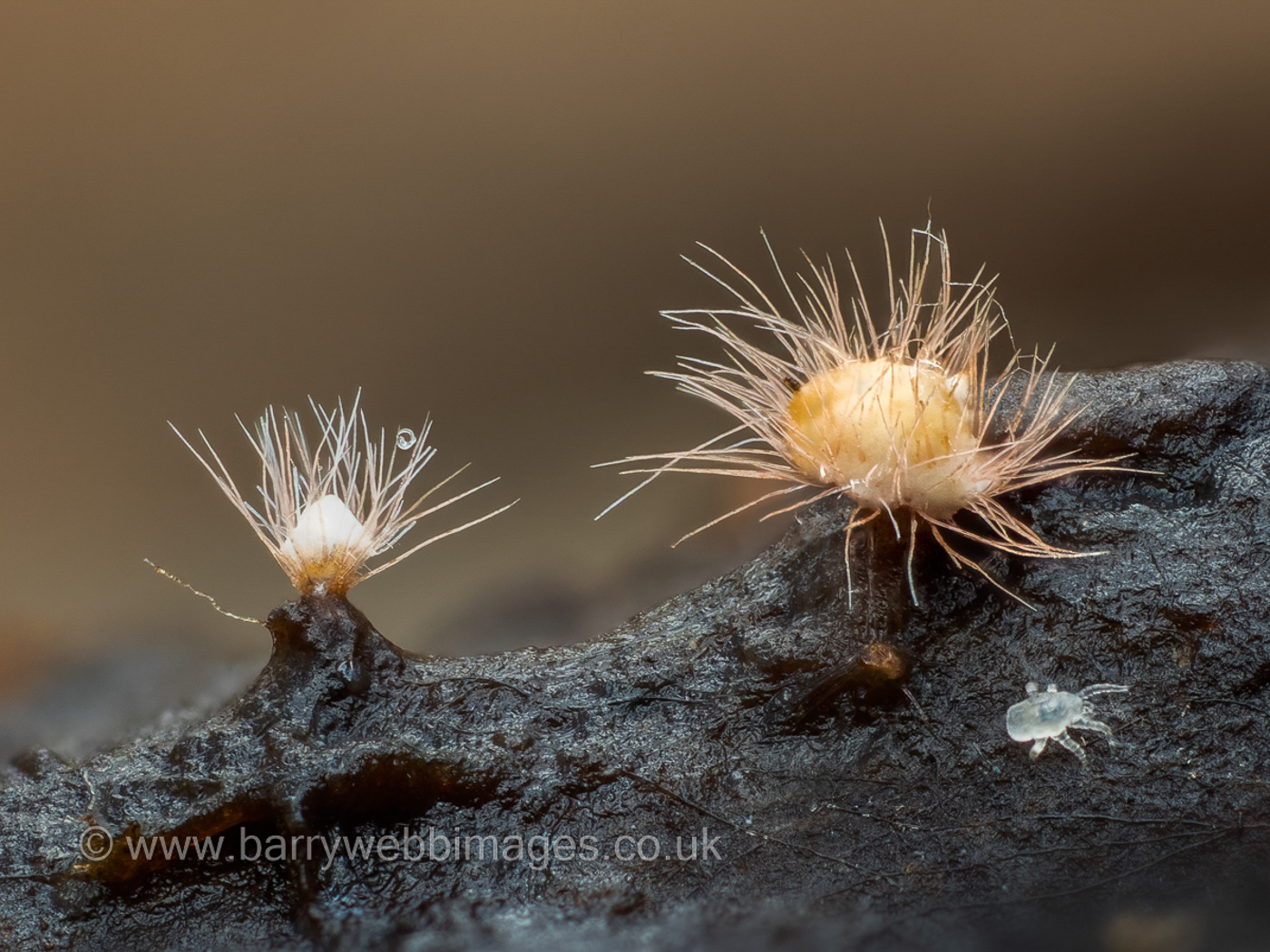 |
April 6th Volutella ciliata (an Ascomycete with no common name)
Barry Webb found these tiny rarely recorded Ascos in Burnham Beeches on a woodchip pile. Described as occurring commonly on herbaceous stems, this is a first for the county - presumable not spotted previously owing to it being so tiny, each cup measuring only 0.25 mm across! The species name ciliata refers to the obvious long fine hairs around the periphery which make this amazing fungus so distinctive despite its miniature size.
|
April 4th 2021
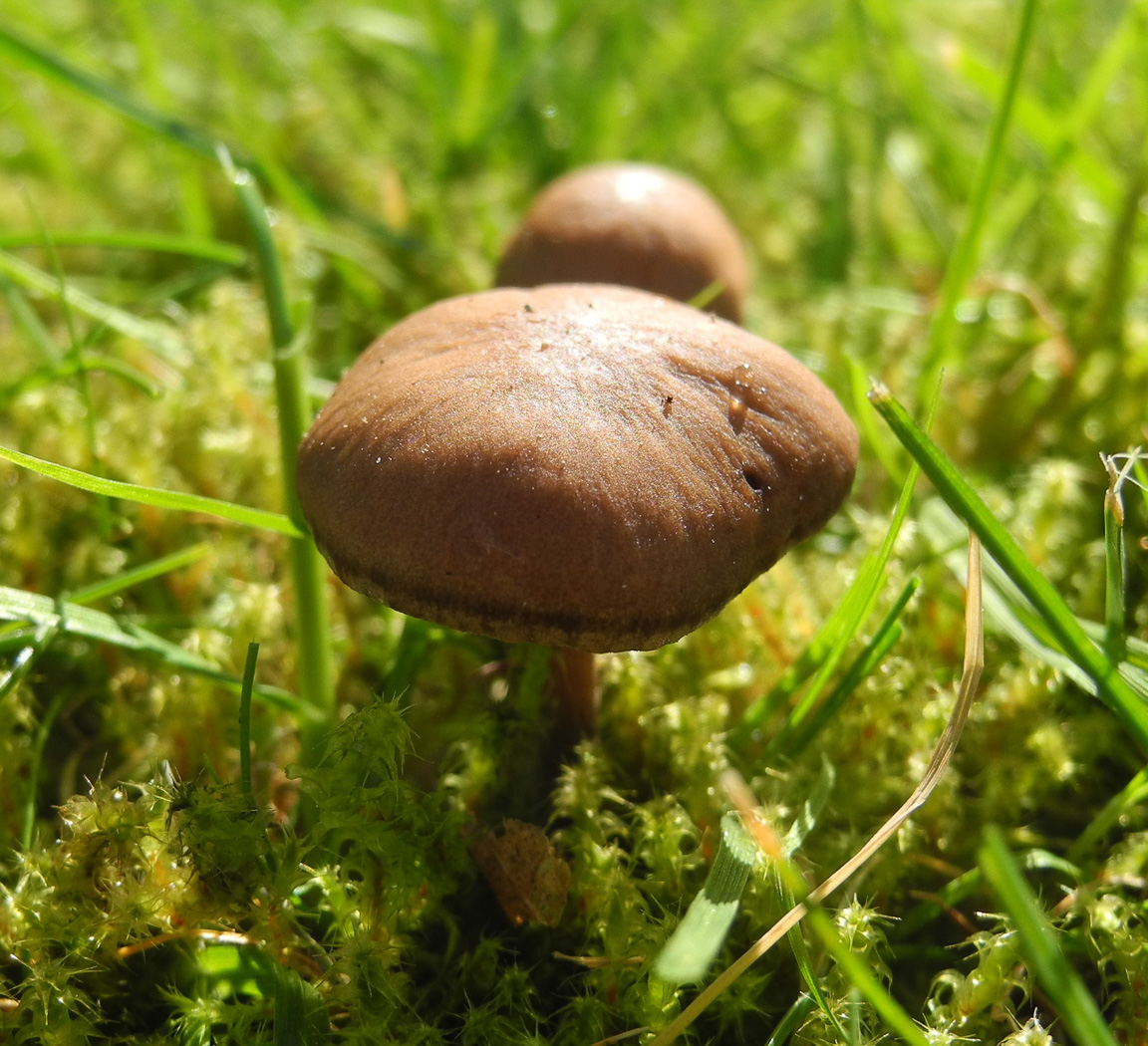
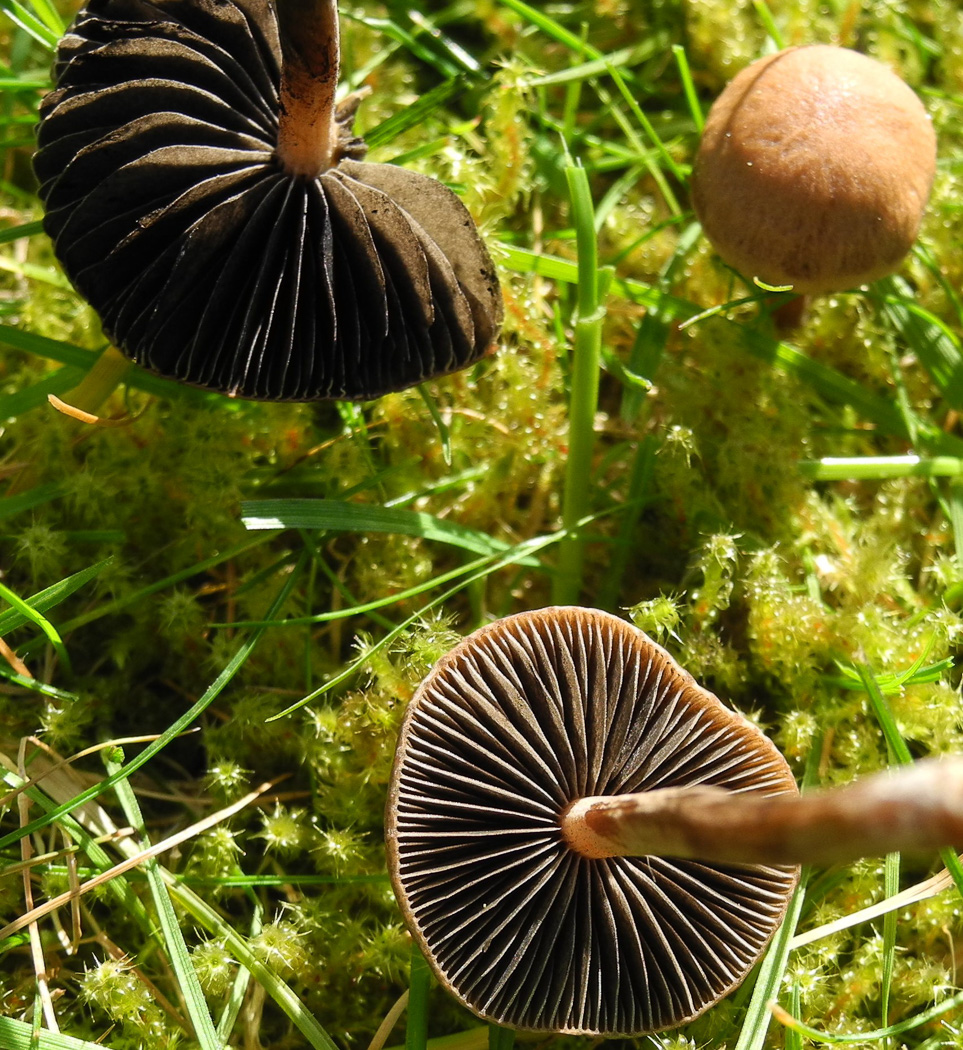
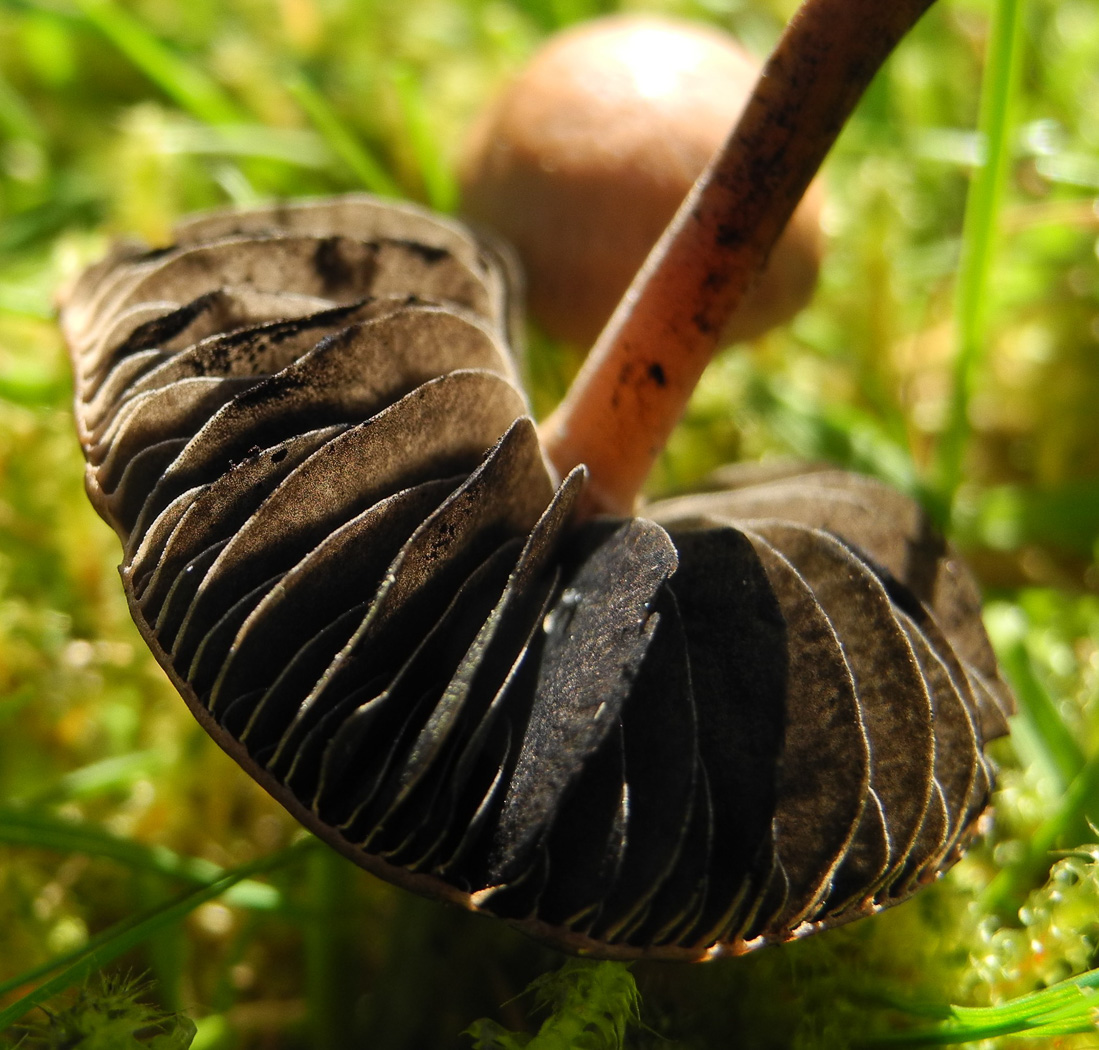 |
April 4th Panaeolus fimicola (Turf Mottlegill) 
Tony Knight found several of these Mottlegills coming up in mossy grass in his garden in Long Crendon. He gave a tentative identification having looked at microscopic features which Penny was reasonably happy to confirm from the photos (which included the spores and cystidia) though would not like to commit to being 100% on this. This is a genus with a preference for grassy soil, often manured (though presumably not in this case) - a typical LBJ with dark almost black spores which tend to leave a mottled appearance on the gills, hence its common genus name (seen in photos 2 and 3). The species is 'hygrophanous' (ie the cap colour fades with age and sunlight as it dries) but the dark marginal line seen in photo 1 reveals its original cap colour.
|
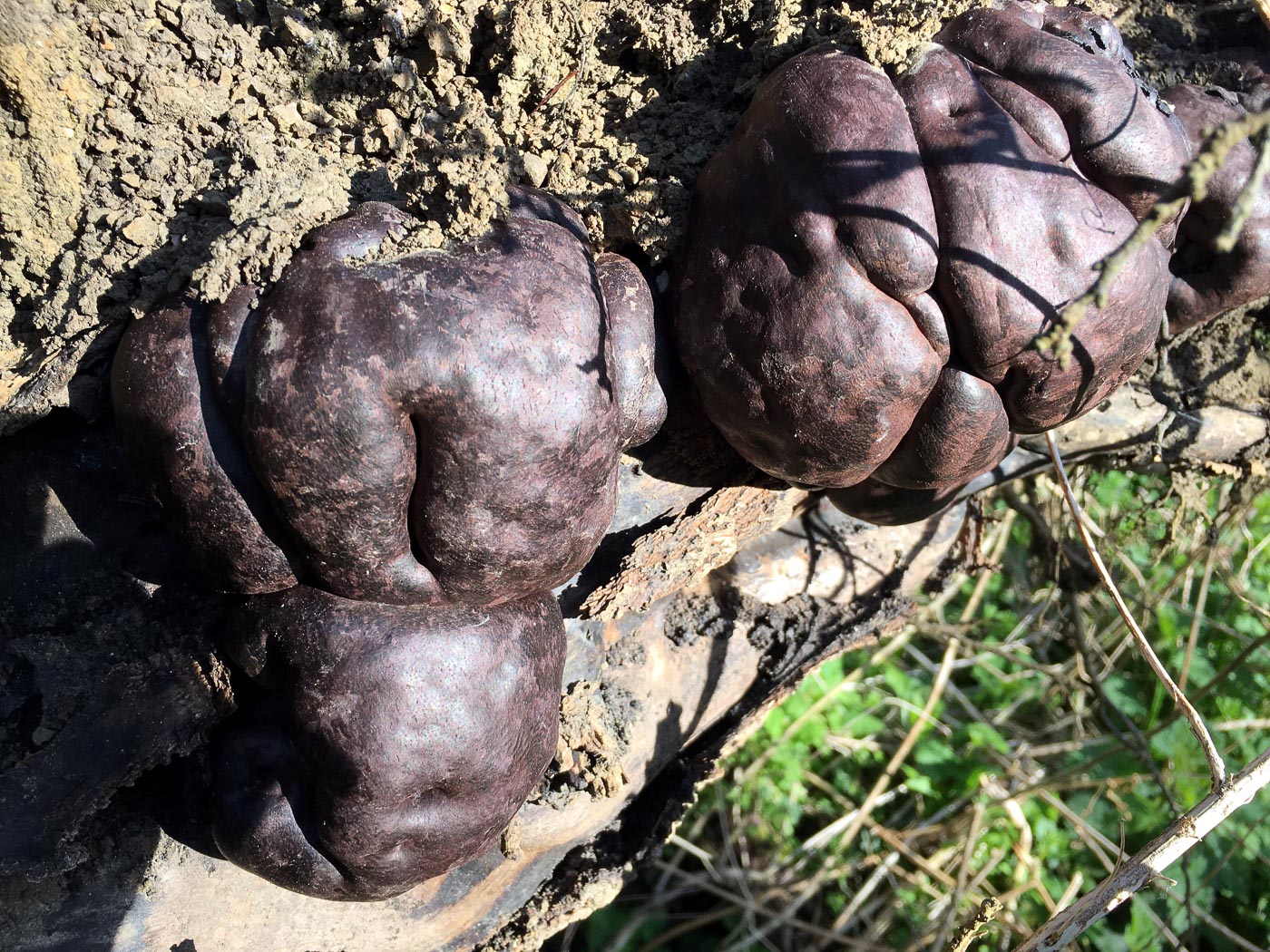
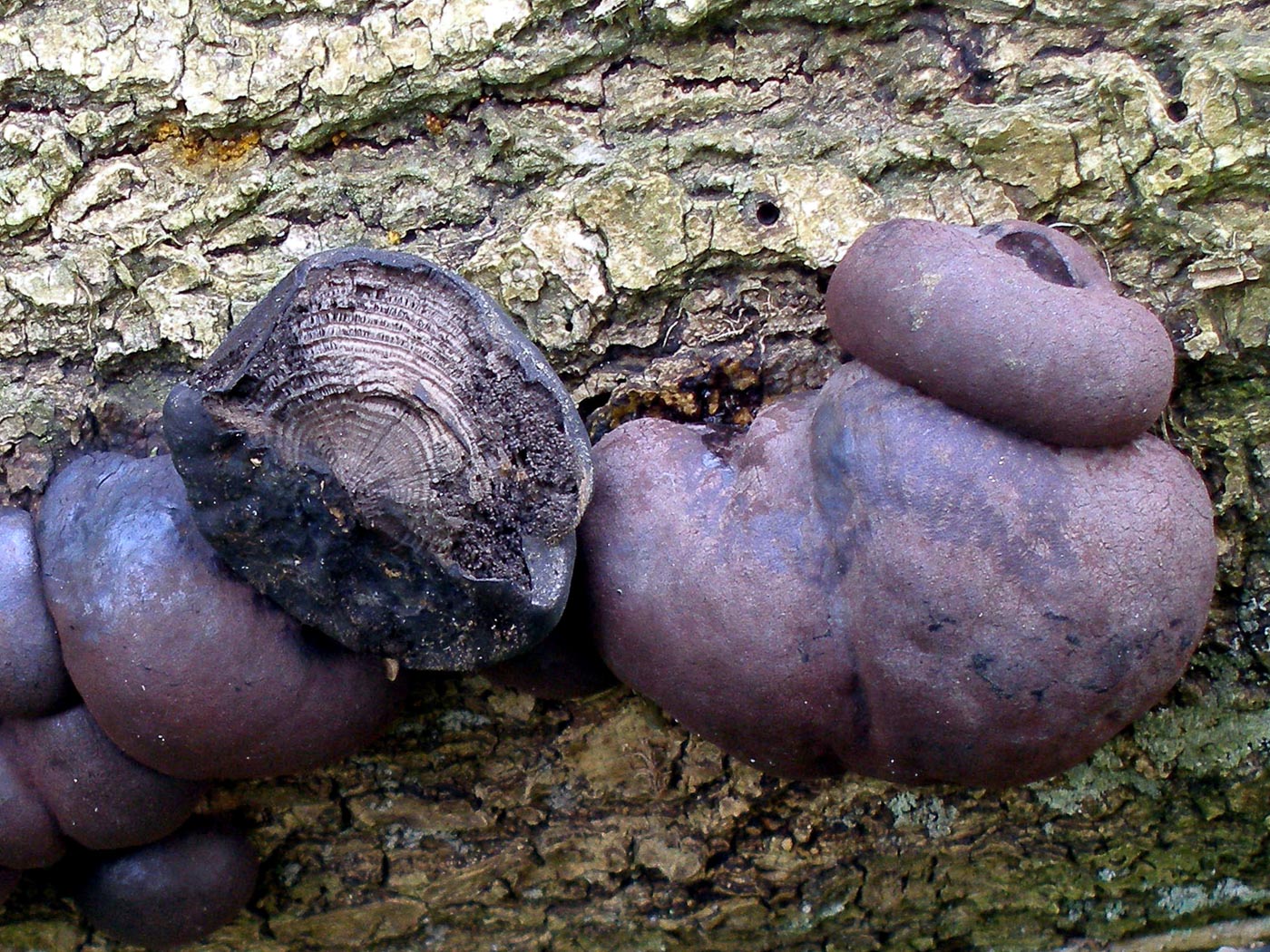 |
April 4th Daldinia concentrica (King Alfred’s Cakes / Cramp Balls)
Joanna Dodsworth found these huge specimens of fallen Ash near Tram Hill Ponds on Brill Common - they were each apparently 10-12 cms across which is probably about as big as they get! This common Ascomycete is host specific to Ash (though there are other much less common Daldinia species found on other substrates) and starts out chocolate brown covered with a whitish 'bloom' turning black with age. Break one open to reveal the concentric rings within which give rise to its species name. Photo 2 (one of Penny's library photos) shows these features, as do those dated Oct 10th in Finds 2020).
|
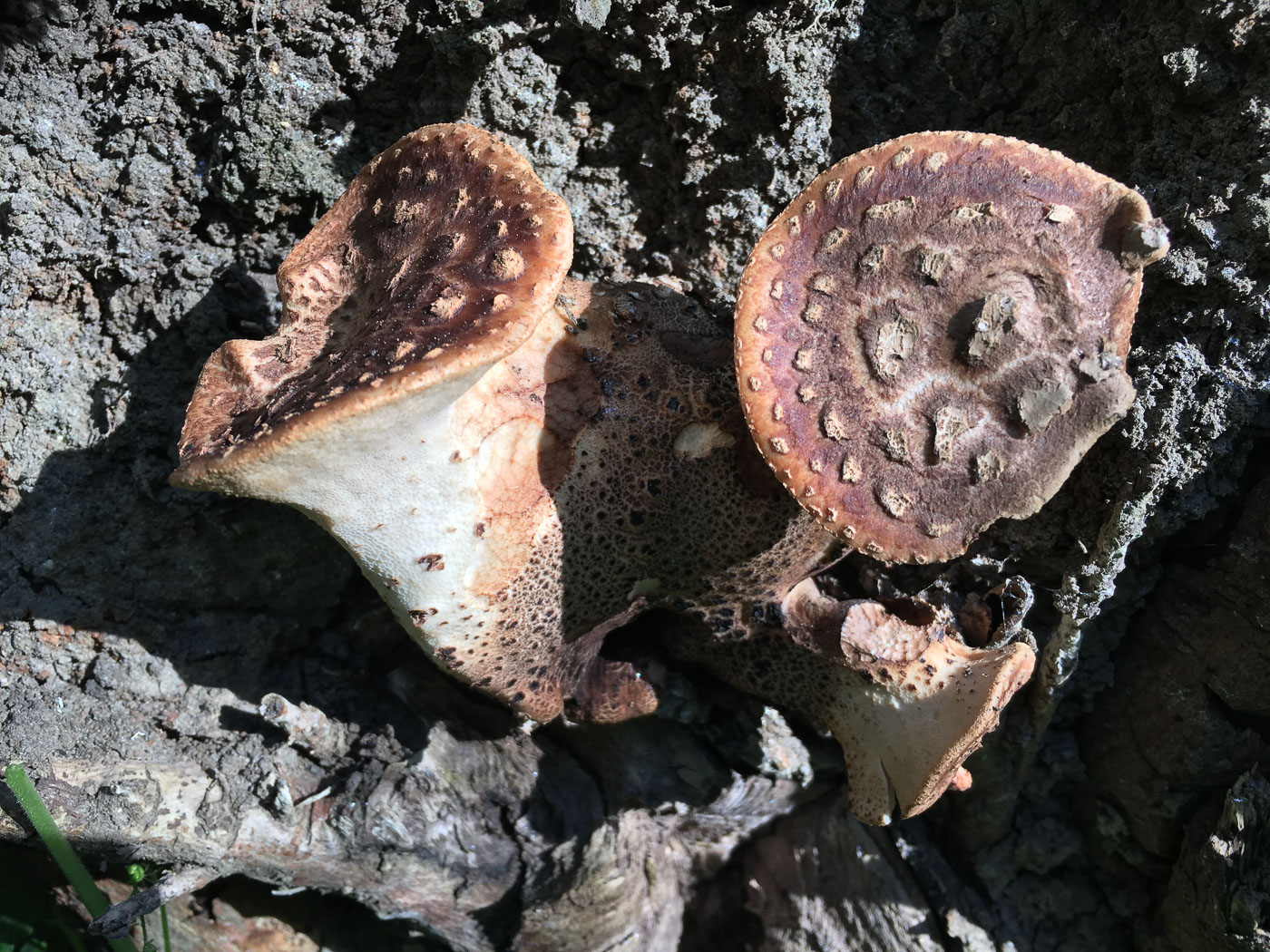 |
April 4th Polyporus (= Cerioporus) squamosus (Dryad's Saddle)
Joanna Dodsworth noticed these really young fruit bodies on fallen Ash near Tram Hill Ponds on Brill Common. It's difficult to imagine these upright fungi developing into the huge saddle-shaped brackets which this species produces, but Joanna reminded me of the smaller of the two photos in Roger Phillips Mushrooms which illustrates exactly this point. See also Finds 2021 dated Mar 31st for another recent young example, and for the fully mature monster see Finds 2020 dated Sept 30th - another of Joanna's photos from this same site.
|
April 2nd 2021
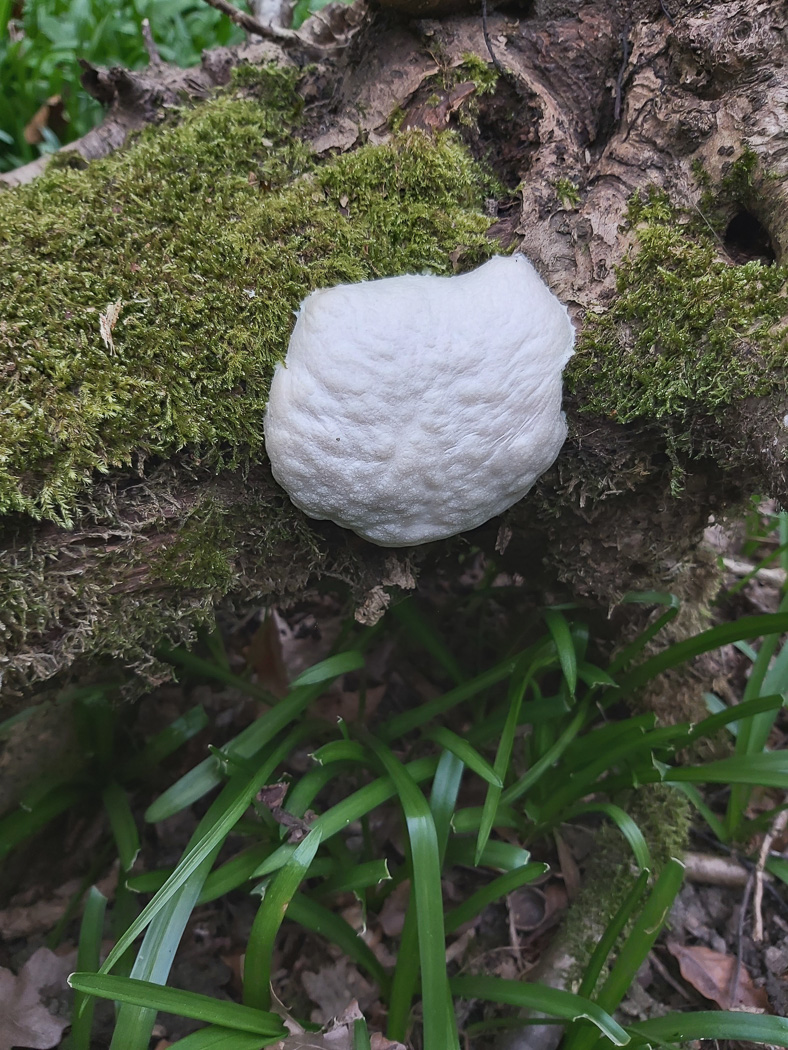 |
April 2nd Reticularia lycoperdon (False Puffball)
Jesper Launder found this large slime mould in Hodgemoor Woods growing on Hazel - one of several examples he's seen in the last few days. Contrary to most slime moulds which are tiny and inconspicuous, this one can indeed get to the size of a puffball (hence its common and species name). It starts out at the plasmodium stage as many others: a large bumpy white blob looking a bit like insect eggs - this is the slimy stage. Then instead of developing into many separate tiny sporangia (fruit bodies) as it dries off and matures, it stays as a large white lump (an eyeball!) becoming smooth until eventually splitting open to reveal the brown spore mass within. Jesper's example is just at the beginning of the smooth stage. See also Finds 2020 dated Sept 20th.
|
April 1st 2021
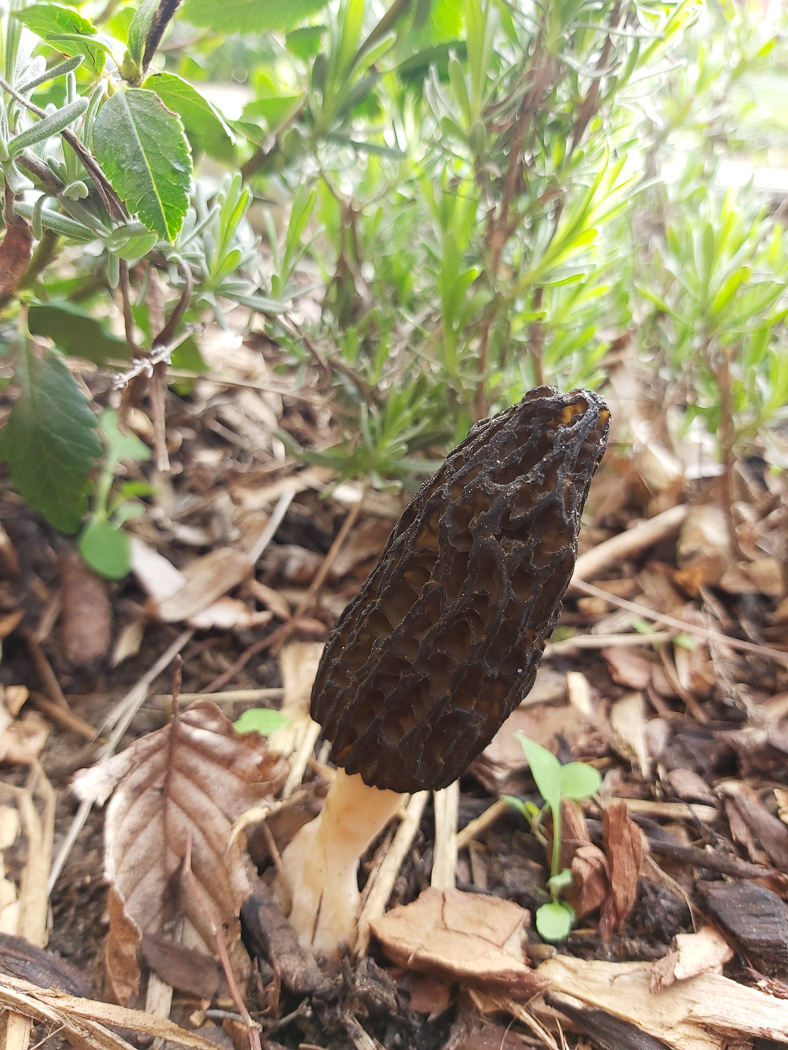
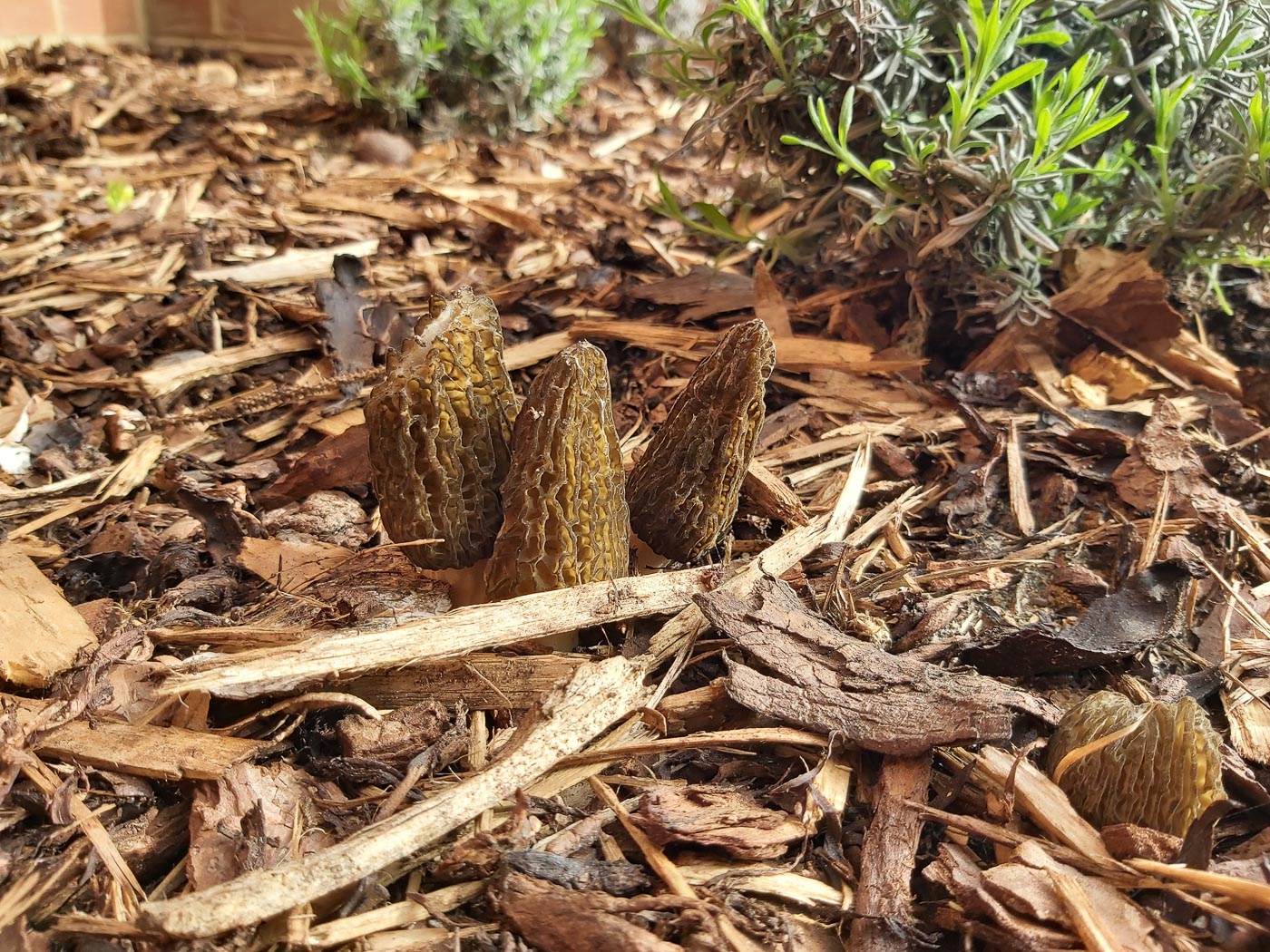 |
April 1st Morchella elata (Black Morel)
Jesper Launder found this beautiful springtime species in a private garden in Chalfont St. Giles. Though we have just two other county records this particular species is not a rarity and can often be found in good numbers in gardens fruiting on Pine woodchip which is suitably aged - as it was here. As the use of this garden commodity increases so it appears does the occurrence of the fungus, though it seems that it uses up the necessary nutrients in one fruiting and thus does not reappear the next year. So if you have pine woodchip in your garden it would be worth keeping an eye out for this tasty fungus!
|
March 31st 2021
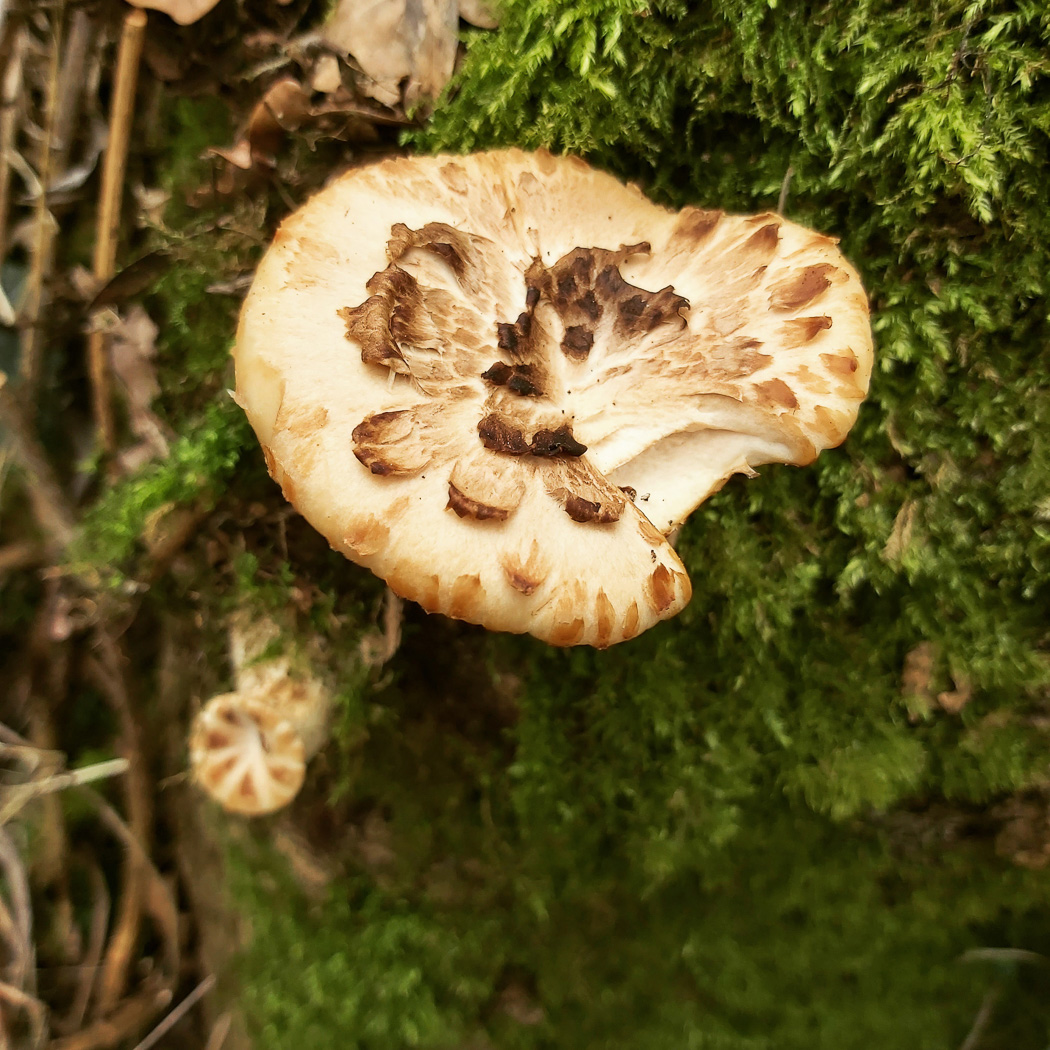 |
March 31st Polyporus squamosus (Dryad's Saddle)
Jesper Launder spotted this early fruiting of the largest of our Polypores in woodland near Layter's Green. Incidentally the correct name for the species is now Ceriporia squamosa though thankfully the common name at least provides some continuity for the long suffering mycologist! This is a species often found on Ash but not exclusively so, also one quite commonly finds enormous and decaying fruit bodies on the ground having fallen from a height - it can often be 20 ft or more up the trunk. See also Finds 2020 dated Sept 20th.
|
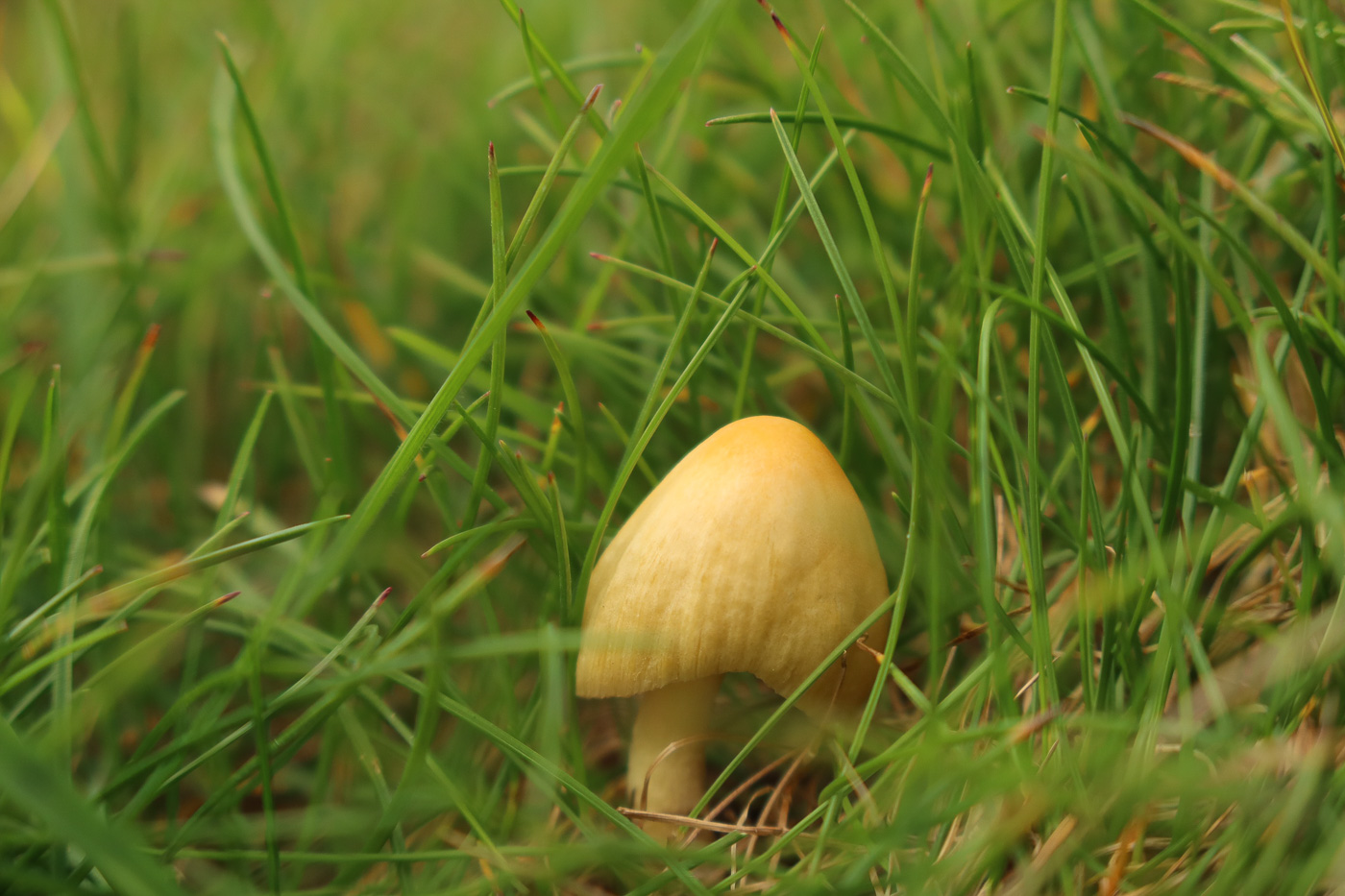
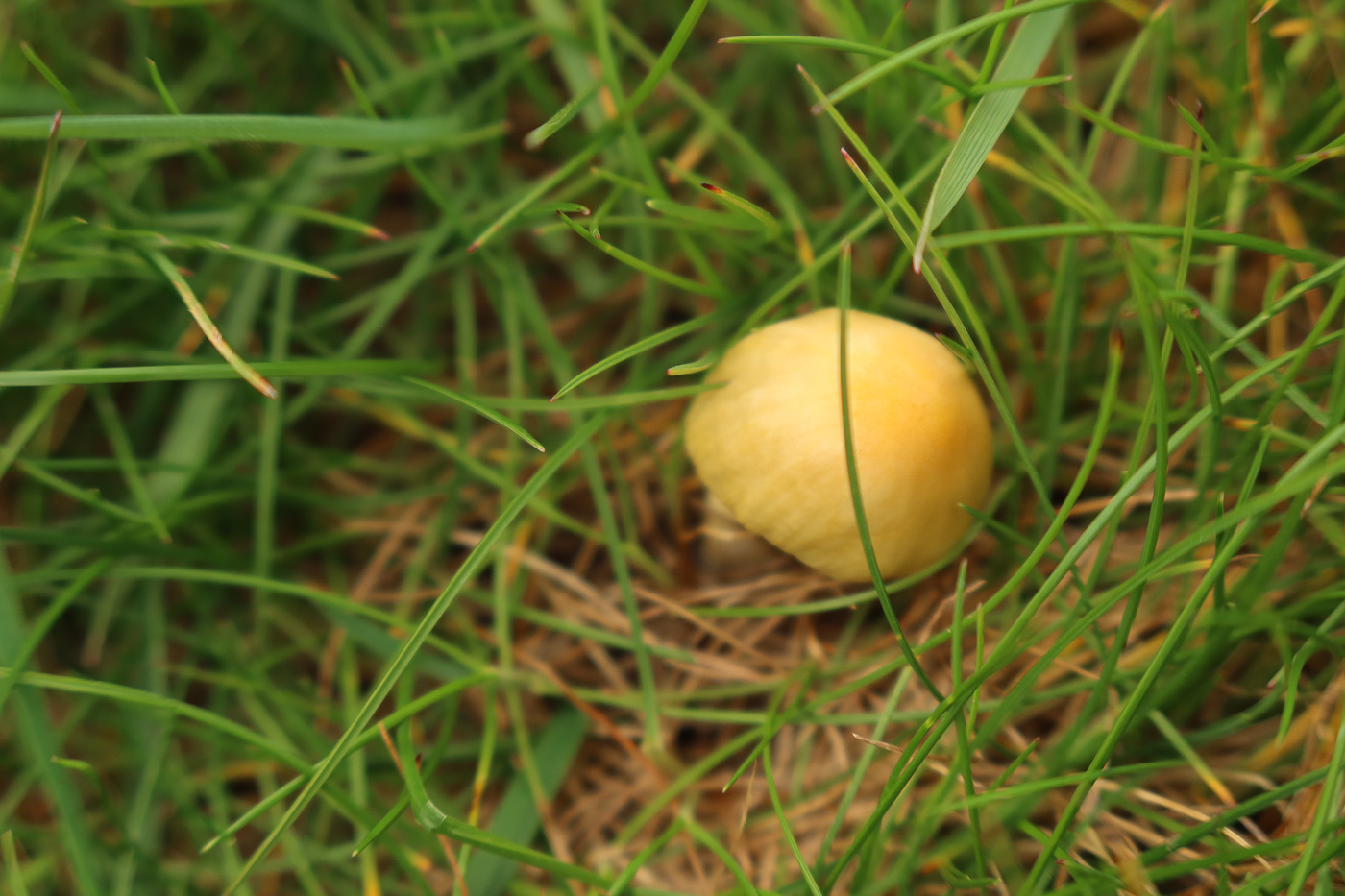 |
March 31st Bolbitius titubans (Yellow Fieldcap)
Claire Williams found this pretty grassland species on West Wycombe Hill. It is easy to see why she at first mistook it for a small yellow Waxcap but thought better of it, coming up with the correct name the next day. This is quite common to find in summer and autumn but we have very few winter or springtime county records for it, so it was a nice find. See also Finds 2020 Sept 29th and Nov 1st.
|
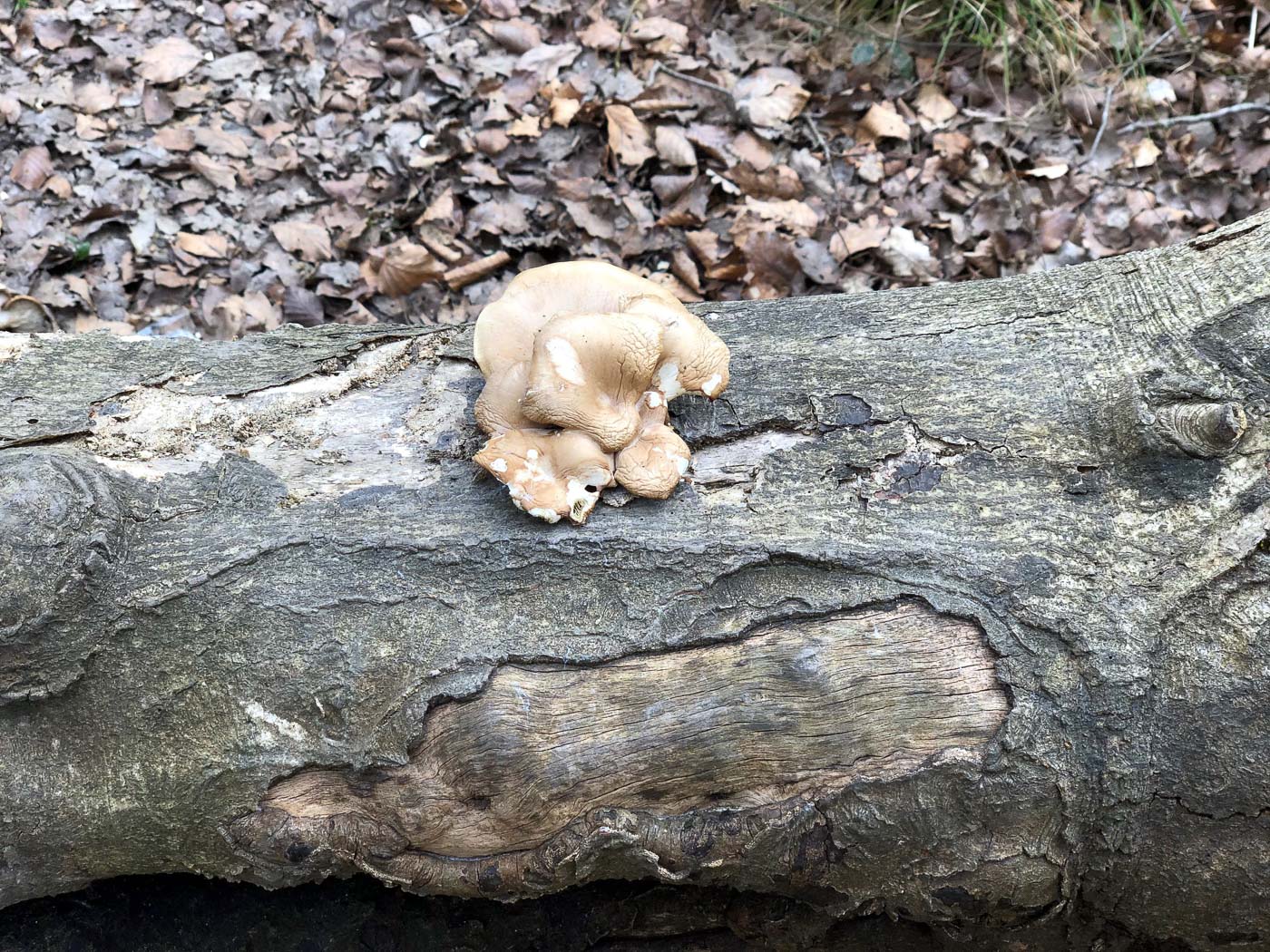
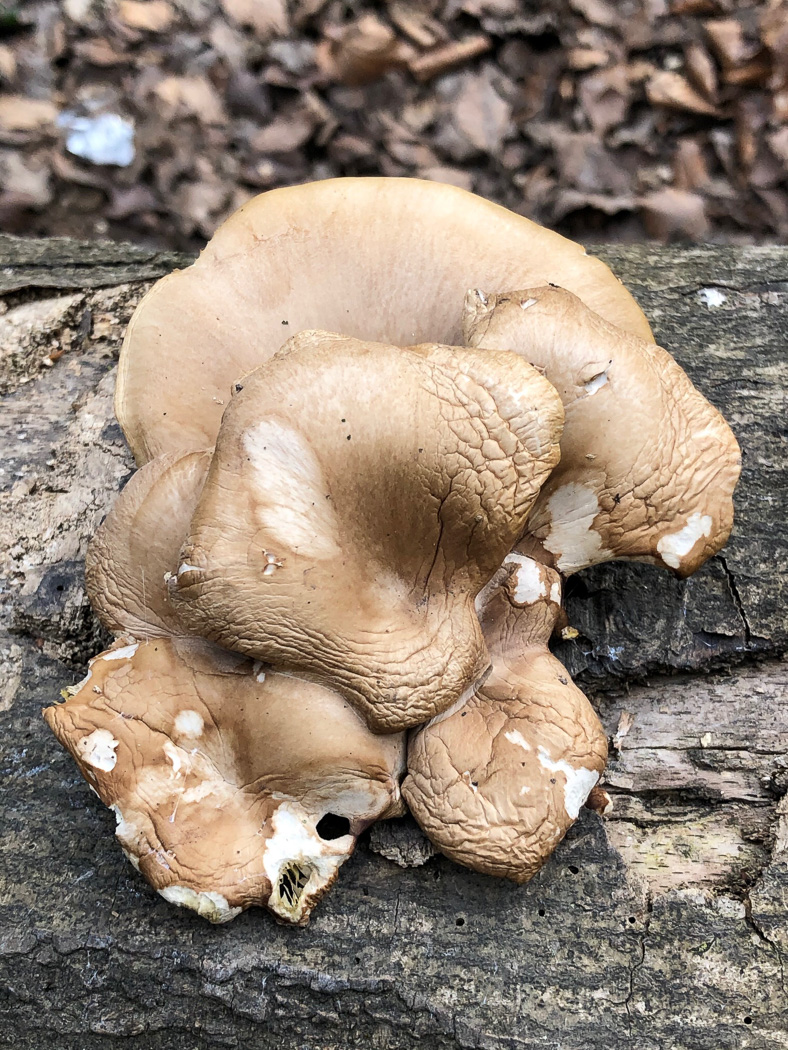
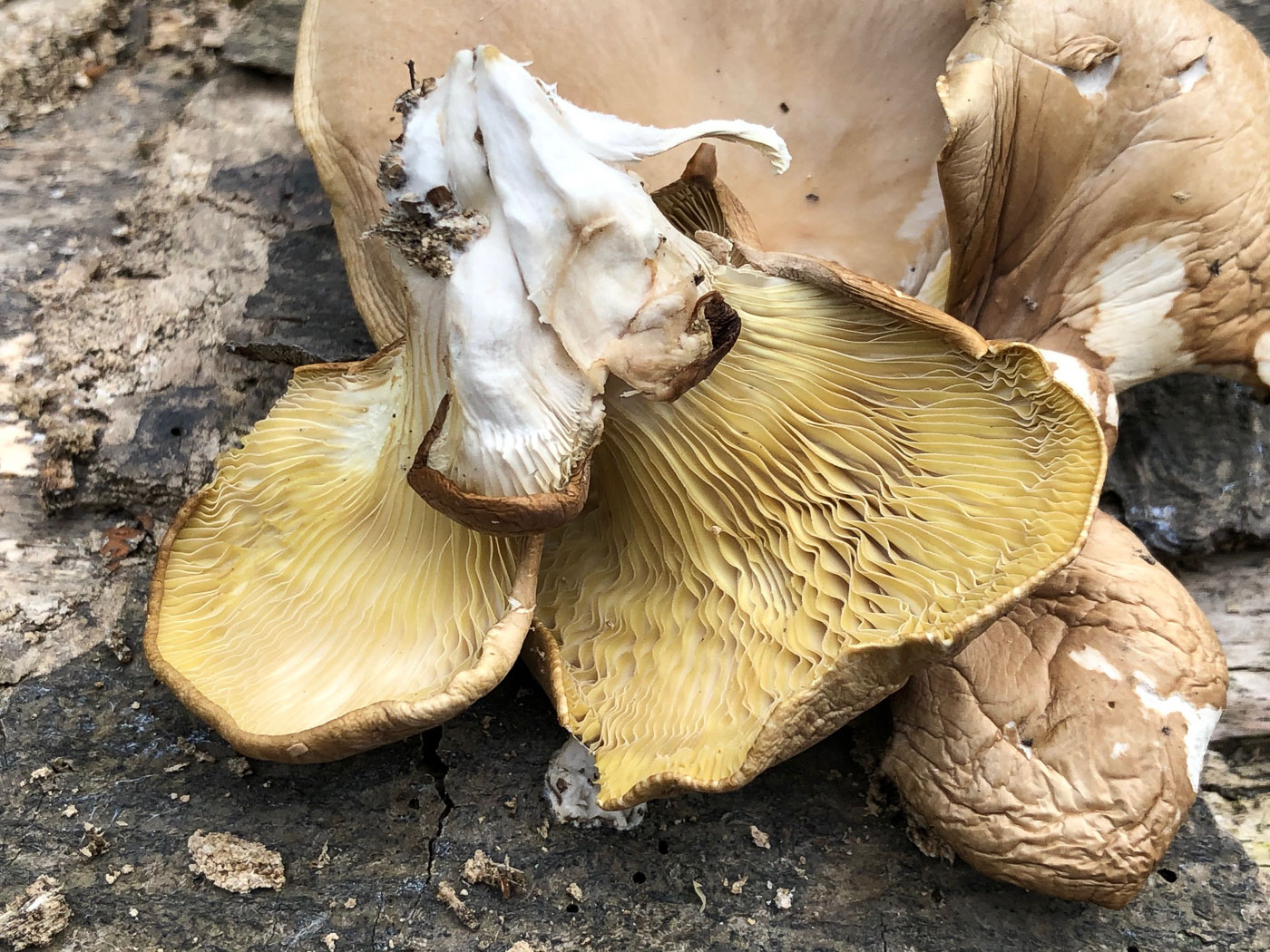 |
March 31st Pleurotus cornucopiae (Branching Oyster)
Paul Goby found this Oyster on a fallen Beech trunk in Naphill Common - clearly having shrivelled a bit after our hottest day of the year yesterday. It is often tricky to separate this species from the very similar and more common P. ostreatus (especially from a photo), but taking into account the fused stems, the quite widely spaced gills running right down the stem and the slightly ochre tinted colour, Penny is fairly happy that this is not the commoner species. Open to debate, though ........... (For further examples see Finds 2021 dated Feb 27th, also 2020 dated Sept 6th and 21st.)
|
March 29th 2021
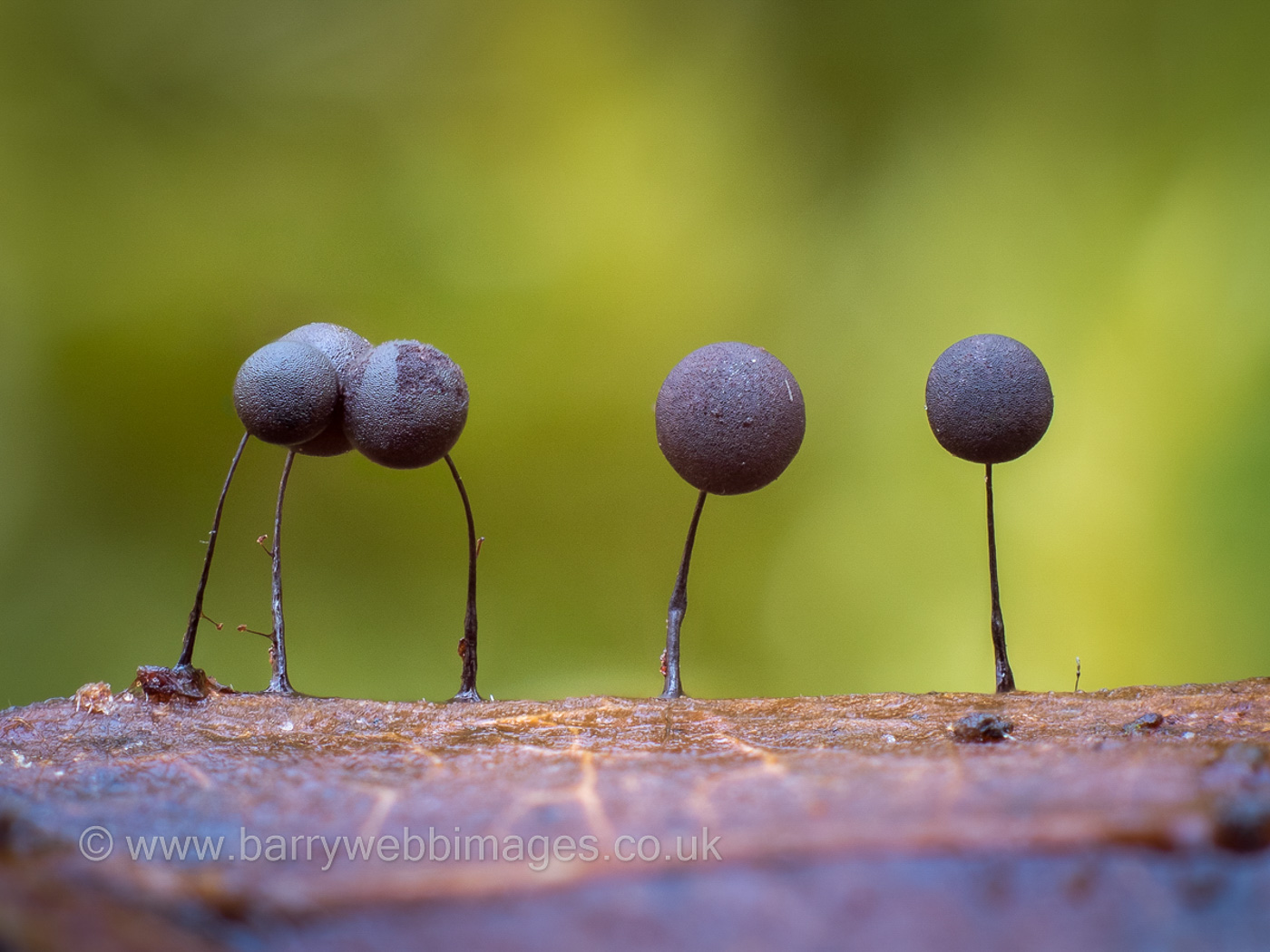
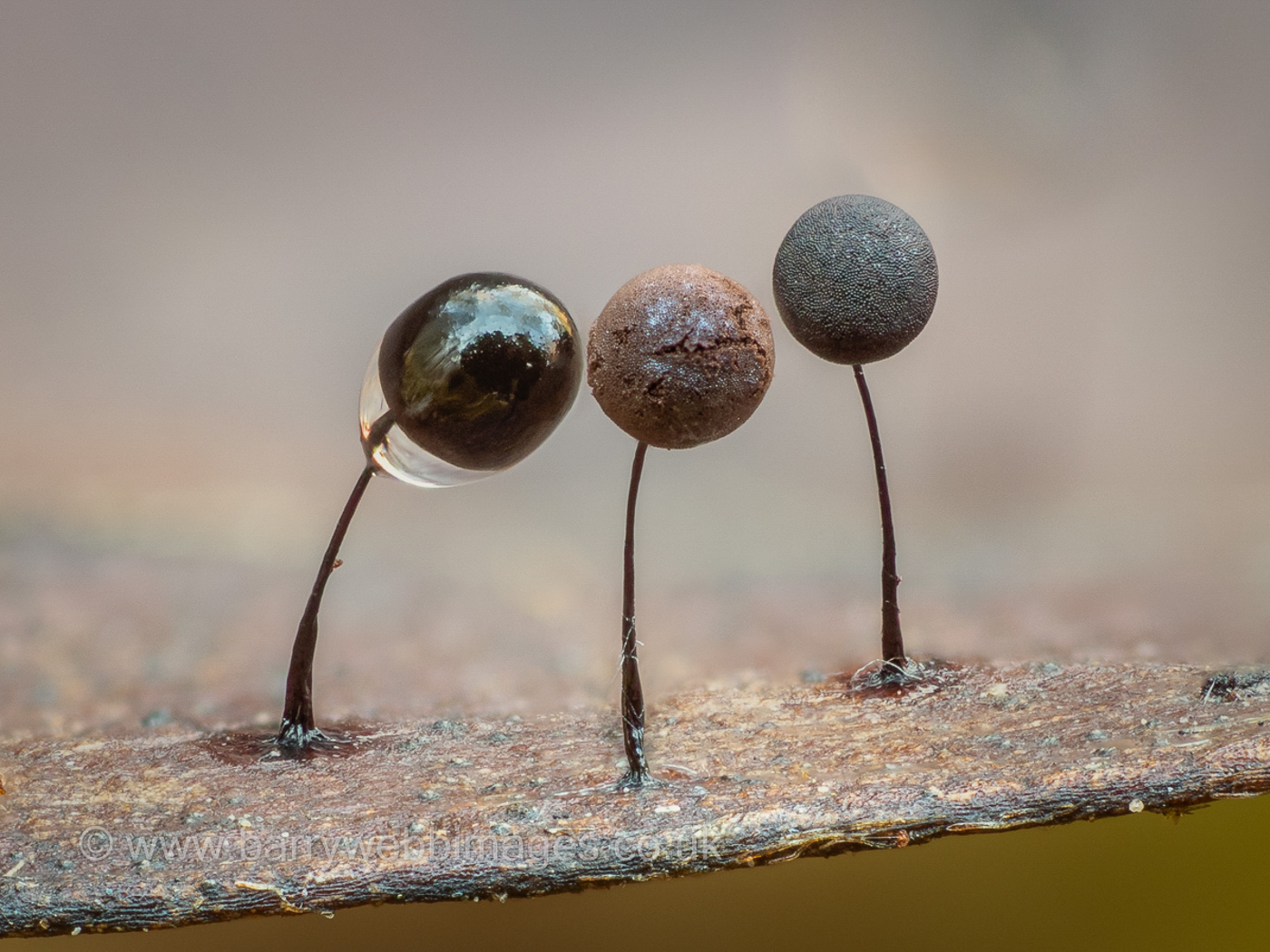 |
March 29th Collaria (= Comatricha) lurida (a slime mould with no common name)
Barry Webb found this very rare Myxomycete in Burnham Beeches on Holly and Beech leaves in a woodchip pile. The species is, however, extremely similar to the much less rare C. elegans, so Penny was a bit sceptical about this determination (made from Barry's excellent photos by a Myxomycete expert online) until Barry said he'd been asked to include a photo of a specimen with the spore mass blown away, revealing the distinctive shape of the columella within (like the skeleton) as well as the collar which forms beneath. The two species are easily separated by their individually shaped columellas, also C. lurida occurs on deciduous leaves, particularly Holly as here, whereas C. elegans occurs on conifer wood - not present in this woodchip pile. Case closed! Not only is this a notable find for the county but there are very few UK records of this species.
|
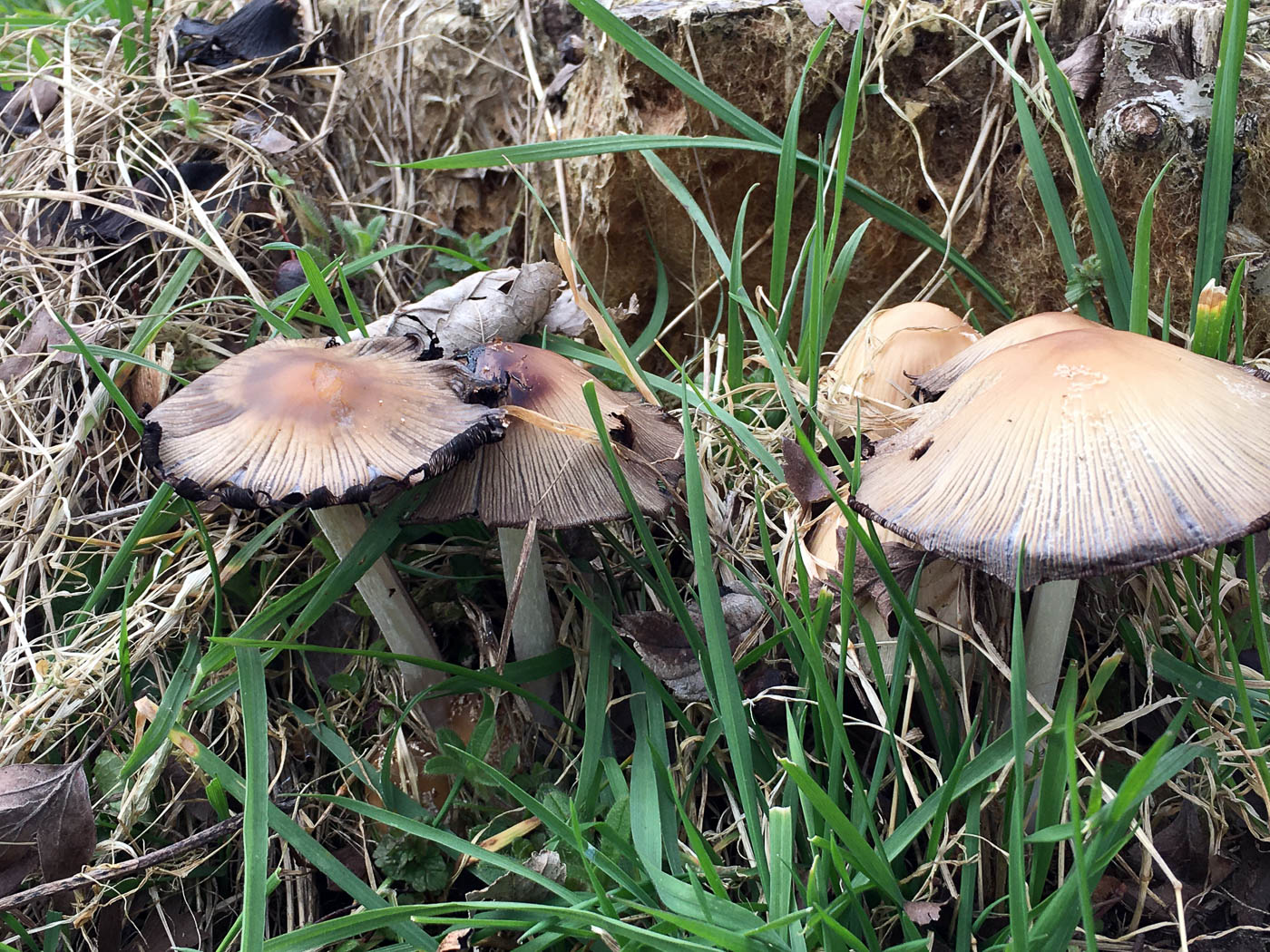
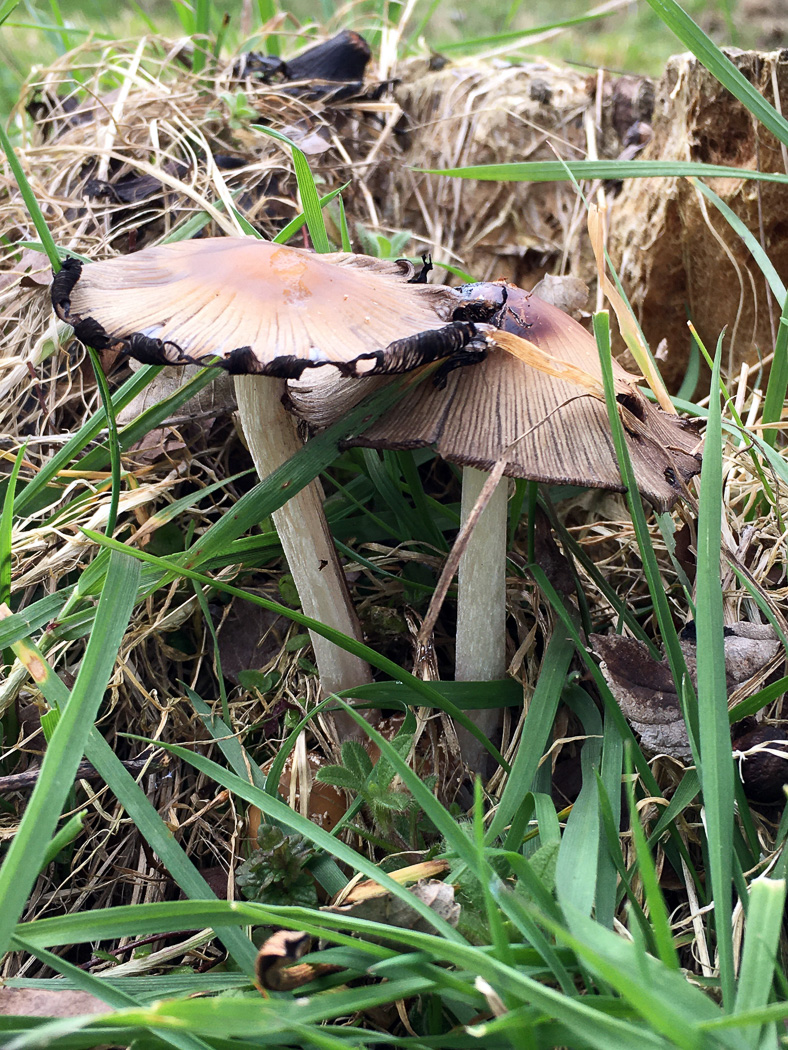 |
March 29th Coprinellus domesticus (Firerug Inkcap)
Joanna Dodsworth found this collection growing in grassy soil on Brill Common and was in doubt as to the possible genus. Being fairly sure it was an Inkcap, Penny asked for Derek's opinion and, thinking that it might possibly be something quite special he decided to make a fresh collection from Brill. Unfortunately it turned out to be not that special but still a nice find as we have only 5 previous county records and a new name for out list.
|
March 27th 2021
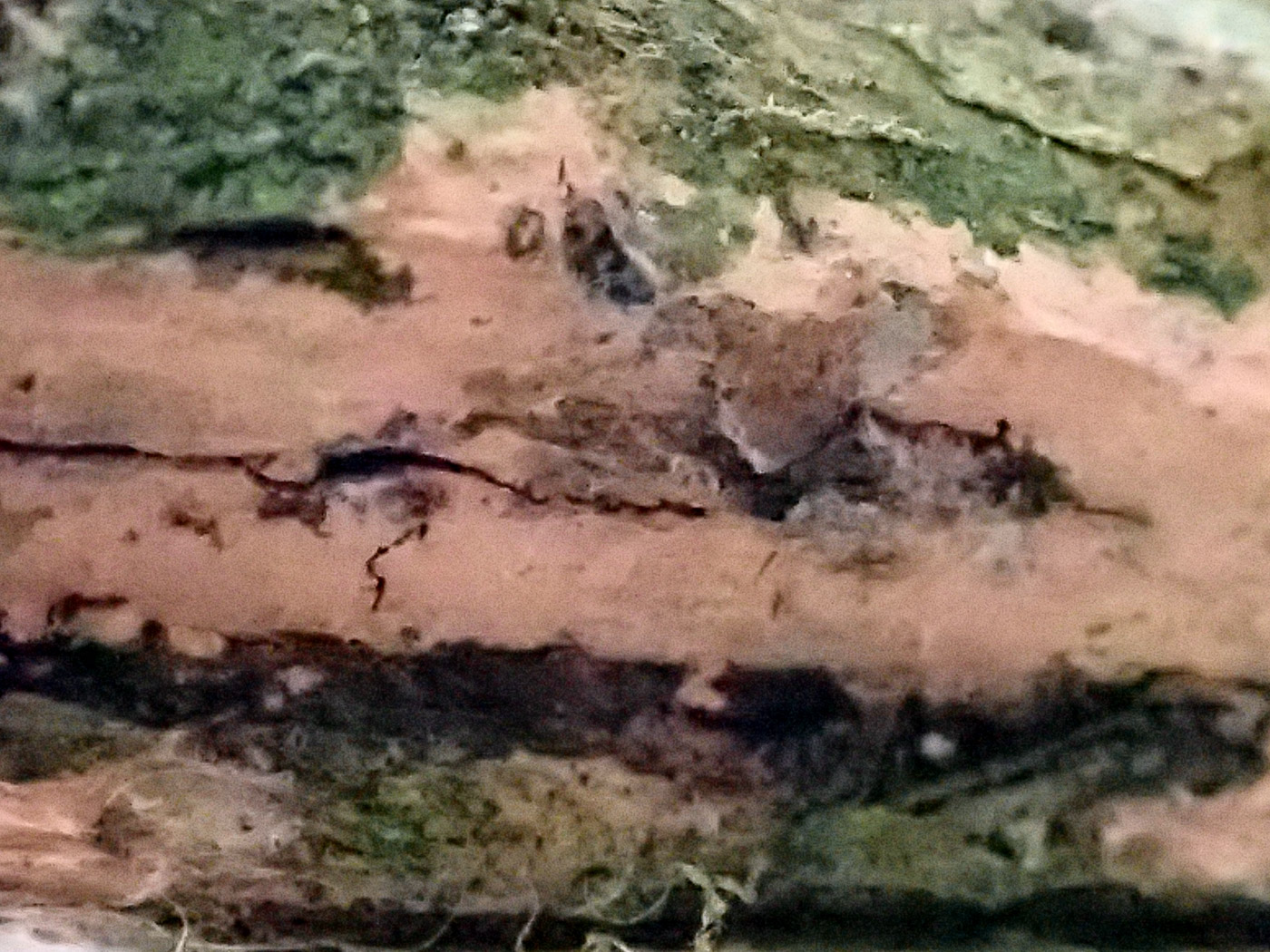
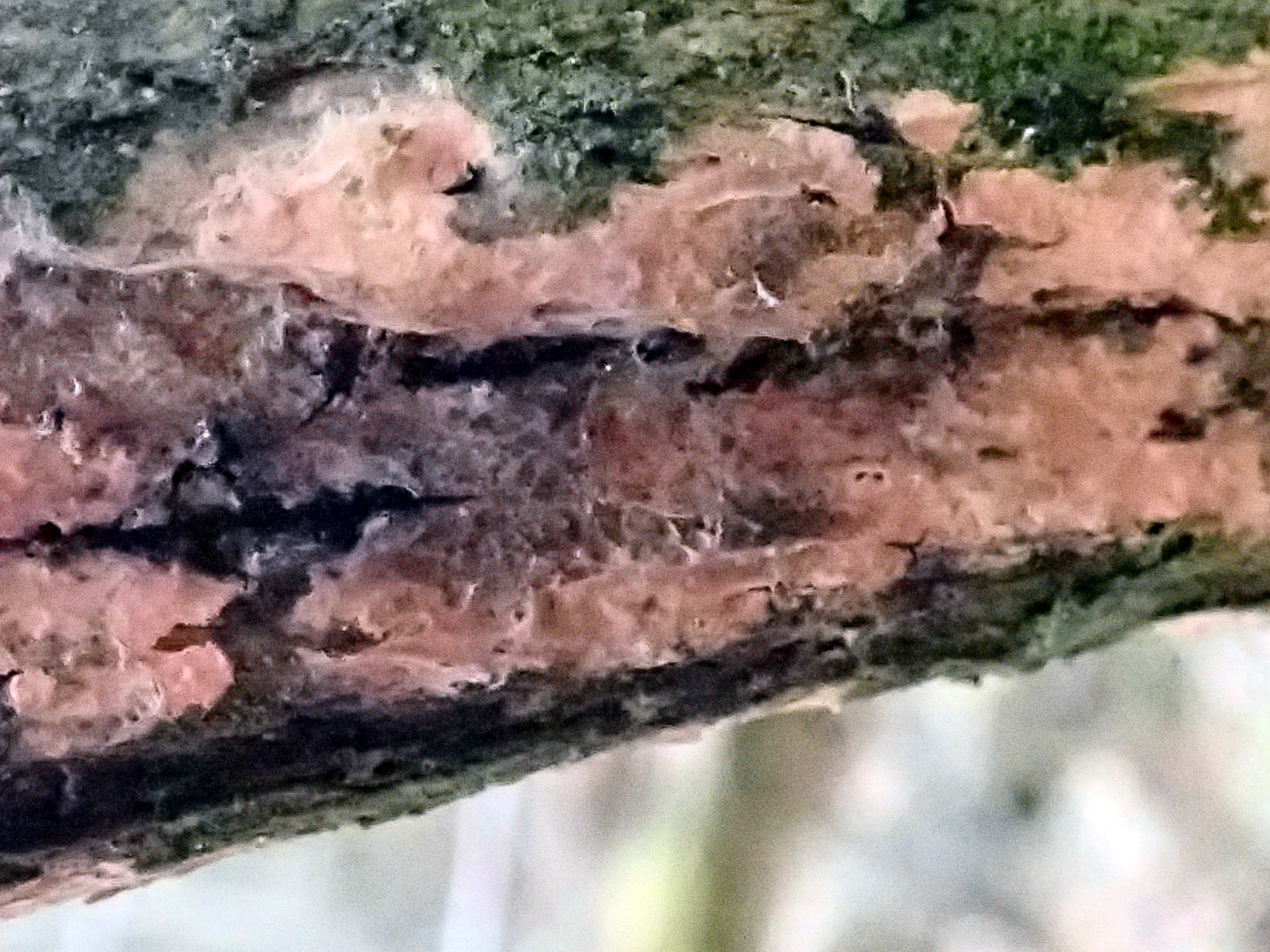 |
March 27th Peniophora incarnata (Rosy Crust) 
Penny ventured into Bucks for the first time today since Christmas! At Turville Heath she found a few very common species to add to our list (which are below) but this was probably the most interesting and unusual: a Corticioid which is common on the stems of Gorse - a plant in plentiful supply here but the fungus with few county records as we don't often encounter Gorse on our woodland walks. Its peachy pink colour makes it an easy one to recognise when on this host though it does occur on other deciduous wood. Nevertheless, as there are a few other pink corticioids it is necessary to check the microscopic characters to confirm.
|
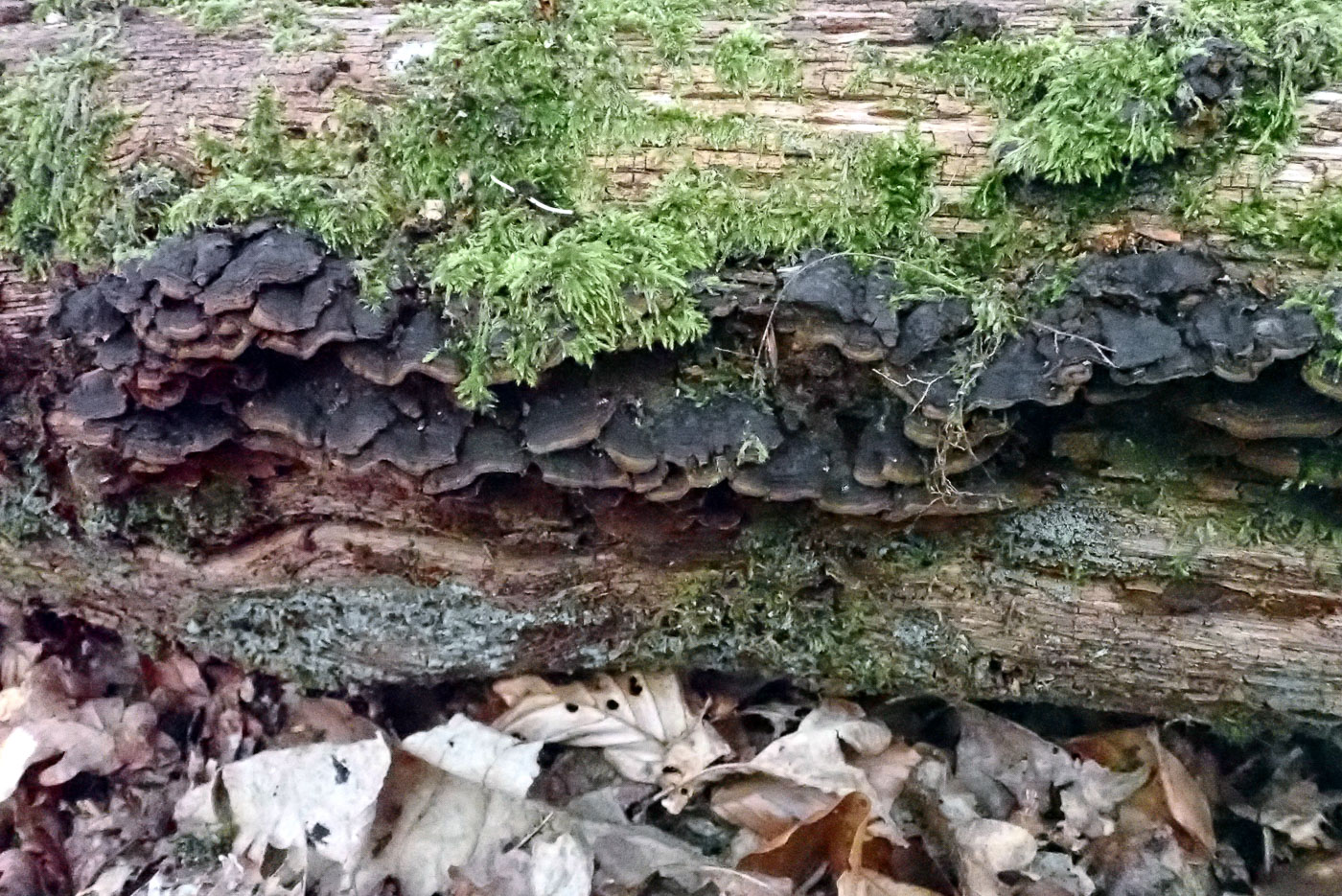
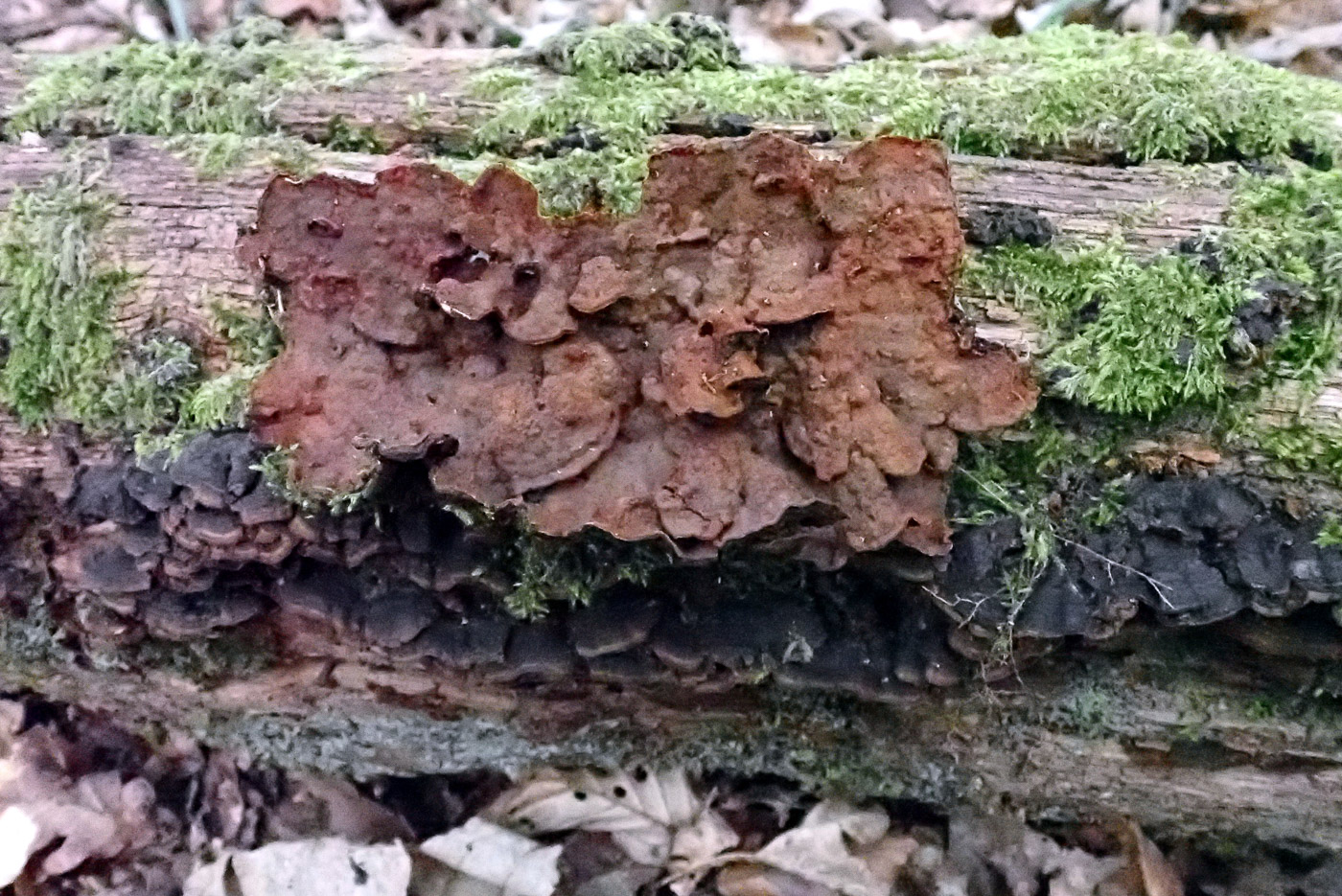 |
March 27th Hymenochaete rubiginosa (Oak Curtain Crust)
On a bare fallen Oak branch at Turville Heath Penny noticed this distinctive bracket. It tends to grow in rows forming quite shallow brackets which are dark brown above and cocoa brown below. Photo 1 shows the typical row of brackets and photo 2 the underside. It is very common on Oak though apparently can occasionally be found on Sweet Chestnut. See also Finds 2020 dated Oct 19th.
|
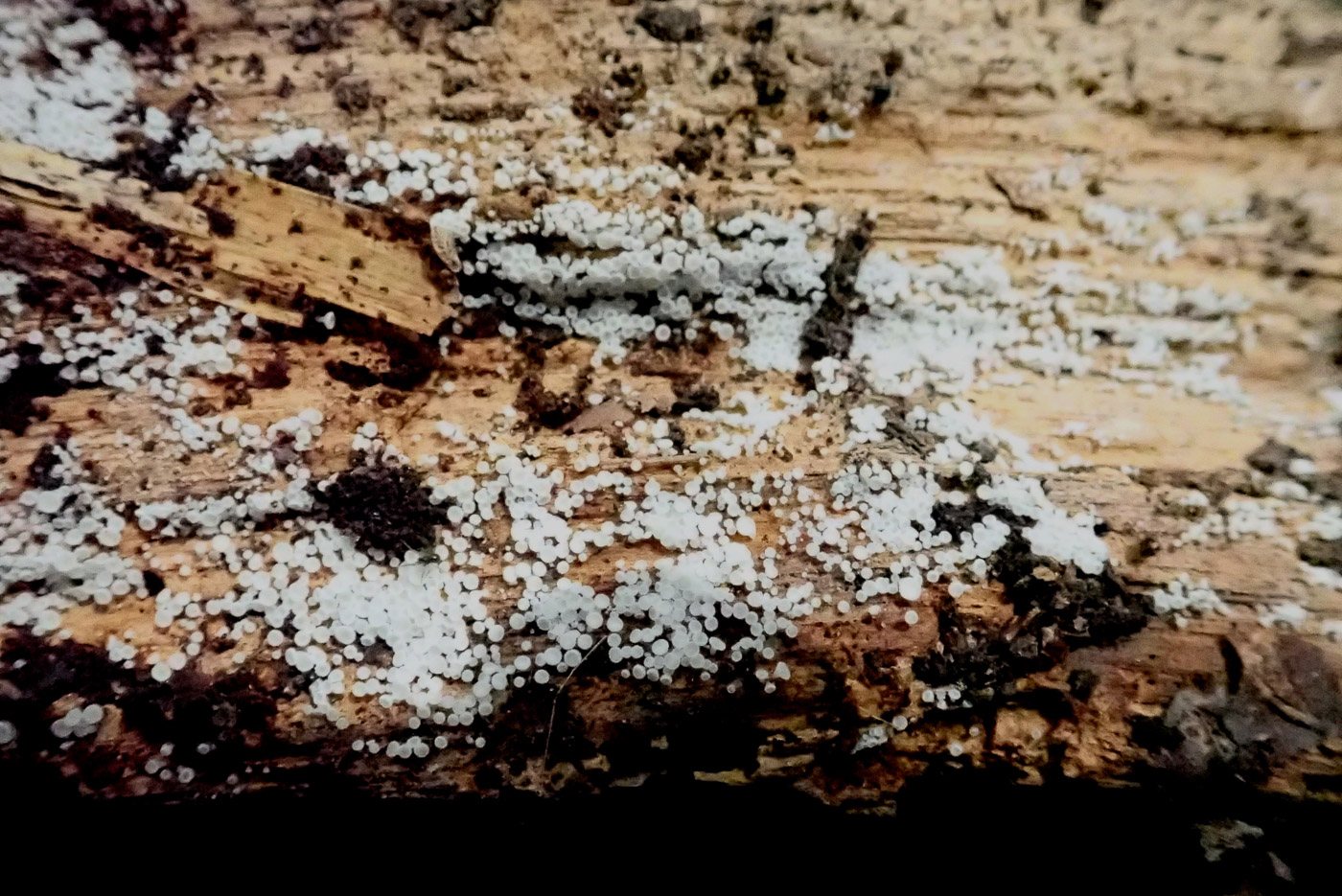
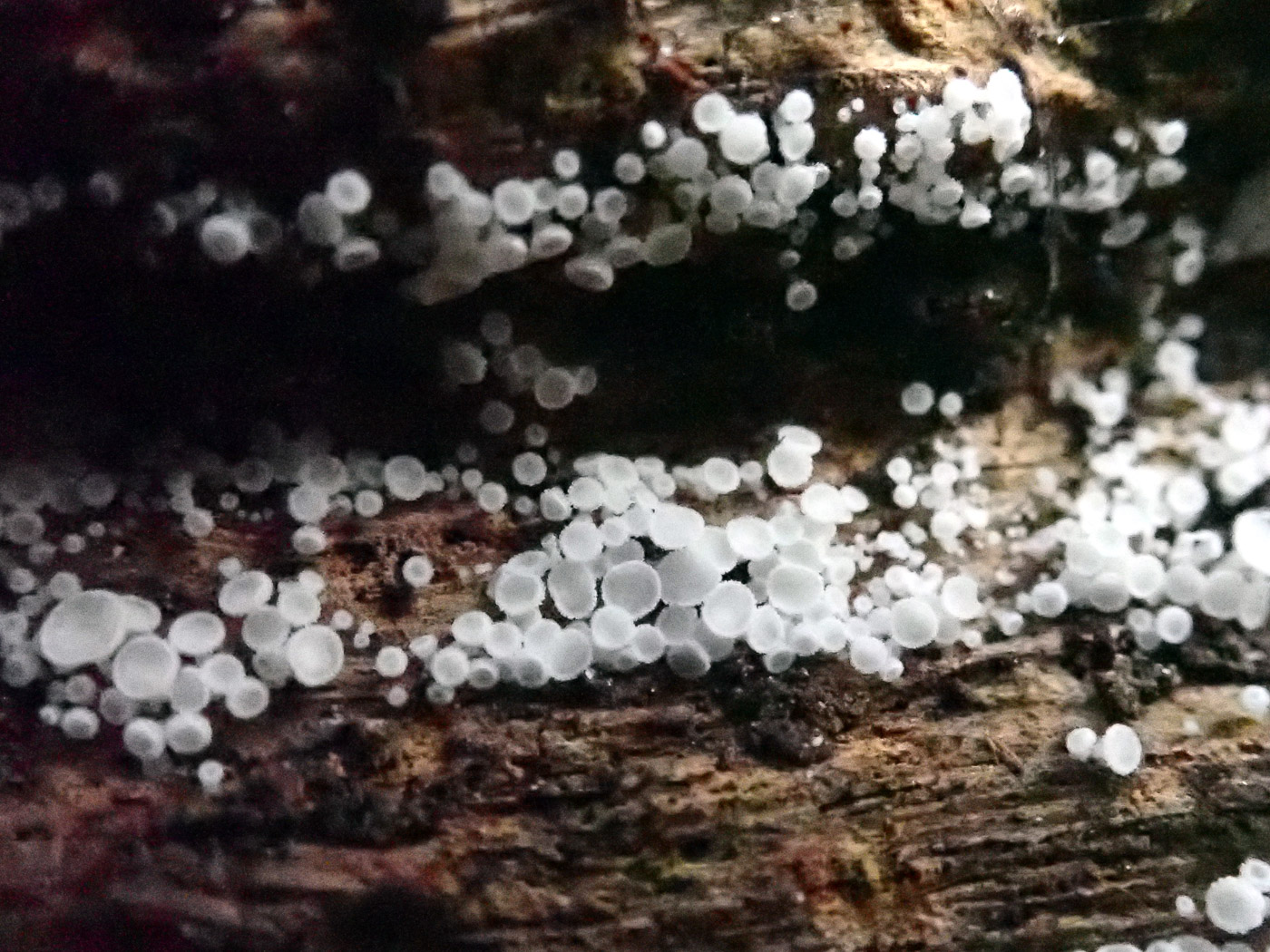 |
March 27th Lachnum virgineum (Snowy Disco) 
Turning over a damp Oak log at Turville Heath, Penny noticed a large swarm of tiny white cups which were less than 10mm across and (with a hand lens) had hairy white stems. This could have been one of four possible white species of Lachnum, all relatively common on deciduous wood and extremely similar in the field. A careful look at the hairs under high magnification is needed to determine which species you have, L. virgineum probably being the commonest of the four. See also Finds 2020 dated Nov 9th, also Sept 20th for another of the four species. (Apologies: these are not the greatest photos.)
|
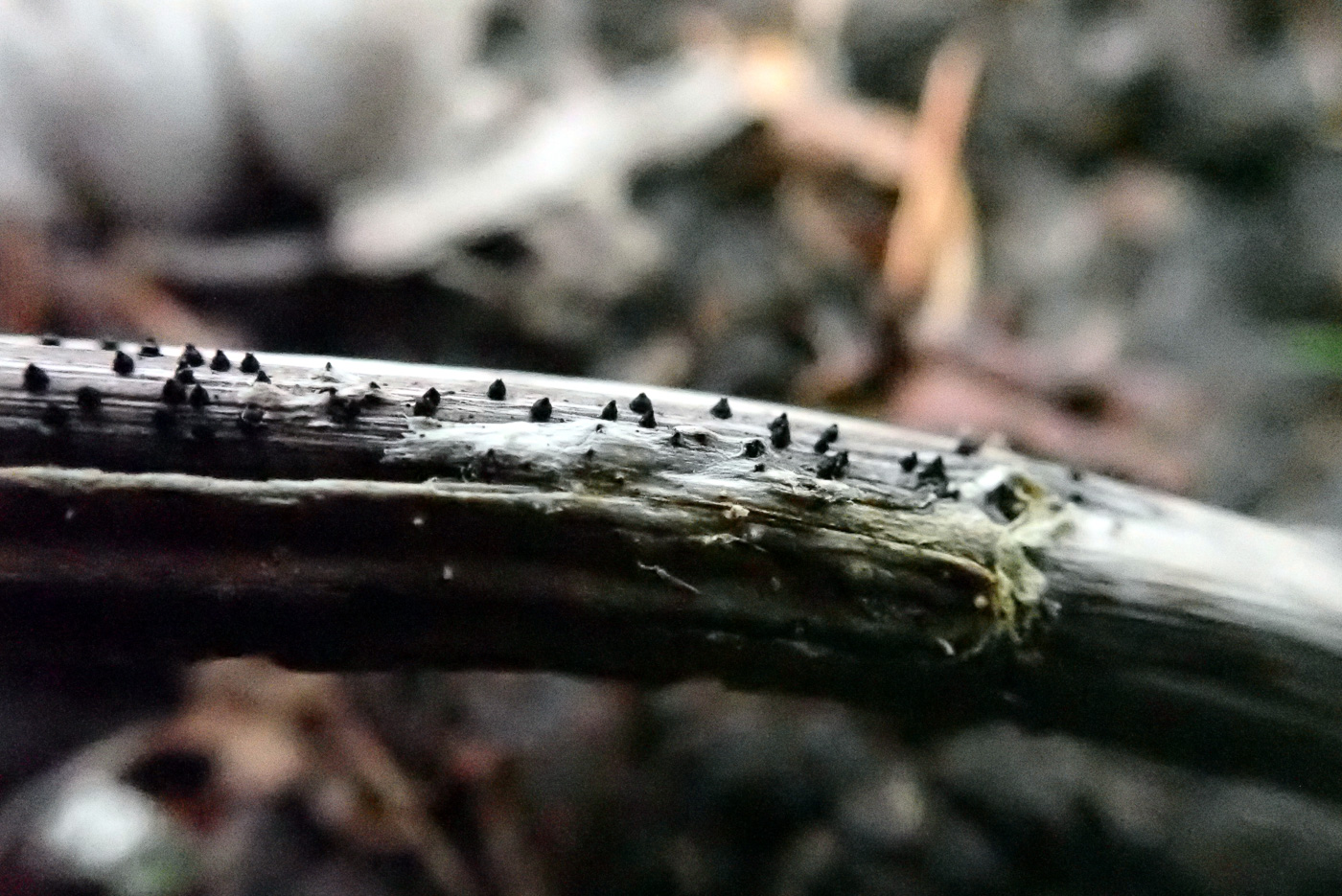 |
March 27th Leptosphaeria acuta (Nettle Rash)
At Turville Heath Penny pulled up a dead nettle stem to find this very common springtime Ascomycete - a species one can almost add to any foray list where nettles occur before actually locating it (ie affectionately known as a 'bums on seats' species!). The tiny shiny black 'wigwams' - less than 5mm across - are easy to spot with a hand lens on the pale stem bases of nettles at this time of year.
|
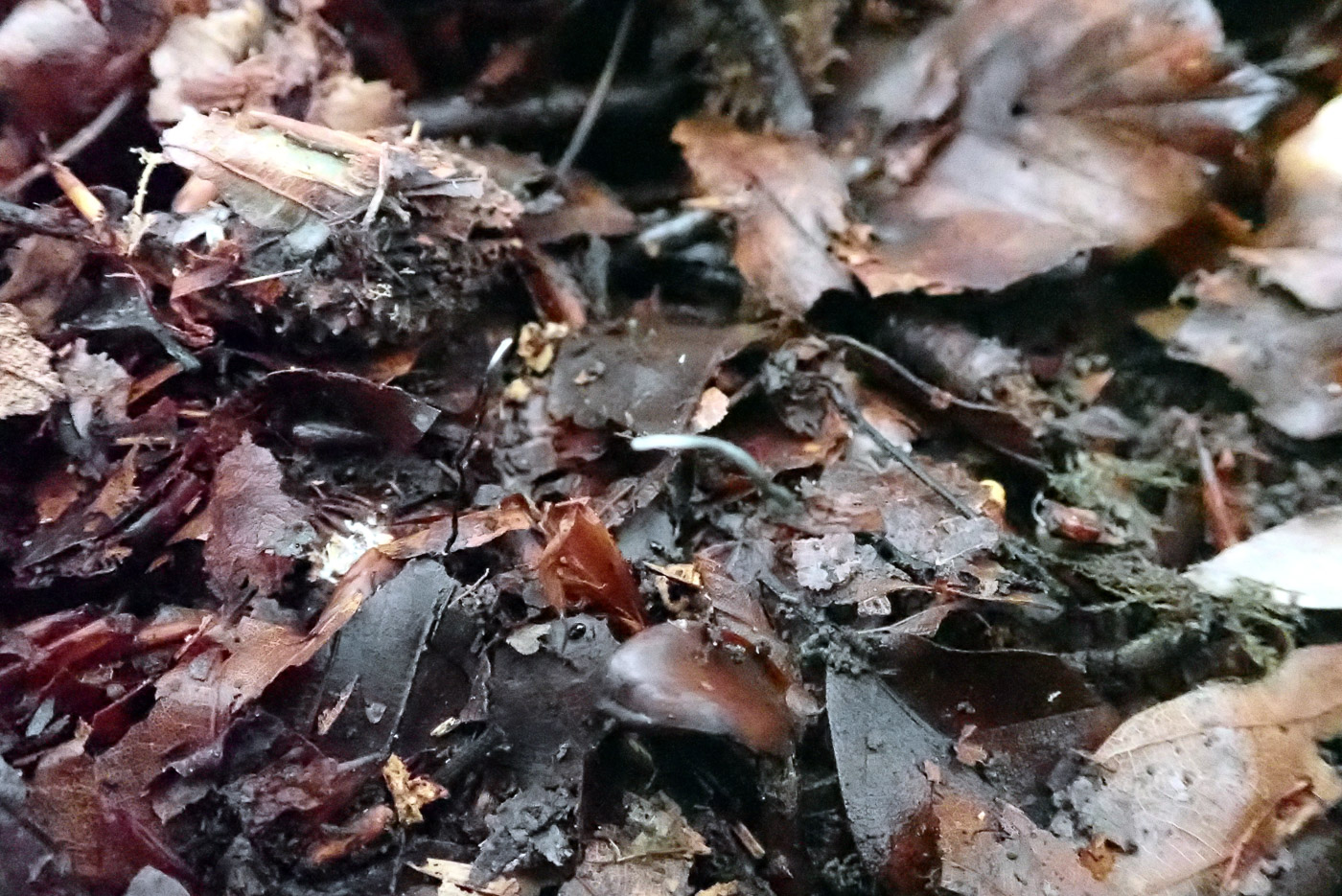
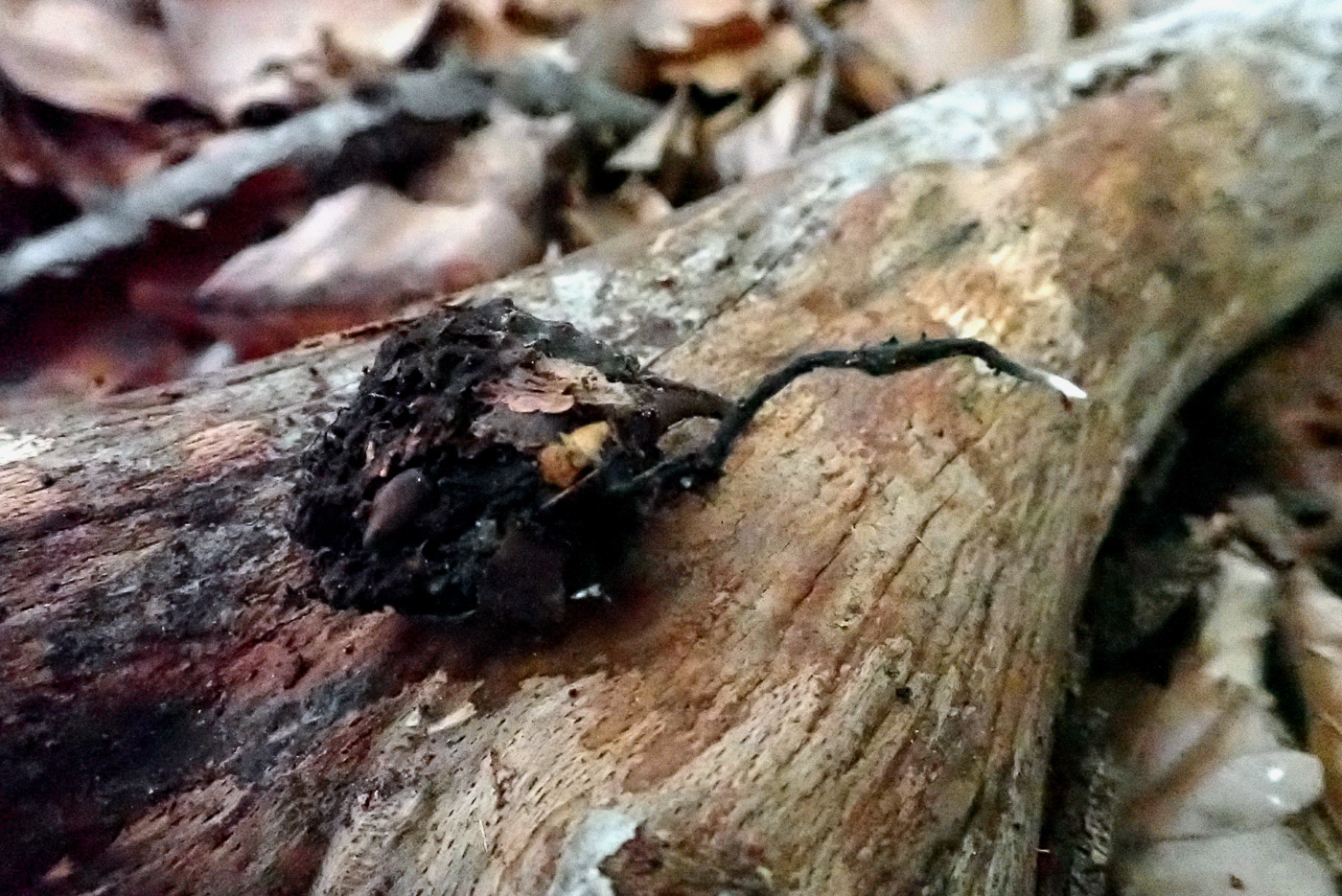 |
March 27th Xylaria carpophila (Beechmast Candlesnuff)
At Turville Heath Penny removed the top dry layer of beechmast to uncover another very common springtime Ascomycete found solely on damp Beech cupules. Another 'bums on seats' species, this one is considerably smaller and less conspicuous than its better known relative X. hypoxylon (Candlesnuff) - the familiar autumn species often seen on fallen deciduous wood. Both species have a black stem with a creamy white spore-bearing top section but today's species is almost hair-thin having a fine spike at the top and the stem can be surprisingly extended depending how deeply buried in the mast its host cupule is. You often have to dig around under leaves to find this species but just need to focus on spotting the white tip amongst the mast (photo 1) and then carefully extracting the whole fungus attached to the cupule (photo 2).
|
March 25th 2021
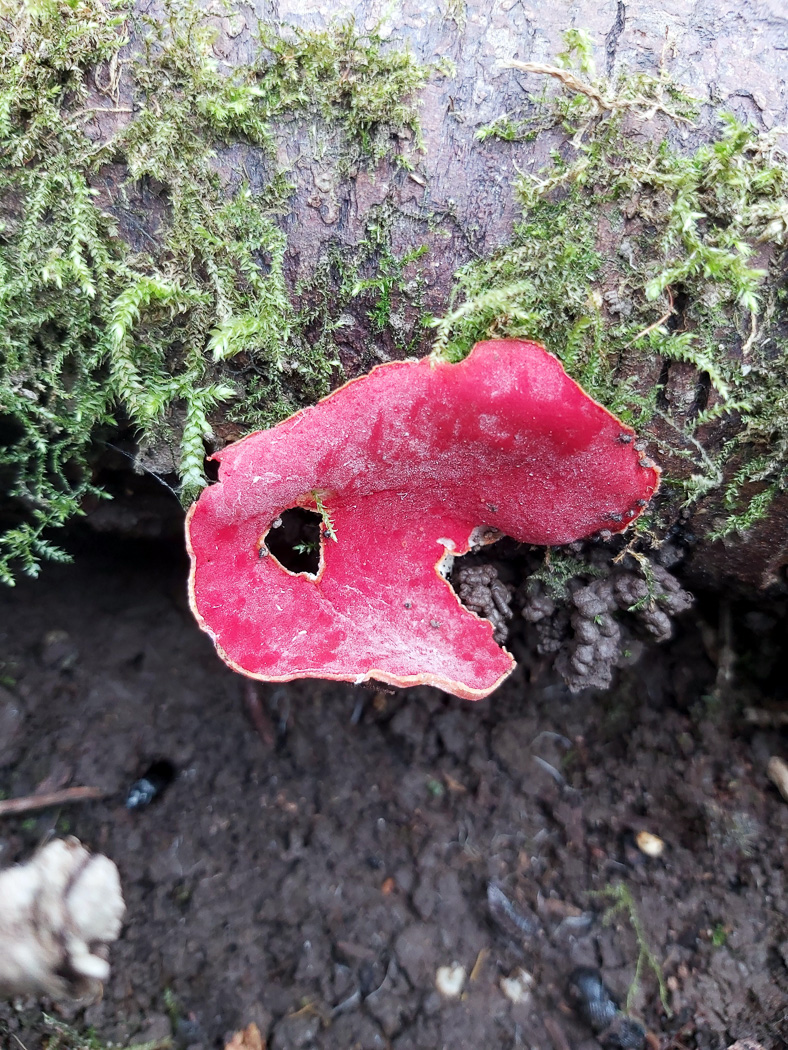 |
March 25th Sarcoscypha austriaca (Scarlet Elfcup)
Jesper Launder noticed this springtime species in woods near Chalfont St Giles though it is probably past its best but still showing the 'wow' factor - always nice to find this one. There are two closely related and extremely similar species - not possible to tell apart without a scope (not used here), but one (S. coccinea) seems to be becoming extremely rare and the other (S. austriaca) appears to be replacing it in the UK. So it has been assumed but not checked that today's find is the common species. Penny has been surprised not to have received more photos of this from around the county because it is such an eye-catching fungus, occurring in damp woodlands on rotting fallen deciduous wood (usually Willow). So one to look out for now.
|
March 21st 2021
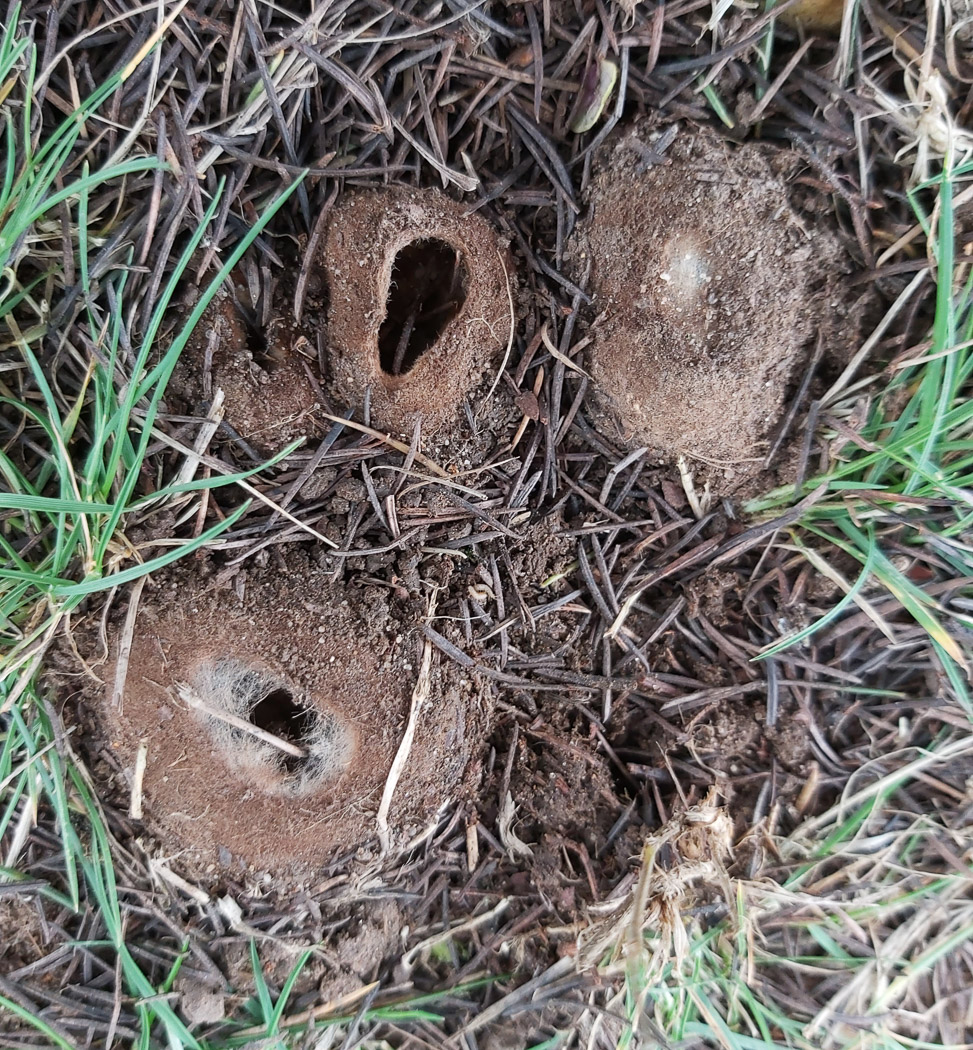
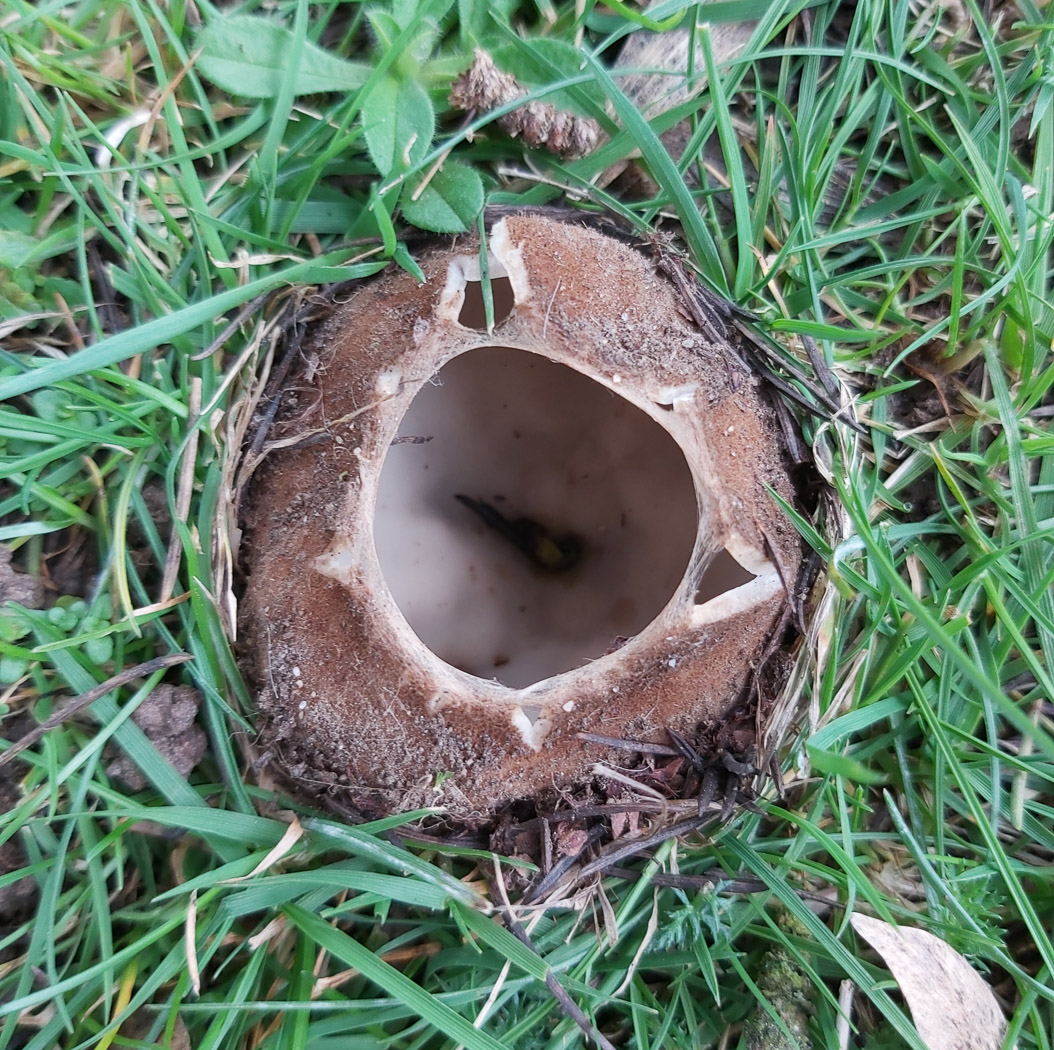 |
March 21st Geopora sumneriana (Cedar Cup)
Under a mature Cedar in Jordans village Jesper Launder has been on the lookout for this uncommon Ascomycete which apparently fruits here regularly. This is a springtime species, appearing from February to May, and is mycorrhizal with Cedar though Jesper comments that it is fruiting three weeks later than usual this year but now coming up in sizeable numbers (40+)! An earlier genus name for the species was Sepultaria, describing its habit of remaining submerged in soil and not showing above the surface until the brown hairy sphere splits open in a starlike fashion to reveal the pale cream spore bearing inner surface. Fruit bodies can get to about 6 cms across. We have just four previous county records but the species is probably much more widespread than this would indicate but just overlooked. So one to look for now if you live near a mature Cedar.
|
March 19th 2021
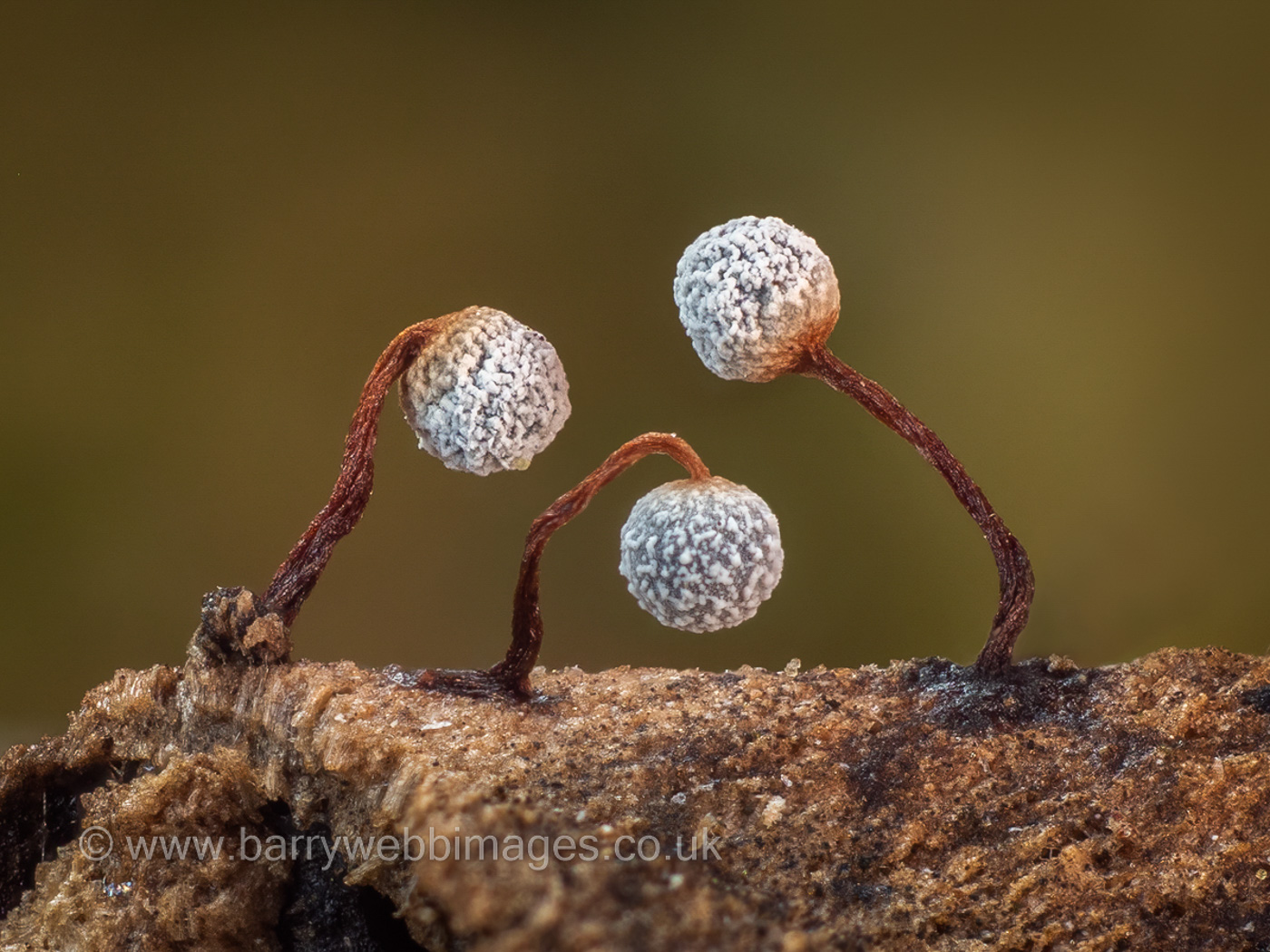
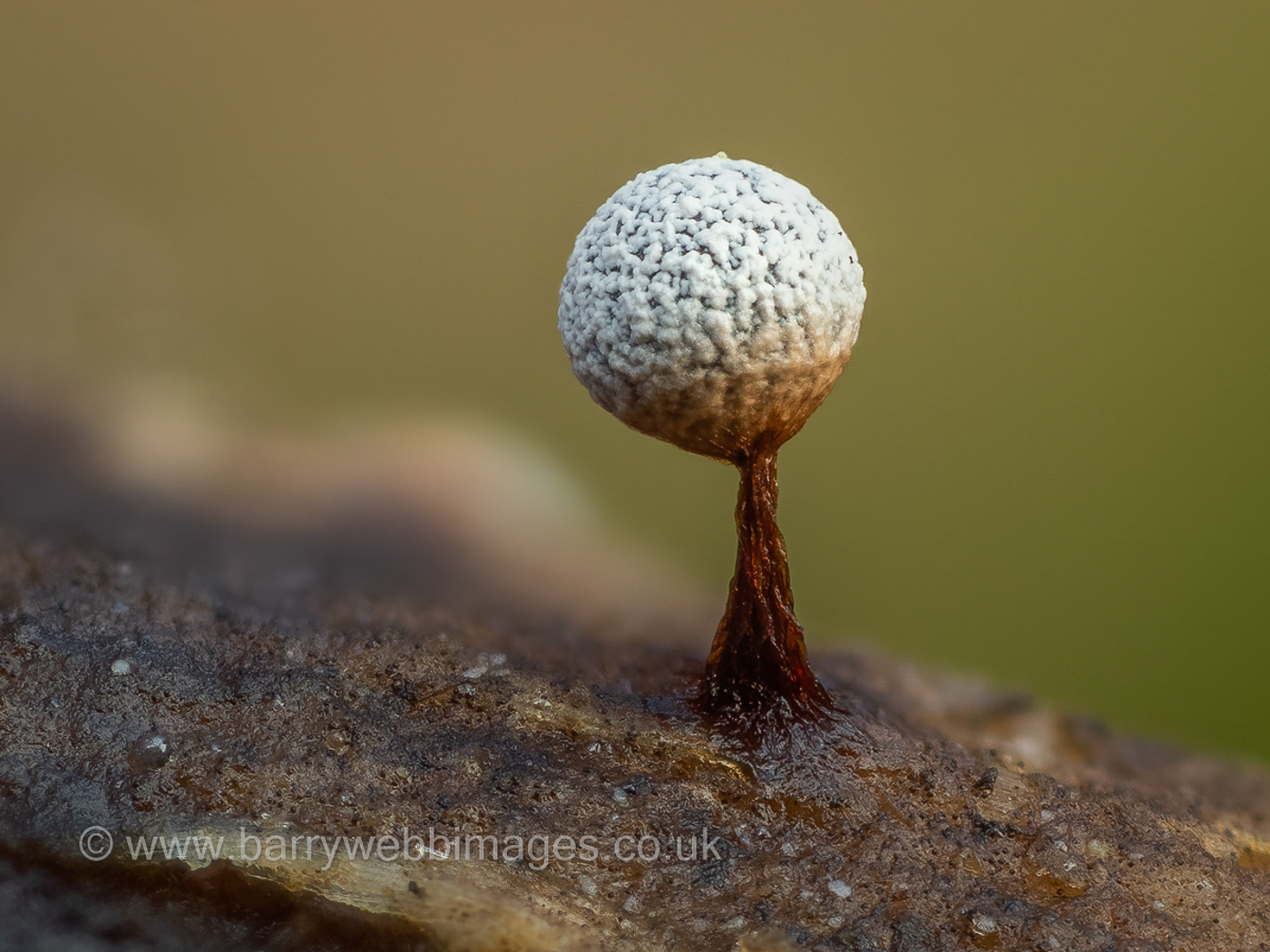 |
March 19th Physarum pusillum (a slime mould with no common name)
Barry Webb found this inconspicuous species in Burnham Beeches on a woodchip pile. Physarum is a large genus of Myxomycetes and there are many similar species, all sporting varying degrees of calcareous crystals (ie the white sugarlike coating seen here). This particular species is distinguished by its relatively tall and slender reddish brown stalk, the whole sporangia being only up to 2mm tall. (Compare with Barry's similar find three days earlier at the same site.) Though described as quite common, this is our first record for the county.
|
March 16th 2021
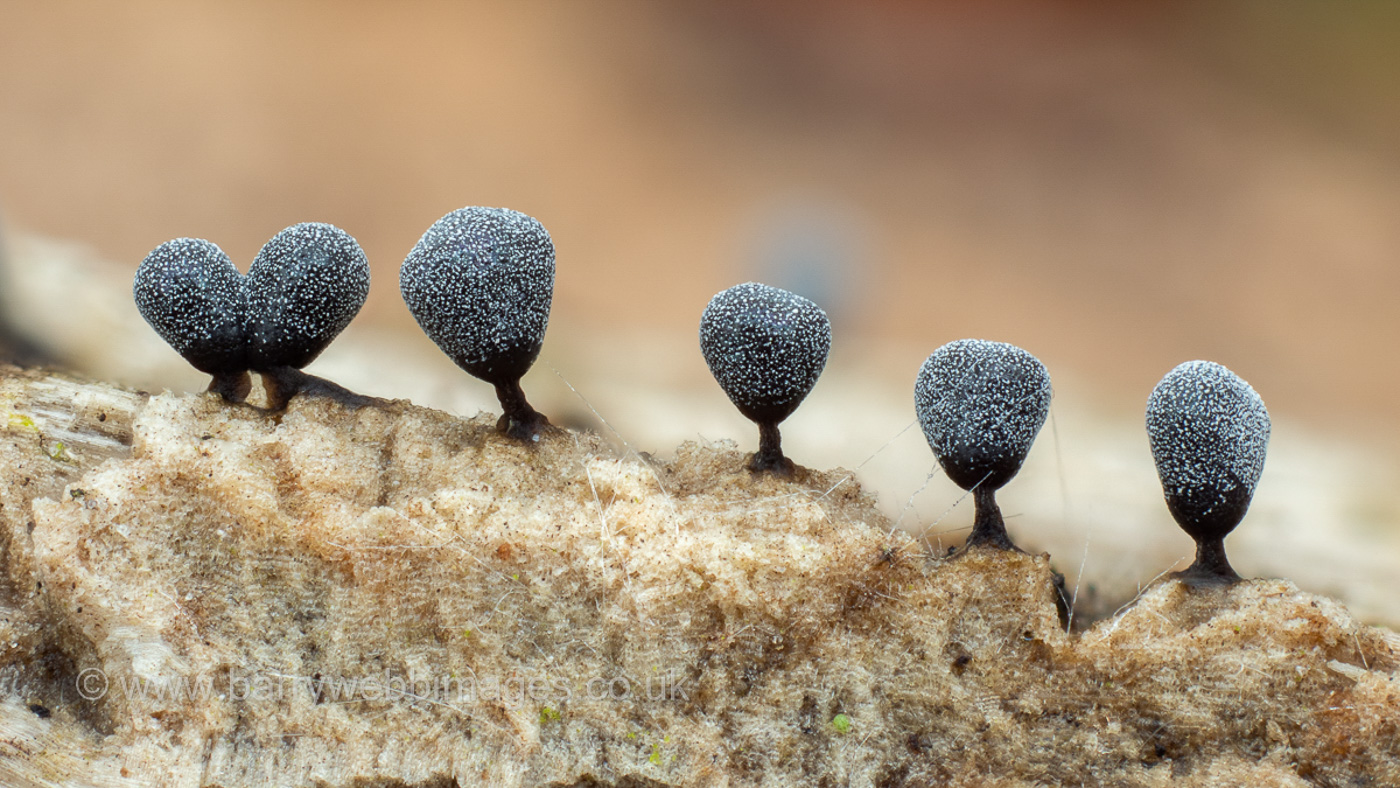
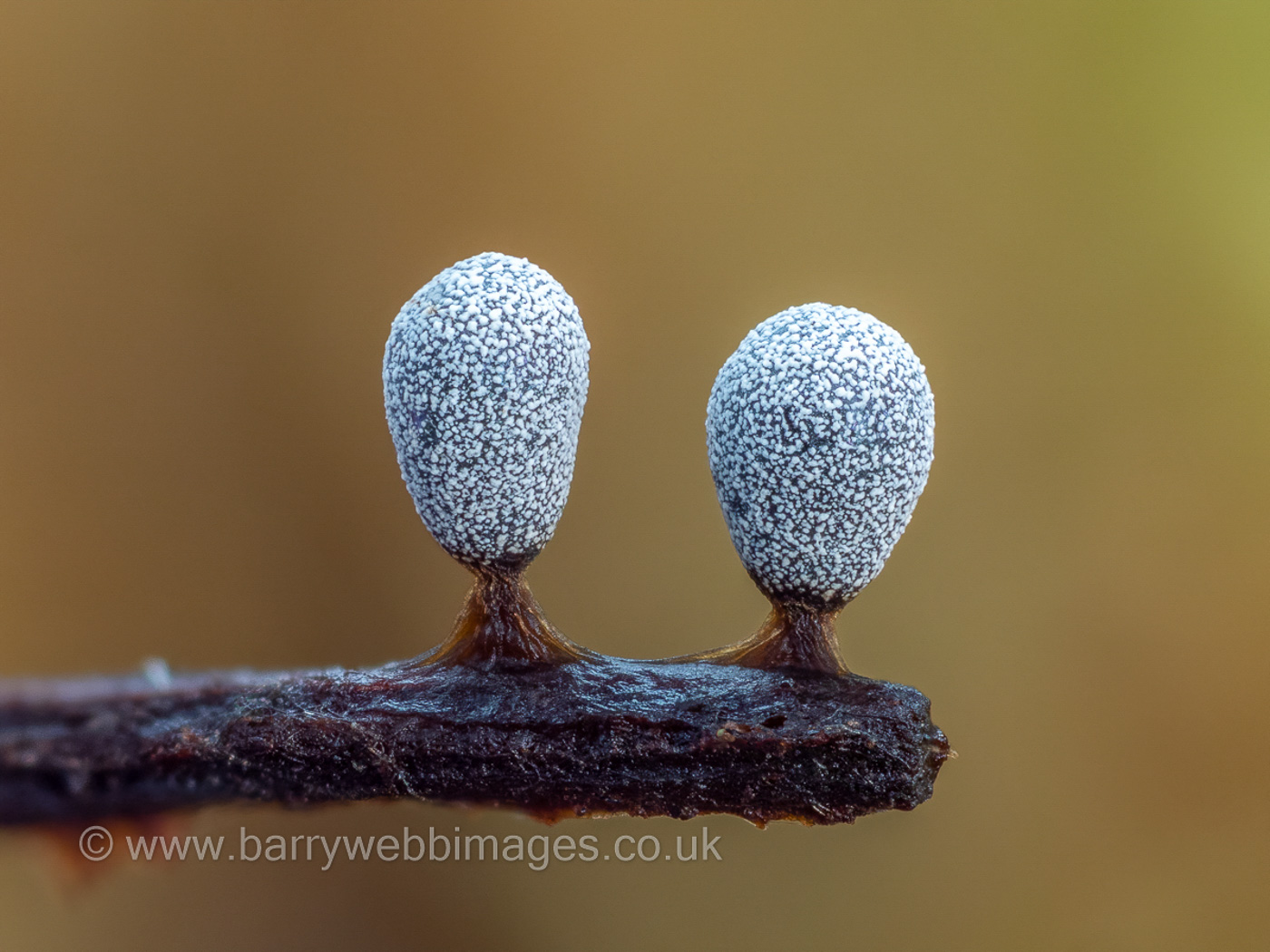 |
March 16th Physarum compressum (a slime mould with no common name)
Barry Webb found this delightful line of tiny blobs in Burnham Beeches (16.03.2021) on a woodchip pile. (The determination was confirmed online by Myxo expert Edvin Johannesen.) This particular species has a very dumpy short stalk (not called a stem or stipe as in fungi) and over all is no more than 1 mm tall. Though described as quite common, this is our first record for the county.
|
March 14th 2021
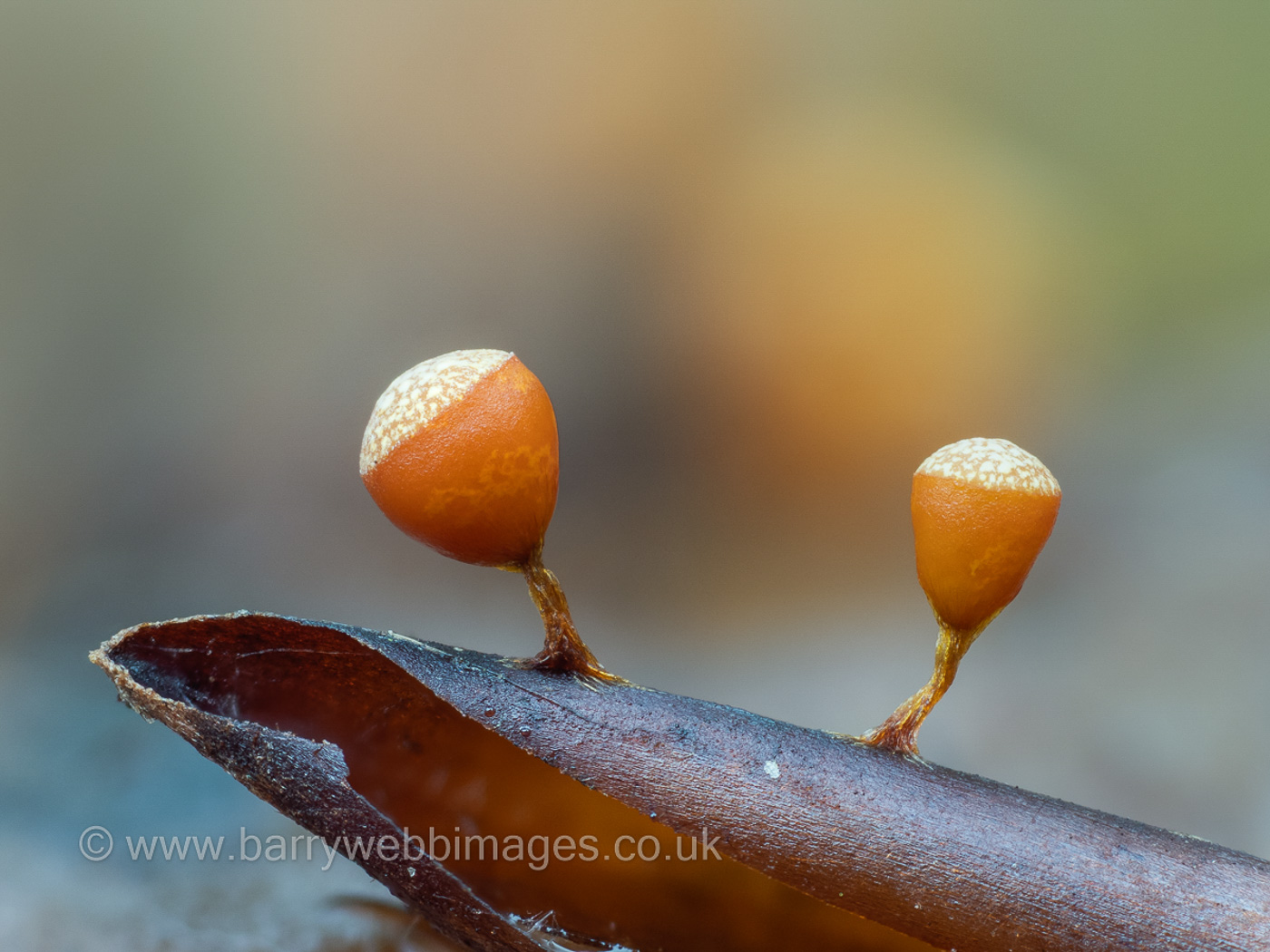
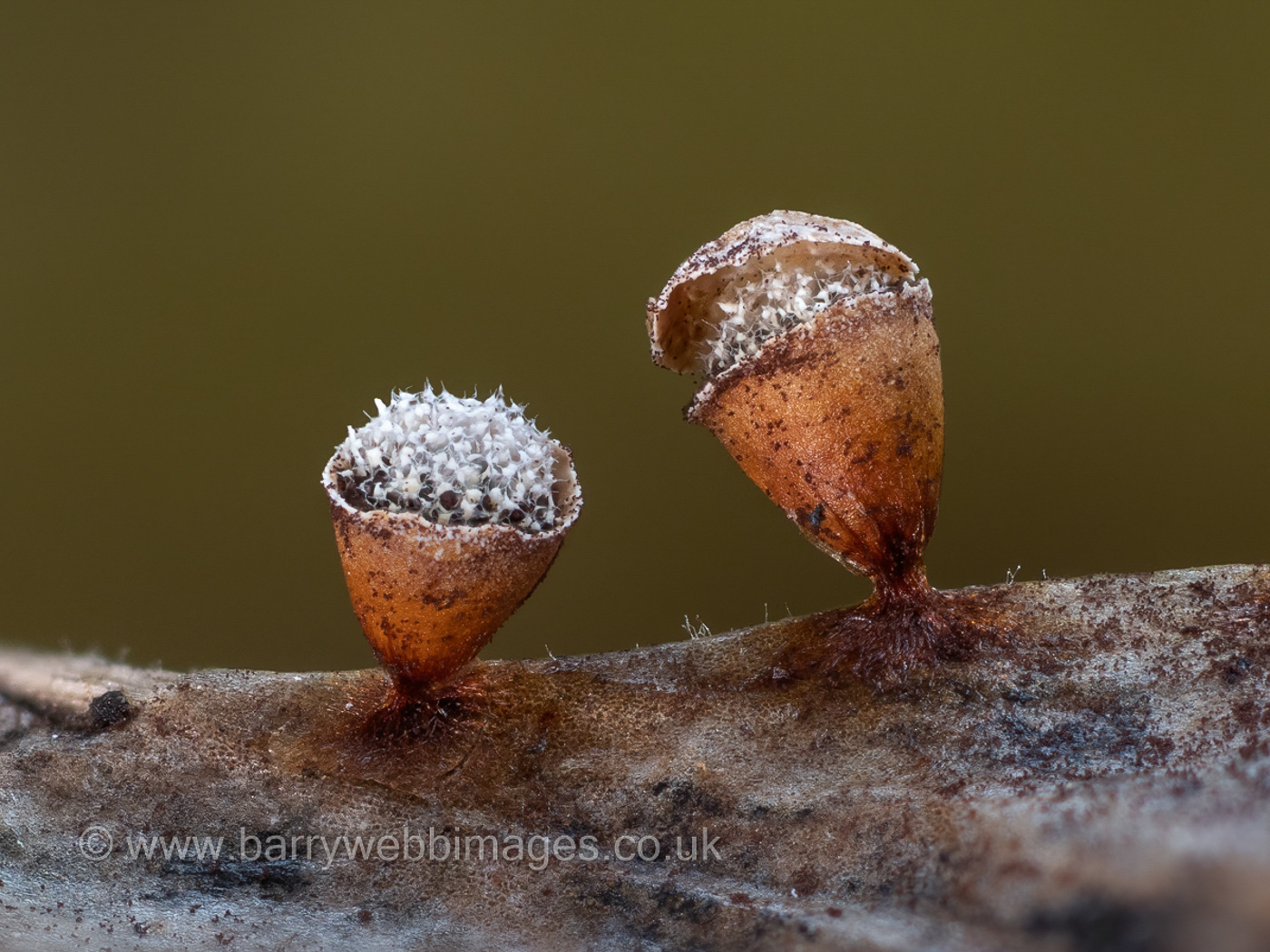 |
March 14th Craterium minutum (a slime mould with no common name)
Barry Webb found these tiny little beauties in Burnham Beeches on a woodchip pile. These miniscule wine goblets are only about 1 mm high, each initially covered by a flat lid which in the RH sporangium in photo 2 can be seen just lifting off to reveal the spore mass beneath. This is a distinctive species, its shape together with the ochre colour and lid making it recognisable in the field. We have just two previous county records though this appears to be a first for Burnham Beeches.
|
March 12th 2021
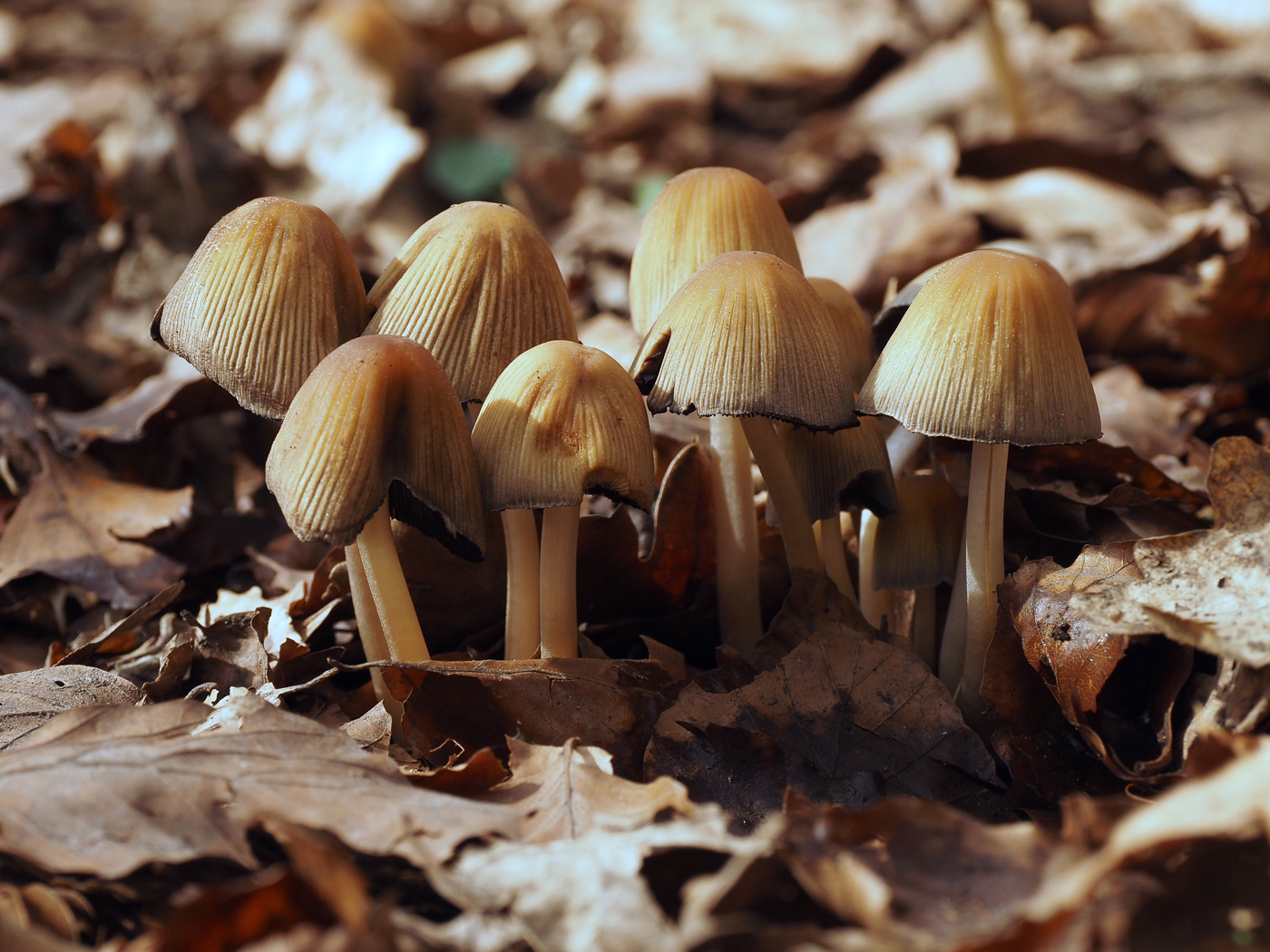
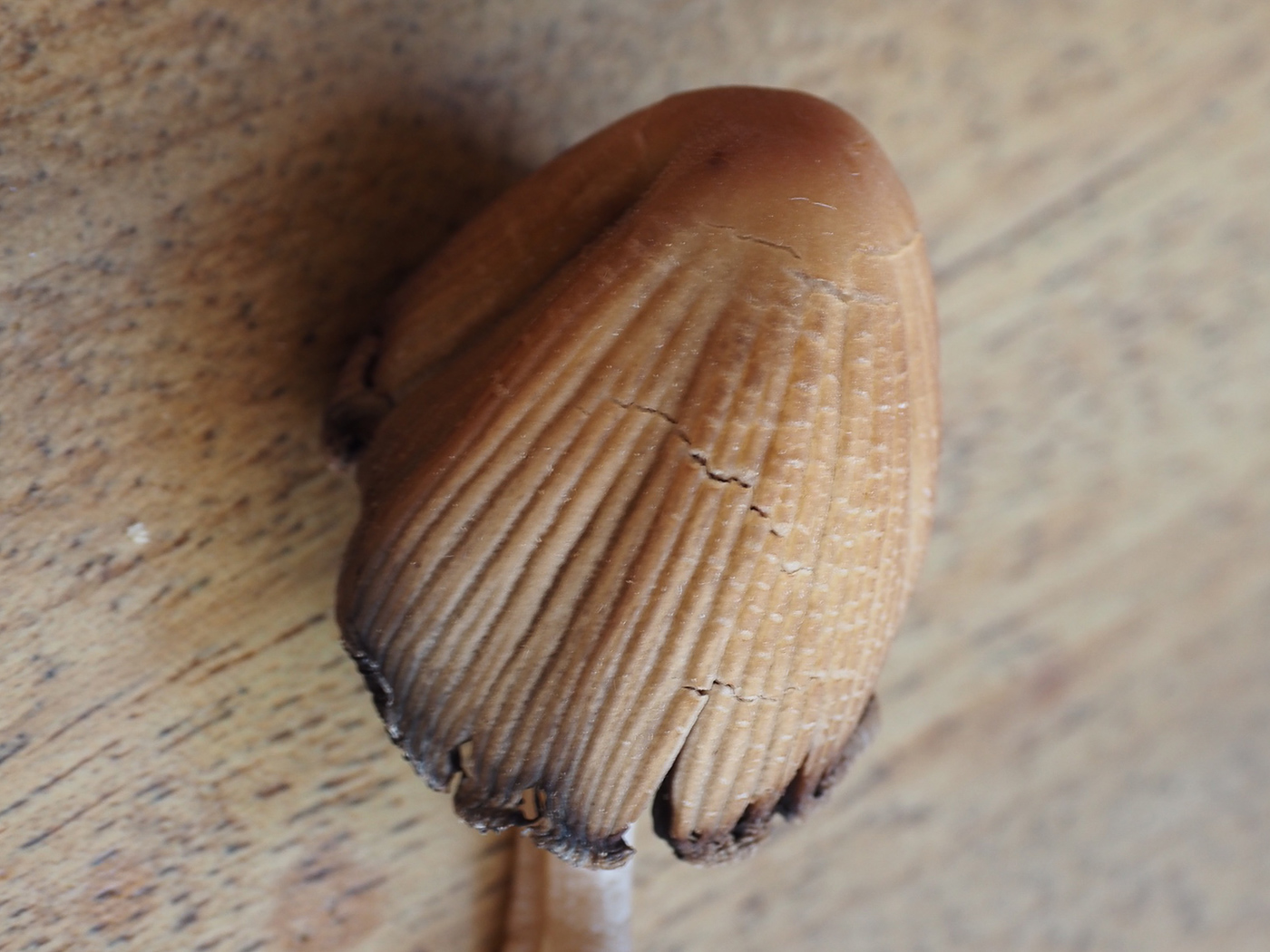 |
March 12th Coprinellus micaceus (Glistening Inkcap)
Claire Williams noticed this nice fresh cluster of Inkcaps in Beech litter in Hughendon Woods but was unsure if they were the common Glistening Inkcap or perhaps a different species. Penny, however, feels just about confident enough to name them without a proper check of the spores etc because the close-up photo 2 shows the telltale white veil flecks on the cap which give the species its common name. See also Finds 2020 Sept 11th and Oct 13th for more examples.
|
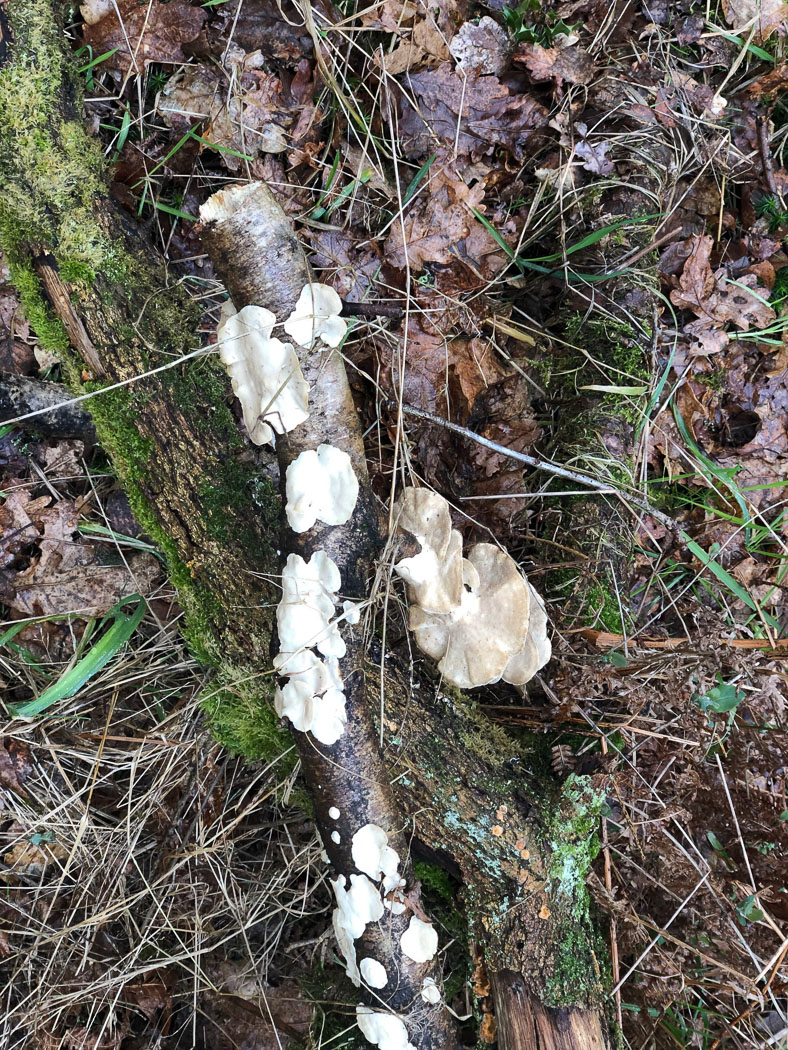
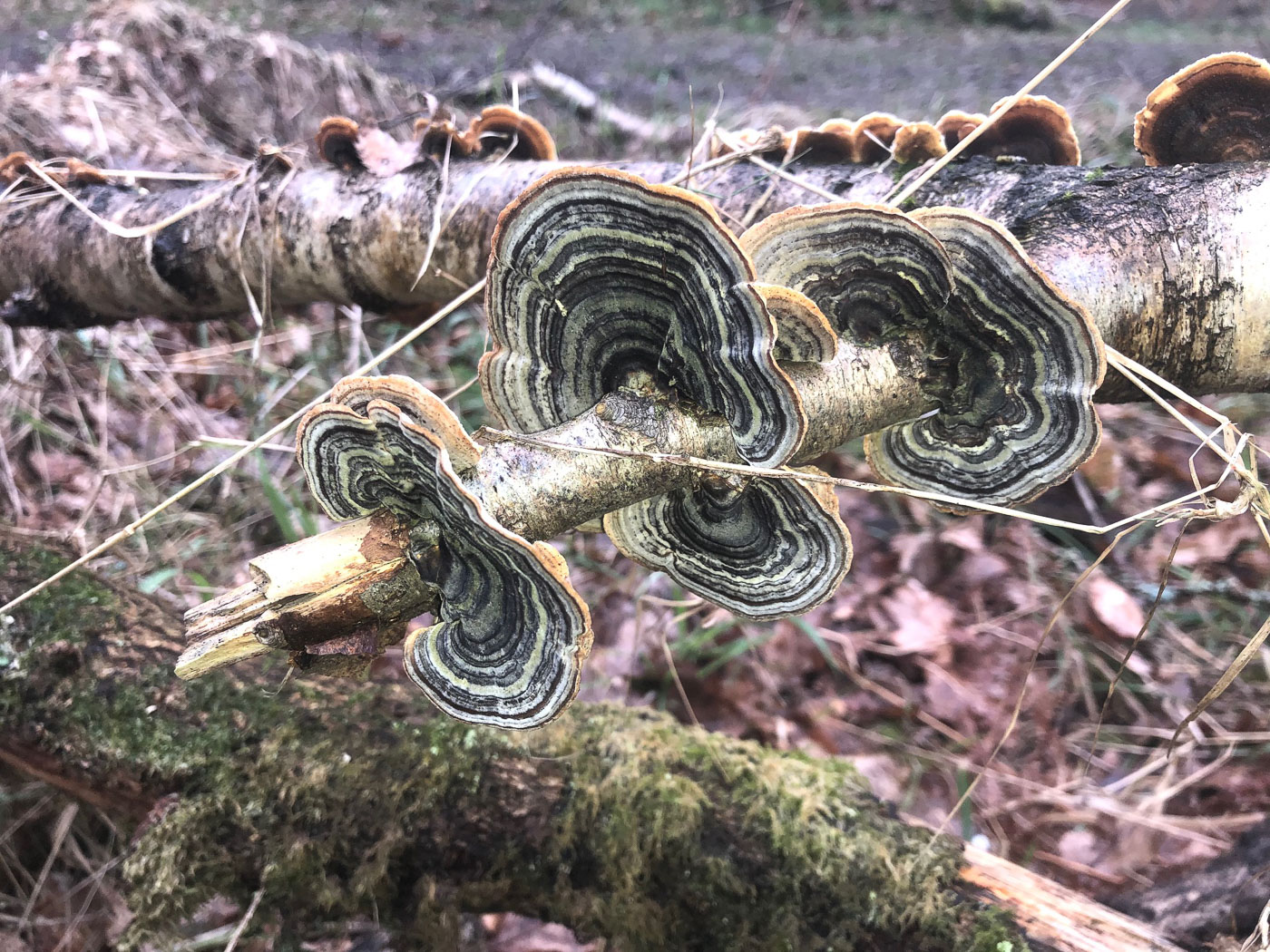
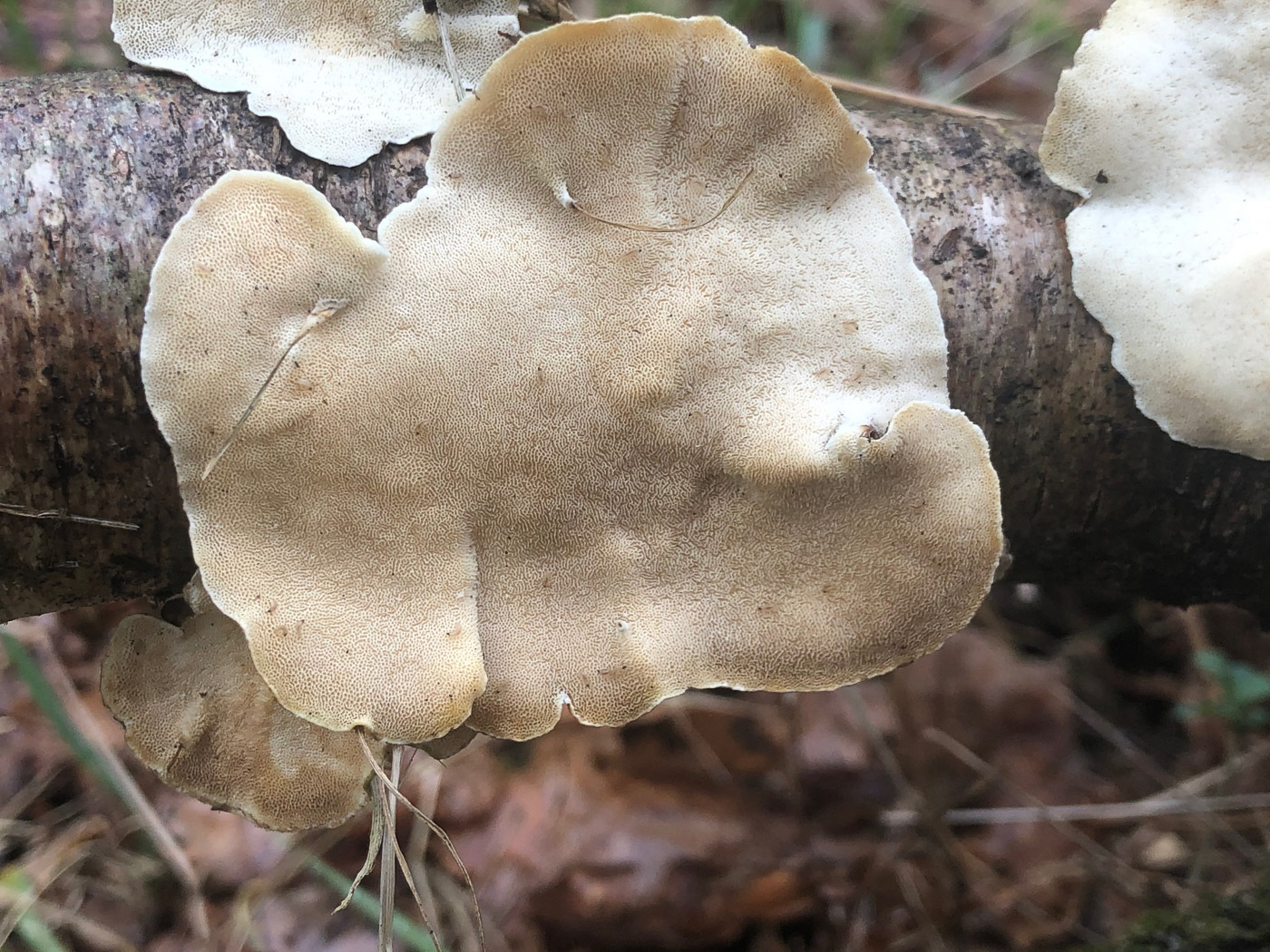 |
March 12th Trametes versicolor (Turkeytail)
In Naphill Common Paul Goby noticed these pale cream fresh fruitbodies on a fallen log, probably Birch. They varied in size between 1 and 7 cms across and he was surprised to find the (apparently) upper surface covered in pores (photo 3). However, photo 2 reveals the true identity of the species, proving that the log must recently have been overturned because the spore-bearing pores would surely only be found on the underside. Note the typical contrasting zoning of the true upper surface of this pretty and common bracket, here really displaying the appropriateness of its English name. It can occur at any time of year on the fallen wood of many different deciduous. See also an example dated January 6th which sports a slightly different colour range within the zones - it is a very variable species, hence its Latin name.
|
March 9th 2021
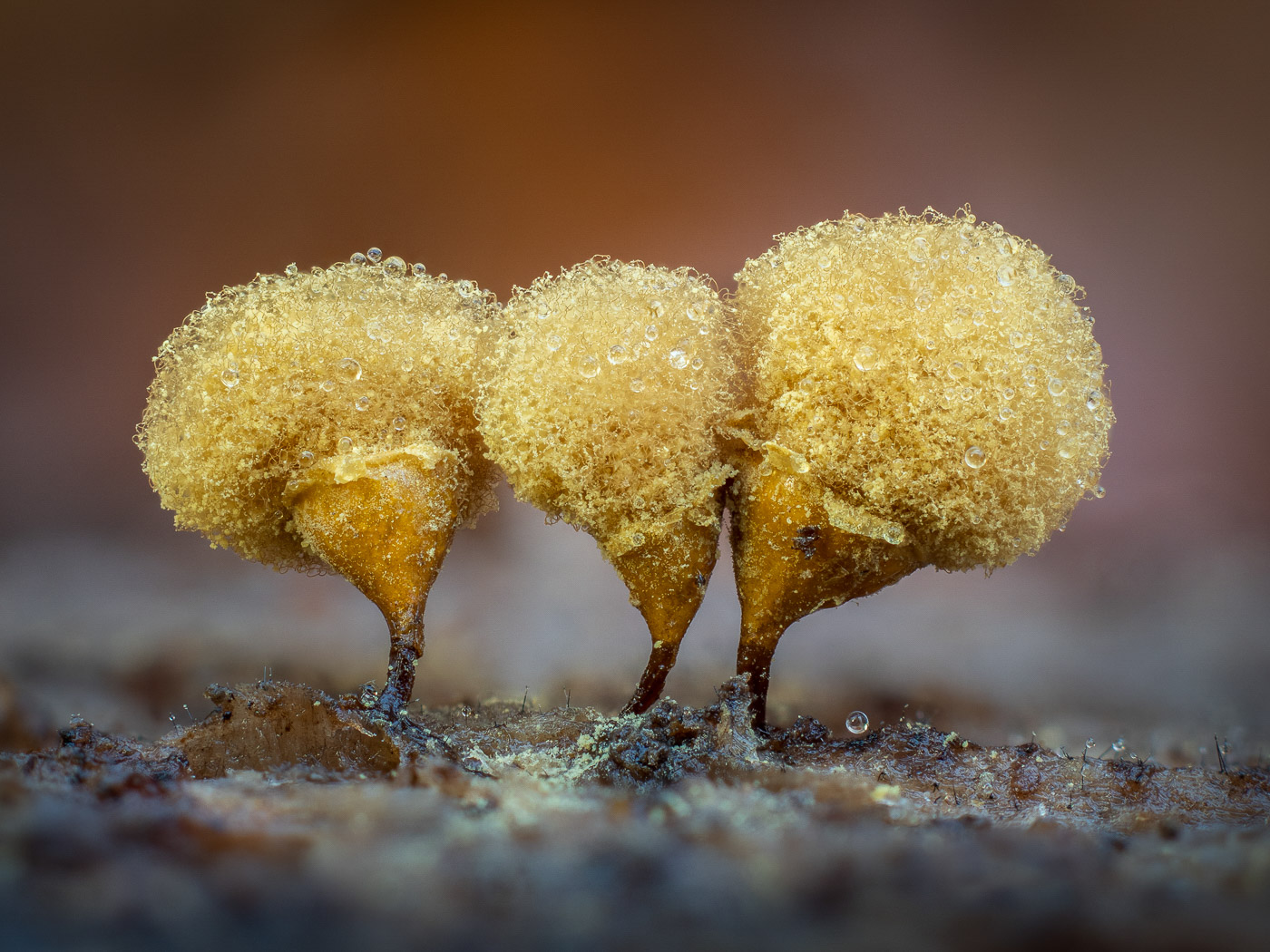 |
March 9th Hemitrichia calyculata (a slime mould with no common name)
Barry Webb found this beautiful slime mould on fallen rotting Birch in Common Wood. Though described as a common species in the south, this appears to be our first county record - reflecting the general lack of local expertise and interest in slime moulds until Barry put this right and started producing his amazing photos.There are several very similar species, so Penny would have been happier to have checked the microscopic characters as it's a first for the county, but the dark solid stalk suddenly flaring out at the top together with the tear-drop shaped sporangium (spore bearing mass) having a shallow shiny cup with typically frayed edges is sufficiently diagnostic to confirm Barry's determination.
|
February 27th 2021
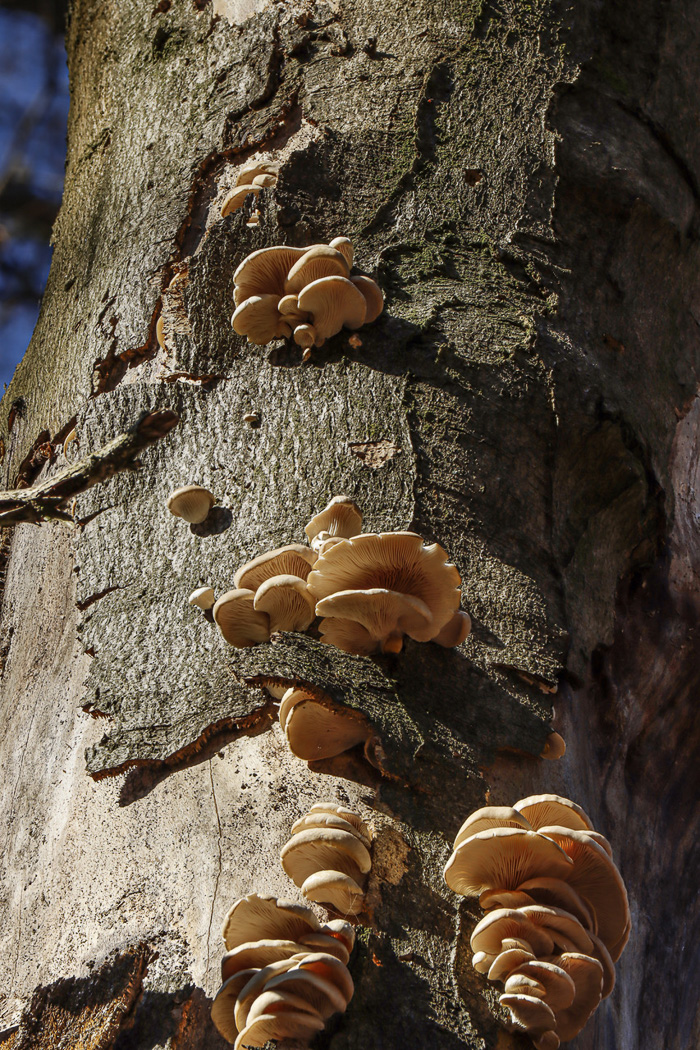 |
February 27th Pleurotus ostreatus / cornucopiae (Oyster Mushroom / Branching Oyster)
Paul Goby couldn't resist taking this lovely photo despite the fact that the fruit bodies were at least 25 ft up a dead Beech trunk in Naphill Common. So the suggested identification is no more than a guess on Penny's part though both species can often occur at odd times of the year, not just in the autumn, their most common host being dead Beech, so one could say this is an educated guess at best. The colour suggests the Branching Oyster - though this could be caused by the early morning sunlight? - but Oyster Mushroom is certainly the more common and prolific species of the two and cap colour is very variable. Any other suggestions welcome . . . . . .
|
February 21st 2021
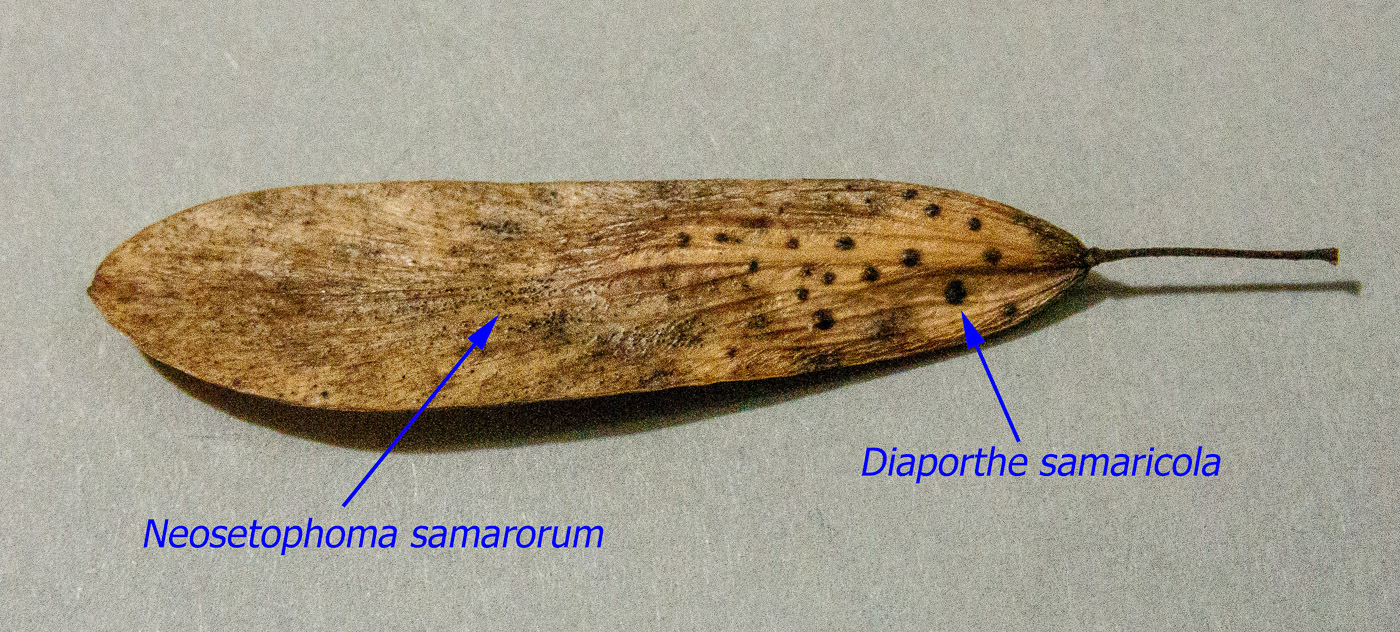 |
February 5th Diaporthe samaricola and Neosetophoma samarorum (two ascomycetes with no common name)
Two species for the price of one: Neil Fletcher read on Facebook about these two tiny species to be found on the samara (keys or wings which aid spore dispersal) of Ash in Spring and promptly went out to see if he could find them. The first keys he picked up in the Walter's Ash allotments showed both species together and he found they were present on many of the keys he examined. Though apparently both are common on fallen keys at this time, we have no previous records on our database so both appear to be new to the county. It is likely that anyone developing an interest in such fungi will be richly rewarded with new species for the county because so few people specialise in them and there are probably thousand of such species waiting to be discovered and recorded here for the first time!
|
February 13th 2021
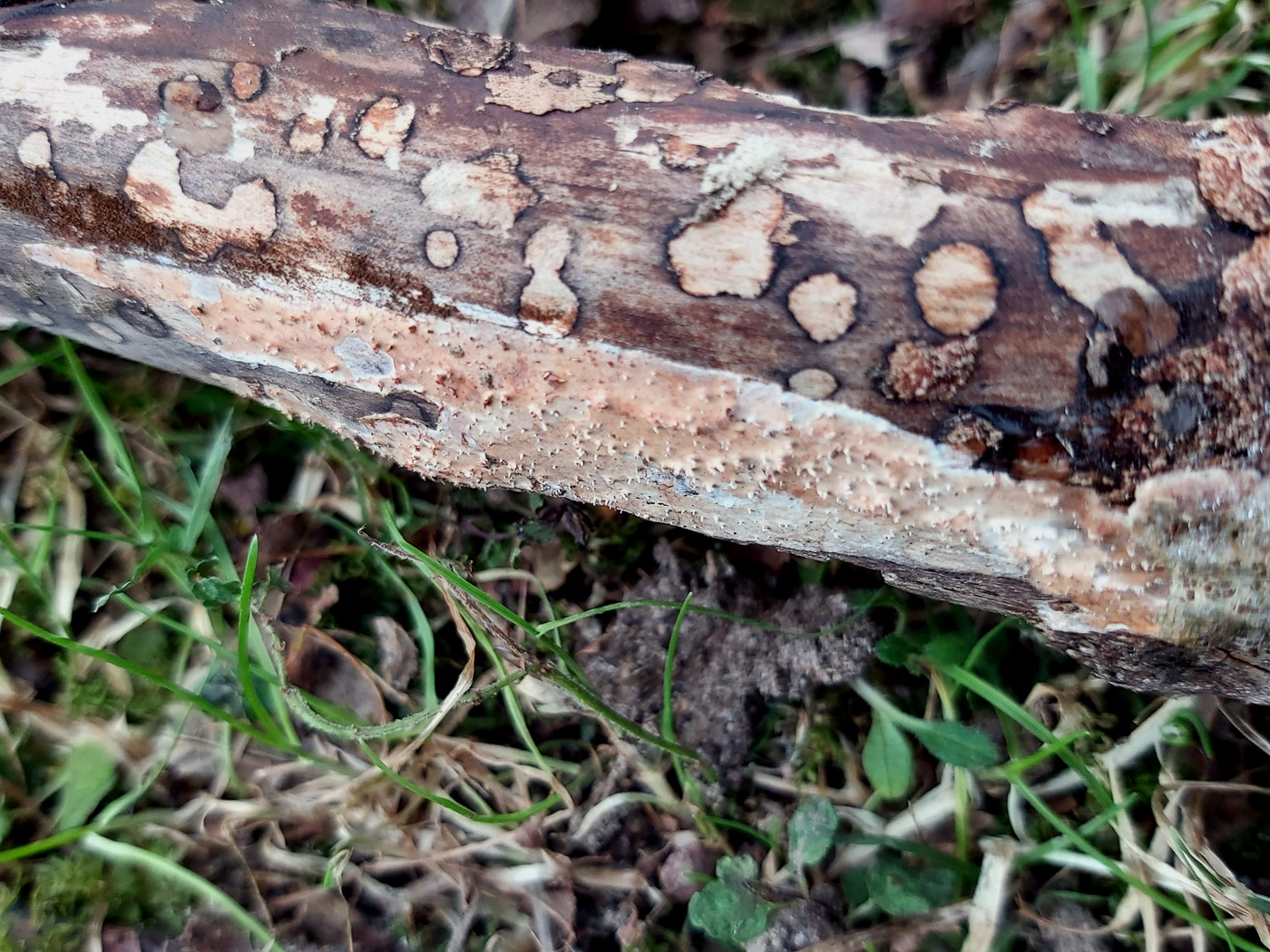 |
February 13th Eichleriella deglubens (Blushing Crust)
Jesper Launder found this apparently not uncommon but in Bucks much under-recorded 'corticioid' fungus fruiting on fallen Willow in Jordans village. Our database shows just three previous records, none since 2005, though it would appear to be quite distinctive in both colour and texture, becoming pinkish brown and developing isolated spines - visible in the photo. It can be found (often in Winter and early Spring) on fallen dead wood of many different deciduous trees but frequents Beech and Ash as well as Willow as here. One we should definitely find more often locally.
|
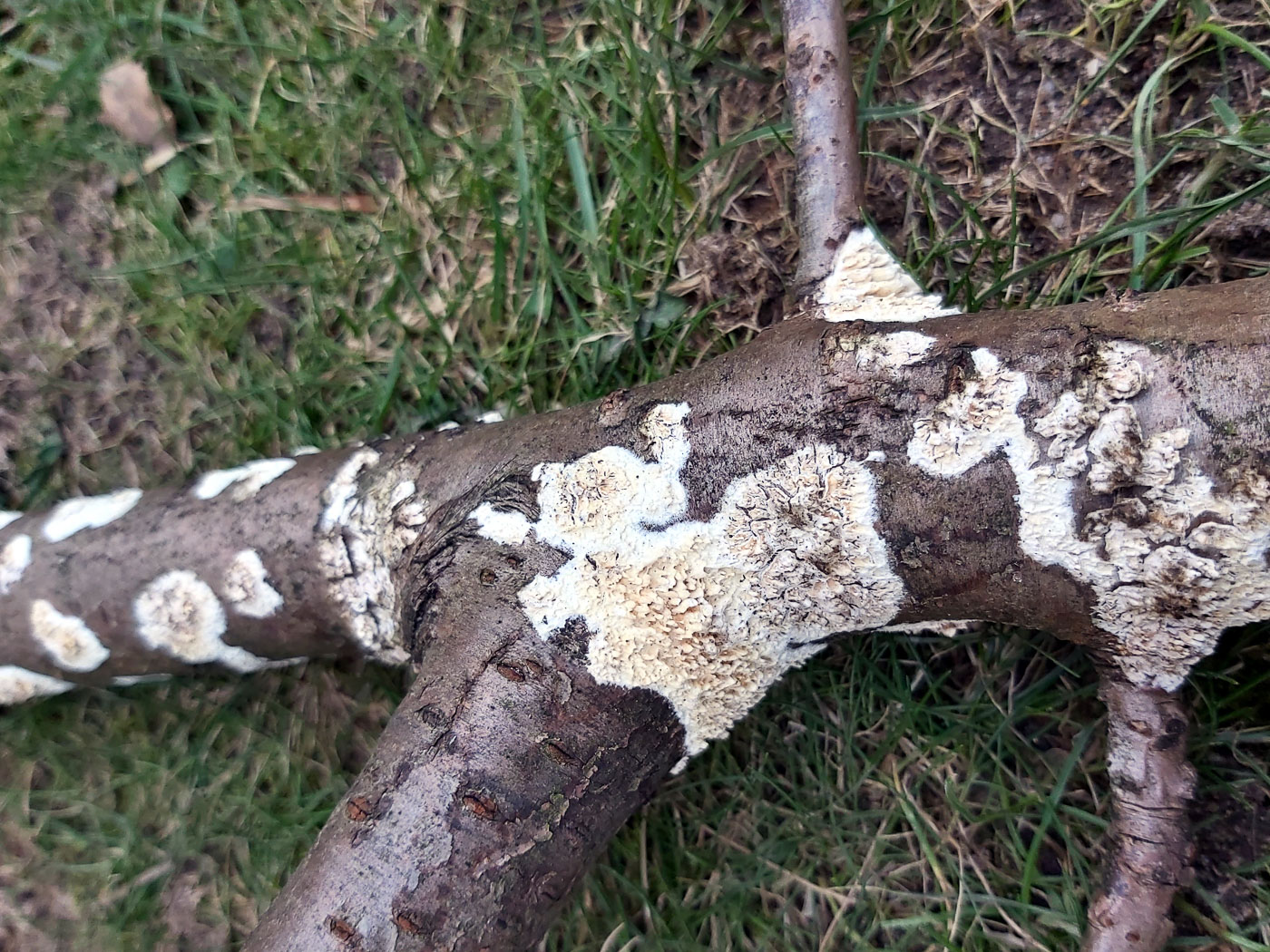 |
February 13th Basidioradulum radula (Toothed Crust) 
Jesper Launder braved the elements to find this common 'corticioid' fungus fruiting on fallen Prunus in Crutches Wood near Jordans. We have a previous immature example (dated Jan 28th) but today's photo shows the species in its typical dry and crusty state (having survived both snow and frost) but still showing its tendency to form roundish patches with a white rim but a darker cream and roughened almost 'toothed' centre.
|
February 10th 2021
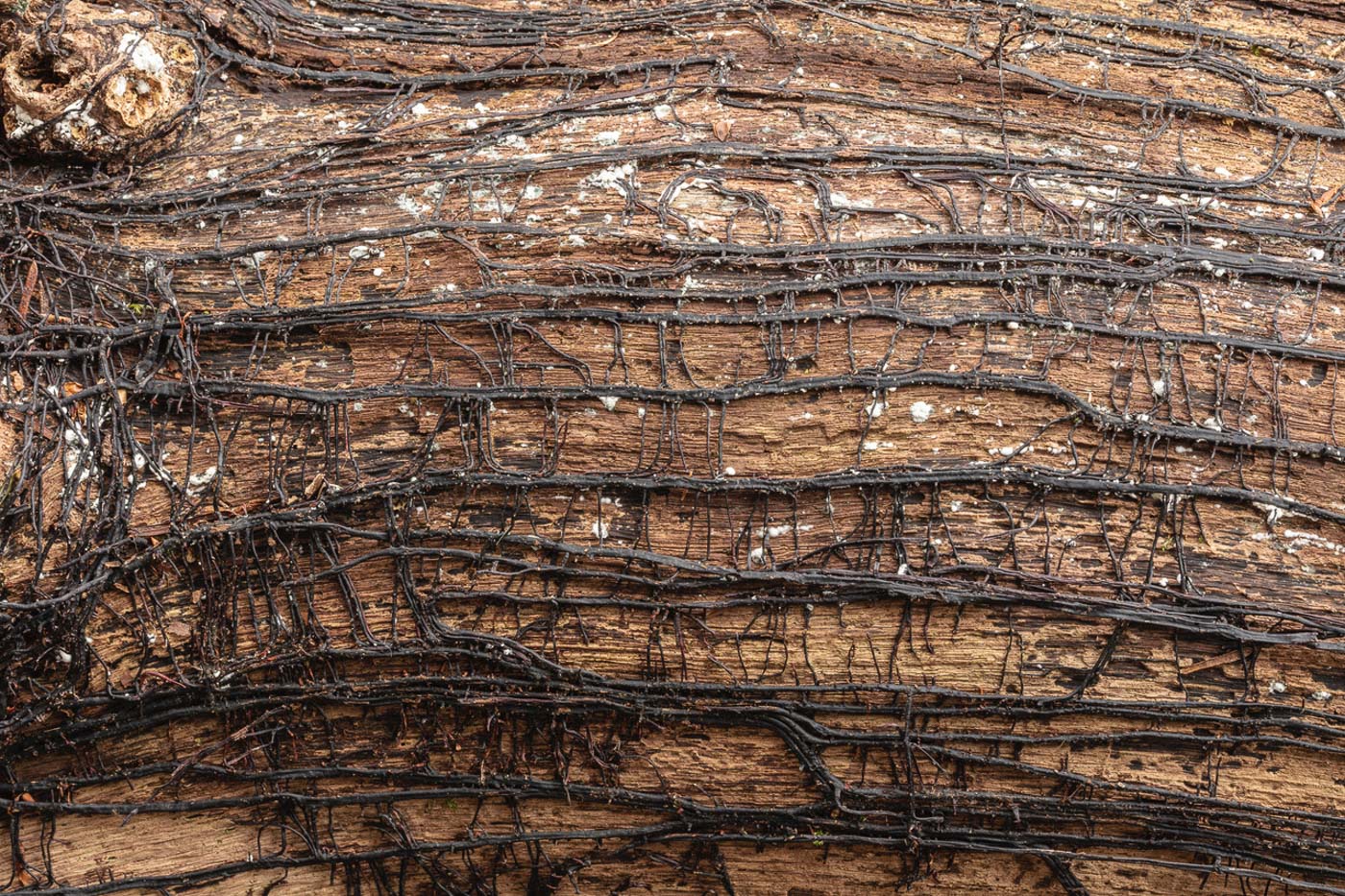 |
February 10th Armillaria sp (Honey Fungus mycelial strands)
In Naphill Common on a barkless Beech trunk Paul Goby noticed these telltale black 'bootlaces' - indicators of a species of Armillaria (likely to be either A. mellea or A. gallica, both of which are common). Fungal mycelium performs a similar function to plant roots, is usually white and forms a finely feathery network of hyphal strands which weave their way through the substrate / soil providing nutrients and also the main method of proliferation for any species. The exceptional thick black mycelium of Armillaria is presumably a large factor in the success of this genus in spreading from dead to living wood and, in the case of A. mellea, causing disease and death amongst many shrubs in private gardens.
|
February 9th 2021
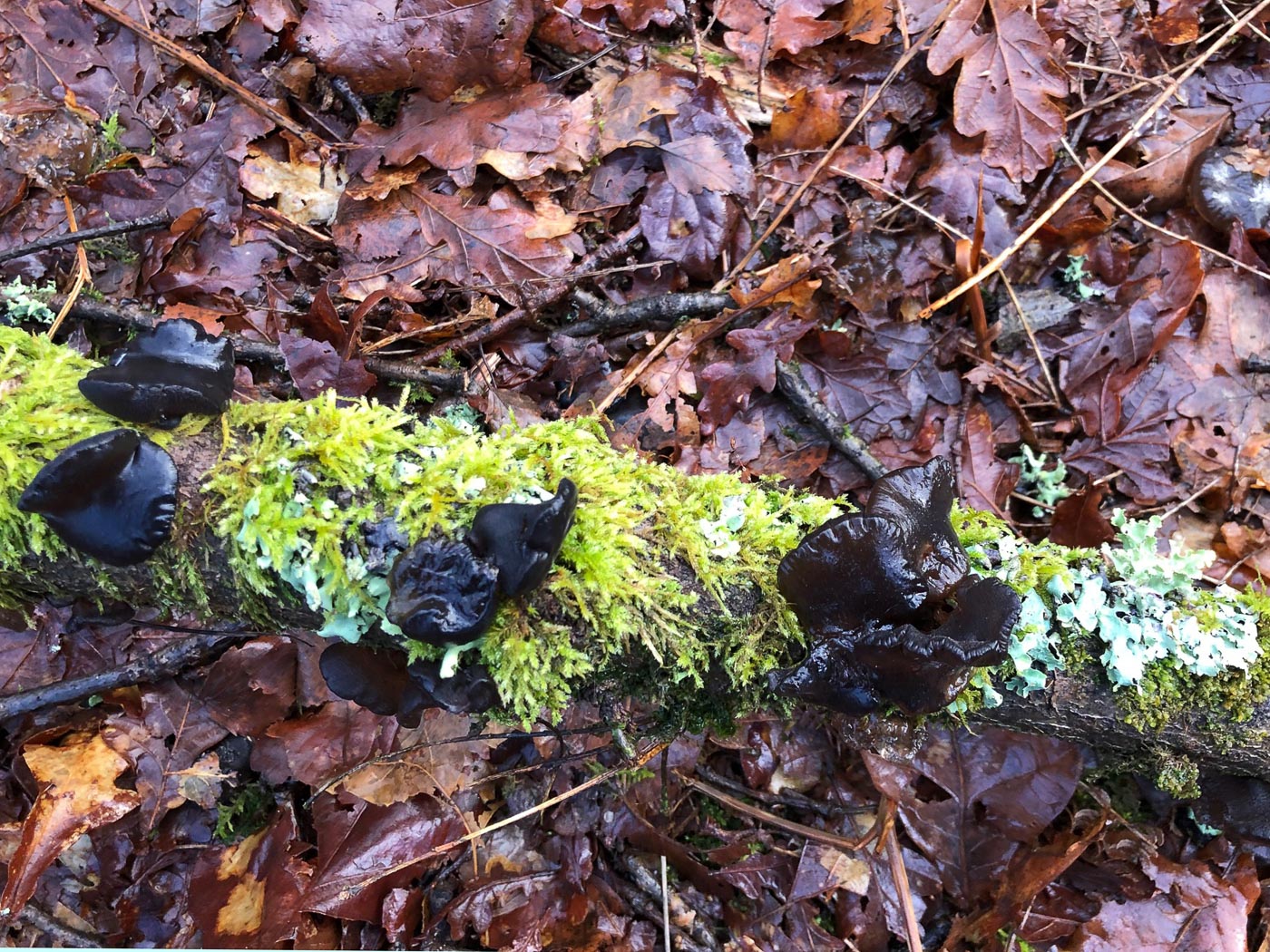
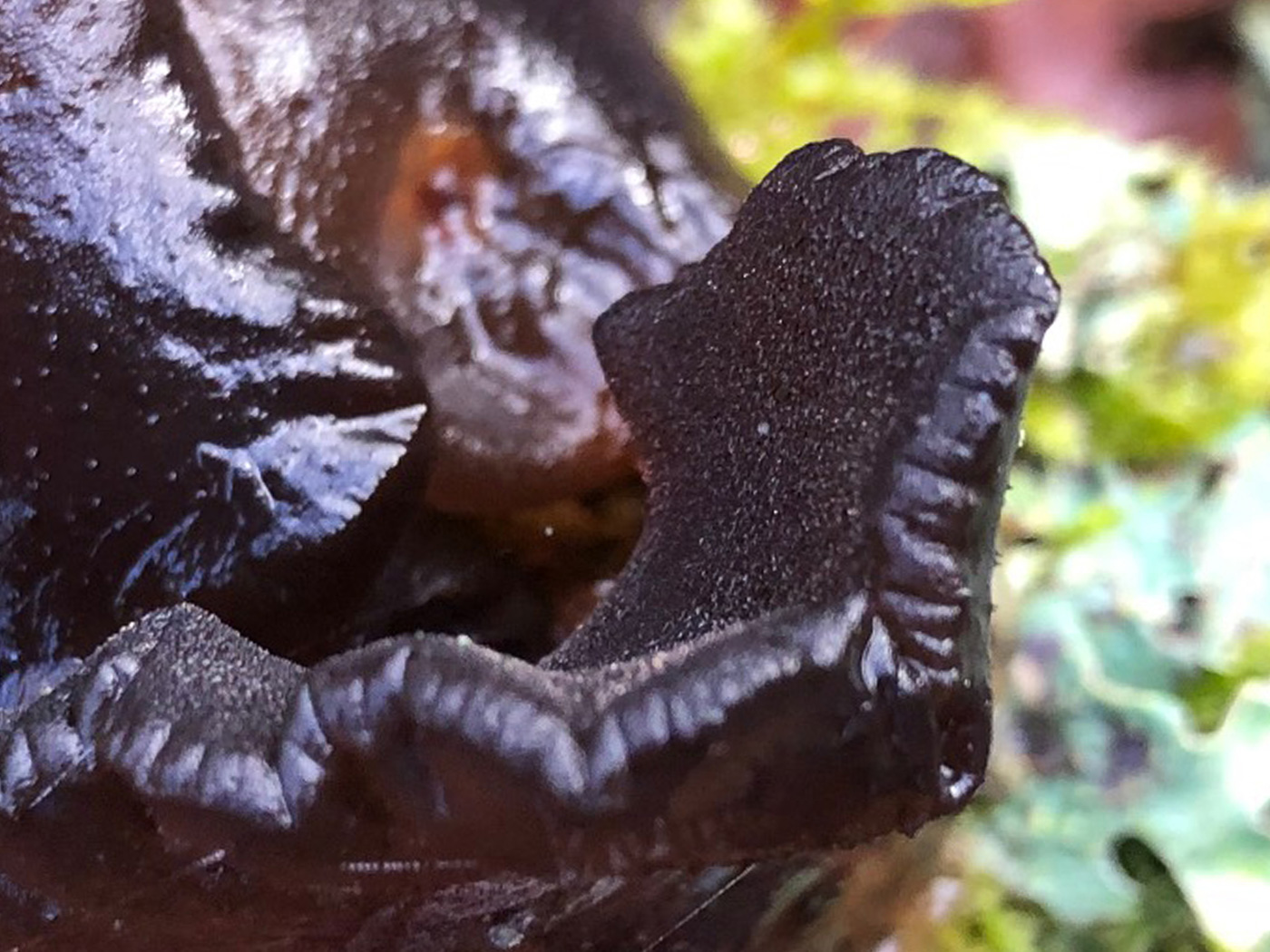 |
February 9th Exidia gladulosa (Witches' Butter)
Paul Goby found these typical specimens of a fairly common Jelly fungus on fallen deciduous wood in Naphill Common. We also have a photo of this dated Jan 06 but today's photos show the species well, particularly the detail in photo 2 where the tiny 'bobbles' on the undersurface are clearly visible - a good pointer for the species.
|
February 5th 2021
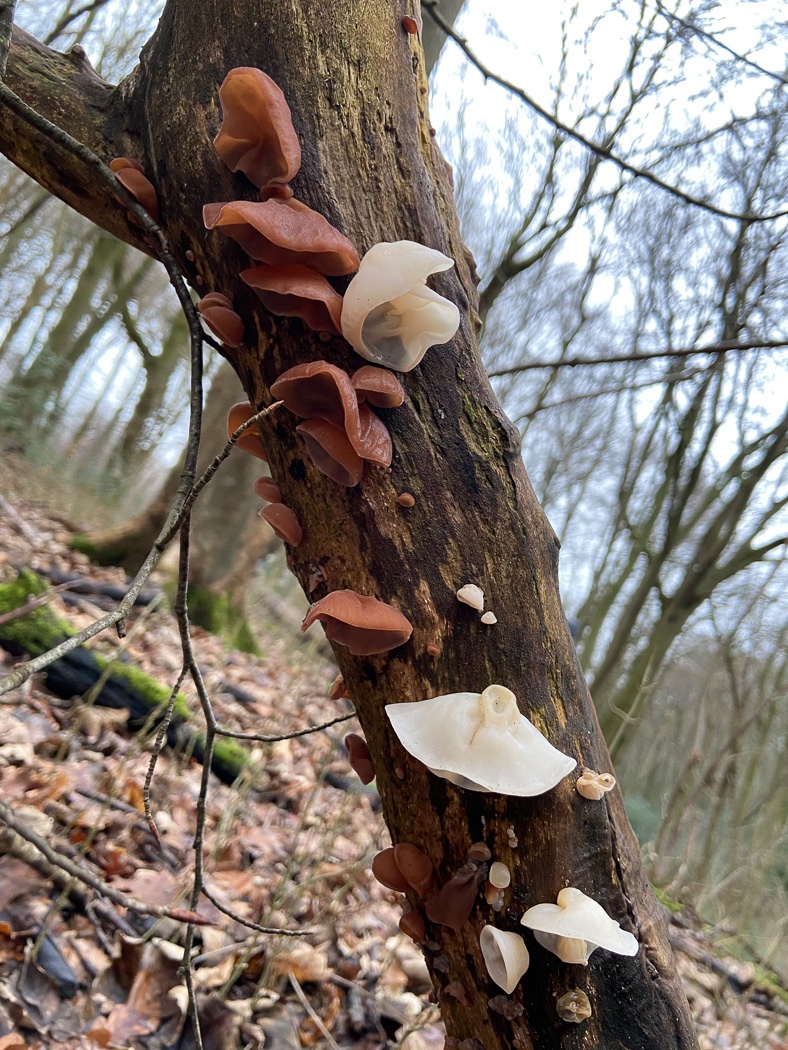

 |
February 5th Auricularia auricula-judae var. lactea (the rare white form of Jelly Ear)
In Little Stockings Wood near North Dean Sarah Ebdon spotted these stunning specimens of the very common Wood Ear but in its rare white form. (Penny has long wanted to find this and is green with envy!) It was on dead Elder. Sarah commented that she remembers seeing this variety years ago in Chesham Bois but we have no Bucks records of it in our database. Sadly not a species in its own right, it can be seen here in close proximity to the conventional and familiar red-brown 'ears' growing on a dead Elder trunk. What an unexpected and beautiful find.
|
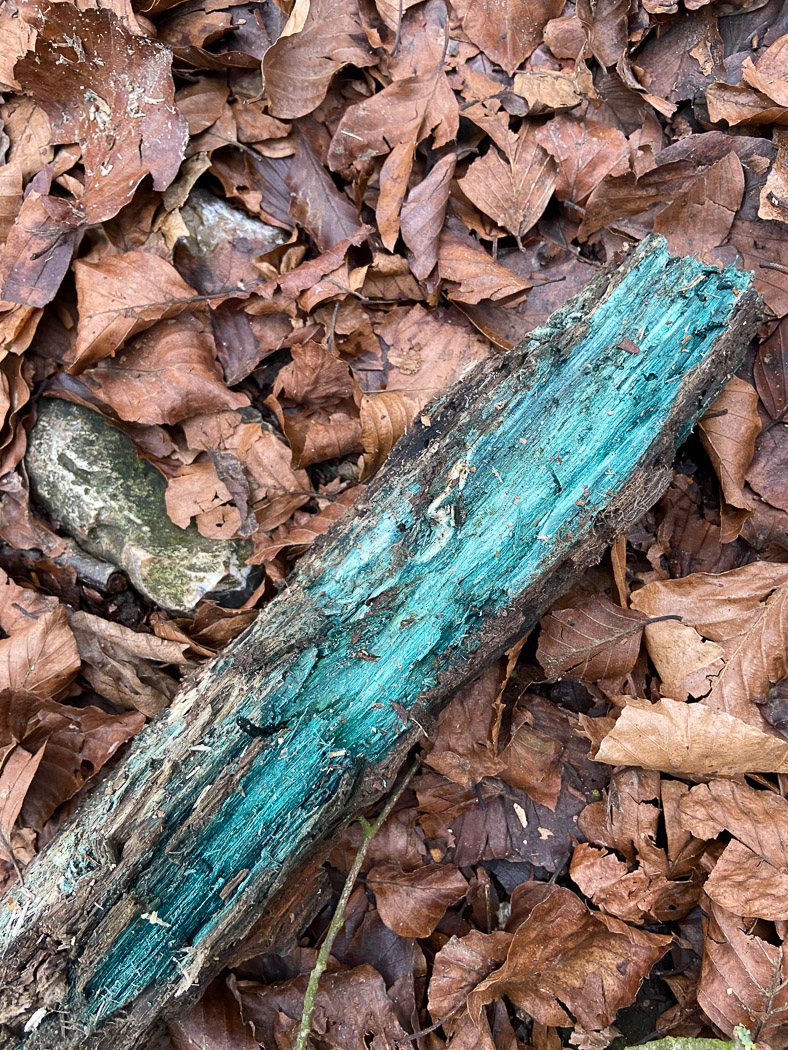 |
February 5th Chlorociboria aeruginascens (Green Elfcup - no fruitbodies, just the wood)
In Little Stockings Wood near North Dean Sarah Ebdon founds this bright green piece of rotting bare deciduous wood. She instantly picked it up to search for the telltale tiny green cups of the fungus which is responsible for this remarkable green staining. Sadly there were no fruitbodies to be seen today but in Finds 2020 dated Oct 12 there is an impressive example. (Read the notes there for more information about the use of this wood.) So if you find wood displaying this colour it's well worth taking a closer look to see the beautiful little turquoise green cups which are often less than 5mm across.
|
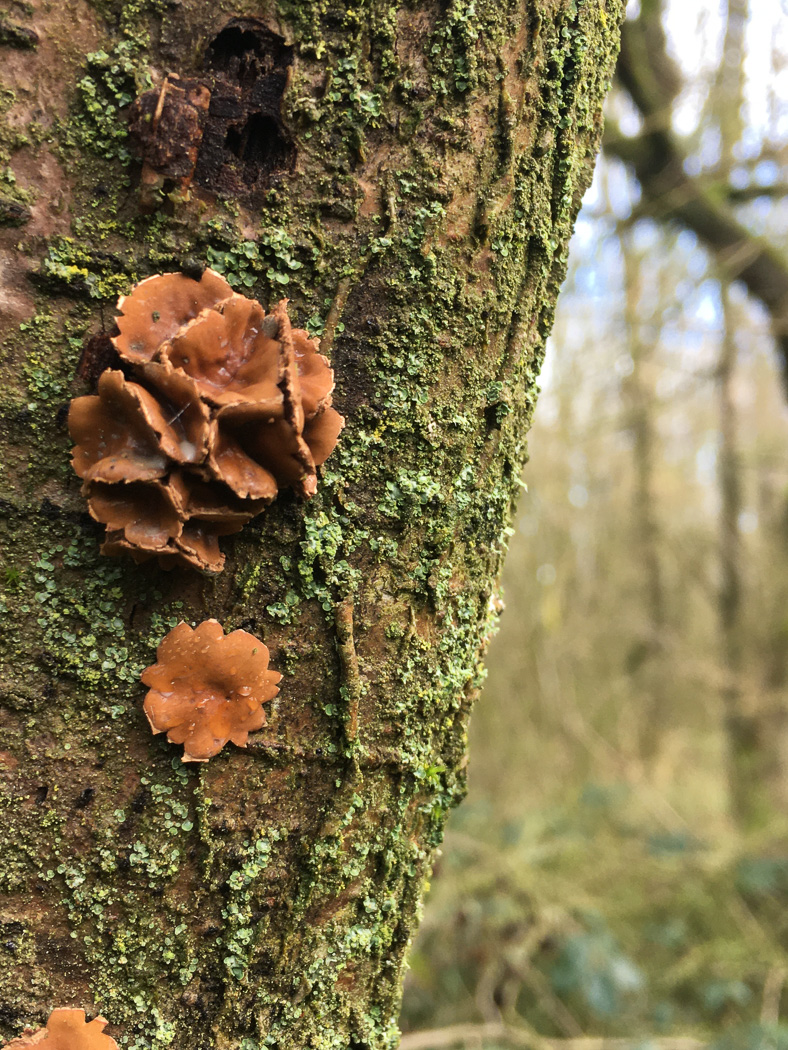 |
February 5th Encoelia furfuracea (Spring Hazelcup)
Joanna Dodsworth spotted this small typically springtime Ascomycete on fallen Hazel in Rushbeds Wood. Our other nine county records range from late November through to March from four different sites, most often Rushbeds Wood no doubt owing to the numbers of Hazel found here - its commonest host. It can apparently occasionally be found on Alder as well. A nice find by Joanna.
|
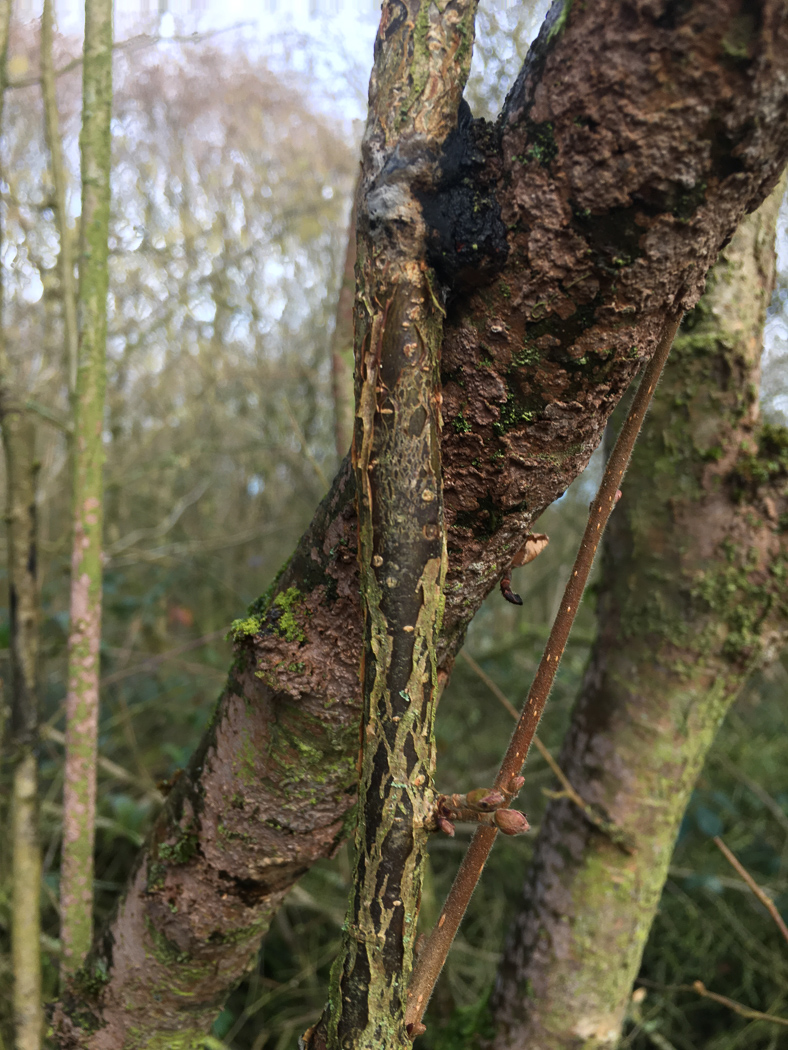 |
February 5th Hymenochaete corrugata (Glue Crust)
In Rushbeds Wood Joanna Dodsworth found this interesting fungus, known to encompass two separate pieces of dead or dying wood where they happen to touch, in effect fixing them together - hence its common name. This bracket-like resupinate is most commonly found on standing Hazel - a wood which abounds at Rushbeds, thus several of our 13 previous county records for the species are from this site. One could surmise that the purpose of fixing the wood together is to prevent it falling to the ground where it could become a source of nutrients for other competing fungal species.
|
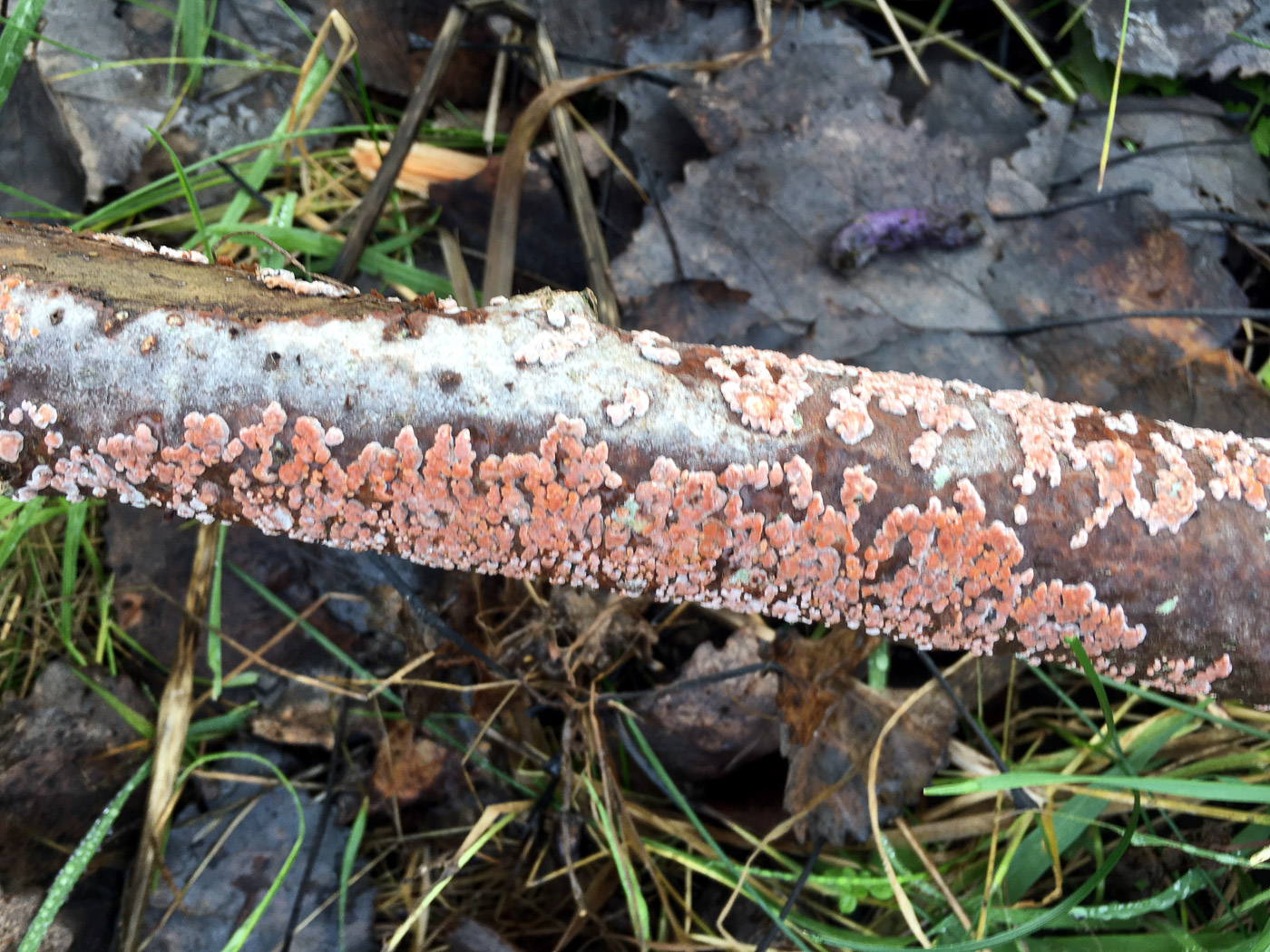
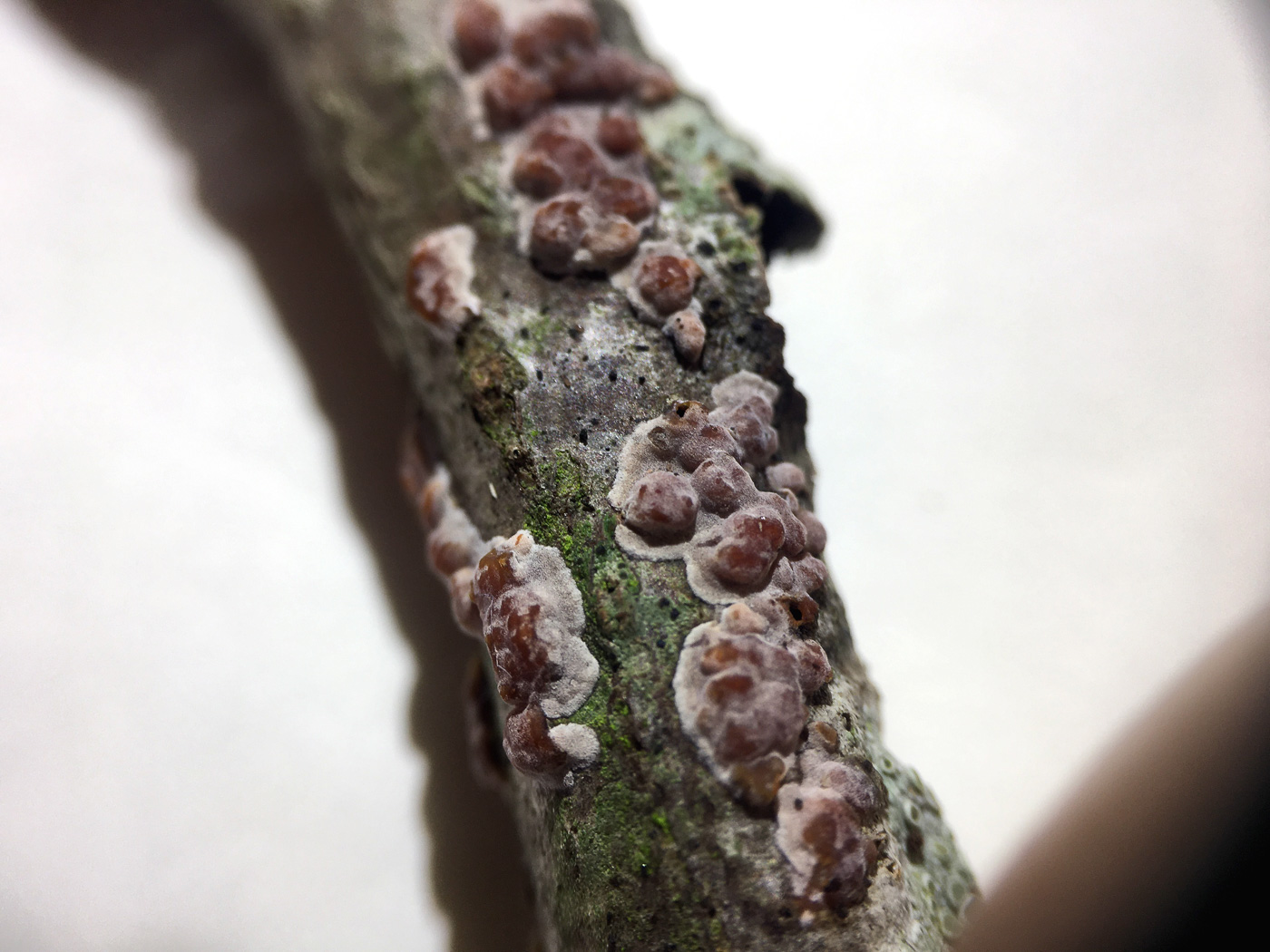
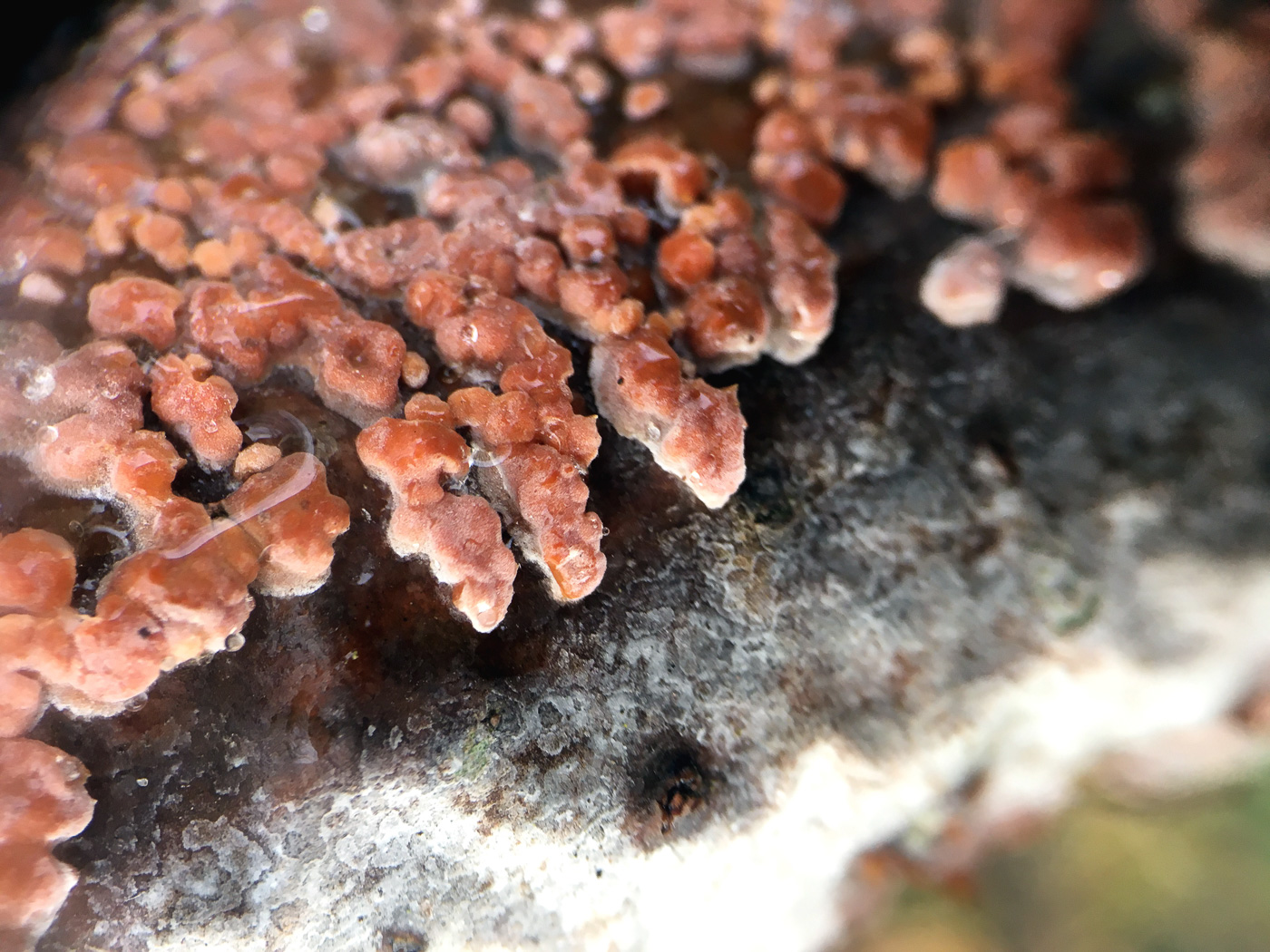 |
February 5th Peniophora polygonia (a resupinate with no common name) 
A few weeks back Russell Ness noticed this unusual and distinctive 'crust' fungus covering a fallen Aspen sapling in Taplow. Having no literature to hand with sufficient information on such species he took a spore print and sent the photos (including one of the spores) to Penny in the hope that she might recognise it. No luck there! She suggested sending a sample to resupinate expert Alan Lucas, who has now kindly named it for us. This is quite a rare species, nearly always occurring on Poplar - Aspen in particular, and we have just two previous county records, the last from Wotton Park Estate identified by Martyn Ainsworth in 2009. This was a nice find and is one to look out for on fallen Poplar with it's distinctive pink to red bumpy surface. There are many different species of Peniophora - a difficult genus and one needing very skilled microscopy to identify to species.
|
February 4th 2021
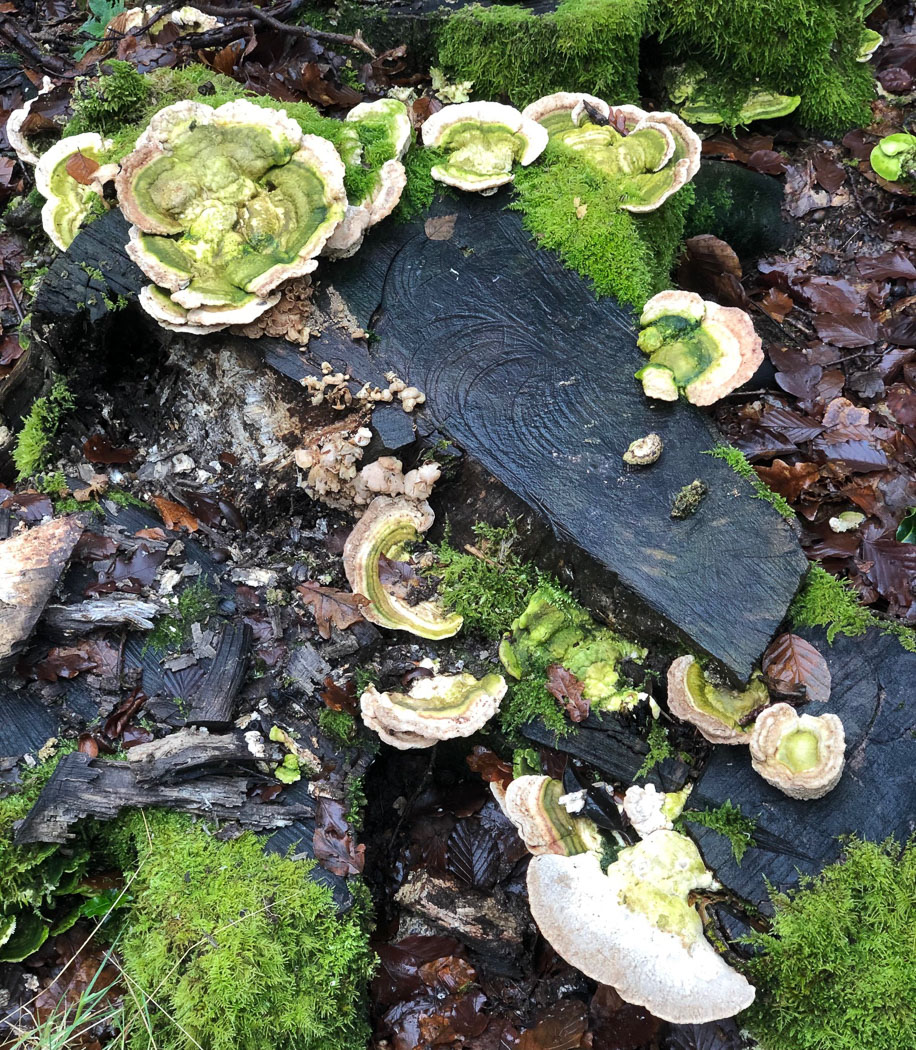
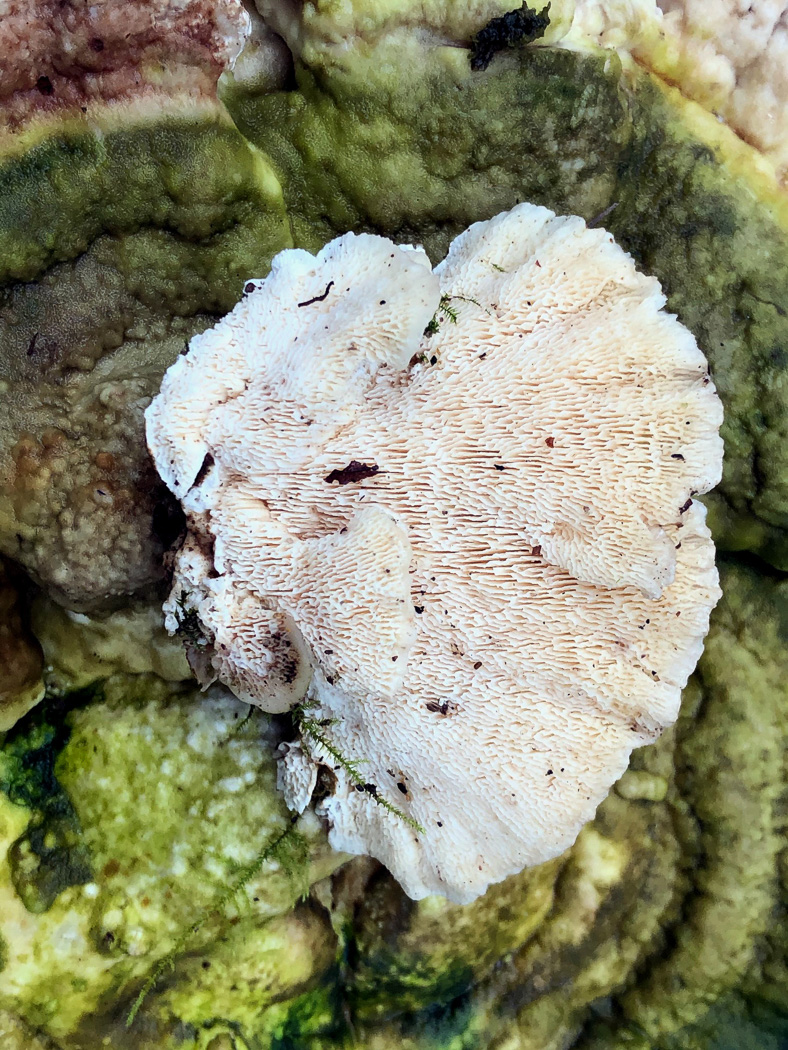 |
February 4th Trametes gibbosa (Lumpy Bracket)
In Naphill Common Paul Goby found these substantial brackets on fallen Beech. This is our second find of this common fungus (see also photo dated Jan 14), also our third species of Trametes this month. Both larger and tougher in texture than both T. versicolor and T. ochracea, it is often liberally coated in green algi as seen clearly here and also has very obvious large pores underneath which are distinctly elongated rather than round to oval - almost mazelike.
|
February 3rd 2021
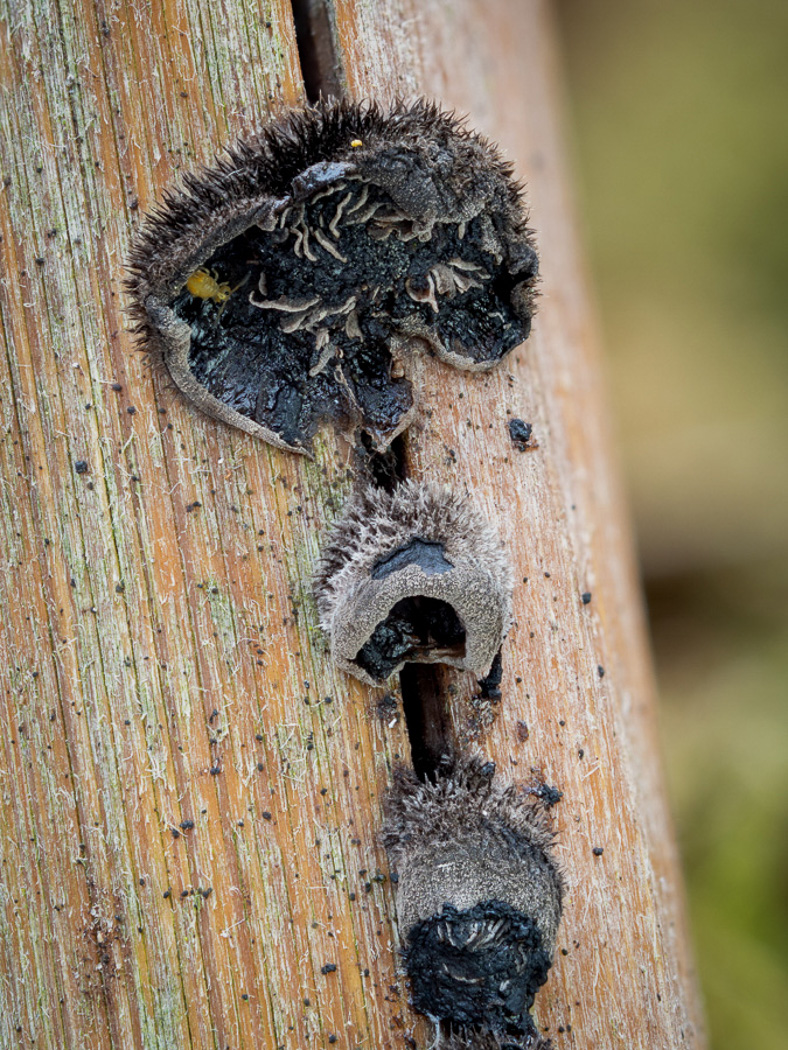
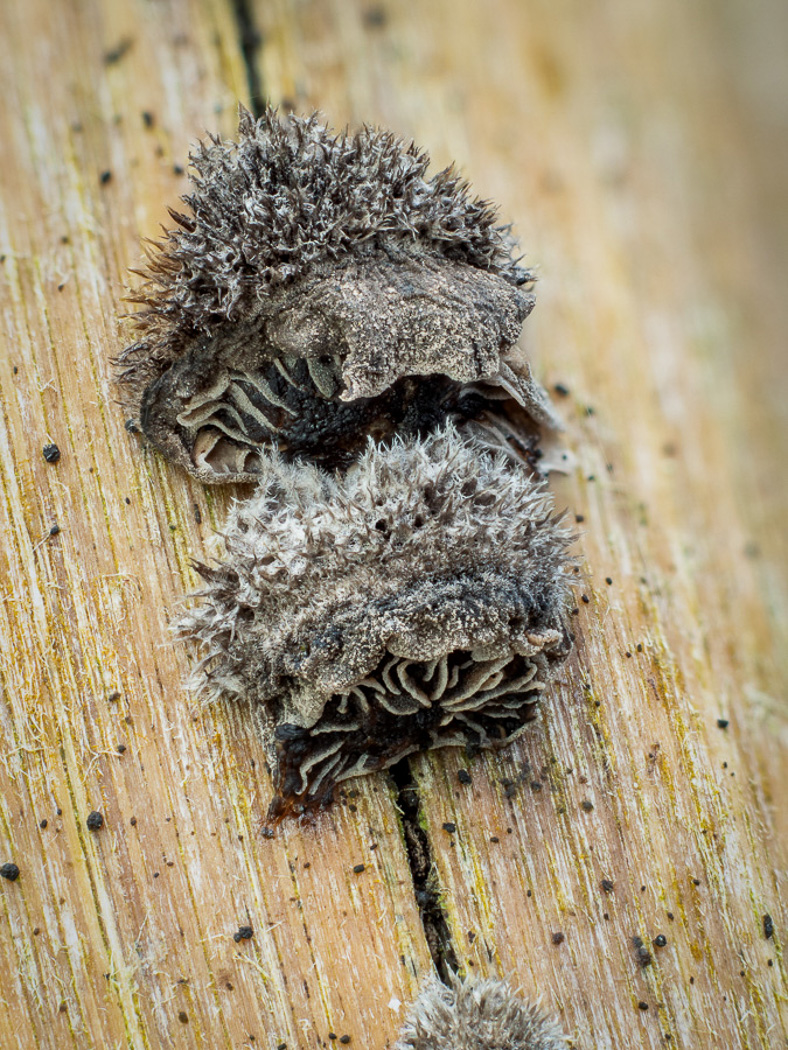 |
February 3rd Resupinatus trichotis (a rare Oysterling with no common name) 
In his veg patch at home, Barry Webb noticed these tiny little dark grey stemless caps growing in a tier out of a crack in a bamboo cane supporting his broccoli! They were strikingly hairy but at most 4 mm across and the concolorous gills had a white edge. Posting his photos online for a possible name, he received a couple of suggestions: a species of Hohenbuehelia or Resupinatus trichotis. He then sent the fresh specimens to Penny and the microscopic details quickly confirmed this was not Hohenbuehelia but was indeed the suggested Resupinatus - a species unfamiliar to Penny. Our county database reveals just three previous records, all on rotting deciduous wood of one sort or another, but Penny suspects the substrate here is somewhat unusual and noteworthy!
|
February 2nd 2021
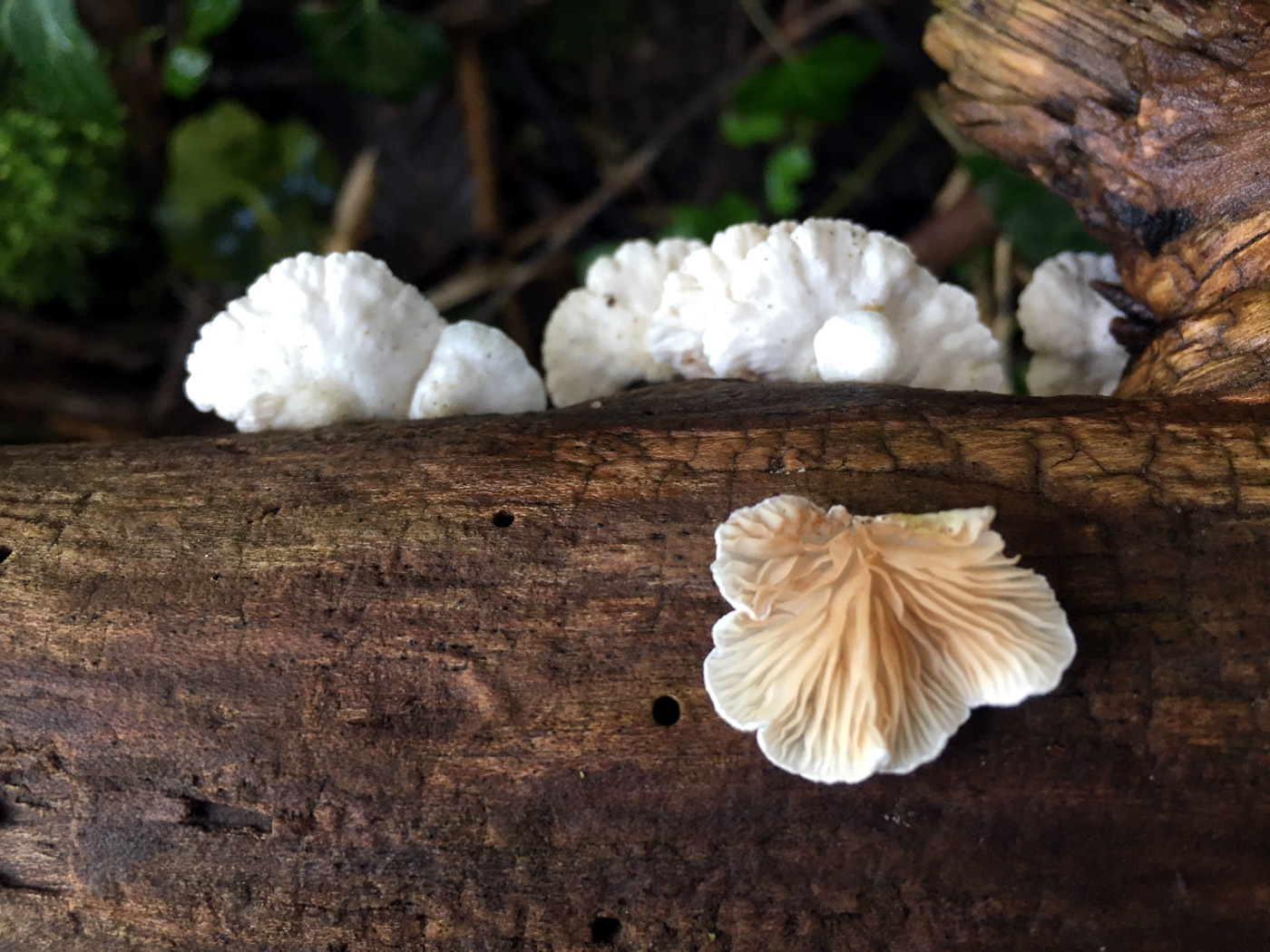 |
February 2nd Crepidotus applanatus (Flat Oysterling) 
Joanna Dodsworth noticed this species on a deciduous stick in an area of Brill Common known as The Walks. Several species in this genus look extremely similar - this being one of them - and cannot safely be named without taking spore shape and size amongst other things into account. Also very similar is Clitopilus hobsonii (a species in the same genus as The Miller) but that species has pink spores whereas Crepidotus has brown spores despite the fact that the young gills (seen here) do look pink.
|
February 1st 2021
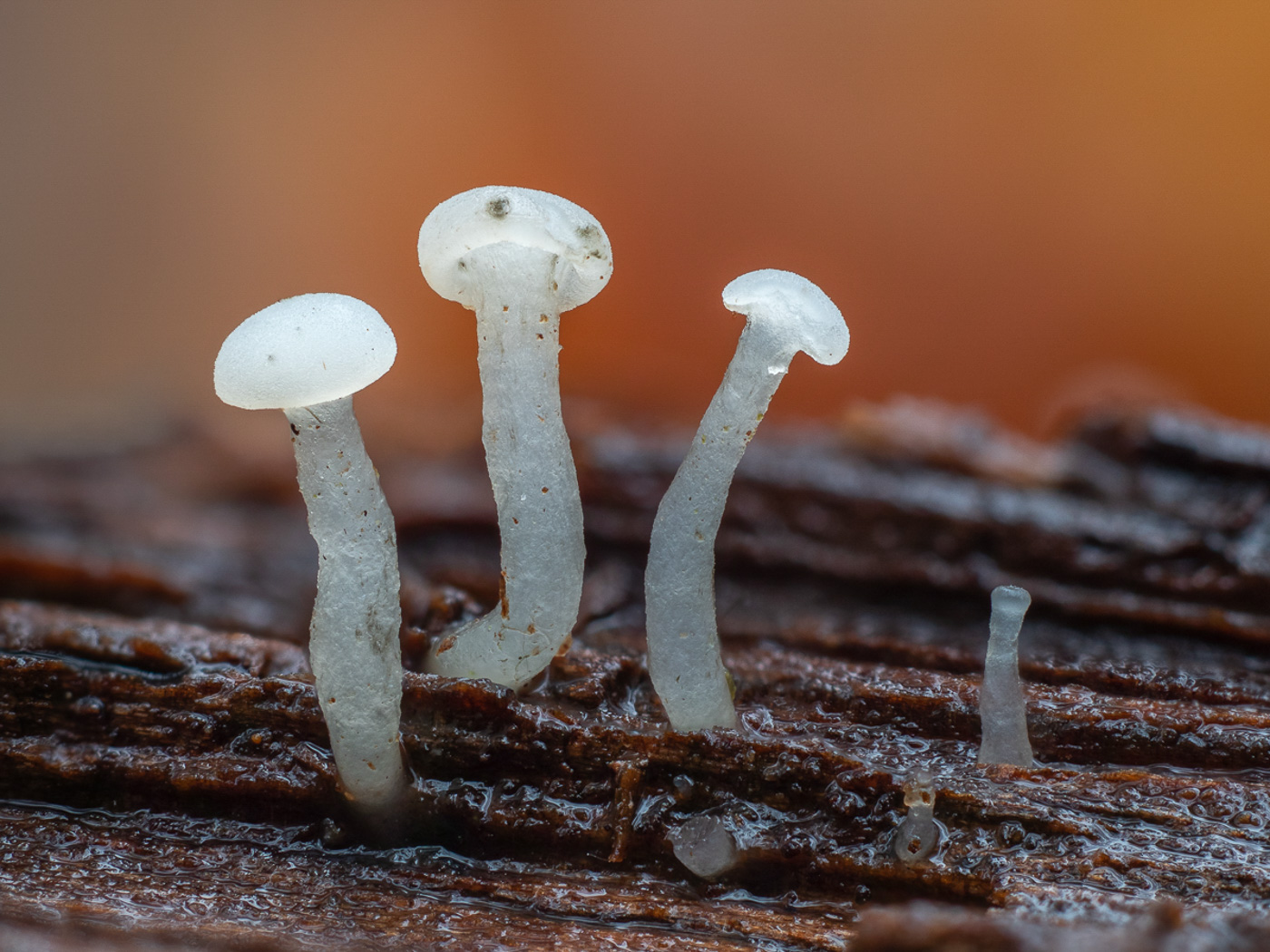 |
February 1st Cudoniella acicularis (Oak Pin)
In Burnham Beeches Barry Webb noticed these tiny white fruitbodies on bare rotting wood. Easily mistaken for a small Mycena or similar, this is in fact an Ascomycete and has no gills underneath despite the typical stem and cap of a mushroom. Usually fruiting from Autumn to early Winter, this is probably not that exceptional to find still appearing now.
|
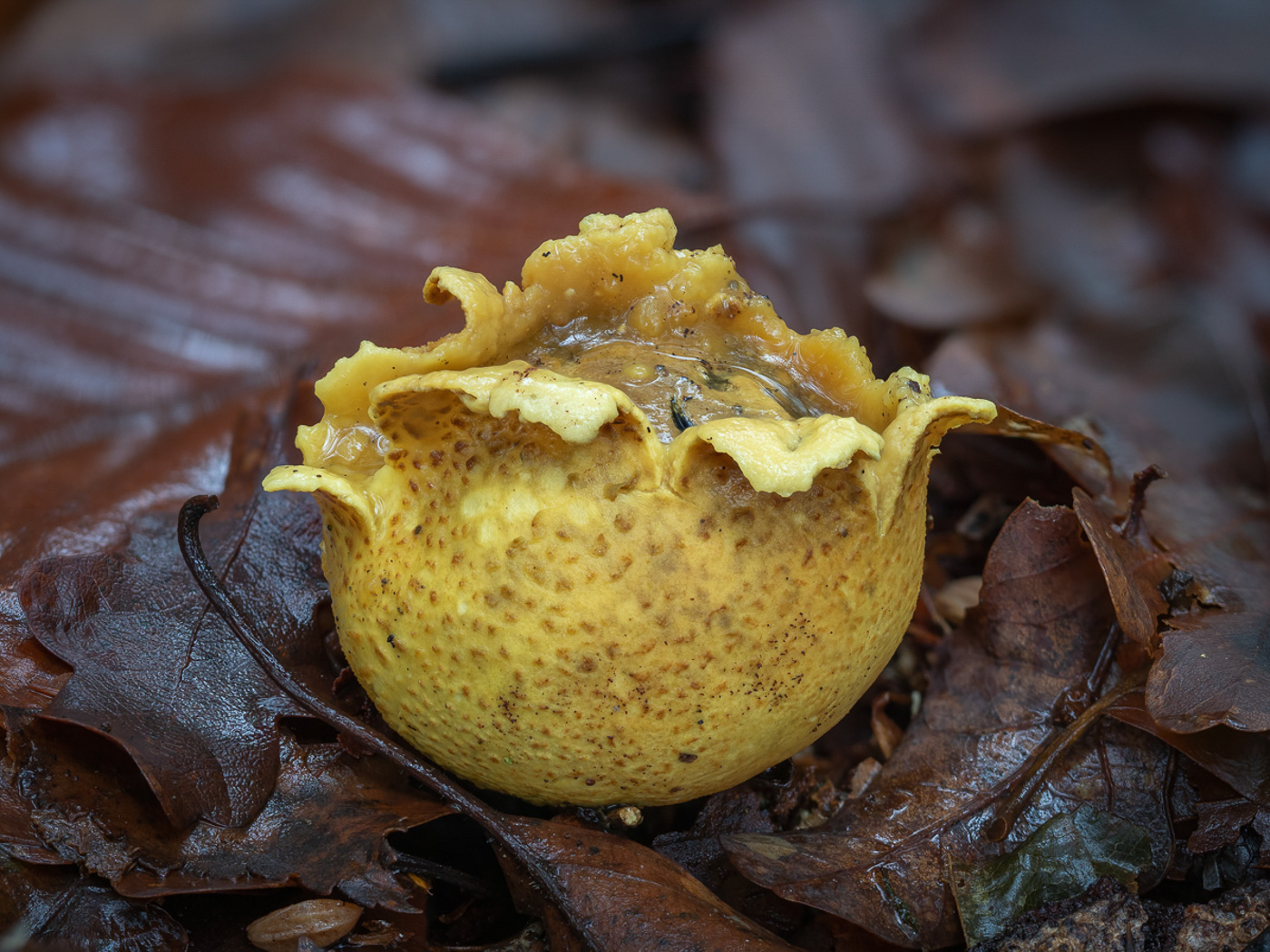 |
February 1st Scleroderma citrinum (Common Earthball)
In Burnham Beeches Barry Webb found this Earthball growing in soil amongst deciduous litter. Normally found fruiting from late Summer through the Autumn, this is an unusual find for early Spring to say the least! Distinguished in the field from others in the genus by its combination of yellow colour and rough scaly surface, it typically splits wide open as seen here to disperse its spores aided by raindrops or air movement.
|
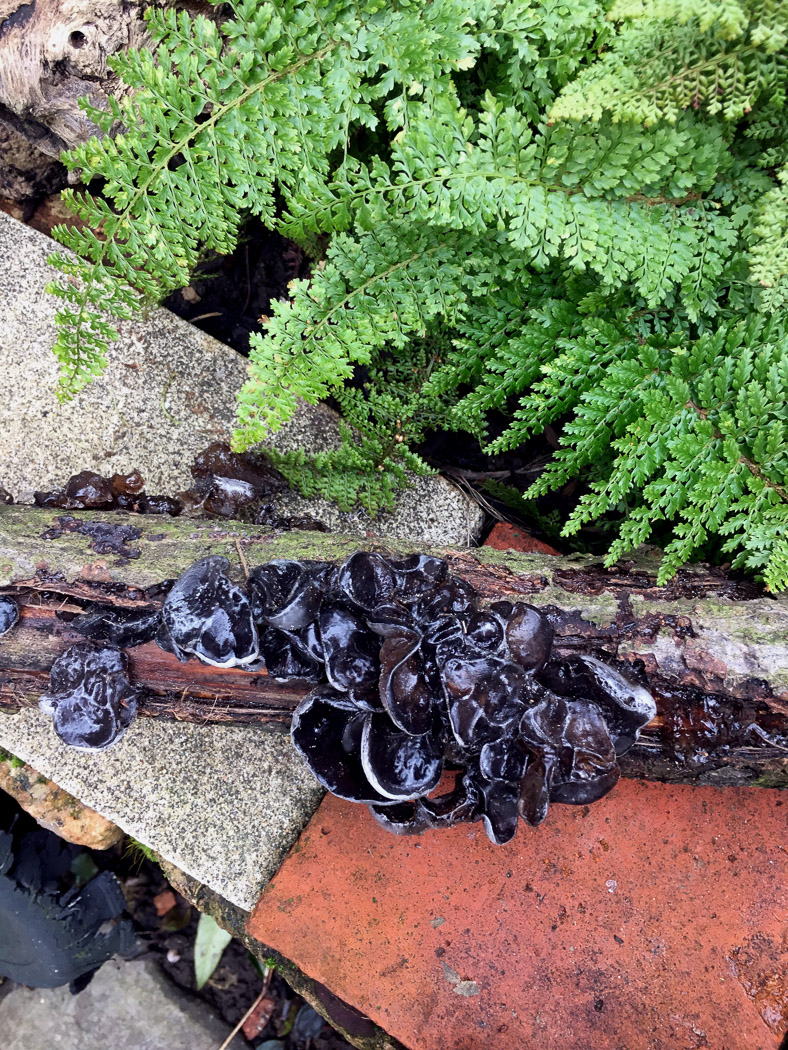 |
February 1st Exidia nigricans (= E. plana) ) (a jelly fungus with no common name) 
Joanna Dodsworth noticed this fungus on a piece of old deciduous firewood in her neighbour's store shed in Brill! Naming these almost black species of Exidia can be confusing as there have been various synonymies with the common E. glandulosa (Witches' Butter, see also photo dated Jan 06). However, Joanna dutifully checked the spores of this specimen and found them clearly too large for that species and therefore identified it as E. nigricans in 'Fungi of Temperate Europe' which, contrary to Index Fungorum, gives E. plana - its previous and better known name - as a synonym.
|
January 29th 2021
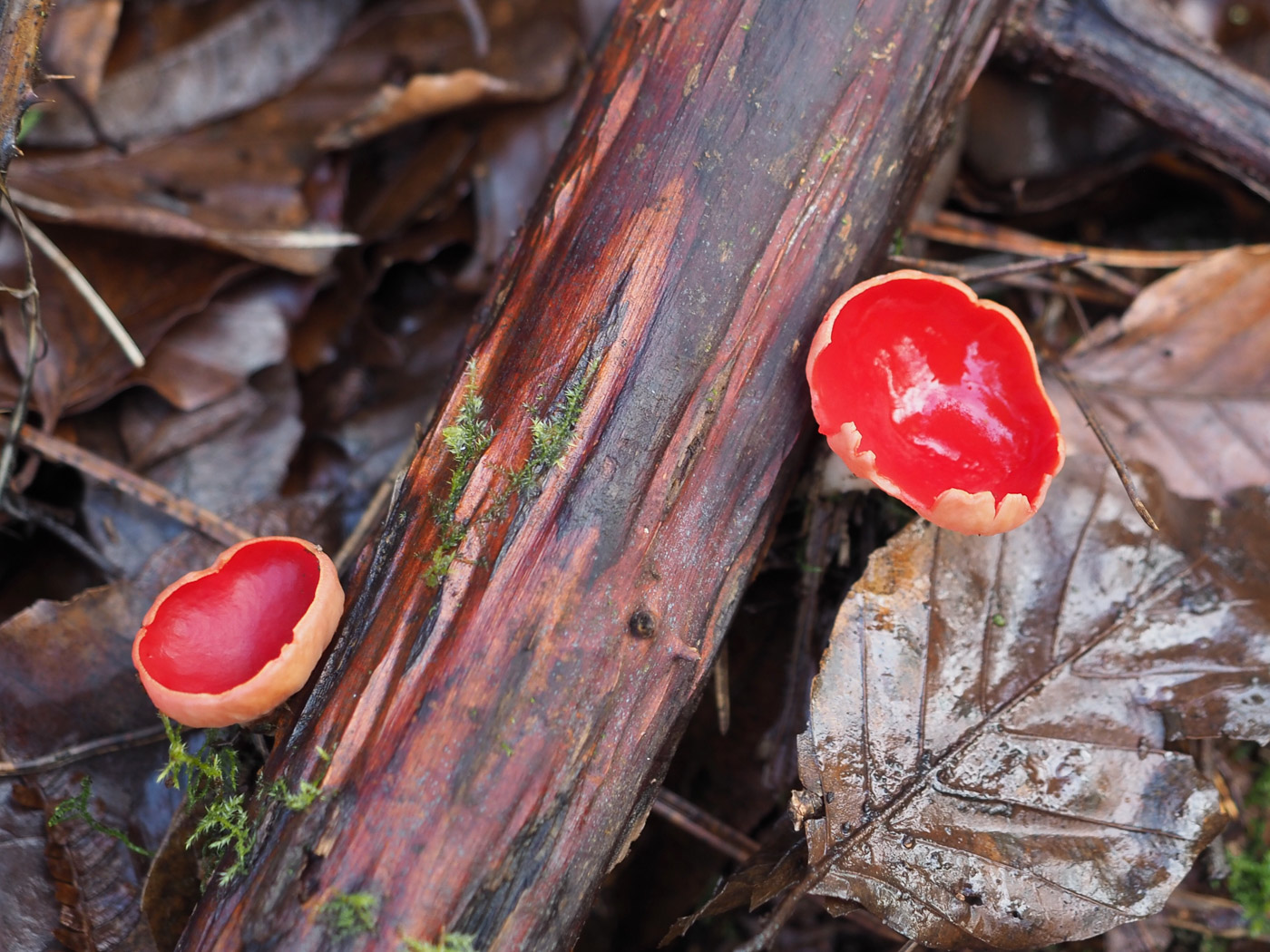 |
January 29th Sarcoscypha austriaca Sarcoscypha austriaca
At last we have an example of this charismatic and unmistakeable Springtime species, found by Claire Williams in woods near Downley. Penny was expecting to be inundated with photos of this but not so, though we did have an example in Finds 2020 dated Dec 20. It can be found on rotting damp deciduous fallen wood which is semi-buried or lying in contact with the ground, most often Willow.
|
January 28th 2021
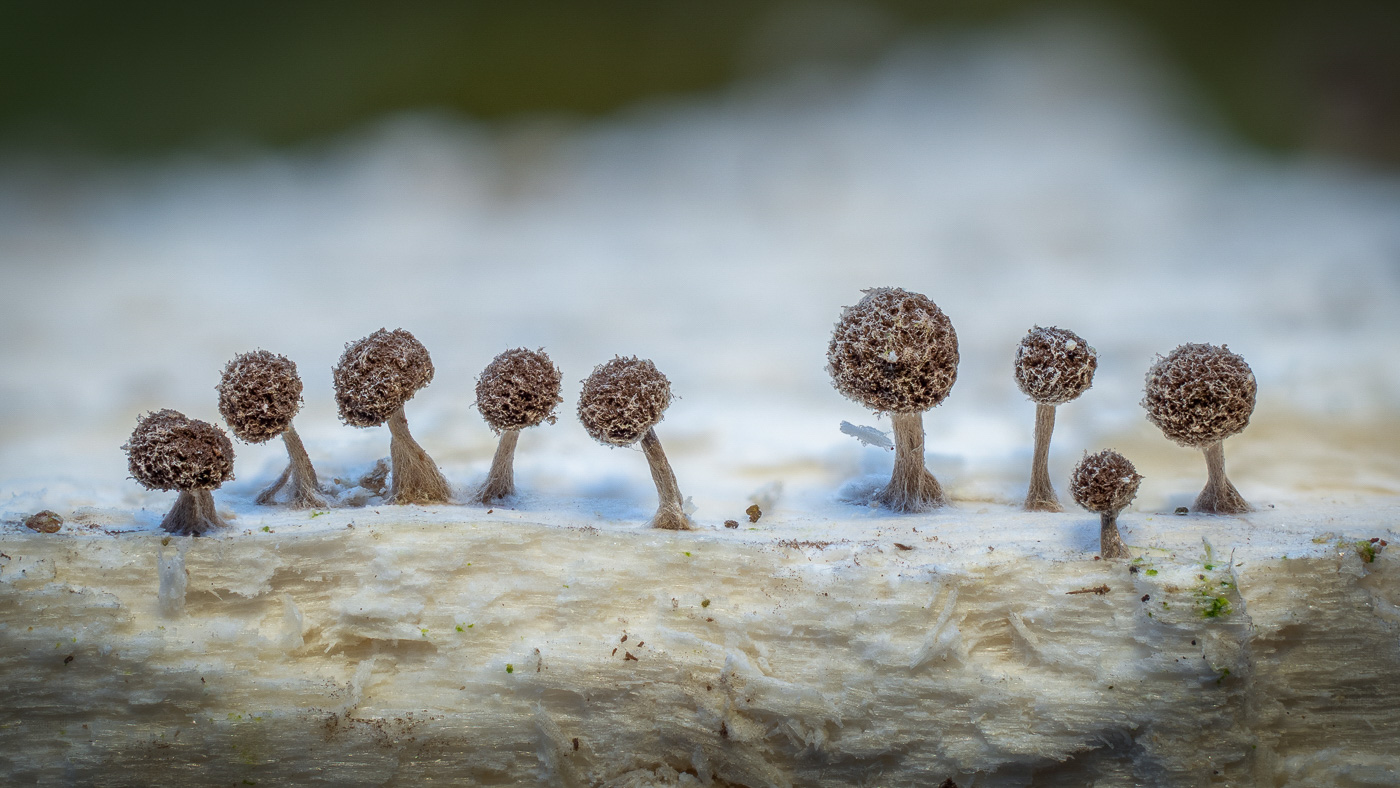 |
January 28th Phleogena faginea (Fenugreek Stalkball)
In Burnham Beeches Barry Webb spotted these small fruitbodies on dead Beech. This is an intriguing species - not one featured in Finds 2020 - because though it looks extremely similar to many slime moulds it is in fact a Basidiomycete. Not unalike the Gastromycetes (Puffballs etc), it has a mass of spores within which are dispersed as the outer surface breaks down in maturity. It is not that uncommon but, like many of our tiny wood inhabiting fungi, is easily missed, also probably often overlooked as a slime mould. A useful field clue to its identity is its remarkable curry-like smell which becomes more noticeable once collected as it dries, hence its common name.
|
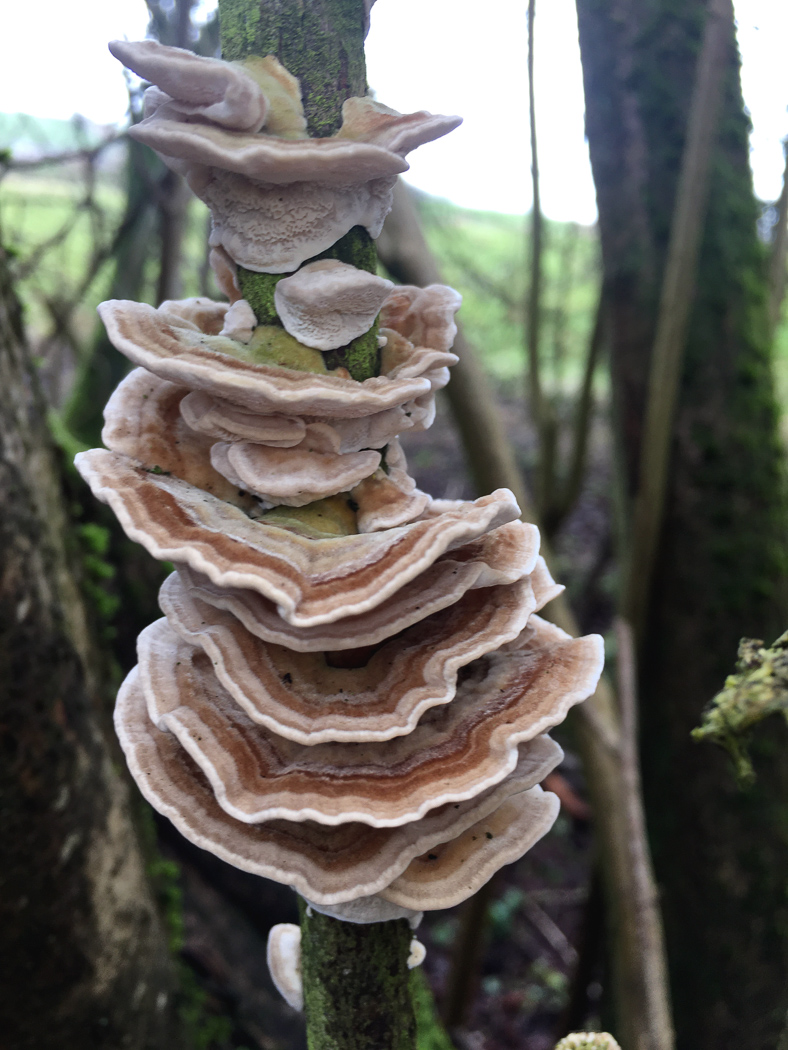 |
January 28th Trametes ochracea (a bracket with no common name) 
In Brill Common Joanna Dodsworth found this attractive tier of brackets on dead but standing Hazel. Similar to the much commoner Trametes versicolor (Turkeytail), it is thicker fleshed with slightly larger pores underneath and often has green algi on the upper surface (as also does the larger Trametes gibbosa (Lumpy Bracket).
|
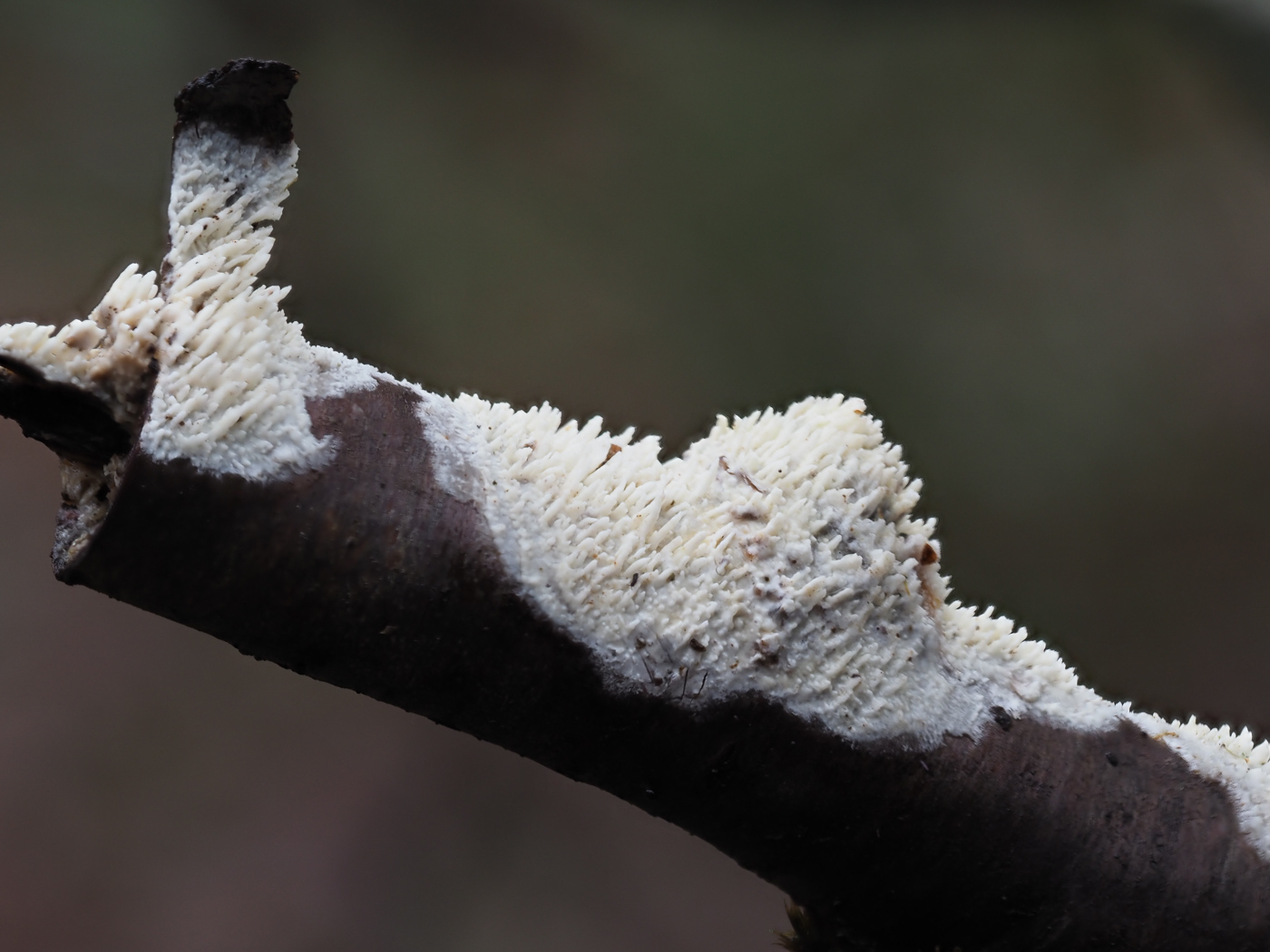 |
January 28th Basidioradulum radula ( (Toothed Crust)
Claire Williams spotted this example of young material of a common resupinate corticioid species in Downley Common fruiting on fallen deciduous wood. At this stage of development it is pretty well all whitish but clearly with a 'toothed' appearance, but when mature it tends to develop rounded patches with creamy centres. To see a more developed example see Finds 2020 dated Dec 07.
|
January 27th 2021
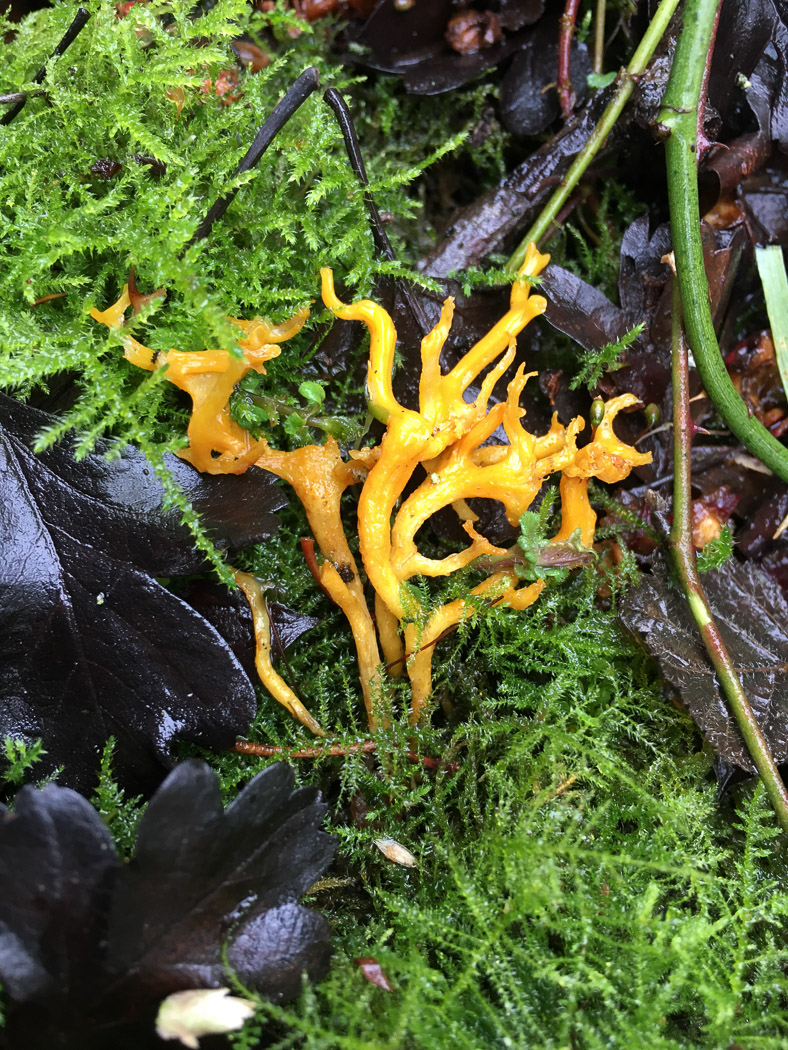 |
January 27th Clavulinopsis corniculata (Meadow Coral) 
In woodland litter in Brill Common Joanna Dodsworth noticed this bright yellow coral which at first she assumed was Calocera viscosa (Yellow Stagshorn). However, that species only occurs on conifer (not present here) so further work was needed to identify it. In fact it is not that unusual to find the normally grassland members of the genus Clavulinopsis fruiting in woodland (as the genus Hygrocybe sometimes does as well), so the common name in this case is somewhat misleading. This particular Coral is probably the commonest of its genus to occur in this habitat and also tends to continue fruiting longer into the winter season. (See also Finds 2020 dated Nov 08 and 20.)
|
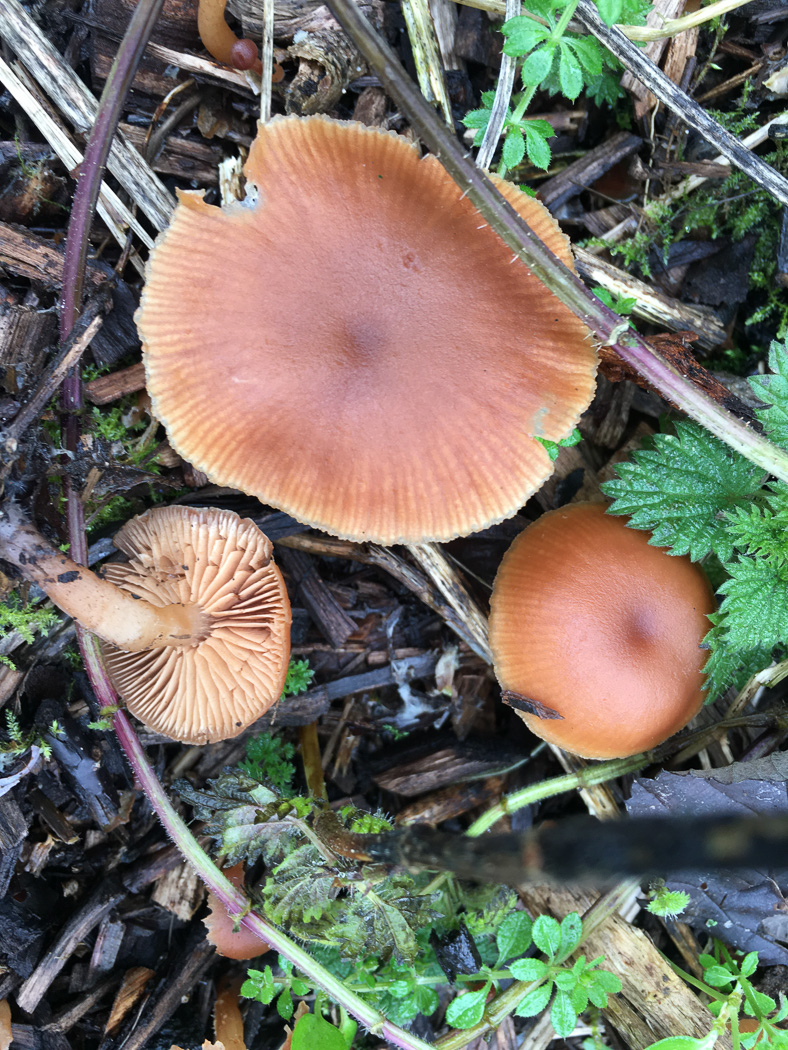 |
January 27th Tubaria furfuracea (Scurfy Twiglet)
We already have a couple of photos of this common species (dated Jan 10th) but Joanna Dodsworth's collection from Brill Common amongst deciduous debris gives another example of an LBJ that often confuses people, especially after rain (we've had plenty of that recently!) when the tell-tale 'scurfy' bits usually visible on the edge of the cap have been washed off leaving it smooth and easily mistaken for something different. This species could well be described as the default LBJ, so if in doubt about a little nondescript brown mushroom among woody litter (sometimes on wood itself) this might well be what you have!
|
January 23rd 2021
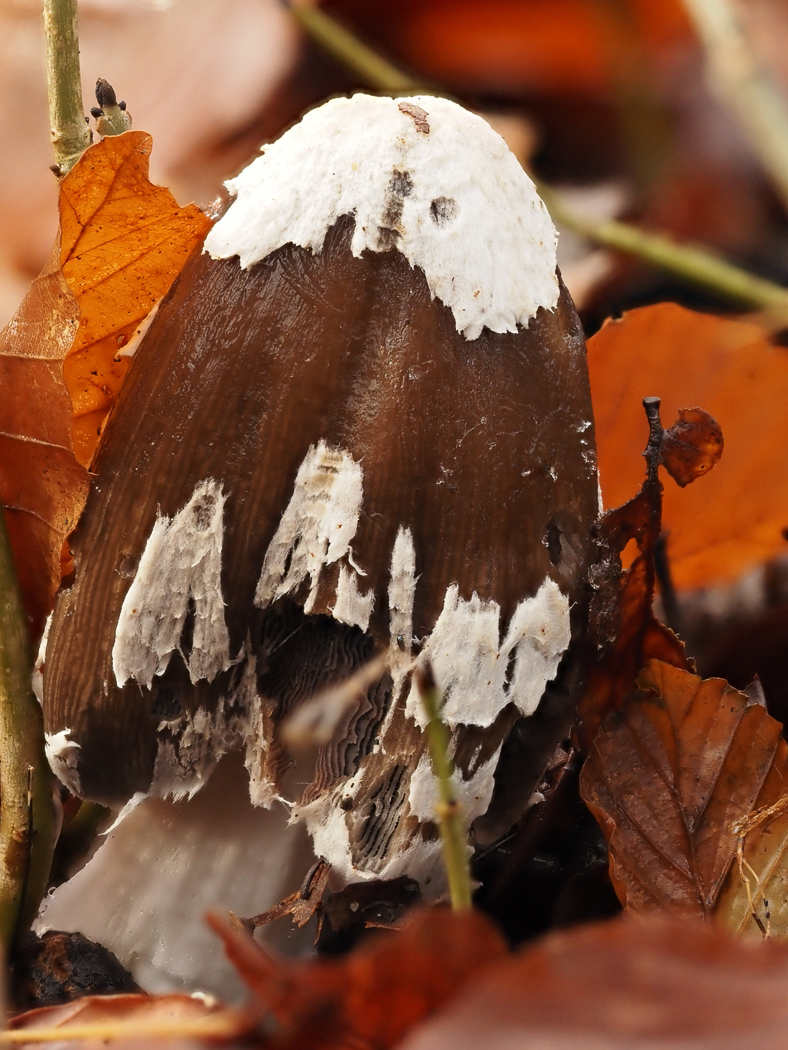 |
January 23rd Coprinopsis picacea (Magpie Inkcap)
In Downley Wood today Claire Williams spotted this somewhat unseasonal Inkcap in deciduous litter. This is a species which was much in evidence last Autumn and Claire says she'd noticed it again at this site in late December so was on the look out for it. Probably quite an unusual find for frosty weather in January!
|
January 20th 2021
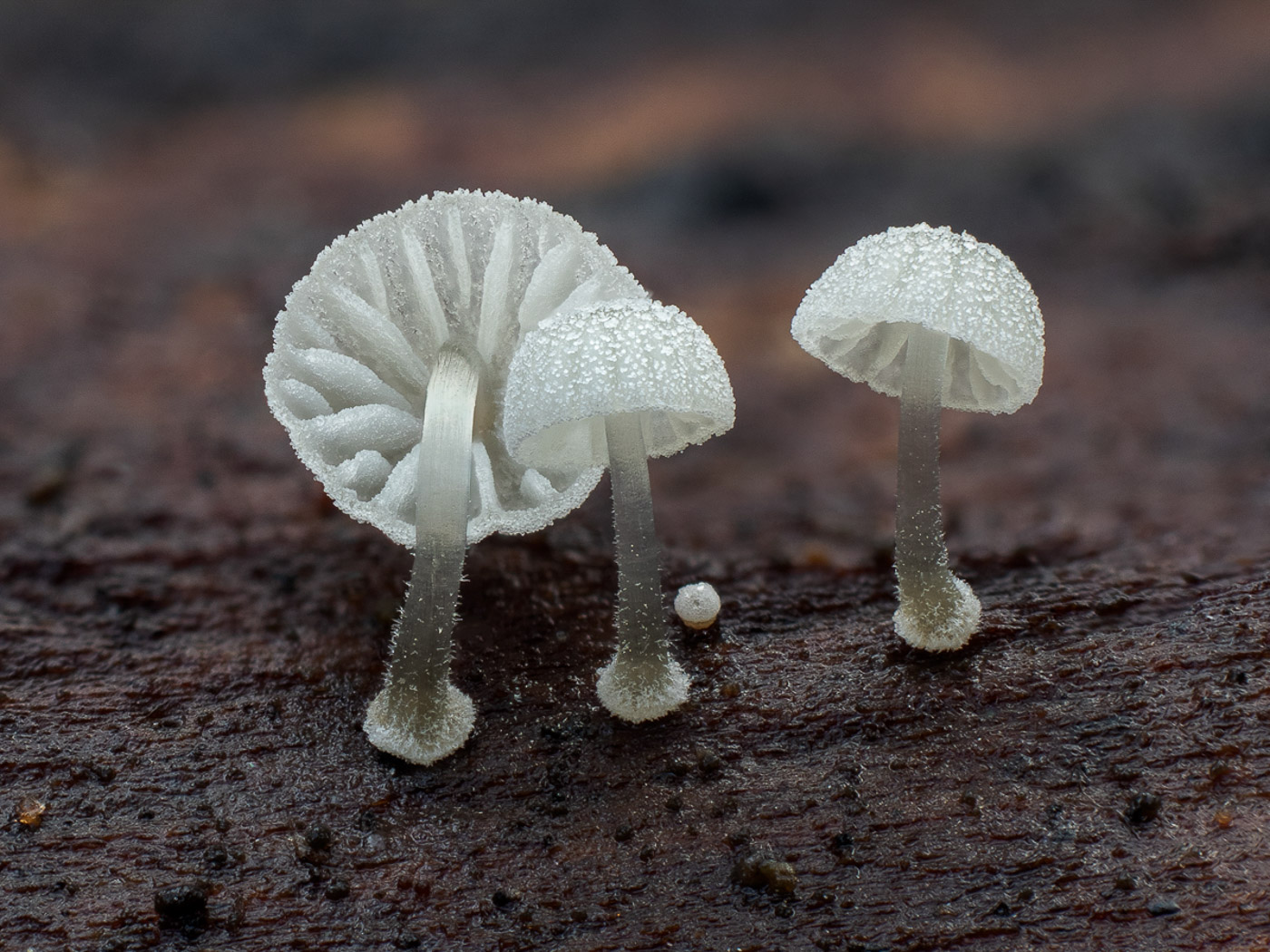 |
January 20th Mycena tenerrima (Frosty Bonnet)
Barry Webb spotted these tiny white bonnets on a fallen branch, possibly Oak, in Burnham Beeches. The determination has not been checked microscopically and there are several very similar tiny white Bonnets which grow on wood and which can have this 'frosted' appearance; however, the distinctive bulbous stem bases are a sure give-away feature and absent in other likely candidates.
|
January 14th 2021
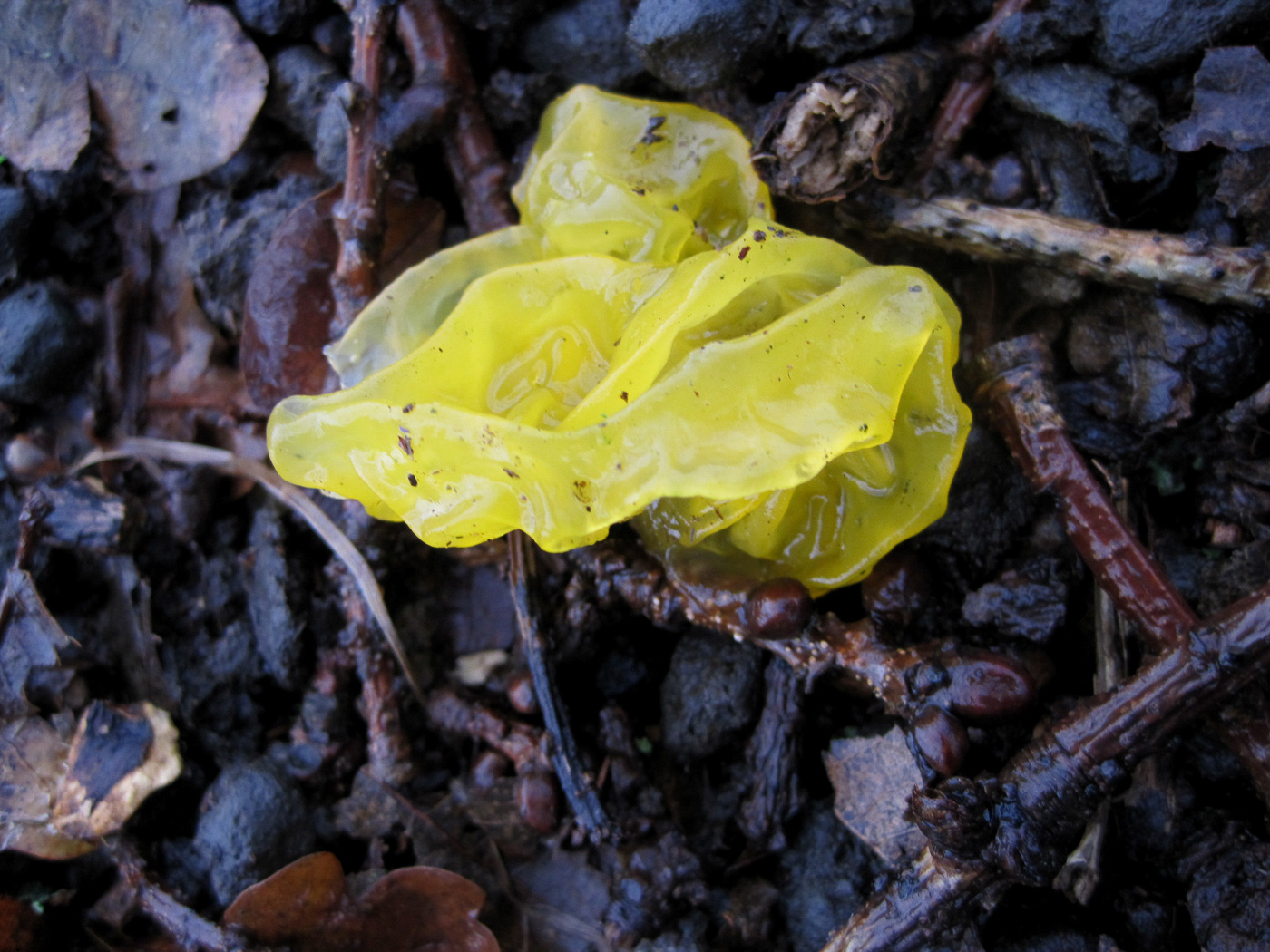
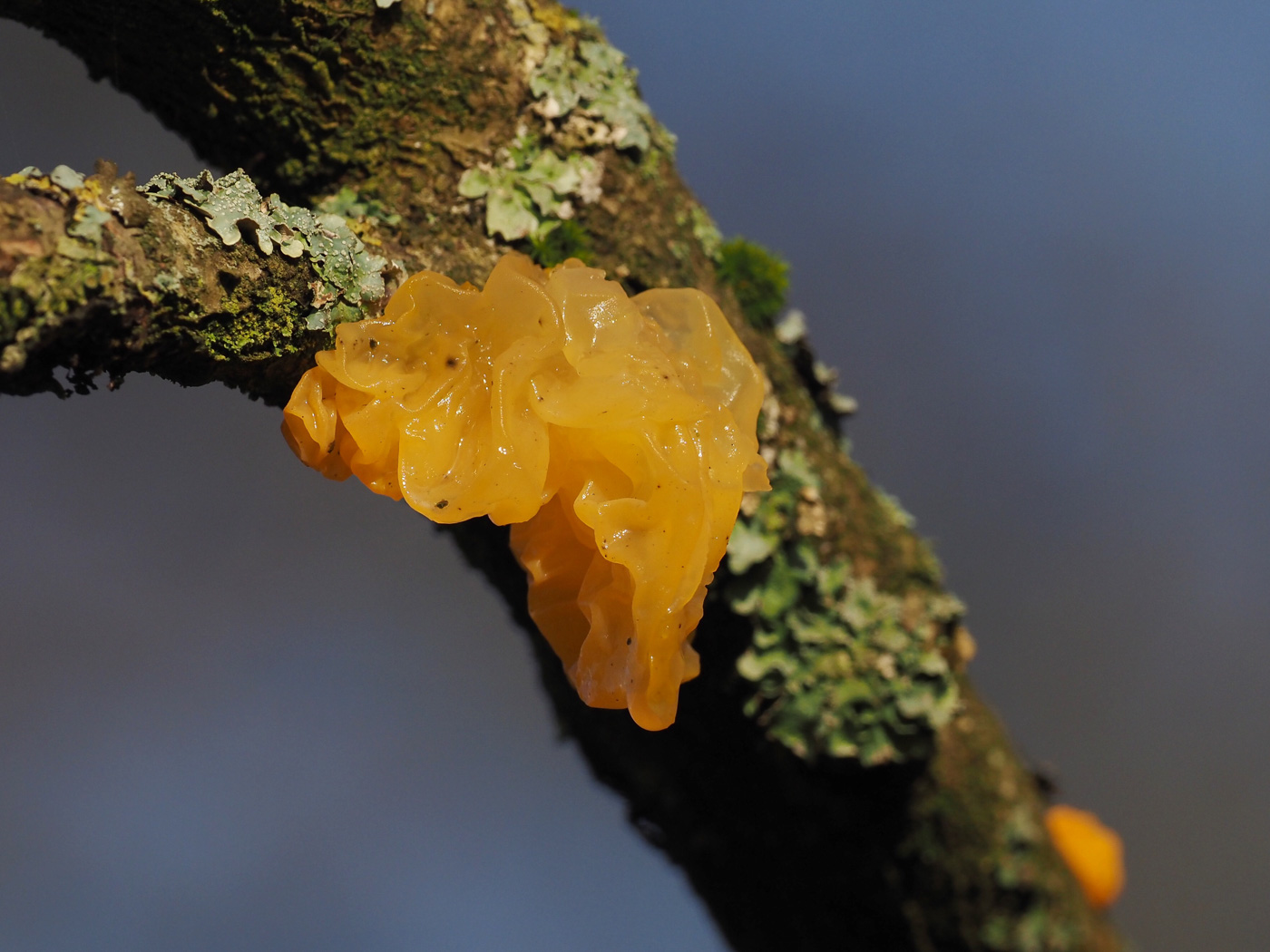 |
January 14th Tremella mesenterica (Yellow Brain)
This species was spotted by Joanna Dodsworth on a pile of deciduous sticks in Brill Common (photo 1) and also by Claire Williams the following day on an Oak stick in Downley Common (photo 2). (See also Members Finds Oct 30th.) Jelly fungi seem to be unhindered by the winter weather: we have examples of several species found in the last couple of weeks.
|
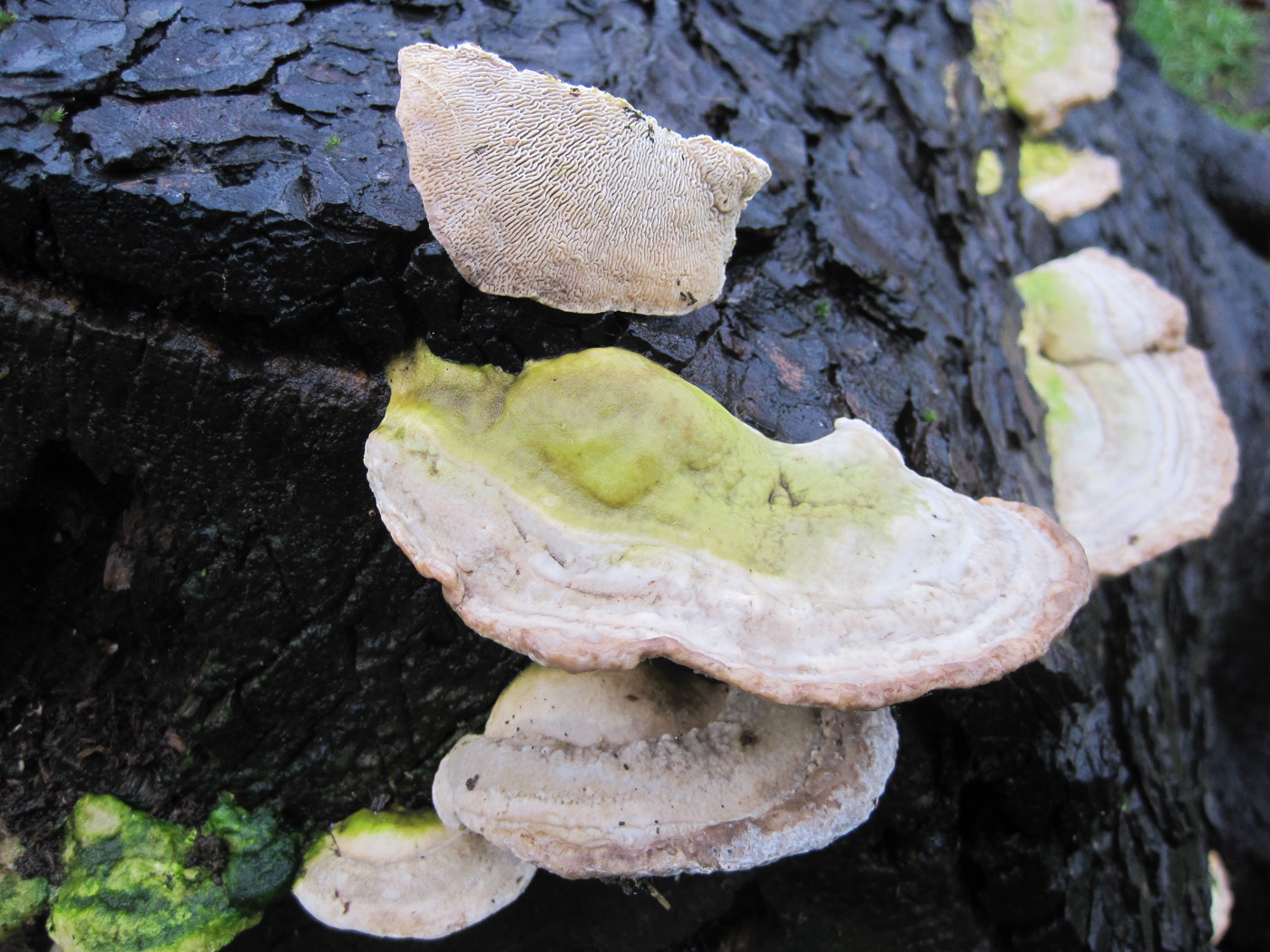 |
January 14th Trametes gibbosa (Lumpy Bracket)
Joanna Dodsworth noticed these brackets on fallen Horse Chestnut in Brill Common. Typical of this common species is the green algae growing on the upper surface and the maze-like almost semi-gills on the underside - both features visible in the photo. (See also Finds 2020 dated Sept 20th.)
|
January 12th 2021
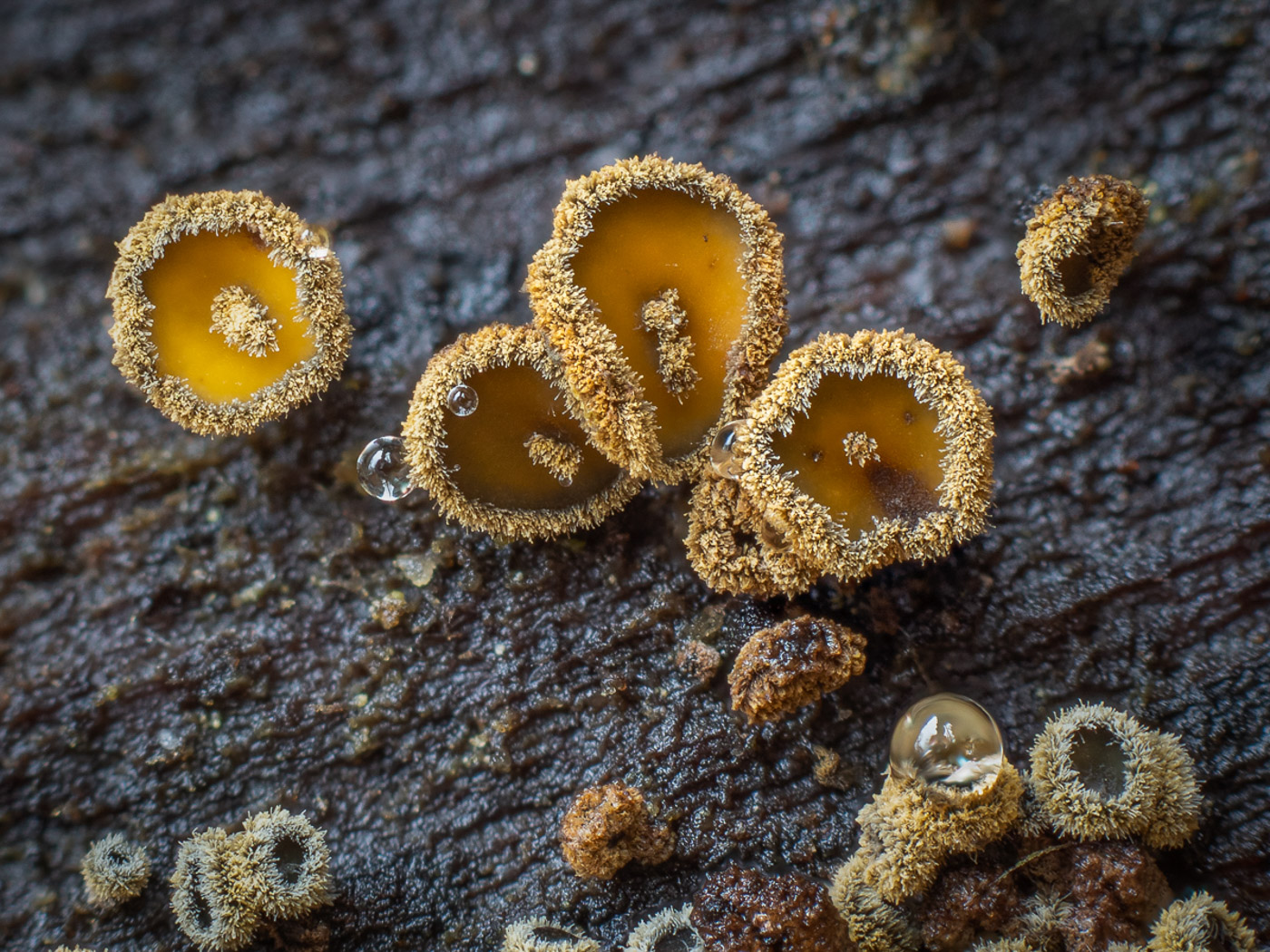 |
January 12th Neodasyscypha cerina (a cup fungus with no common name)
Barry Webb found these tiny little stalkless cups on fallen Beech in Burnham Beeches. The identification has been made simply from their appearance in the photograph where the distinctive bright yellow centres and contrasting hairy outer surface seem diagnostic, also though we have no other county record of this species it is apparently quite common on Beech. Barry suggested the common name Lemon Tarts!
|
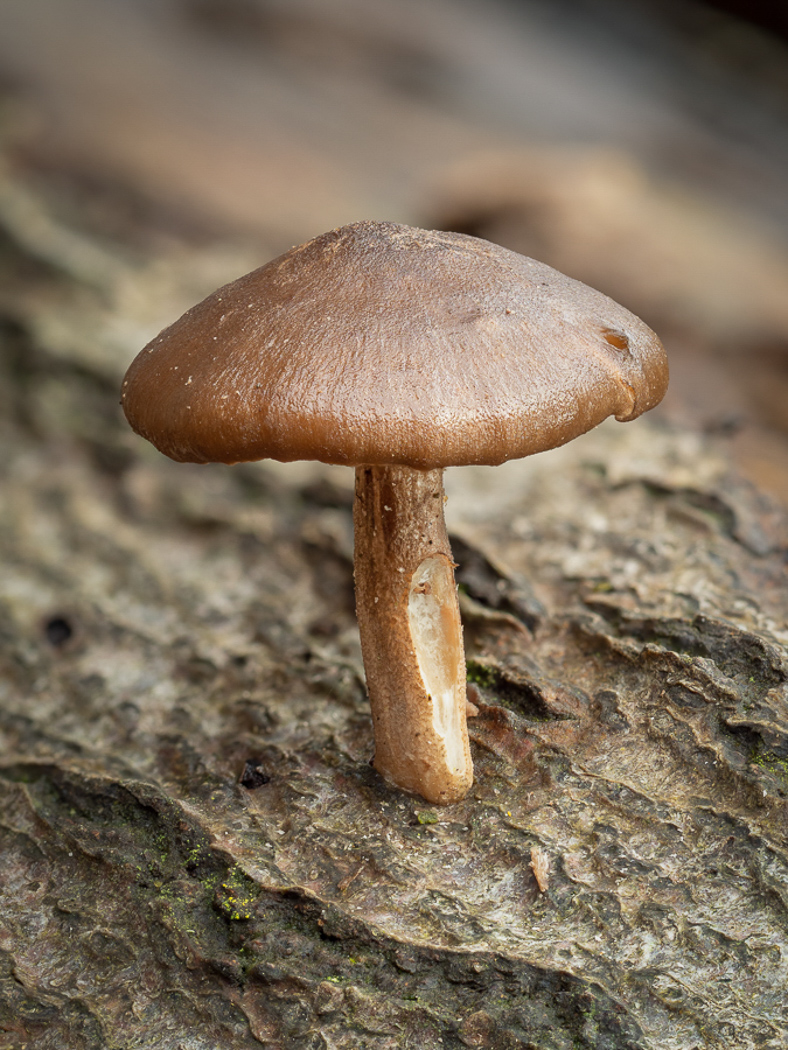 |
January 12th Polyporus brumalis (Winter Polypore)
Barry Webb found this fungus on fallen Beech in Burnham Beeches. At first glance not unalike a species of Pluteus or other brown-capped mushroom, it is not until one looks underneath and notices not gills but pores that the genus becomes obvious. One of several quite common species of Polypore, this is quite evenly brown, has widely spaced pores and is aptly named - often fruiting late in the season.
|
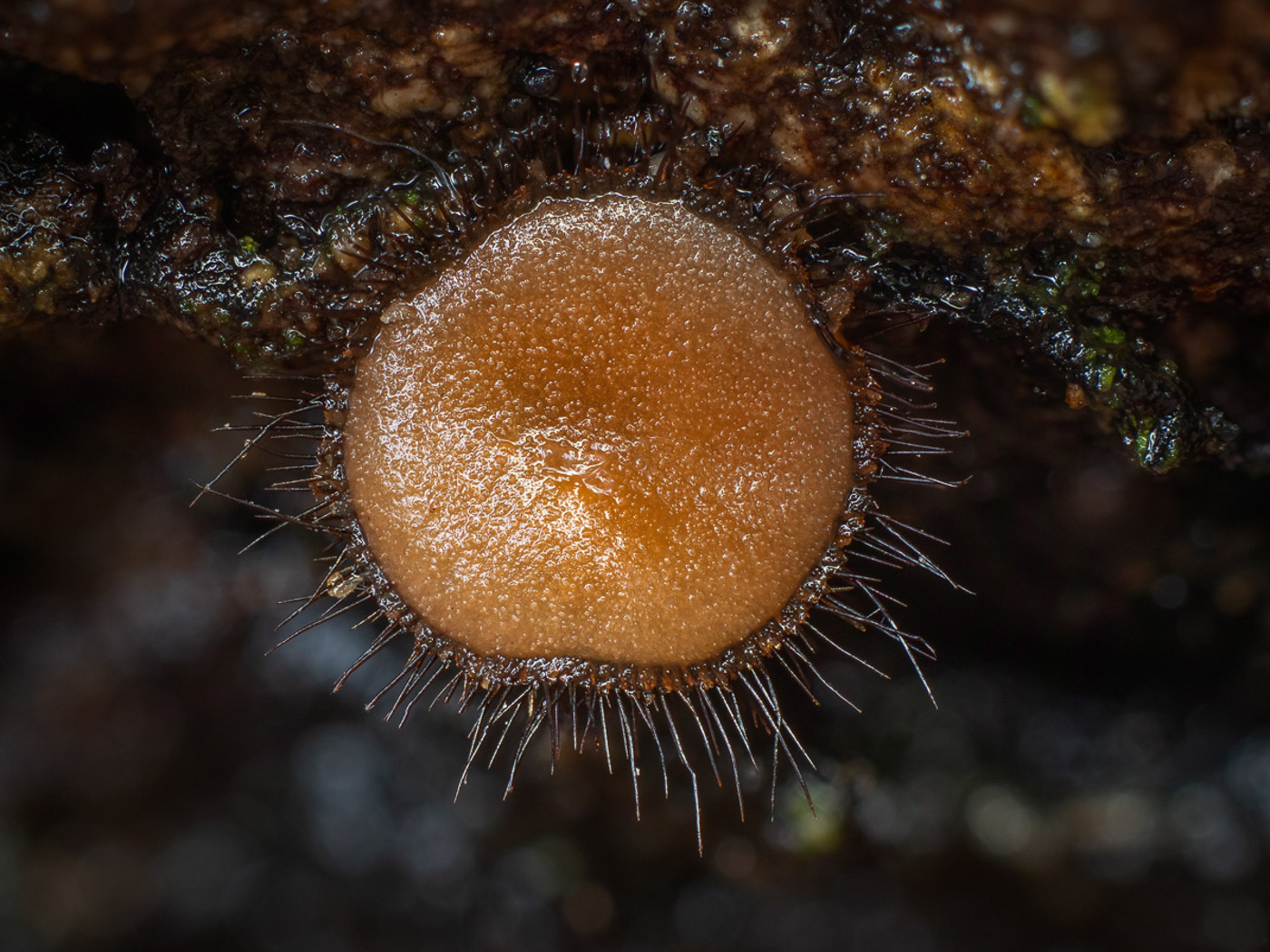
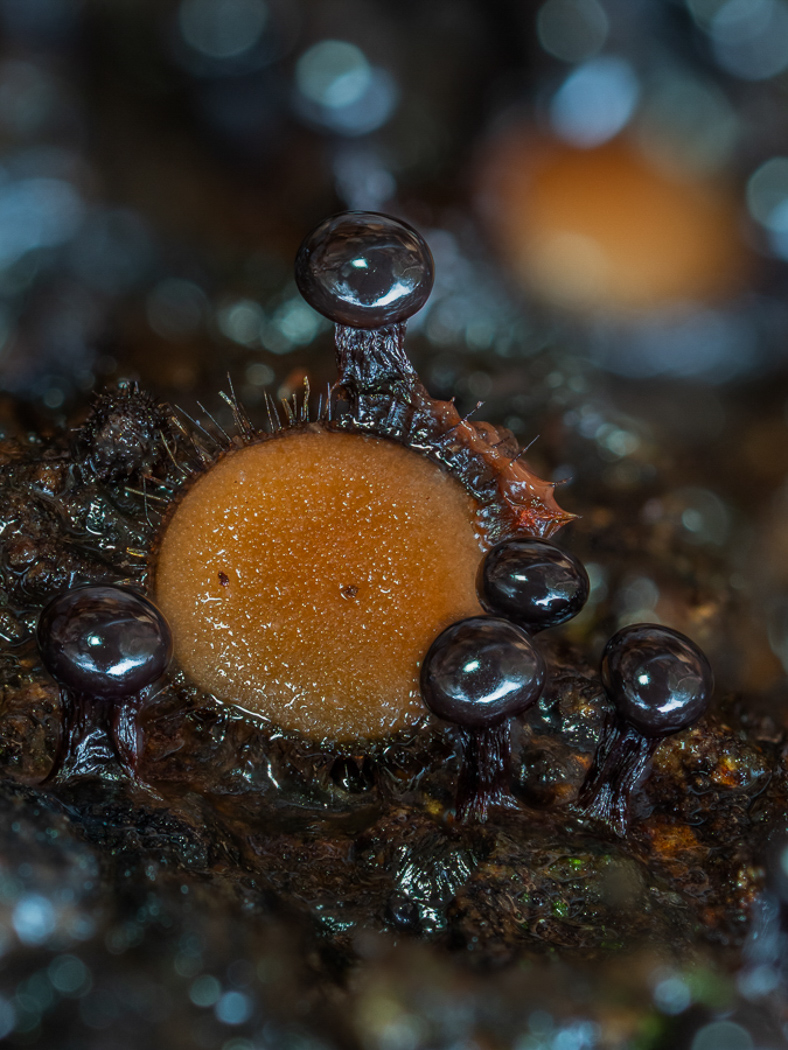 |
January 12th Scutellinia scutellata (Eyelash Fungus) with Metatrichia floriformis (a slime mould with no common name)
Barry Webb found these two species growing together on rotting bare wood in Burnham Beeches. Though not checked with a scope, the Eyelash Fungus is likely to be this particular species which has by far the longest eyelashes in the genus. The tiny stalked black slime mould specimens are at the stage just prior to splitting open to reveal the spore mass within. (See more images in Finds 2020: Scutellinia dated Sept 28th and Oct 1st, Metatrichia dated dated Oct 17.)
|
January 11th 2021
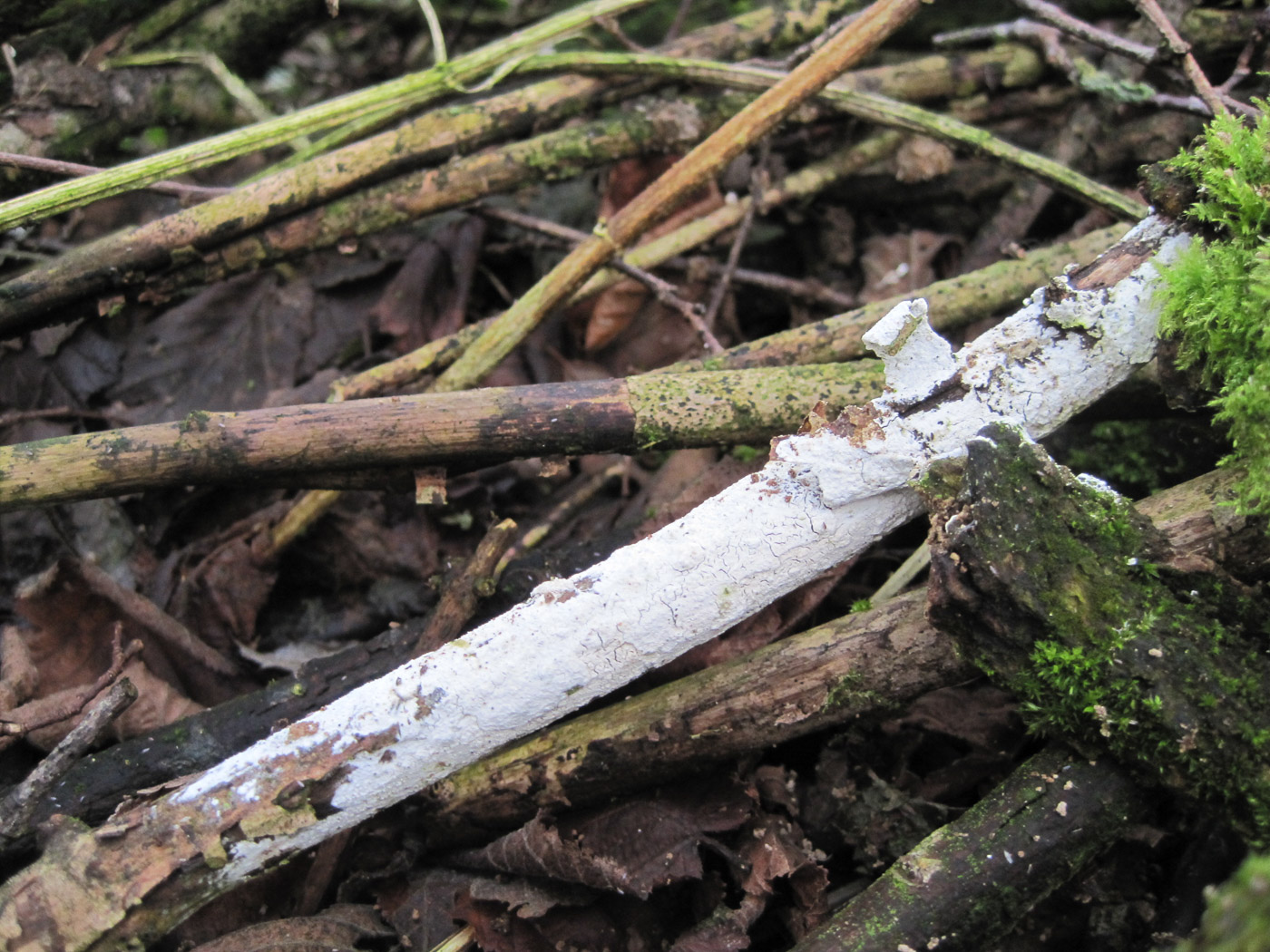 |
January 11th Hyphodontia sambuci (Elder Whitewash)
On part of Brill Common Joanna Dodsworth noticed this good example of one of the commonest corticioid fungi (those which are flat, don't form brackets, and often look like splodges of white paint on fallen wood). The genus Hyphodontia is large and nearly always needs a scope to identify to species but this aptly named species is so common on Elder - both living or fallen as here - that one can safely name it in the field though it does occur on other deciduous woods as well.
|
January 10th 2021
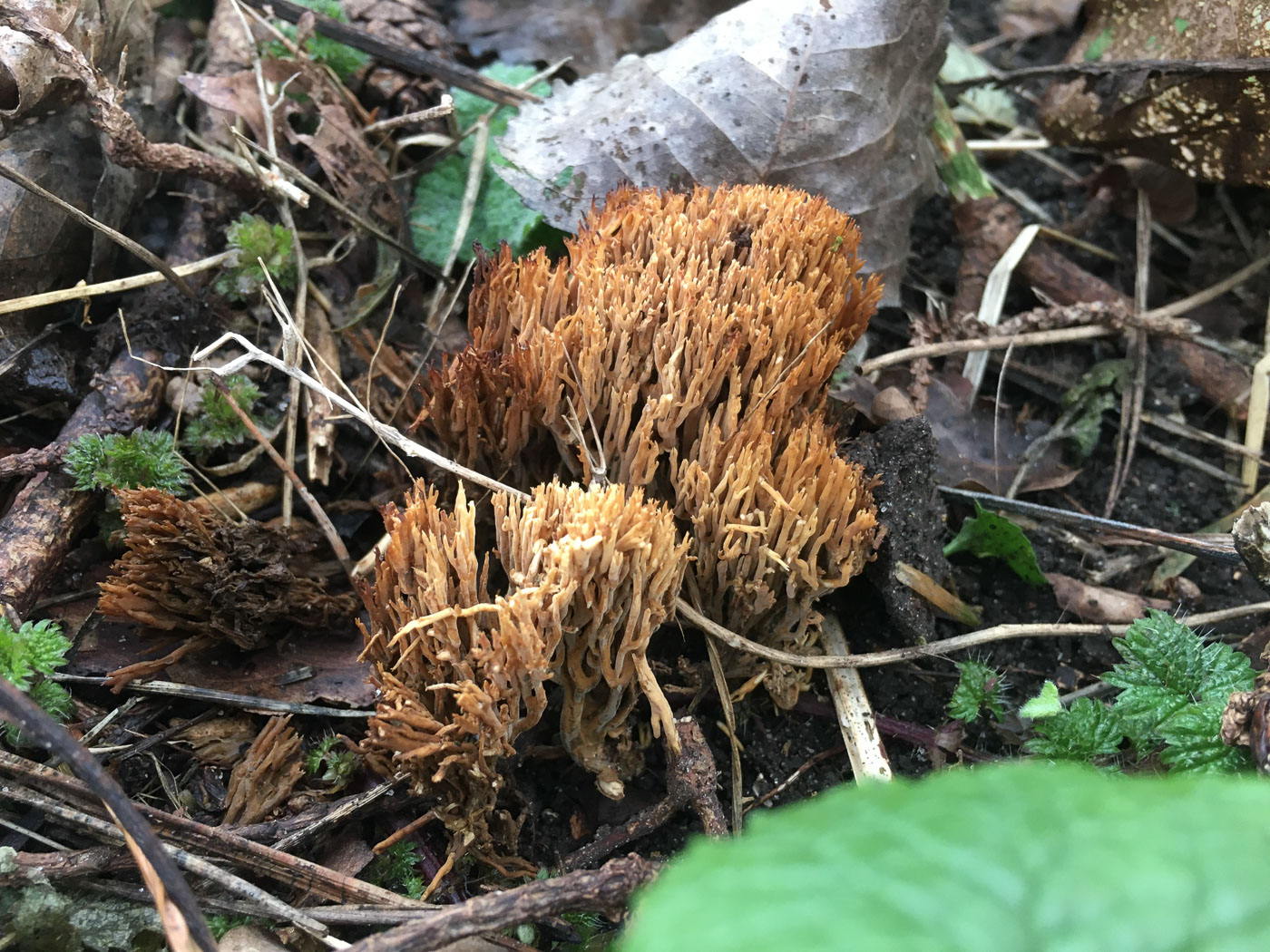 |
January 10th Ramaria (= Phaeoclavulina) decurrens (Ochre Coral) 
In Cherry Orchard Nature Park near Burnham Russell Ness found this unusual Ramaria in mixed coniferous and deciduous woody litter. He thought it looked different from the common R. stricta (Upright Coral) so checked the spores which were indeed clearly too small for that species, which then led him on to this determination. We have just one previous county record, under Pine in Penn Wood Churchyard. The genus Ramaria has now been split, those species which are mycorrhizal (such as R. stricta) remaining and those known to be wood decomposers moved to the new genus Phaeoclavulina, hence the genus name change here.
|
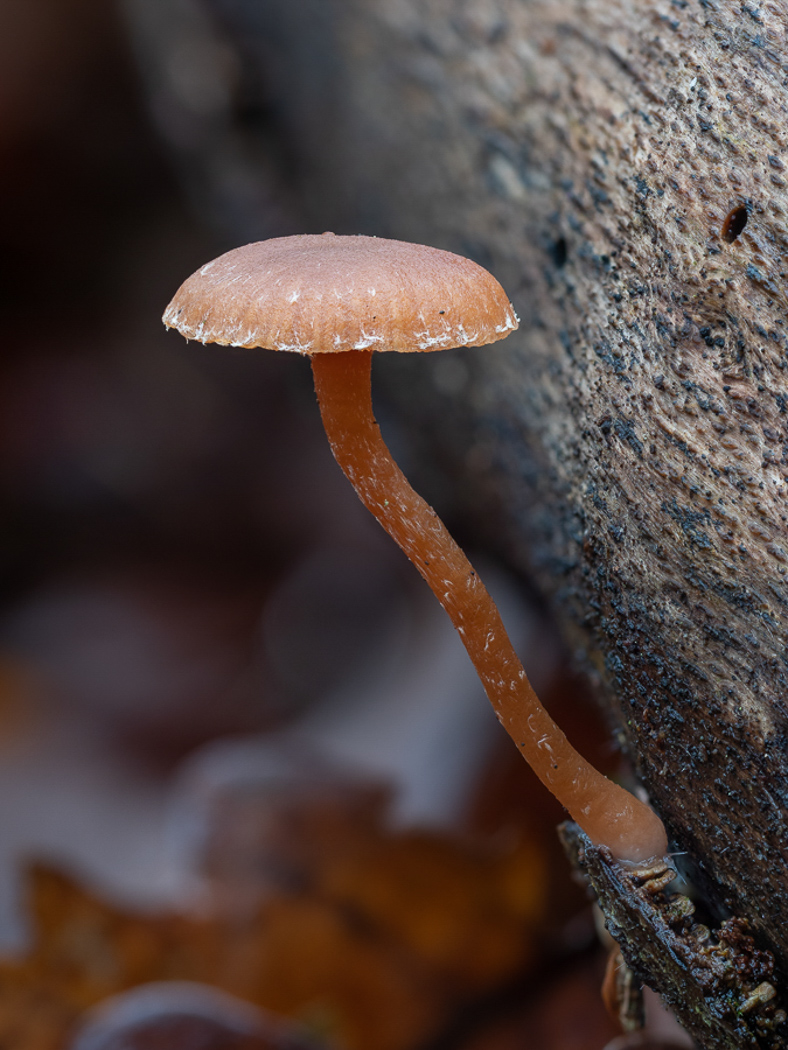
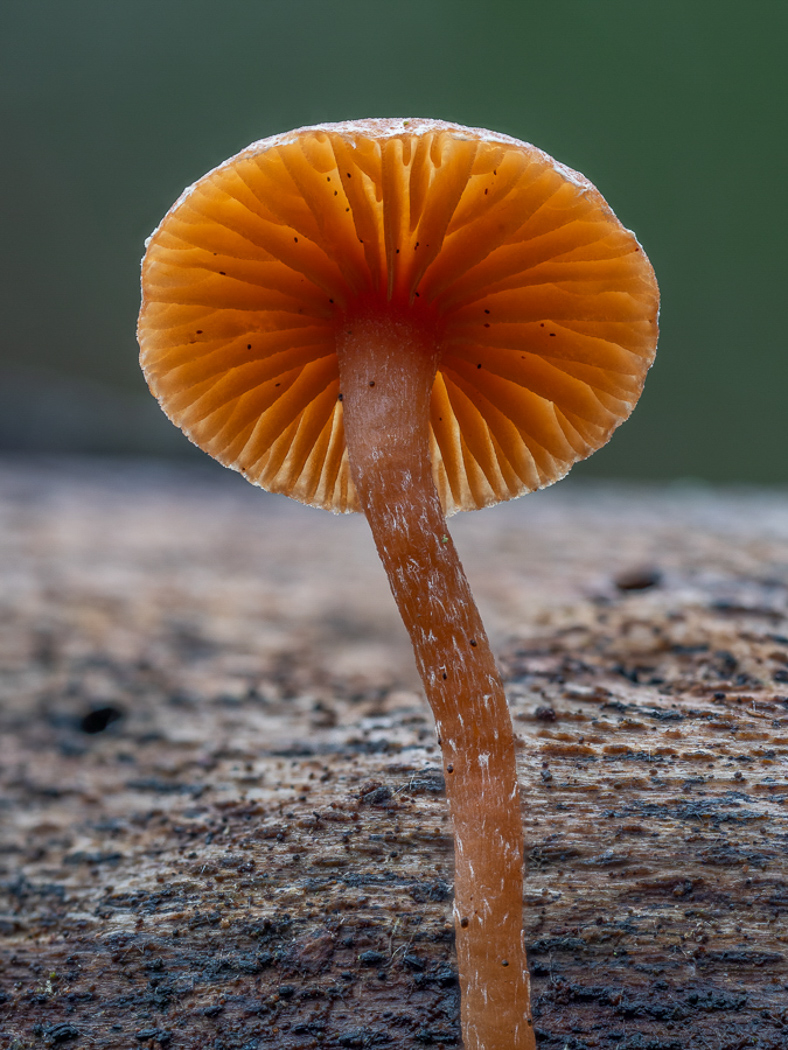 |
January 10th Tubaria furfuracea (Scurfy Twiglet)
Barry Webb found these small mushrooms fruiting on deciduous wood in Burnham Beeches. This species is a very common LBJ and often mistaken for a species of Galerina or Conocybe - both genera very similar in size and colour of caps and gills. Look for the remnants of white veil near the cap margin (seen in photo 1), the often slightly decurrent gills (though not in this case!), the white veil flecks on the stem as well, the even colour over the whole fruit body and its often clustered habit - sometimes in very large numbers - in woody litter. (For another example see Finds 2020 dated Oct 3rd.)
|
January 8th 2021
 Lane End 10.01.2021 CW.jpg) |
January 8th Exidiopsis effusa (HAIR ICE!)
Claire Williams has found a beautiful example of a rare sight known as Hair Ice (also Ice Wool / Frost Beard) in Lane End. It is only in recent years that the fungus responsible for this phenomenon, a 'Jelly fungus' called Exidiopsis effusa, has been identified and these amazing ice crystals only form on wood affected by this fungus in really moist icy conditions - exactly what we have been experiencing recently! To learn more about this fascinating process there is lots of information online including several videos on 'YouTube' which are well worth seeing!
|
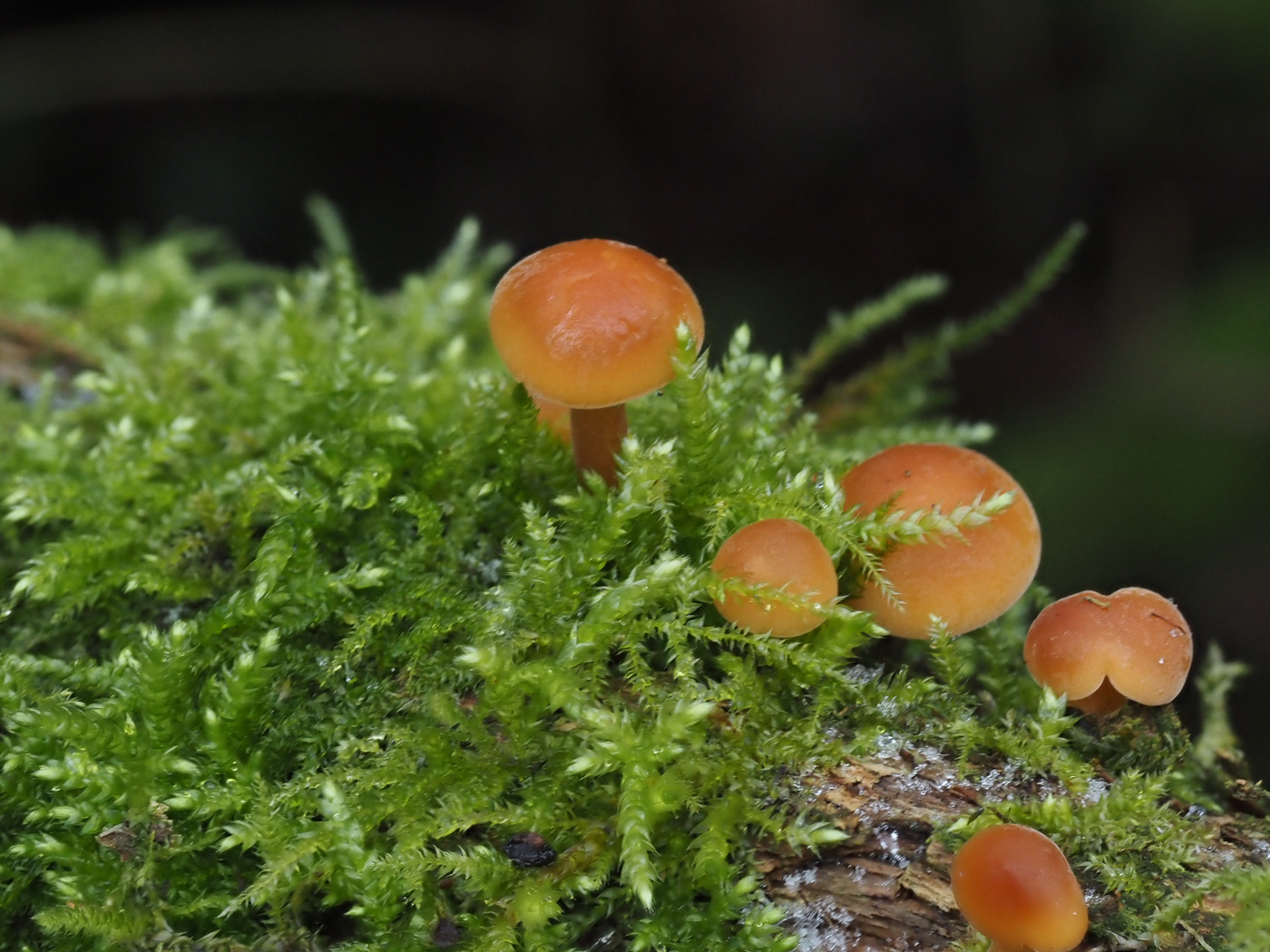
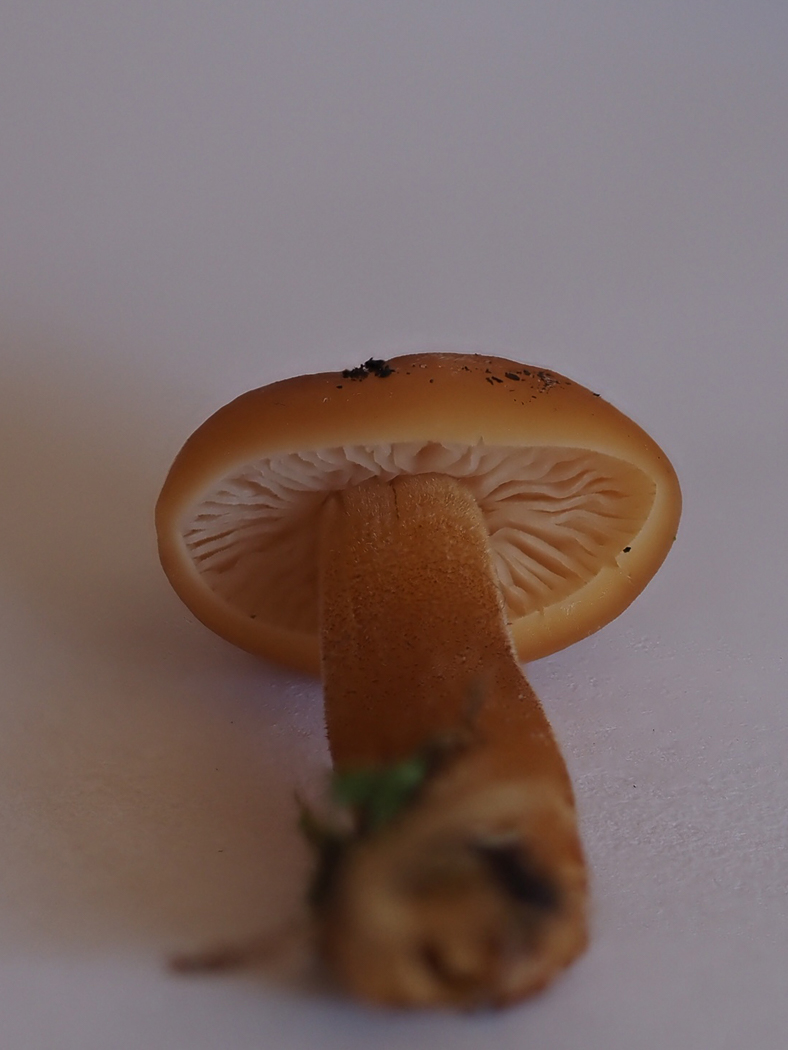
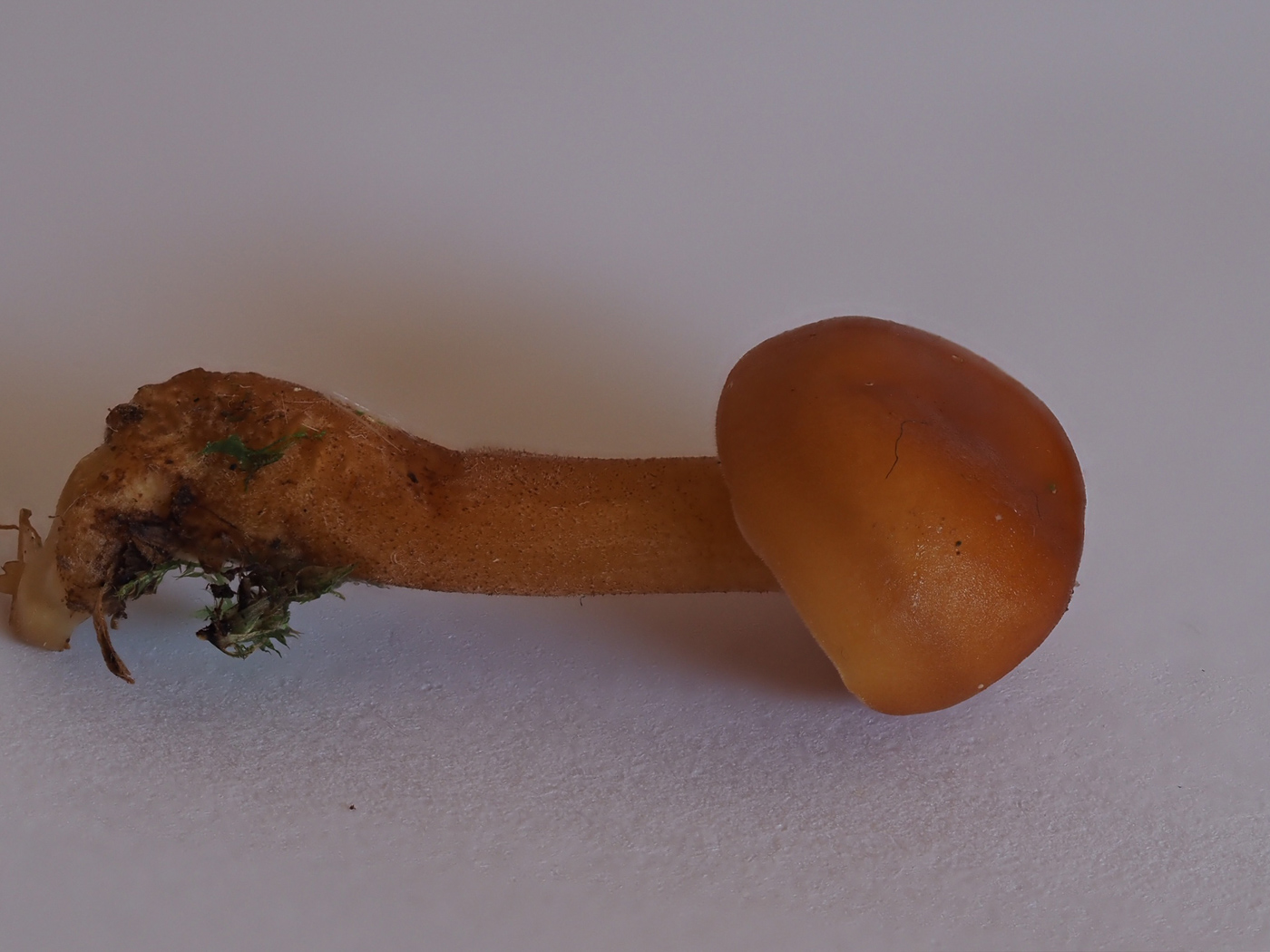 |
January 8th Flammulina velutipes (Velvet Shank)
We already have one image of this common winter mushroom but of older rather dark specimens. Today's photos, taken by Claire Williams in Downley Common Wood, are of young and fresh though frozen material which is considerably paler than our previous image. The stem, often much darker and finely velvety towards the base than shown here, can start off much paler all over, but still visible here (if you can zoom in on photo 3) are the tiny hairs - some of them considerably darker than the general stem colour.
|
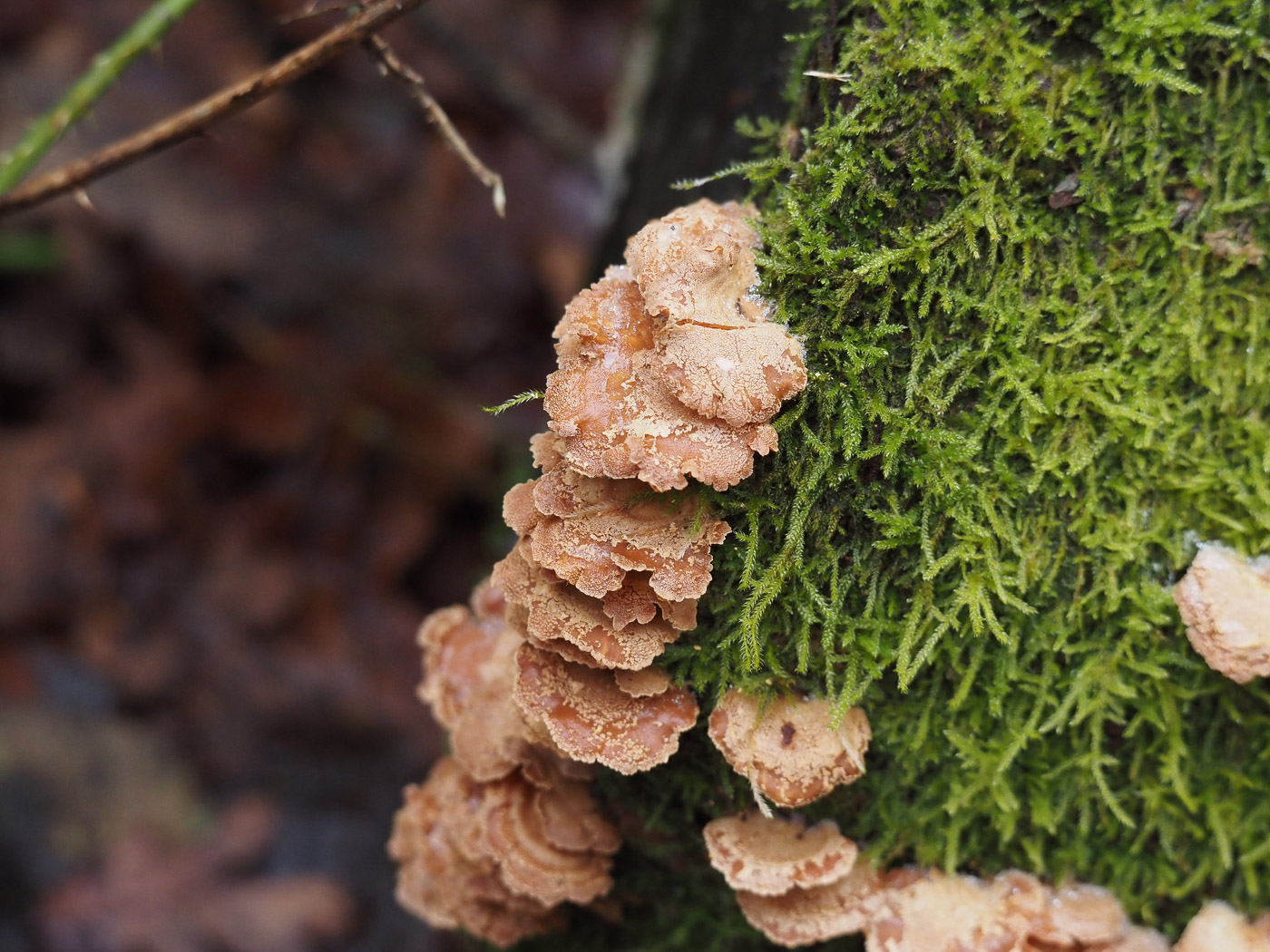
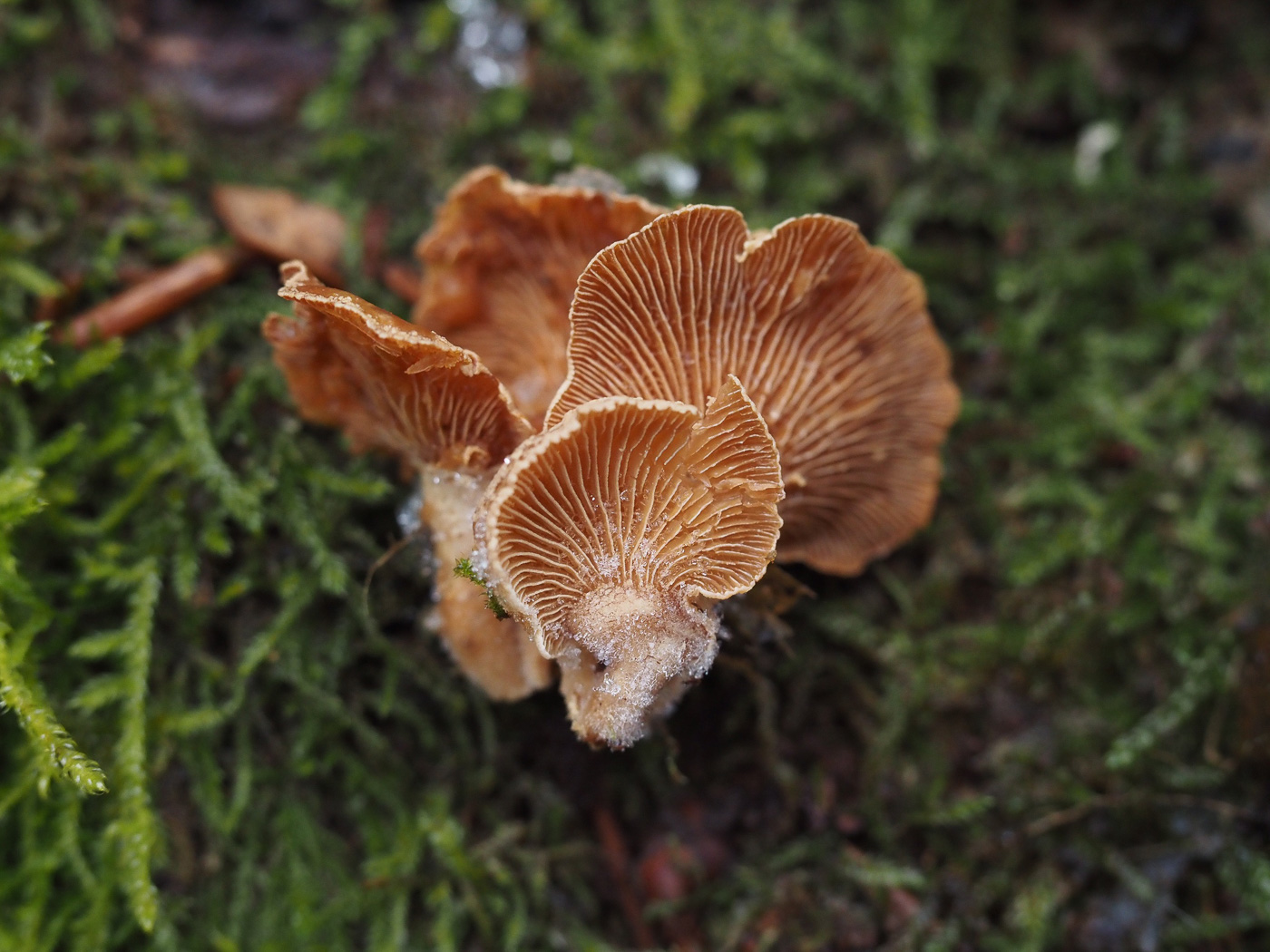 |
January 8th Panellus stipticus (Bitter Oysterling)
In Downley Common Woods today Claire Williams found amongst quite a few other fungal species (not all of which could be identified thus are not included here) this nice cluster. It is clearly surviving the frosty conditions quite happily on this moss covered deciduous log, and the underside view shown here leaves one in no doubt as to its identity though just from the top view this would not be possible. (See also Oct 3rd in Finds 2020 for more info.)
|
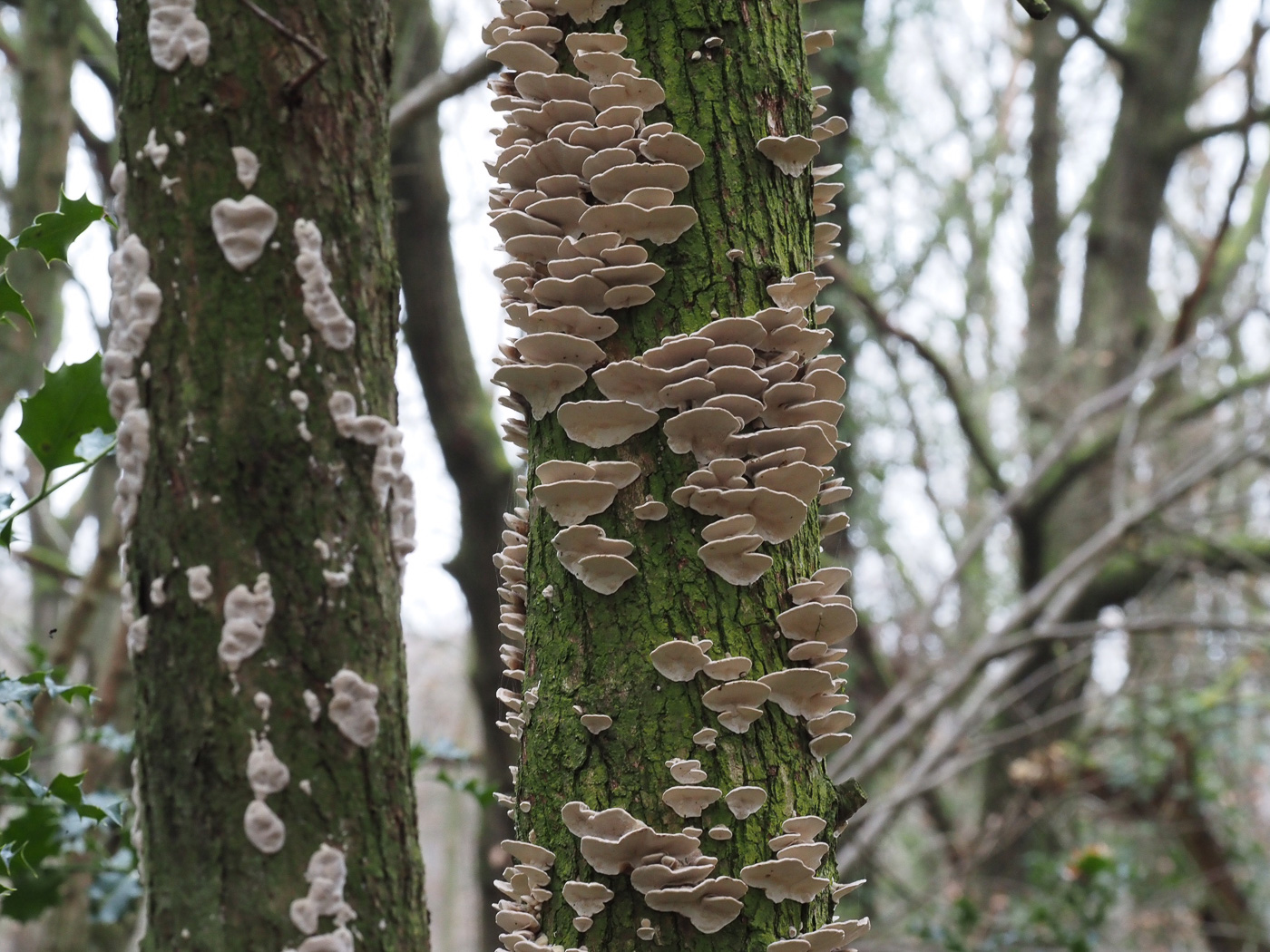
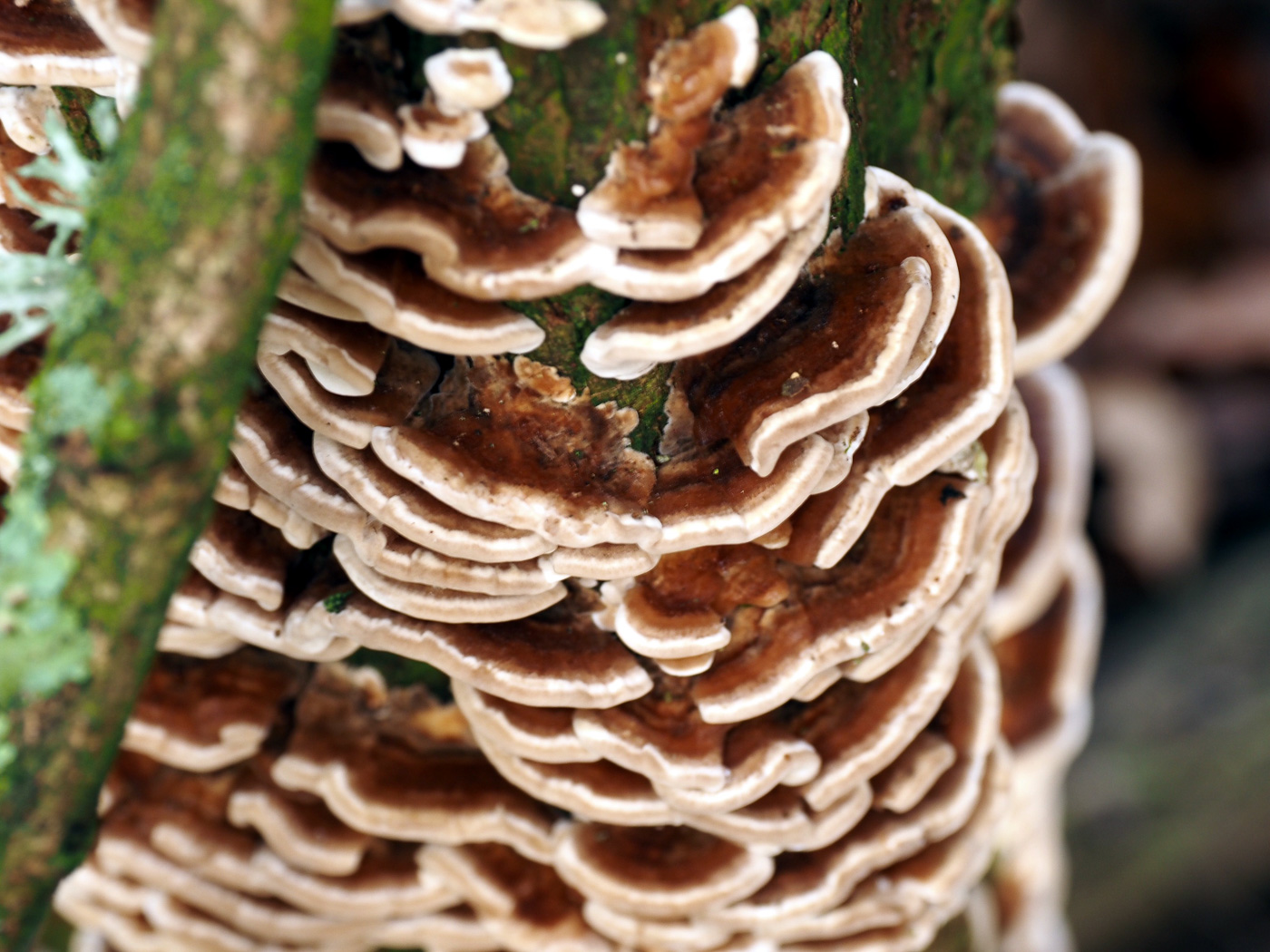
 |
January 8th Mensularia radiata (Alder Bracket)
Claire Williams found several deciduous trunks liberally covered in these brackets in Downley Common Woods. Recently moved to its present genus from the better known Inonotus, this bracket is deceptively named and is just as likely to occur on other deciduous trees as on Alder. The trees here could not be identified but if anyone recognises the bark do please let Penny know.
|
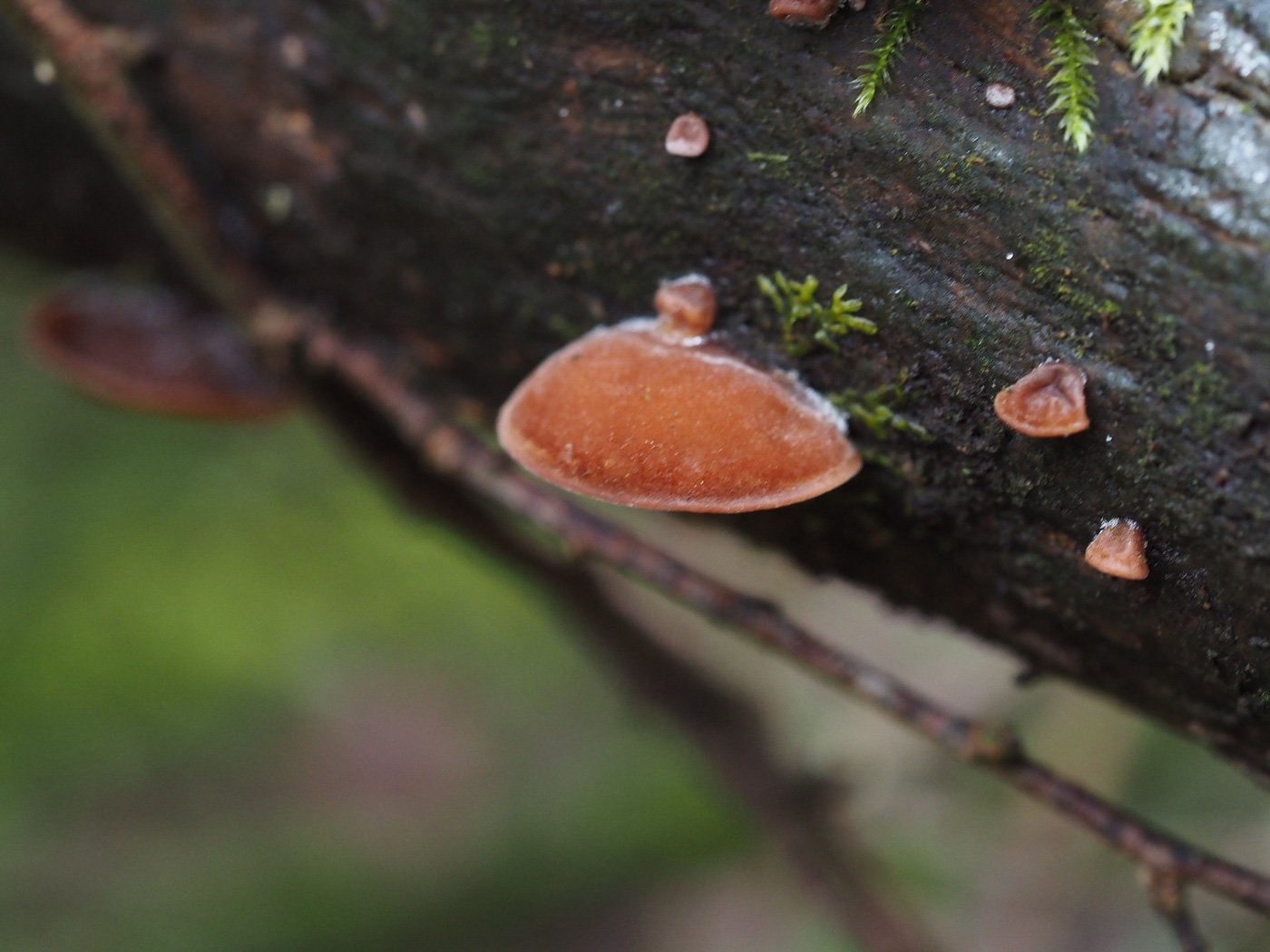 |
January 8th Auricularia auricula-judae (Jelly Ear)
Claire Williams noticed these small and somewhat frozen fruit bodies on an unidentified branch in Downley Common Woods (probably Elder but it could be some other tree?). (See also Sept 30th and Oct 25th in Finds 2020 for more info.) It seems that Jelly fungi are quite happy fruiting in this cold spell of winter weather.
|
January 6th 2021
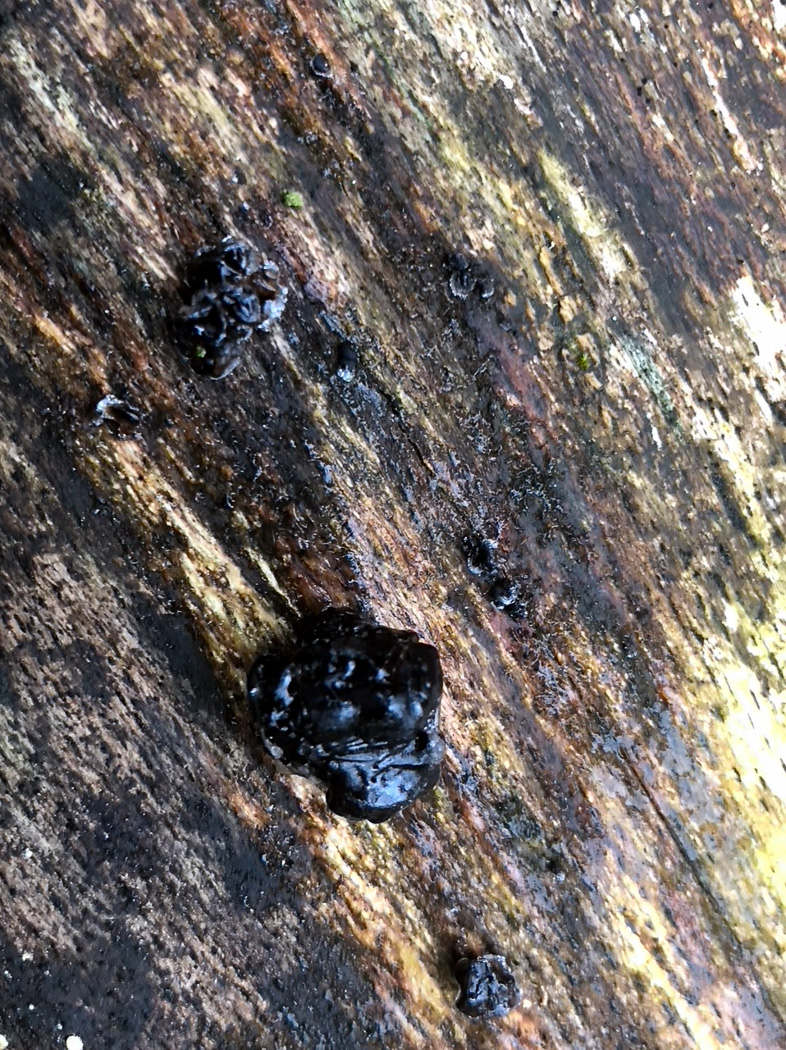 |
January 6th Exidia glandulosa (Witches' Butter)
In Naphill today Paul Goby found these black 'shiny firm wrinkled blobs' - his description! They were growing on a bare dead trunk - likely to be Oak on which this genus is probably most often found though it can occur on other deciduous wood and at any time of year given damp enough conditions. It is another of the 'Jelly fungi' belonging to the Basidiomycetes despite often appearing very similar to the Ascomycete Bulgaria pura. See also under Oct 24th in Finds 2020.
|
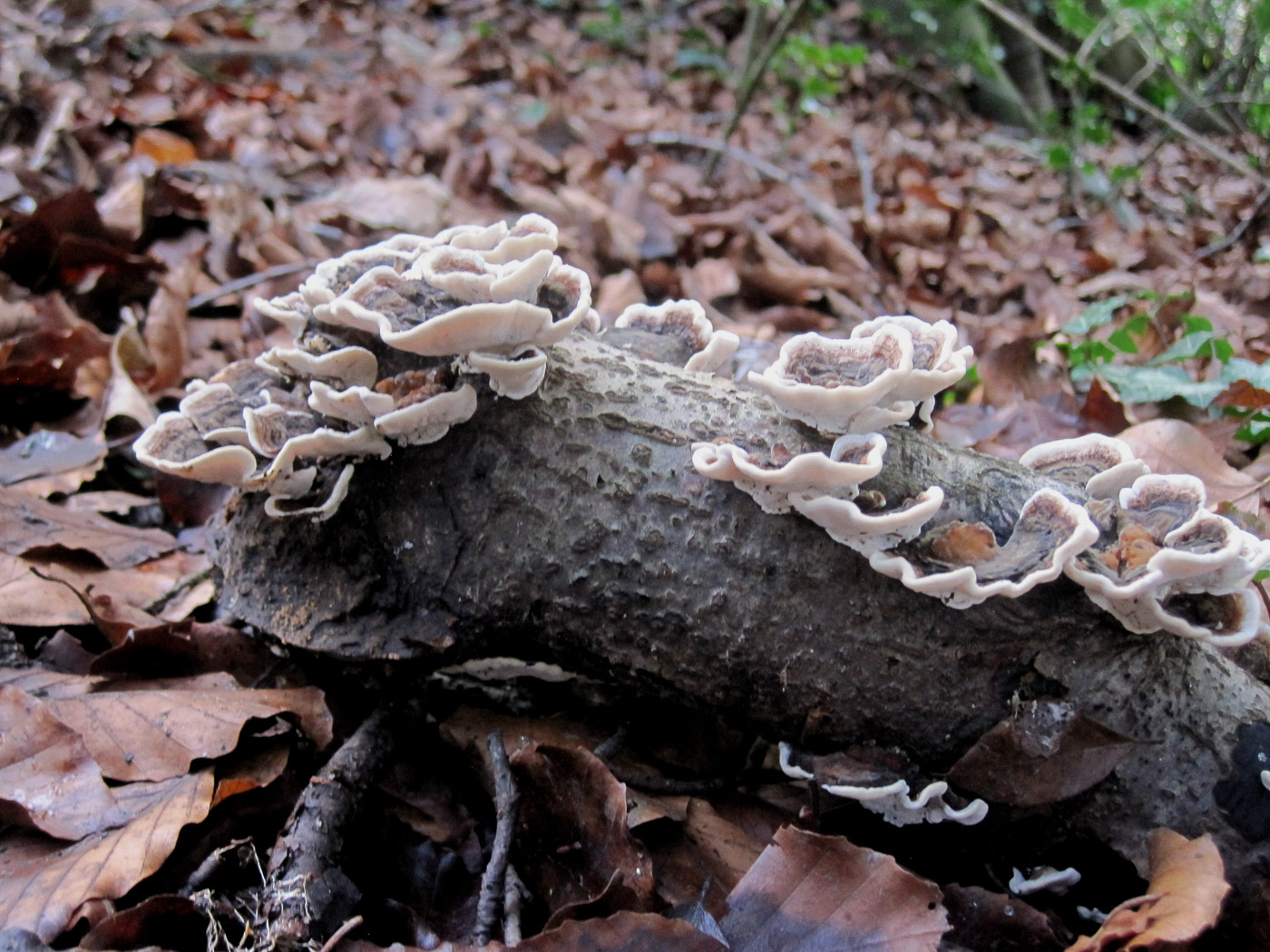
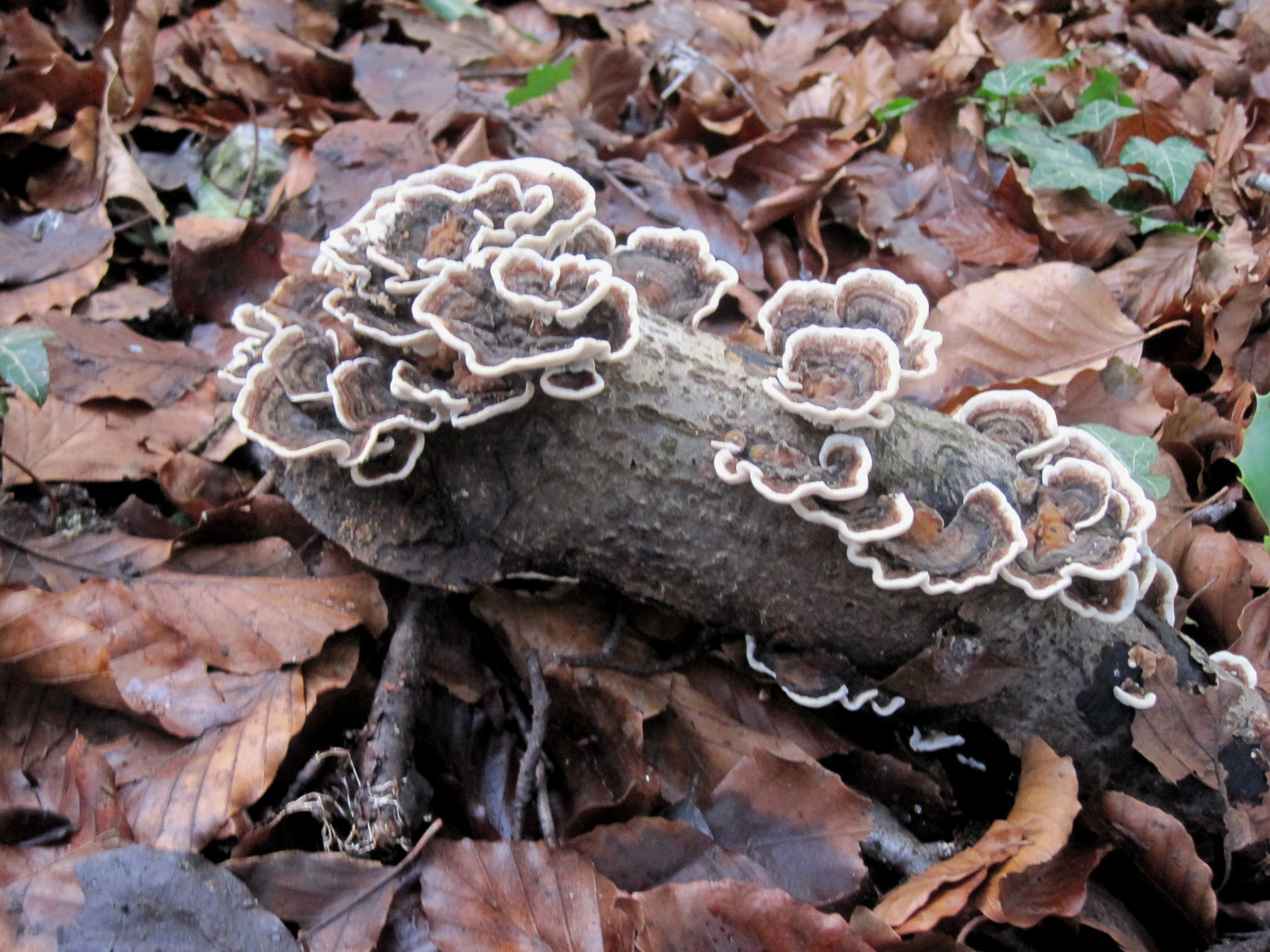 |
January 6th Trametes versicolor (Turkeytail)
Greg Douglas spotted this nice collection on an unidentified deciduous log in Captain's Wood, Chesham. A common but often impressive bracket when in good numbers, it can be found on fallen wood of many kinds at most times of year. (See also Finds 2020 dated Sept 26th). Look for the white finely pored underside and clear zoning on the top surface which certainly recalls the shape and colours of our Christmas dinner bird's tail!
|
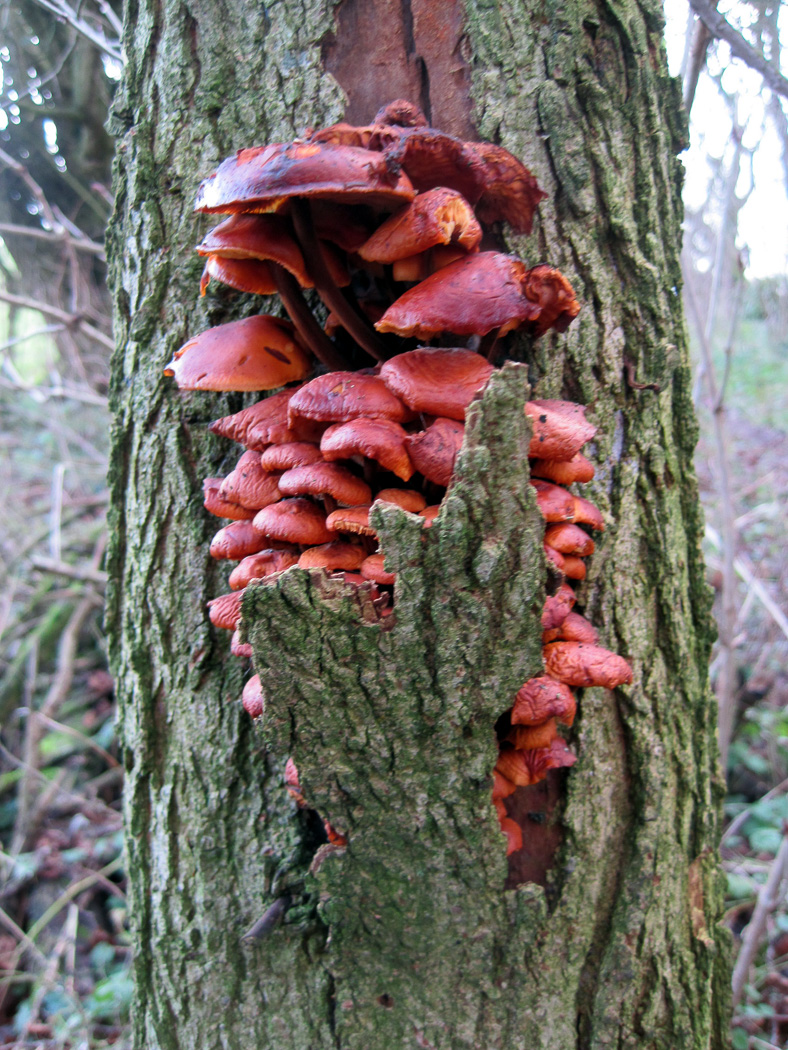 |
January 6th Flammulina velutipes (Velvet Shank)
On Joanna Dodsworth's walk around Brill she found this impressive clump on a standing dead Willow trunk. This is a species often fruiting during winter and can often be found even in snowy conditions. The caps are often considerably paler and yellower than shown here but the features to note in the field are its tightly clustered habit on deciduous wood (often standing) and the finely hairy stem which becomes darker to black towards the base. Penny was surprised we had only one collection of this in Finds 2020 (dated Oct 26th), so it's clearly one to be looking out for now.
|
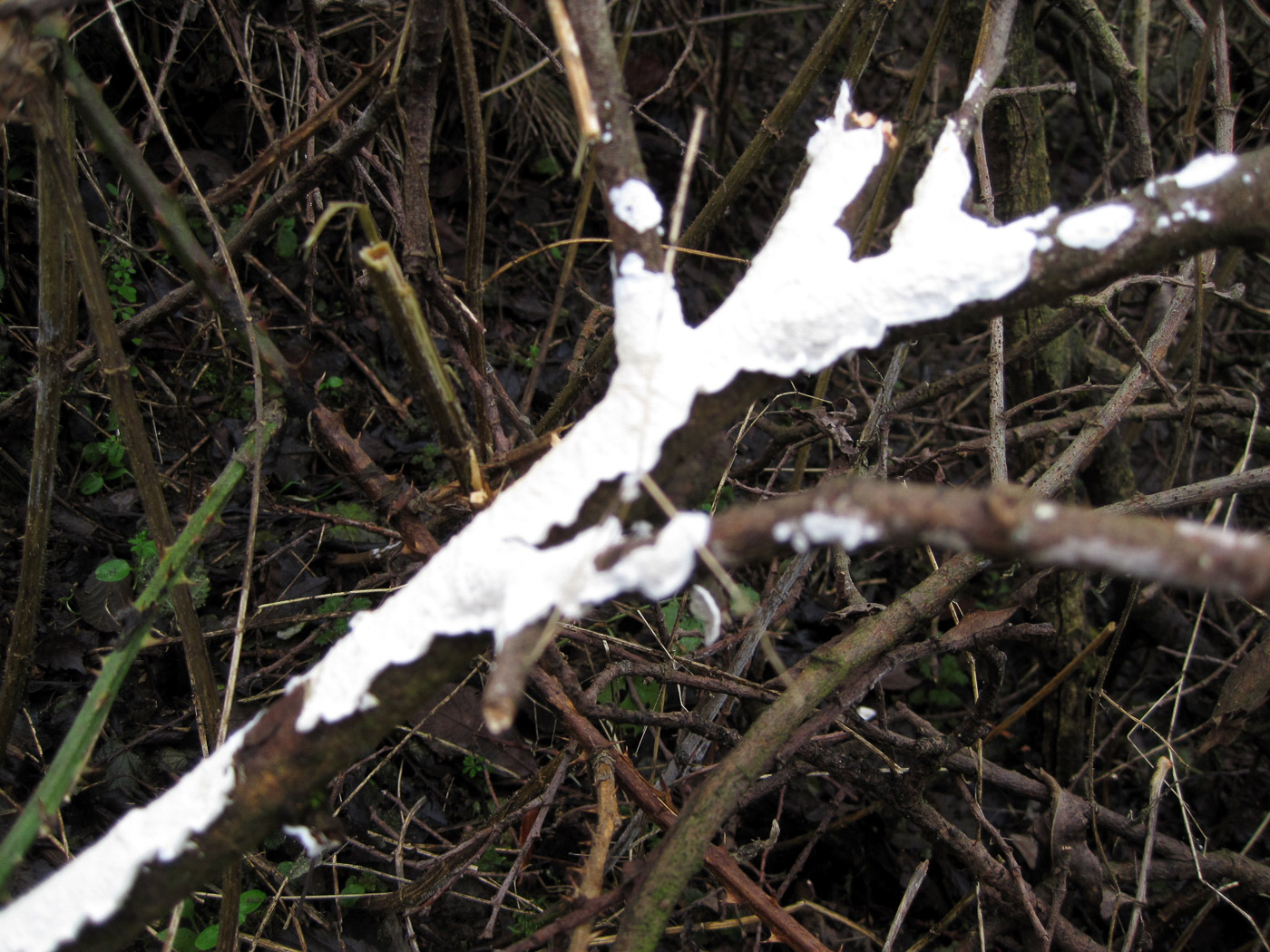 |
January 6th Byssomerulius corium (Netted Crust)
On Joanna Dodsworth's walk around Brill she noticed this common corticioid species covering a deciduous stick. It has a somewhat leathery consistency and is quite easy to peel off the substrate - a feature which helps to separate it from the many other similar flattish white resupinate species. It can be found at any time of year but as it happens is not one we included in Finds 2020.
|
January 3rd 2021
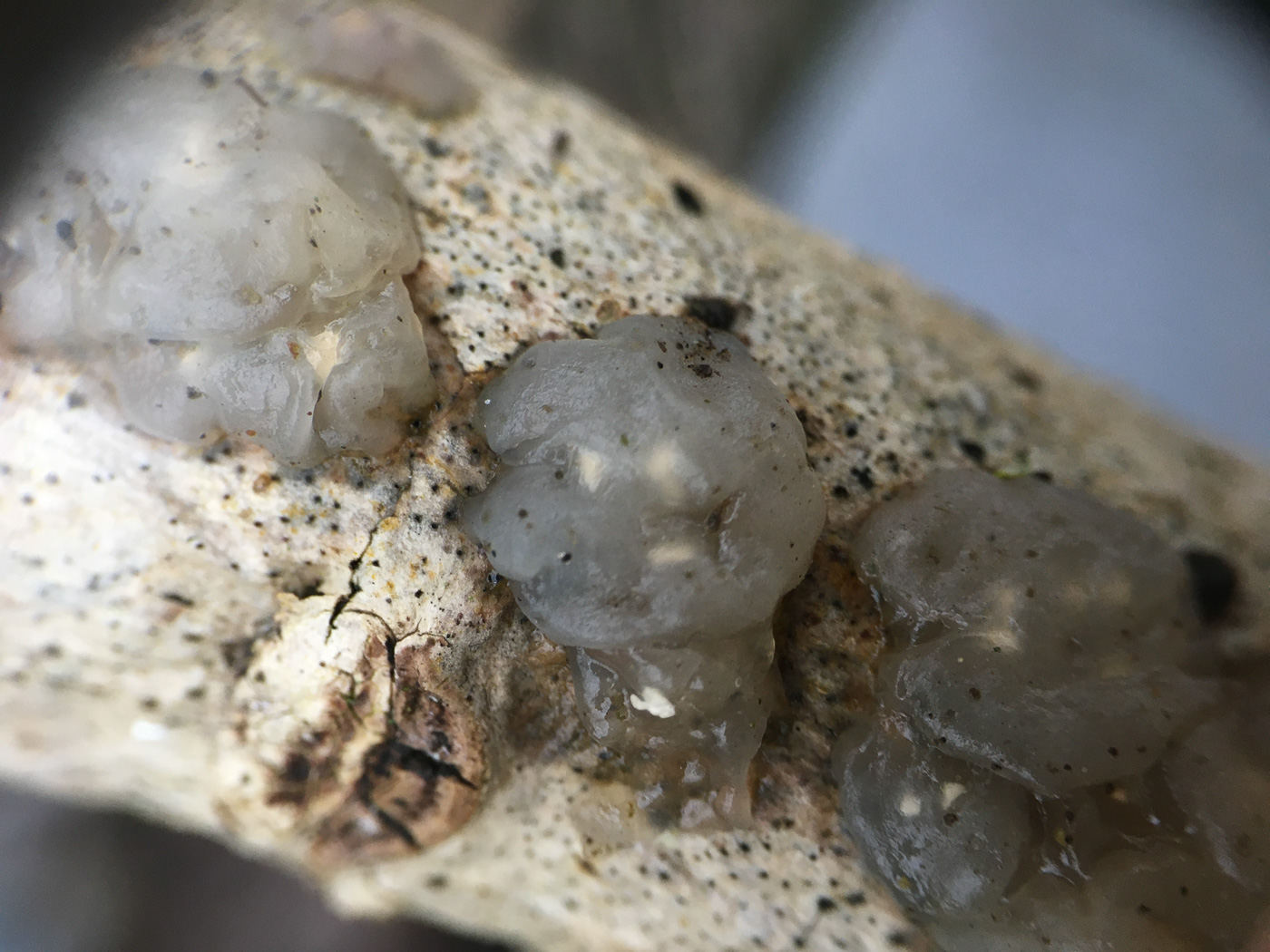 |
January 3rd Myxarium nucleatum (previously Exidia nucleata) (Crystal Brain)
Russell Ness noticed these small white lumps of jelly on deciduous wood near Dorney. This is quite a common Basidiomycete, one of the 'Jelly fungi' and often found on Beech logs though here on unidentified wood. For more notes see Finds 2020 dated Nov 5th though under its previous and much more familiar name there.
|
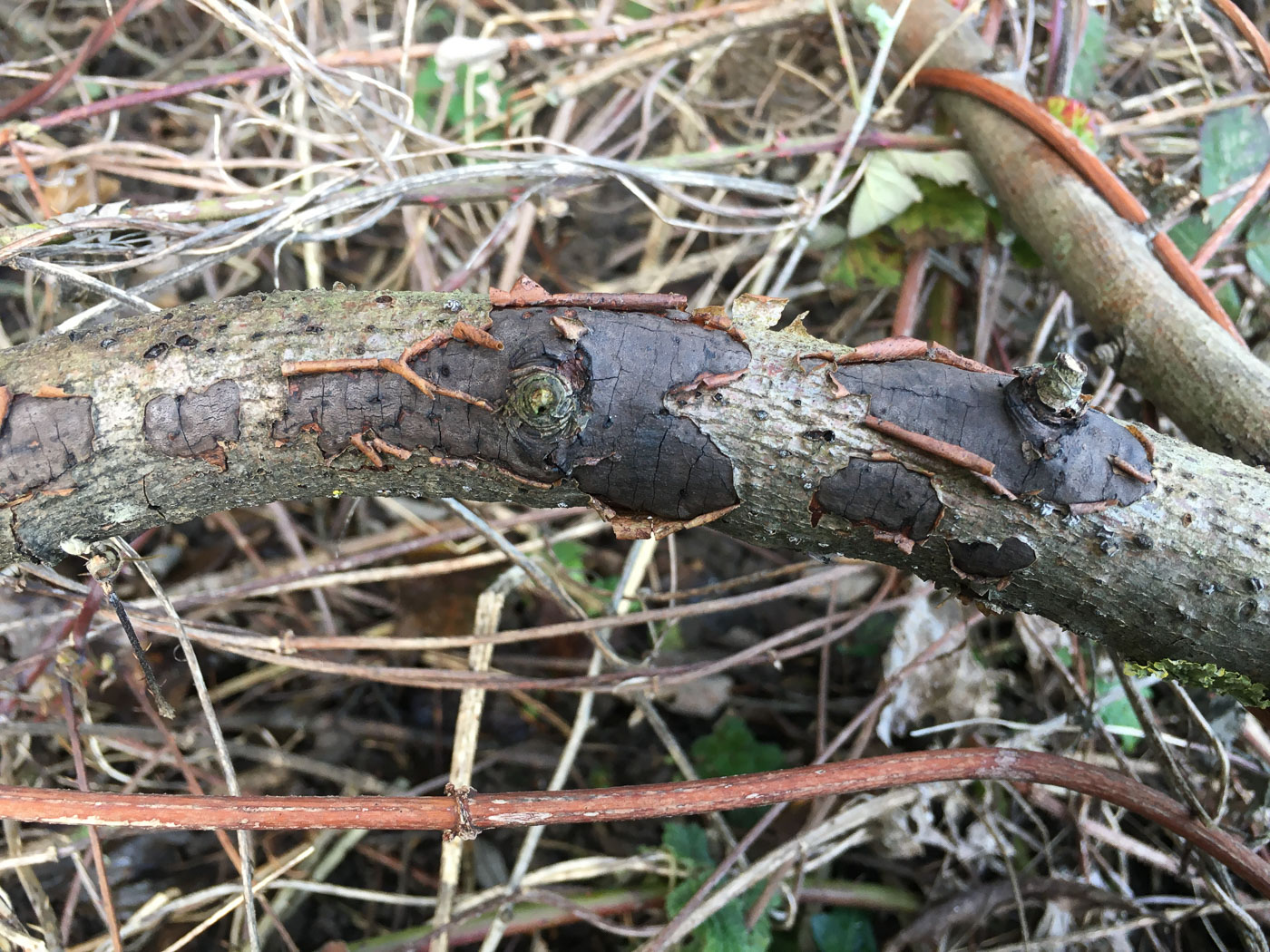
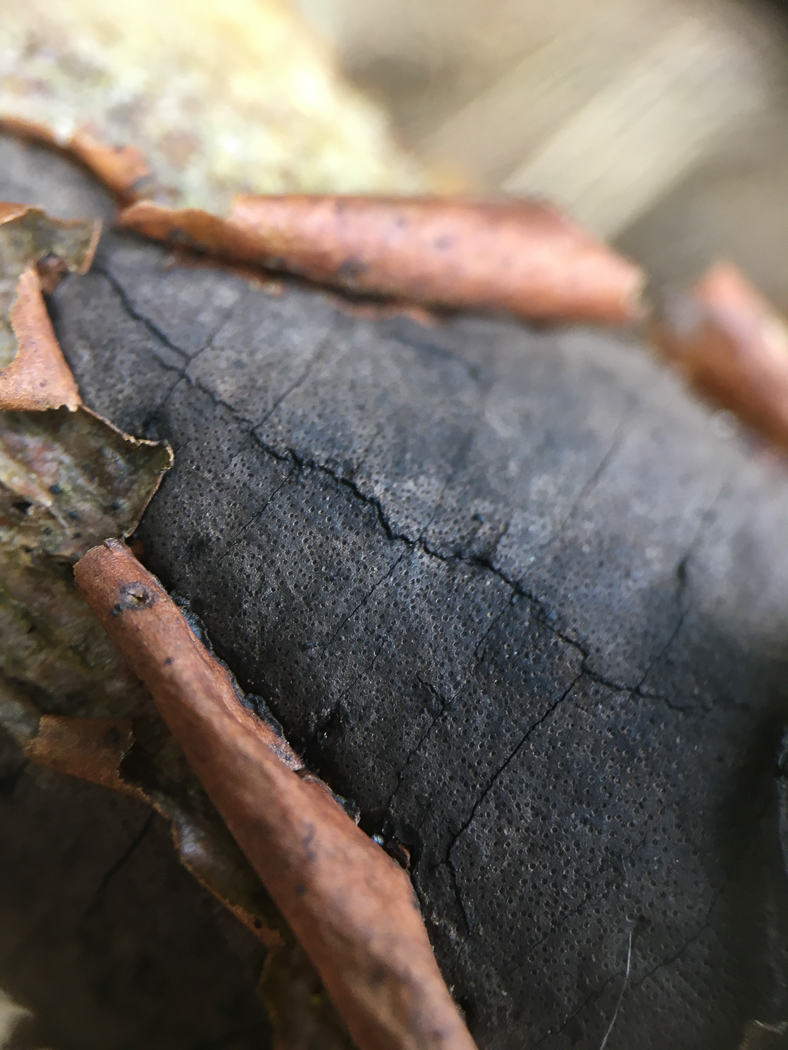 |
January 3rd Diatrype stigma (Common Tarcrust)
Russell Ness found this species of Pyrenomycete (i.e. a crusty black Ascomycete) on an unidentified deciduous fallen branch near Dorney Reach. Commonly occurring in large smooth patches on fallen Beech trunks, it is less usual on other deciduous wood as here (there was apparently no Beech in the area). This was not a species we included in Finds 2020 - not because it wasn't seen but probably because we were spoilt for choice with so much else to catch the eye.
|
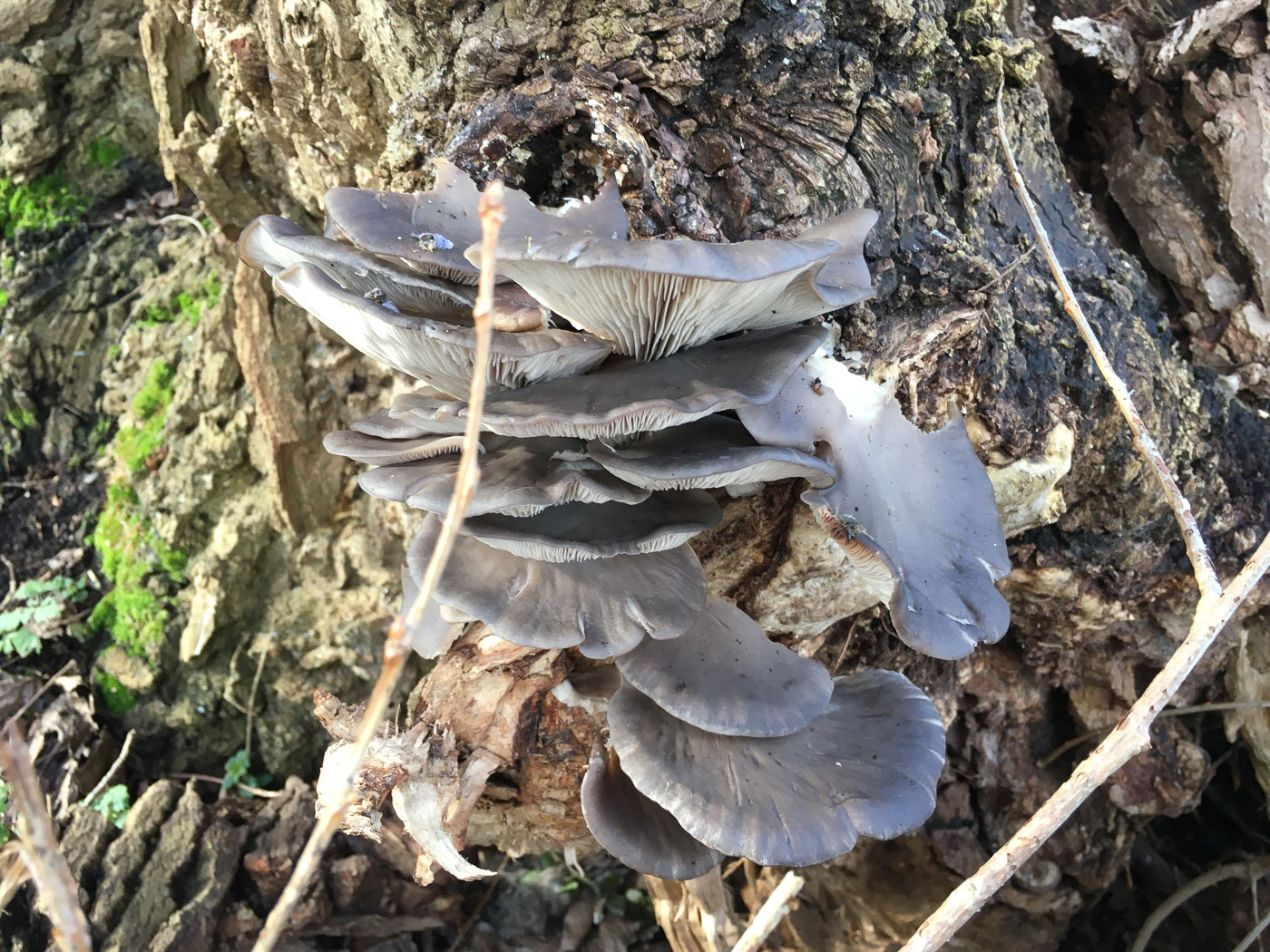 |
January 3rd Pleurotus ostreatus (Oyster Mushroom)
Russell Ness found this fresh and healthy collection on a fallen deciduous trunk near Dorney Reach. He can vouch for the freshness because apparently it tasted delicious in his beef stir-fry! For further images see Finds 2020 dated Sept 21st, Oct 27th and Nov 17th, proving that this is a species which can be found at any time given the right conditions and substrate.
|
January 1st 2021
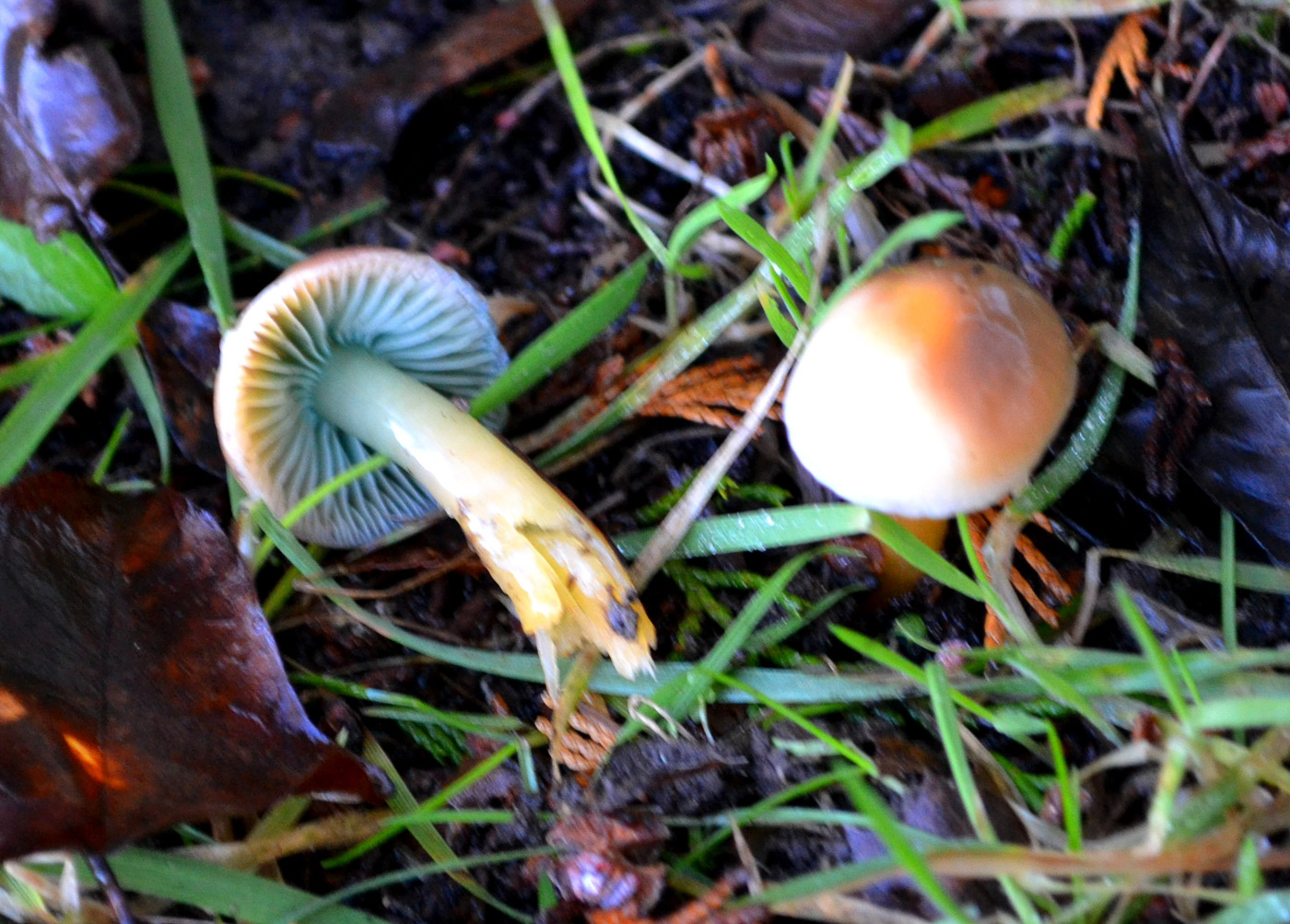 |
January 1st Gliophorus psittacinus (previously Hygrocybe psittacina) (Parrot Waxcap)
On his daily walk around Prestwood Tony Marshall noticed these fresh but frosted specimens but had no camera at the time! Returning the next day for the photo he found them thawed but now very faded, as often happens when Waxcaps are frosted - they're colours can change radically adding to the difficulty of identification. See also photos and notes from Members' Autumn Finds 2020 dated October 3rd and November 1st.
|
![]() Only entries marked with this symbol have been microscopically examined. There is no guarantee on identifications made of entries lacking this symbol though all photos are checked and selected by Penny to the best of her ability. Basic accompanying notes are also Penny's.
Only entries marked with this symbol have been microscopically examined. There is no guarantee on identifications made of entries lacking this symbol though all photos are checked and selected by Penny to the best of her ability. Basic accompanying notes are also Penny's. ![]() Entries marked with this symbol have been confirmed or identified using DNA sequencing.
Entries marked with this symbol have been confirmed or identified using DNA sequencing. 
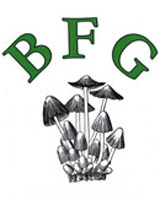

























































































 barba-jovis Burnham Beeches 19.05.2021 CVS 1.jpg)
 barba-jovis Burnham Beeches 19.05.2021 CVS 2.jpg)
 barba-jovis Burnham Beeches 19.05.2021 DJS 1.jpg)
































































































































 Lane End 10.01.2021 CW.jpg)


















